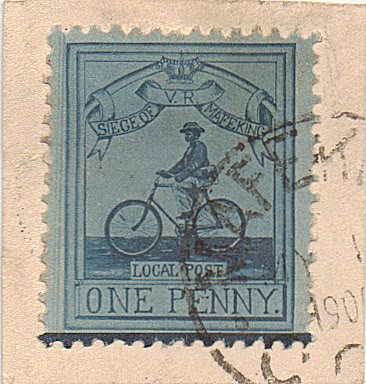December 6 - 12, 2020: Issue 477
boy scouts - the pre-Nippers Life Savers: some notes on local troops from 1909
1st Bayview Sea Scouts
The training of life-savers, in any pre-Nippers organised way, happened through the local troops of Boy Scouts and, in New South Wales, in the pre Girl Guides named ‘League of Girl Aids’ from 1908 and then more formally from 1910 on. Although hard to calculate just how many lives were saved from drowning through Boy Scouts and Girl Guides being trained in lifesaving, New South Wales alone was recording statistics of over one thousand every few months by the mid 1920's as taking to the water for 'surf bathing' became popular. Many of these early Boy Scouts and Girl Aids and their teachers (Scoutmasters) would also become members of the early formation of local surf clubs.
There were also Cycle Brigades or 'Bicycle Patrols' in the early Troops of NSW Boy Scouts, first seen as employed by the boys Mafeking Cadet Corps, the group of boy cadets formed by Lord Edward Cecil shortly before the 217 day Siege of Mafeking in South Africa during the Second Boer War in 1899–1900. The new cycle track from Manly to Newport opened in September 1901 would be a reflection of the growing popularity of these means of getting around and as a sport as much as a nod towards what had just happened. One of the cadets' duties was to carry messages around the town and to outlying forts, sometimes as much as a mile away across open ground. At first they used donkeys, but as the siege ran on, food became scarce and the donkeys were eaten. From then on, the cadets used bicycles instead. The town produced its own postage stamps, known as "Mafeking Blues", for postage during the siege. One set depicted the cadet leader Warner Goodyear seated on a bicycle. Another important duty was to act as lookouts, mainly to warn the townspeople when the Boer siege guns were aimed and fired at different parts of the town.
'Warner Goodyear was 12 years old when the shadow of a Siege with all its hardships fell upon him, his family and the citizens of Mafeking. But he was such an efficient, courageous boy that it was not long before the great Colonel Baden-Powell the gallant Commander in charge of the invested town, recognised the excellent "Scout Leader" qualities of this youngster. Young Warner showed all the characteristics of a good "Scout"; Loyalty, Unselfishness, Enthusiasm, Inventiveness and Courage.
To tell the truth, Goodyear and his gang of boys were about the only ones who treated the Siege more as a game. As one of these Scouts once wrote: They were full of playful nonsense and just loved the excitement of doing errands and other duties while shells were whistling around.
None the less, they took their responsibilities seriously, doing "good deeds", not every day, but every moment, and executing "man-sized jobs" under the most dangerous conditions. They were the true protagonists, the "kernel", of the future world-wide movement of Boy Scouts.
In praising Warner Goodyear, one must not forget that he had inherited all his "Scout" qualities from a remarkable father of striking character, whom the son idolized and in whose footsteps he tried to follow.' -By Dr. K. FREUND, Reprinted from "The O.F.S. Philatelic magazine", August, 1957
The Bicycle became the symbol of the Mafeking Cadet Corps, and when Warner Goodyear was unanimously considered as the obvious choice to be immortalised on the 1d. stamp, his Bicycle certainly had to appear on it, too. According to information supplied by those who were subject to the siege;
'it was never expected that men of the garrison would affix this 1d. stamp with Goodyear (and the 3d. stamps with Baden-Powell) on letters going out to other parts of the world, but this is what happened. If it would have been foreseen, Troop-Leader Goodyear would never have appeared on a stamp, as this was the prerogative of the Queen and other members of the Royal family. Goodyear was chosen as a worthy stamp subject representing all those brave boys under him, and a photograph had to be taken of him in preparation for the stamp design. The whole party which turned up in one of Mafeking's deserted streets to take the "still" and the whole preparations must have resembled the shooting of a film scene by a modern film company.'
This 'Scout Troop' is widely credited as being the first Boy Scouts Troop in the world - their ages ranged from 11 to 13. The cadets were given khaki uniforms, a wide-brimmed hat which they wore with one side turned up and a Glengarry cap. The towns people often commented on their smartness. The then 13-year-old Sergeant-Major Warner Goodyear was their leader.
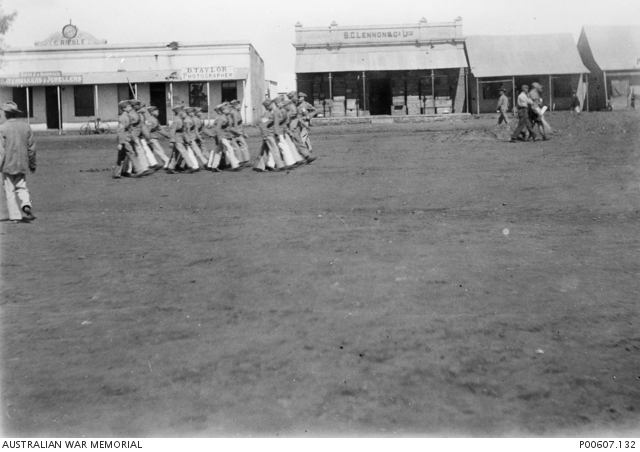
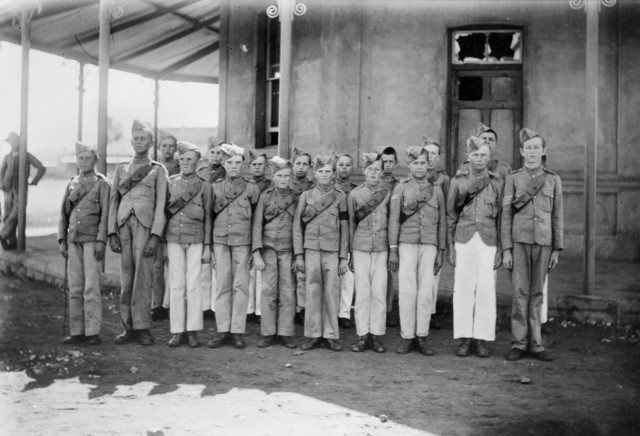
Mafeking Cadets marching - AWM image and Mafeking Cadets - and - The Mafeking Cadets, with their leader Sergeant-Major Warner Goodyear on the right.
The Mafeking siege attracted so much attention because Lord Edward Cecil, then in Mafeking, was the son of the then British prime minister. There too was Lady Sarah Wilson, a daughter of the Duke of Marlborough and aunt of Winston Churchill. Lady Wilson married Gordon Chesney Wilson MVO, born in the Wimmera, Victoria, Australia, on November 21st, 1891, so there was bound to be an Australian interest in this conflict. Lady Wilson is also credited with being one of the first female war correspondents as the Daily Mail newspaper recruited Lady Sarah after one of its correspondents, Ralph Hellawell, was arrested by the Boers as he tried to get out of the besieged town of Mafeking to send his dispatch. Sarah was in the right place at the right time to step into the journalistic breach, having moved to Mafeking with her husband, Lt.-Col. Gordon Chesney Wilson, at the start of the war, where he was aide-de-camp to Col. Robert Baden-Powell, the commanding officer at Mafeking.
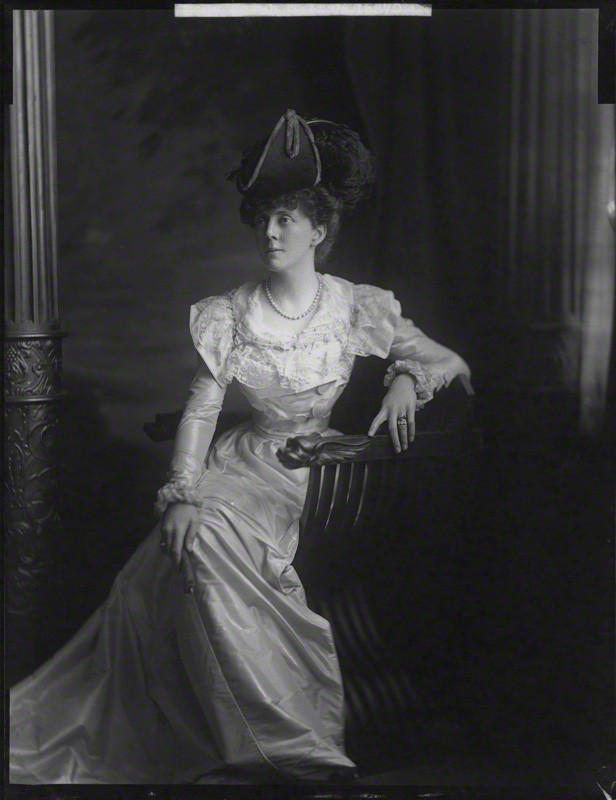
Lady Sarah Wilson, 1893, by Henry Walter ('H. Walter') Barnett, whole-plate glass negative
Although death and destruction surrounded her, the Mail’s fledgling war correspondent preferred not to dwell too much on the horrors of the siege. She described cycling events held on Sundays and the town’s celebration of Colonel Baden-Powell’s birthday, which was declared a holiday. Despite these cheery events, dwindling food supplies became a constant theme in the stories she sent back to the Mail and the situation seemed hopeless when the garrison was hit by an outbreak of malarial typhoid. In this weakened state the Boers managed to penetrate the outskirts of the town, but the British stood firm and repelled the assault.
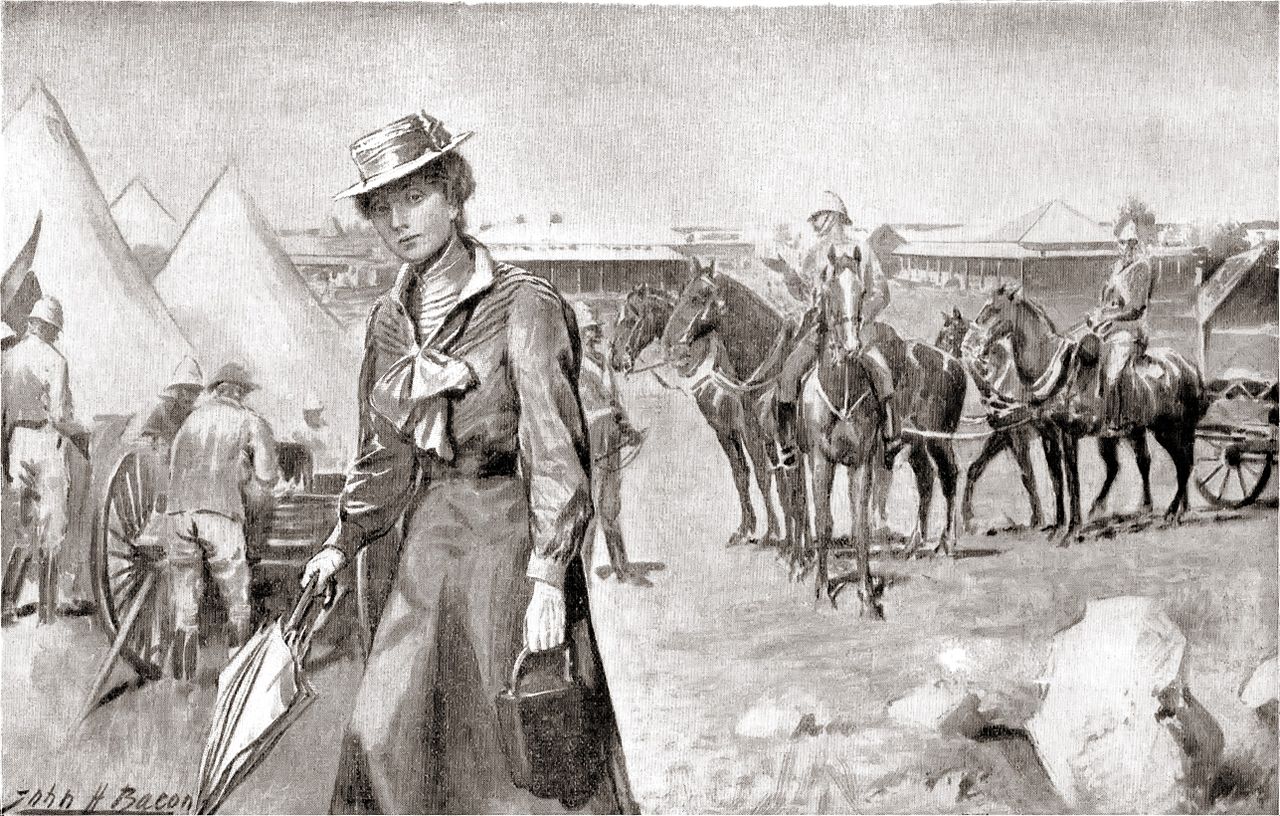
Drawing of Lady Sarah Wilson in South Africa during the Second Boer War, published in The Black and White Budget Transvaal Special No 8. Caption reads "A brave woman. Lady Sarah Wilson, who is acting both as nurse and correspondent at Mafeking".
Gordon Chesney Wilson, MVO, (August 1st 1865 – November 6th 1914), of the Royal Horse Guards, was the son of Jennie Campbell and Sir Samuel Wilson, MP. His father was very wealthy and enrolled Gordon in Eton College in 1879. This was to be the choice for all of his sons. Gordon was soon to make a name for himself not only in his studies but also as a sportsman. In 1881, his father had moved the whole family to England, settling in Buckinghamshire, in Hughenden Manor which he had leased. 'Hughenden', in local connections, turns up in early street names for Scotland Island (1906).
During his second year at Eton, Gordon and one of his friends, Murray Robertson, witnessed an attempt on the life of Queen Victoria. They rushed forward to help restrain the perpetrator. Later that day, the two friends were presented to Queen Victoria in Windsor Castle. Being in such close proximity to Queen Victoria had a profound effect on young Gordon, and the event was to change his life.
He stayed at Eton until 1885, when he graduated into Christ Church, where he was expected to finish his degree course. He joined the Militia in 1885 and although still a student, was commissioned as a second lieutenant, into the 3rd Battalion, the Duke of Wellington's Regiment. He served with the Militia for 3 years and in 1888, he left Christ Church, without finishing his degree, and was commissioned into the Royal Horse Guards as a Lieutenant. On November 21st, 1891, at St. Georges Church, Hanover Square, London, George married Lady Sarah Isabella Augusta Spencer-Churchill, daughter of John Winston Spencer-Churchill, 7th Duke of Marlborough and Lady Frances Anne Emily Vane. The Archbishop of Canterbury married the happy couple in the presence of Royalty and nobility, the Prince of Wales being one of the invited guests.
Gordon and Sarah had two sons, Randolph Gordon Wilson, born 1893 in Melton Mowbray, and then Alan Spencer Wilson, who was christened on 27th December, 1894, in Dorking, Surrey, England.
Gordon was twice mentioned in despatches, and was appointed Member of the Royal Victorian Order (M.V.O.) on 28th May,1901, for distinguished service and gallantry.
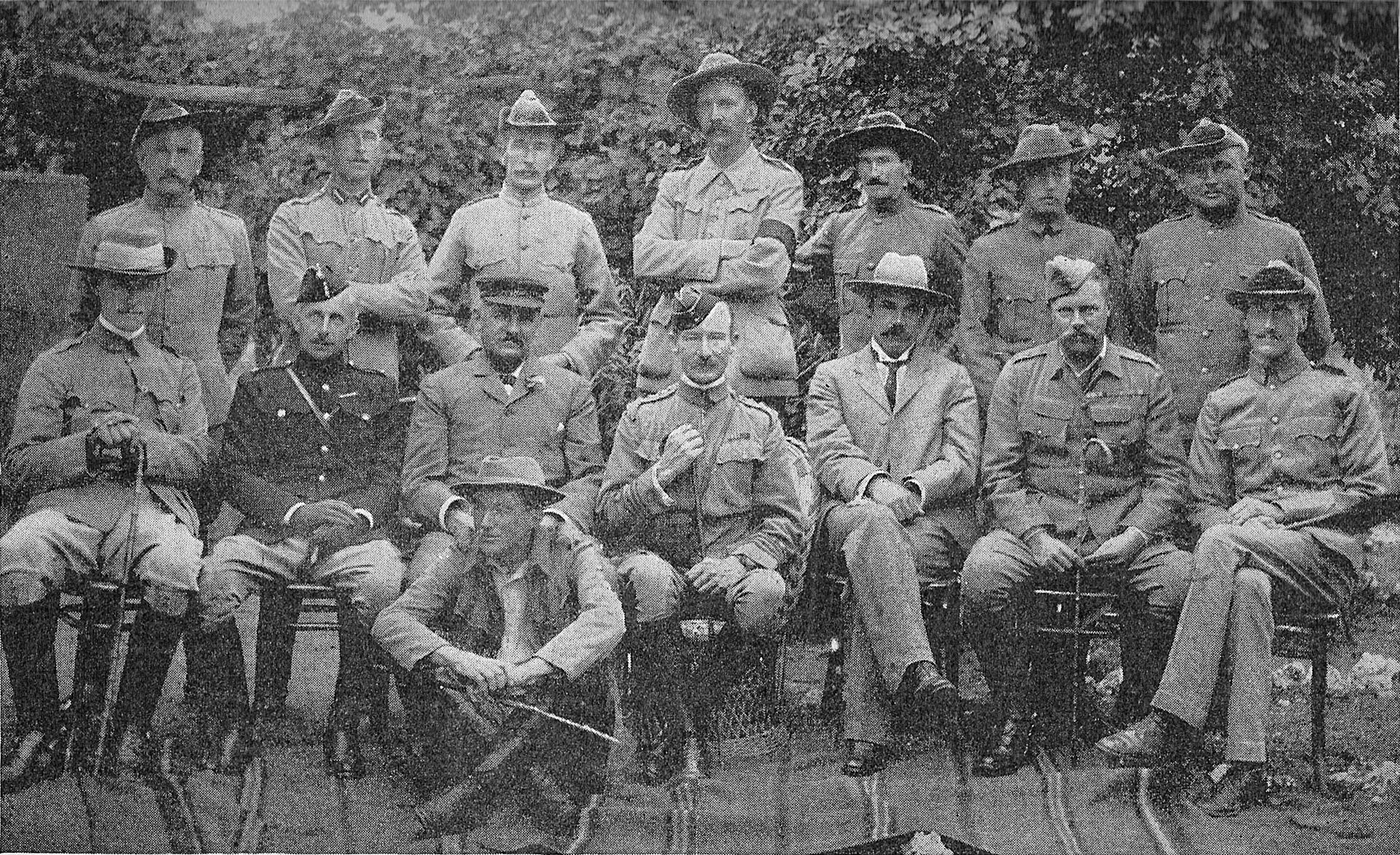
Photograph: Robert Baden-Powell and his staff after the Siege of Mafeking in South Africa, published in The Black and White Budget Vol 3 No 35, page 297. Main caption reads "Major-General Baden Powell and the principal men who helped him to defend Mafeking". Photo by J. Angus Hamilton, Our Special Correspondent with Major-General Baden-Powell.
The siege finally ended after 217 days, when the Royal Horse and Canadian Artillery galloped into Mafeking on May 17th 1900. Only a few people standing in a dusty road, singing "Rule, Britannia!", were there to greet their saviours. In London there was a different scene as more than 20,000 people turned out in the streets to celebrate the relief of Mafeking. In Australian cities there were also big demonstrations and columns amounting to pages of reports:
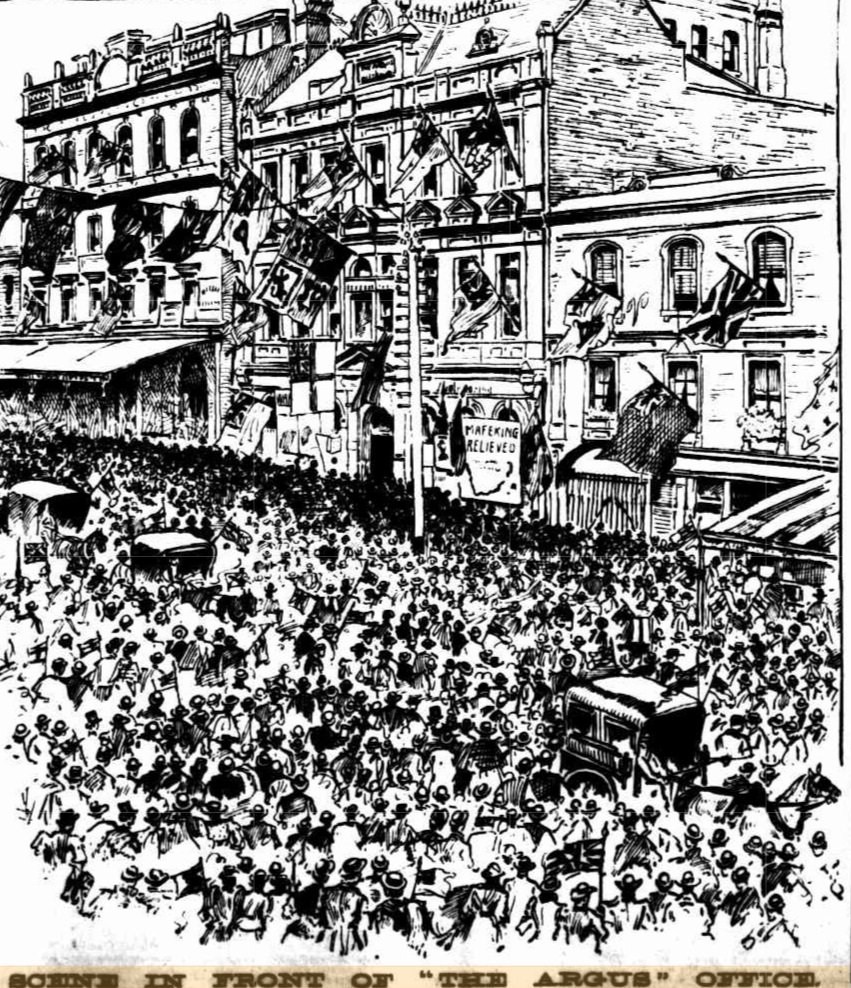
SCENE IN FRONT OF "THE ARGUS" OFFICE. MAFEKING DAY (1900, May 21). The Argus (Melbourne, Vic. : 1848 - 1957), p. 7. Retrieved from http://nla.gov.au/nla.news-article9541836
In May 1901, Lady Wilson was invested as a Dame of Grace of The Most Venerable Order of the Hospital of Saint John of Jerusalem (DStJ), and in December the same year King Edward VII personally conferred on her the decoration of the Royal Red Cross (RRC) for her services in Mafeking.
So, we have our boys and our girls venturing into, and succeeding, in fields previously closed to them.
The last and vital core comes through transcribing ideas and actions into words and collating these into a manual that can be sent all around the world.
When Colonel Robert Stephenson Smyth Baden-Powell, then Commander of the 5th Dragoon Guards, returned to England in 1899 on leave after many years of service in India, Malta and Africa, he took with him a manuscript of a little book he had written, Aids to Scouting, which was a wealth of information on military scouting methods and included many of his own experiences in ‘observation’ and ‘deduction’.
Scouting for Boys (1908) was Baden-Powell's rewrite of his earlier book Aids to Scouting (1899). Many state some of his youth training ideas were taken from The Birch Bark Roll of the Woodcraft Indians (1906) written by Ernest Thompson Seton, who later became the Chief Scout of the Boy Scouts of America. Ernest Thompson Seton (born Ernest Evan Thompson) was born in South Shields, County Durham, England of Scottish parents. His family emigrated to Canada in 1866. Most of his childhood was spent in Toronto, Ontario. As a youth, he retreated to the woods of the Don River to draw and study animals as a way of avoiding an abusive father. In 1891, he published The Birds of Manitoba and was appointed Provincial Naturalist by the government of Manitoba. He continued to publish books about Manitoba for decades to come, including The Life Histories of Northern Animals: An Account of the Mammals of Manitoba. He formed the Woodcraft Indians in 1902 and invited the local youth to join. Despite the name, the group was made up of non-native boys and girls. The stories became a series of articles written for the Ladies Home Journal, and were eventually collected in The Birch Bark Roll of the Woodcraft Indians in 1906. Shortly after, the Woodcraft Indians evolved into the Woodcraft Rangers, which was established as a non-profit organisation for youth programming in 1922.
Scouting for Boys was published in six fortnightly instalments of approximately 70 pages each, from January to March 1908. They were produced by Pearson's printer, Horace Cox. The cover of this work wuld later appear as the Header in reports from Boy Scouts troops in New South wales as published by The Sunday Times of then.
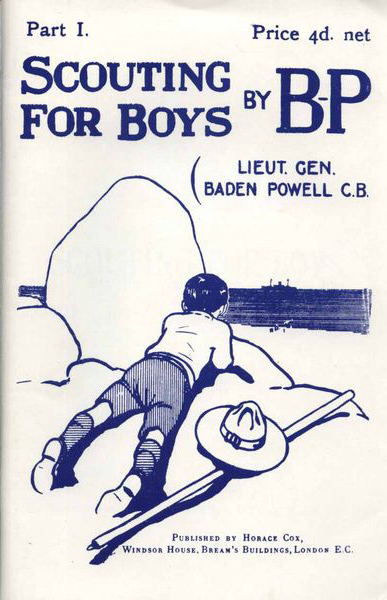
Cover of first part of Scouting For Boys, January 1908
The first NSW Boy Scouts Troop officially recognised was formed in Mosman in 1908, inspired by this book. It is from here that the gentleman who taught the first Narrabeen Troop originated. As reported in The Sunday Times. Both newspapers and 1st Mosman Boy Scouts Historians record that Charles Hope, office boy, bought a copy of ‘Scouting for Boys’ in March 1908 from Swains bookshop when it first went on sale in Sydney and while reading it on the Mosman ferry home was so inspired he formed a Troop, with a meeting held in March 1908, the ‘Kangaroos’, from among his friends; himself as Patrol Leader, Archie Jacobs as Lieutenant, with Harry Tichen, Clive Cox, Bert Shearer, Fred Rolls, Noel Hope and Roy Middlecoat. An article printed in the Sunday Times of August 1908 states;
BOY SCOUTS.
WELL DONE, MOSMAN. FIRST AUSTRALIAN PATROL AT WORK.
To six boys of Mosman is the credit due of having formed the first patrol of Boy Scouts. They have been working assiduously at the training laid down by Major Baden-Powell for the last two months. The founder of the patrol is Master C. Hope, who has been chosen as leader. Associated with him are Masters A. Jacob (Corporal), C. Cox, W. Cornell, F. Rolls, and N. Hope. The patrol is known as 'The Kangaroos.' The following interesting letter relating to their work has been received from the patrol leader : —
Mosman, August 12, 1908.
The Editor 'Sunday Times, Sydney.
Sir, — Noticing your article in the 'Sunday Times,' of 10th ult., about 'Scouting for Boys,' I wish to mention that we formed a patrol, two months ago. The patrol consists of six boys, who are all interested in the scout movement. Each patrol goes under the name of some bird or animal, and each patrol has it own secret call. Our, patrol goes under the name of the 'Kangaroos.' We have written to England for our badges and a patrol flag, which we hope to receive about the middle of next month. A brass badge is worn by each scout on the left arm, just above the elbow, and a white metal badge is worn by the patrol leader on the front of his hat. Each boy has to pass two examinations, viz.,- first class and second class. Having passed the second-class examination, we are at present working up for the first. We are not doing this in conjunction with any school, but solely on our own initiative. On Saturday, afternoons we go into the bush near by and work at all scouting exercises, such as stalking, life-saving, first aid, and tracking. The following life-saving exorcises have to be gone through before passing the first-class examination — fire, panic, and drowning. We also play at scout games, 'Scout v. Scout,.' despatch running, and kims game, which are all explained in Baden-Powell's 'Scouting for Boys.' We are working from that book, of which most of us have copies. You might inform us as to how many patrols have been formed in New' South Wales, to your knowledge ? Hoping you will keep us well informed.— Yours, KANGAROO PATROL. BOY SCOUTS. (1908, August 16). Sunday Times (Sydney, NSW : 1895 - 1930), p. 9 (The Sunday Times MAGAZINE SECTION). Retrieved from http://nla.gov.au/nla.news-article126742349
Followed by:
WELL DONE, NEW SOUTH WALES. This State has been the first in the Commonwealth to form a patrol, and to the Kangaroos, who have their headquarters at Mosman, is the credit due for being the first complete patrol, in the field. We publish a photograph of the Kangaroos at work in the bush at Middle Harbor. This patrol is well on with its work, and should qualify for its badges this week. Yesterday they went out into the bush for final tests, and as they have been practising assiduously under their leader, C. Hope, the result is almost a foregone conclusion.

NAMING PATROLS— CALLS. Although as far as possible Australian animals and birds should be used for patrol names and imitations of their cries for patrol calls, there is no objection to adopting animals and calls foreign to Australia. For instance, lion, call 'Eo-ugh cuckoo, call 'Cookkoo peewit, whistle, 'peewit;' ,&c.
INSTRUCTION BOOKS. As the stock of Instruction books issued by Baden Powell is very limited in Australia at present, a number of boys who may be forming patrols will, no doubt, be disappointed in their efforts to obtain them. If this' is found to be the case, we will be glad to hear of it, and we will then publish In a brief form the rules for forming patrols, and the methods of work and regulations. This, however, should not prevent scouts from obtaining a complete set of the instruction books directly they arrive from England. As they are in 'pee-wit;' &c. quite one set, the parts being passed round as they are mastered by the individual members.
A. Jamieson, of North Sydney, called at the 'Sunday Times' office on Friday and stated that be had formed a complete patrol on the North side. He has with him Frank Cook, B. Peterson, E. Dunshoay, J. Clark, and three others. This patrol has selected the name, 'Sea Gulls,'' and they have obtained permission to use the Congregational School Hall In which to train. Although no complete details have yet come to hand, it is stated that three additional patrols are in course of formation at Mosman. 'The Crows,' of which E. Robertson is the leader, constitutes one, but we expect to have more detailed Information relating to them next week. "The Boy Scouts' Gazette" (1908, September 13). Sunday Times (Sydney, NSW : 1895 - 1930), p. 3 (The Sunday Times MAGAZINE SECTION). Retrieved from http://nla.gov.au/nla.news-article126746844
The first Manly and Narrabeen Boy Scout Troops commenced through two men who had served in the Boer War of 1899-1902 and had either been born at Manly or grown up at Manly in Robert 'Bob' Adrian (name spelt 'Adrain', whose father had owned the original Ivanhoe Hotel in Ivanhoe Park and Charles Foggon, who took horses to South Africa in 1900 and stayed, joining the 3rd Imperial Bushmen.
A Mosman based Light Horse gentleman, John Lewis Chester, who first had command of the Narrabeen Troop, and was a member of the Australian Garrison Artillery from 1906, would later enlist and be landed on the beach at Gallipoli and return suffering from 'melancholia' and ‘neurasthenia' after four days without sleep during those first landings and battles. Mr. Chester did not return to leading Boy Scouts after WWI, leading to another gentleman who had also served to recommence the Narrabeen Troop in the 1920's, in Gilbert Filshie.
The Scout Promise, and its unfolding parts in this first chapter of Boy Scouts here was more than being trained to serve in a military capacity if required. The Boer War aftermaths, including a continuing distrust of German forces in the waters off Australia, and where each local troop had one or a connection to those who had served in the Boer War – 21 men from Manly went, and suffered two deaths in Troopers Budd and Lipscomb, who died from enteric fever.
The local story centred around horses, as shown when then Editor of The Sunday Times, Mr. Roydhouse, wanted to send two ‘chargers’ to Baden-Powel’ in and a J. G. Rowley took two, named Orara and Black Prince across to Africa in 1900. A charger was a horse trained for battle; a cavalry horse – they were formerly a strong swift horse ridden into battle.
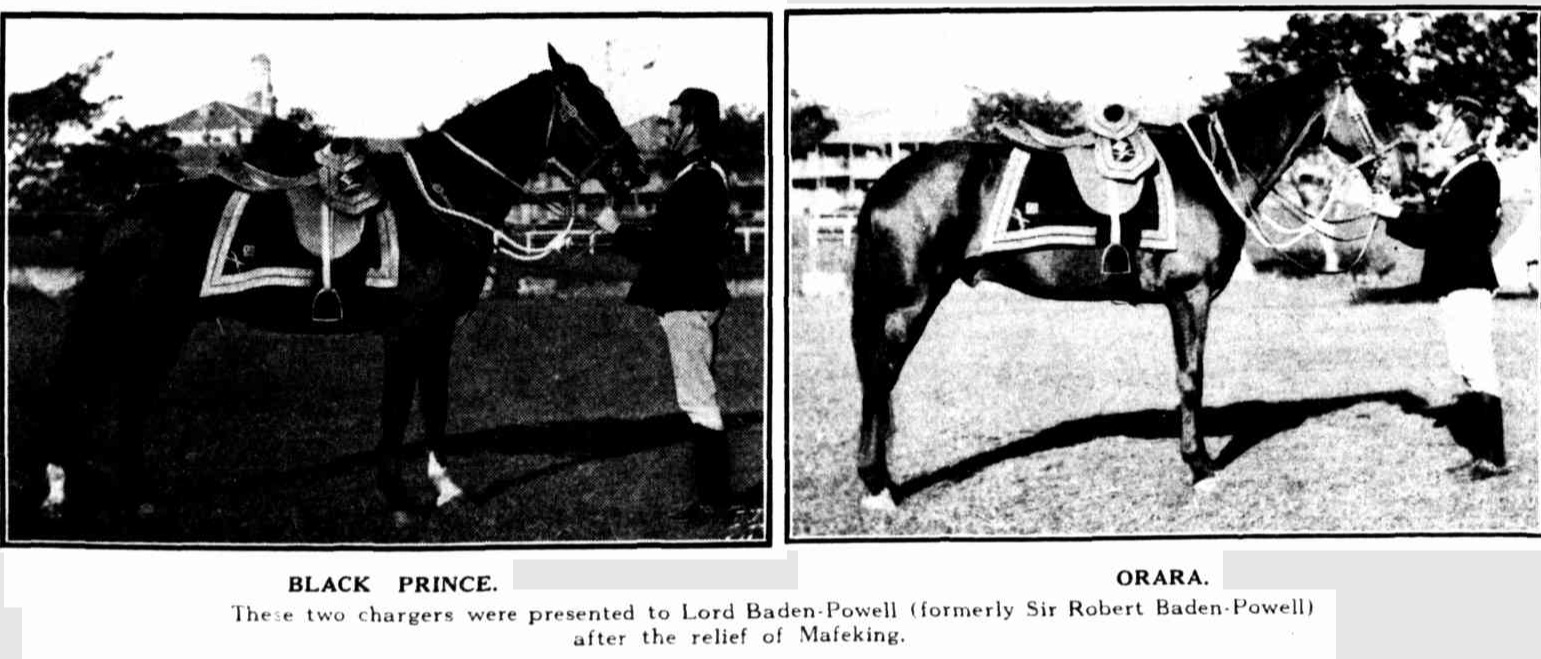
BLACK PRINCE. ORARA. These two chargers were presented to Lord Baden-Powell (formerly Sir Robert Baden-Powell) after the relief of Mafeking.
Baden-Powell (1931, March 18). Sydney Mail (NSW : 1912 - 1938), p. 8. Retrieved from http://nla.gov.au/nla.news-article159790908
Baden-Powell's Chargers.
The chargers and equipments, which are the Australian presentation to the hero of Mafeking were shipped on board the Sussex on Saturday, and, at the invitation of Messrs. Birt and Company (managing agents of the Federal S.N. Company), a large number of citizens visited the vessel to inspect the gifts. The splendid chargers, Orara and Black Prince, are very comfortably housed in the forward part of the ship, where also a large number of other horses intended for military purposes in South Africa are stationed. The horses for Major-General Baden-Powell are in the charge of Mr. J. G. Rowley, who has had very extensive experience in the shipping of horses. They are each Insured for £150, while the saddlery and equipments are insured for £75. The horses are consigned to Sir Alfred Milner, the-High Commissioner in South Africa, who will make the presentation to the Major-General in the presence, if it can be arranged, of some of the Australian troops now in South Africa. There is some delay in forwarding the sword of honor, as the blade is being specially made in England; but that token of esteem will follow in due course. Favorable comment was made by the visitors upon the arrangements for the comfort and safety of the chargers. Australian Town and Country Journal (Sydney, NSW : 1870 - 1907), Saturday 27 October 1900, page 22
Add to this articles such as this run by the Sydney Mail at that time and seen by the men who would form these first troops of Boy Scouts at Manly and Narrabeen after serving in that Boer War :
A MILITARY PICNIC AT MANLY 1860
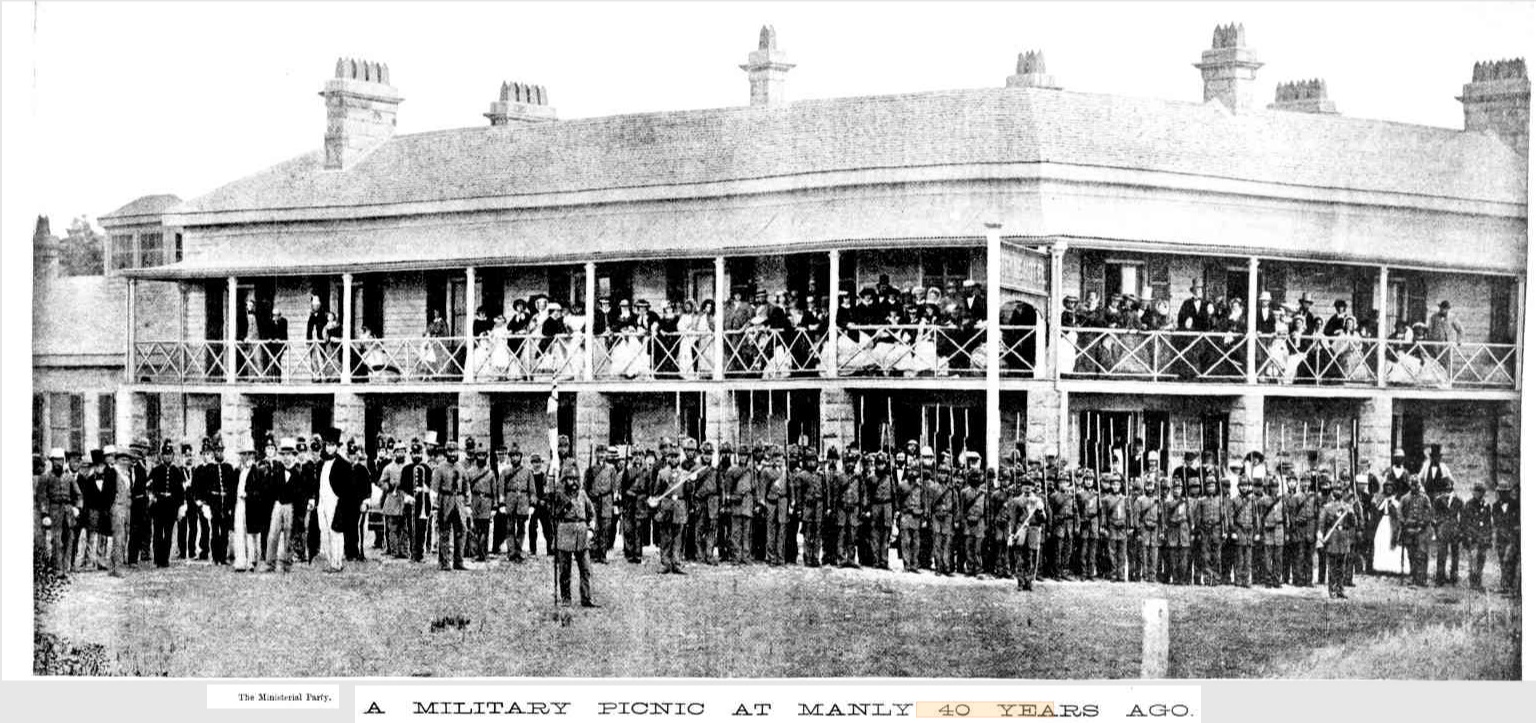
THE Steyne is one of the household words of Manly, and as far back as one can remember it seems to have been co-existed with the marine village. The myriads that have visited Manly since the Steyne was erected have passed this historic structure on their way to the ocean beach, and even at the present day casual visitors carry away with them a vague, bur, of course, erroneous impression, that Manly consists of the Corso, the Steyne, and the ocean beach. When the Steyne was erected, it was evidently built to stay, for the solidity of the structure conveys the idea that it was meant as a menace to any possible encroachment on the part of old Father Neptune as represented by the Pacific Ocean. Even now, the peculiar configuration of the land provokes discussion as to the probability of the ocean having originally covered the area between the ocean beach and the waters of the Harbour, and also whether it is not possible that the ocean may one day depart from its ' pacific ' character, and with a huge tidal wave sweep Manly out of existence. However, this contretemps has not happened since Captain Cook first discovered these shores, and it is opined that it is not likely to occur.
The illustration given, is taken from a photo kindly lent by Lady Windeyer, representing a picnic given at the ' Steyne ' on St. Andrew's Day, November 30, 1861 (nearly 40 years ago), and arranged by the members of No. 2 Company of the Sydney Battalion of Volunteer Rifles, commanded by Captain Windeyer. This relic of the past should be interesting to the public generally as showing what photography could do even in these days, for the likenesses of the gallant captain himself and some of the well-known men of that time — Mr. Cowper, Mr. Robertson, Mr. Arnold, Dr. Woolley — are remarkably good. These will be easily recognised by these who knew the originals at that period. A brief reference to each of the gentlemen referred to would not be out of place, for the benefit of many of the present generation.
Mr. Cowper (a son of the late Ven. Archdeacon Cowper). and subsequently Hon. Sir Charles Cowper, K.C.M.G., was five times Premier of New South Wales, and was Colonial Secretary in Sir John Robertson's Ministry which passed the Land Act of 1861.
Mr Robertson (subsequently Hon. Sir John Robertson, K.C.M.G ) was the author of the famous Land Act of 1861, embodying the principle of 'free selection before survey.' He was five times Premier, and the great political rival of the late Sir Henry Parkes. Sir John, the old 'Knight of Clovelly,' as he was called in later years, was a man who considered that speech was intended to express, and not to conceal, the thoughts. His speech was generally expressed in forcible, outspoken terms, which had at least the merit of being incapable of being misunderstood. One cannot refrain from relating an incident which is said to have occurred while Sir John was Secretary for Lands, and which was highly characteristic of the man. It appealed that he had written a minute directing that a selector should be informed to a certain effect. However, as Sir John's writing was not as legible as it might be, one of the words of the minute puzzled the clerk whose duty it was to inform the selector. The difficulty was overcome by 'tracing' the word exactly as it was, and 'transferring' it in the hope that the selector would recognise it. However, he did not, and, finally, it had to be referred to the original author, Sir John, who, after vainly attempting to interpret his own writing, remarked that he could not tell what the word was, but that it was a jolly good word when he wrote it.
Mr. Arnold (subsequently Hon. William Munnings Arnold. M..L.A.) was at the date of the illustration. Minister for Public Works. He was subsequently Speaker of the Legislative Assembly for 10 years, and was acknowledged to be a most able man in the Speaker's chair. Rev. John Woolley. D C.L., Oxon was Principal of the Sydney University from 1852, and also Professor of Classics and Logic in the University until 1865. -When he visited England and was lost in the ill-fated London when returning to the colony. At a church parade at Christ Church. in 1861 the reverend doctor preached a sermon entitled ' The Soldier's Ministry,' which contained a most touching allusion to the widowhood of her Majesty the Queen. This sermon was published in the ' Herald ' in April, 1862.
Having thus referred to the personality of a few of the notable visitors assembled at the picnic, attention is drawn to the peculiarities of costume which pre vailed in those days, as evidenced in the illustration. The "chimney-pot ' hat and the '' crinoline ' were features of the time. The tall hat of the period was not like the elegant headgear of the present, but was a veritable ' chimney-pot,' and yet the fashionable swells of those days doubtless considered it as the ne plus ultra of elegance and refinement. The 'crinoline' was another extraordinary fashion, borrowed from the mother country. It is a marvel how such a fashion was ever introduced, and a greater marvel still was the length of time it was endured. The sight of it as depicted in the illustration must be interesting to both the waning and the rising generations, in one case reviving faded recollections, and in the other giving an object lesson of what follies in the past their forbears have been guilty. Truly the ' crinoline '' was a ' vanity and vexation of spirit,' not only to the fair wearers, but also to the opposite sex. Who does not remember the Judicious appearance in those days of a ' lord of the creation ' seated inside an omnibus between two enormous bulging crinolines and nothing visible but his chimney-pot hat, his pathetic visage, and his shirt collar? The gales of wind experienced in Sydney a week or two ago are not peculiar to the present time, but obtained also in those days, and it was no uncommon circumstance (as it is even now) to see elderly gentlemen scudding under ' bare polls ' in pursuit of their fleeing head gear. The members of the fair sex in their balloon like crinolines were particularly handicapped in a gale of wind, for they could not, as yachts can do under stress of weather, ' take in a reef,' but had to endure the full fury of the blast. with all its attendant consequences.
Recurring to the subject of the illustration, the picnic to No. 2 Company, it may be interesting to quote a few antecedent facts with regard to the "volunteers.'' It is generally known that the late Sir William Charles Windeyer (then Mr. Windeyer) was the means of reviving the *' volunteer ' movement in this colony, and at the public meeting held in the Victoria Theatre on August 17, l860 (about a month after the ' Sydney Mail ' was first published' he proposed the principal resolution starting the movement, and in doing so incidentally remarked that he had been a member of that much-abused and neglected corps of volunteers, better known as ' The Buffaloes,' which had been formed by certain young men of Sydney in I854-. during the height of the Russian War. At that meeting were present Hon. J. B. Darvall, Captain Scott, Mr. Wild. M.L.A., Mr. Walter Lamb, Mr. Parkes, Lieutenant Siedleir, R.N., and other well-known men. When the different corps were formed the Sydney
The Ministerial Party.
Battalion consisted of six companies. Commissions in these as captains were balloted for on 23rd November, 1860, and the captains elected were : -No. 1 Company, R. Peel Raymond ; No. 2, W. C. Windeyer ; No. 3, W. C. Windeyer ; No. 4. W. Cathcart Still : No. 5, A. G. M'Lean ; No. 6, W. Harbottle. Subsequently, Mr. Fairfax (now Sir James Reading Fairfax) was elected captain of No. 3 Company, Captain Windeyer retaining command of No. 2. About the same time John M'Leinie was appointed captain of the first troop of the Mounted Rifles. Uniforms were issued to the volunteers in April, 1861, and the companies of the Sydney Battalion were presented with colours in May, 1861, except No. 6, which received them in the September following. It was shortly after this that the picnic, the subject of the illustration, took place.
Whilst referring to picnics it be pointed out that the Manly travelling facilities at that time were by no means so numerous as they are now. Instead of the fleet of commodious steamers which now run at short intervals between Sydney and Manly, one steamer only, the Phantom, used to ply to Manly and back three times a day, calling at Woolloomooloo Bay en-route. The fare was a shilling each way.
At the picnic there were 450 present, including about 100 ladies and 54 members of the company. The photograph of the group was taken by Mr. Glaister, then well known as the best Sydney photographer. The chair at the dinner, which was laid out by Mr, Chalk, the host of the Steyne, in a large building adjoining the Steyne Hotel, was presided over by Captain Windeyer — the Ministry on his right and left— amongst those present being Lieutenant-Adjutant Baynes, Mr. S. A. Joseph, Mr. Wilshire. Mr. Nesbitt, Lieutenant Wilson, &c.
The main feature of the picnic was the cordiality of the Ministry towards the volunteers. Mr. Robertson, when proposing the health of Captain Windeyer, mentioned that he (the captain) was the son of one of the greatest men who had ever appeared in this country, and who was one of his (Mr. Robertson's0 earliest and warmest friends. He said also that the captain was a gentleman who had distinguished himself in every walk of life that he had entered upon ; he had been the most enthusiastic, the most indefatigable in obtaining the establishment of the volunteer movement, and had, as one result, been elected captain by two companies. Captain Windeyer, in responding, acknowledged Sir John Robertson's kind remarks. It is evident from the report of this picnic, and others that took place in the ' sixties,' that loyalty was then as strong in the colony as it is now, and the late Sir Henry Parkes's disparaging allusion to our '’tin soldiers '' (which provoked the greatest indigitation in Sir William) has had the most complete refutation in the deeds done by our colonial troops on the veldts and kopjes of South Africa, where their soldierly qualities have won them golden opinions from the British generals. In order to show that at that time civilians were not behind the military in the use of the rifle, it may be mentioned that at the fifth annual ' wayzegoose' of the'' Herald ' Office, held at the ' Steyne ' on August 24, 1861, shortly before the picnic already discussed, the first and second prizes in a rifle match were won by W. Rayner, reporter, and Mr. Samuel Cook, at that time the head of the Parliamentary repotting staff, but at present the general manager of the ' Herald ' Office. These two were civilians ; the third prize was won by a Mr. Kirkptrick, a compositor, who was a volunteer. A MILITARY PICNIC AT MANLY 40 YEARS AGO (1900, June 23). The Sydney Mail and New South Wales Advertiser (NSW : 1871 - 1912), p. 1472. Retrieved from http://nla.gov.au/nla.news-article165296719
The first Troop to be formed at Manly is advertised in November 1908 and named the 'Eagles':
MANLY ('Eagles'). — This patrol has been formed at Manly. W. Allison is leader; H Hele, corporal ; and the others are E. Gilbert, R. A. Porter, R. McCluese, and C. E. Smail. The patrol has been working hard, and has passed the second class exam. AMONG THE PATROLS. (1908, November 1). Sunday Times (Sydney, NSW : 1895 - 1930), p. 3 (The Sunday Times MAGAZINE SECTION). Retrieved from http://nla.gov.au/nla.news-article126749847
William Henry Cory Allison was involved in North Steyne Surf Club as well as swimming (champion) and lacrosse at Manly. Born at Newcastle in 1886 to George Duncan and Louisa Elston Allison he went on to serve in WWI. Employed as an Inspector with the Department of Public Health he lived with his parents at 19 Pacific Street Manly. On the 22nd December 1915 he embarked at Sydney on the H.M.A.T. Kanowna for the United Kingdom and Alexandria. William served in the 1st Dermatological Hospital. He returned to Port Darwin on the 27th July 1919 and was discharged on the 19th September 1919. He married in 1925 and lived at Balgowlah and Cremorne, until he passed away on January 28th 1953.
'Bill' Allison would have known Robert 'Bob' Edward Adrian as another family member of the Adrian clan and Allison were members of the Manly Swimming Club, and 'Bob' was also a Manly sportsman of renown during that era as a cyclist, although it is 'Tommy' Adrian who would win great accolades in the swimming arena. Bob Adrian ran the Manly Patrol briefly until he handed over to Charles Foggon. By June 1909 a Troop instead of just a Patrol is published:
AMONG THE PATROLS.
NO. 1 DISTRICT. Under the direction of the Committee of Control, S.S.M. Hope swore in the following scouts at Manly last Saturday :—No. 1 Patrol : Leader A. Clarke, Corp. F. Piggott, Scouts J. Miller, C. Townshend, S. Grimes, H. Farr, S. Turner, B. Carroll. No. 2 Patrol : Leader J. Skinner, Corp. H. Forster, Scouts N. Griffin, A. Savage, C. Beilby, C. Hardy, J. Simper, J. McLaughlin. No. 3 Patrol : Leader, C. Smith, Corp. N. Lyons, Scouts M. Phillips, G. Evans, D. Evans, C. Brown, E. Todd, D. McLeod. No. 4 Patrol : Leader F. Daley, Corp. W. Roberts, Scouts R. Walker, F. Morion, L. Bridge, J. Burnett, C. Gibbons, H. Dale. Unattached : Scouts F. Stewart, S. Price, C. Lawler, M. McAuliffe. Mr. C. Foggon has been appointed scoutmaster in charge of the troop.
No. 2 DISTRICT. Senior-Scoutmaster Valentine reports that last Saturday the North Sydney Troop had an exciting war game at Berry's Bay. On the march out Mr. Ravenscroft took a photograph of the troop, which he intends to send home to Lord Roberts. Mr. Ravenscroft was very pleased with the appearance of the troops. There are now three buglers in our troop, and a fife band in the 2nd North Sydney. The troop meets every Tuesday evening in their room in Walker-street, North Sydney, where either a lecture or instruction in various subjects are given. At last meeting five recruits took the scout oath, and were admitted into the various patrols. Picked boys from the North Sydney 1st Troop are busy rehearsing a play for production at a concert, at which the presentation of medals and prizes for the past six months will be made. The concert promises to be a great success. Troops and patrols are springing up everywhere in this district, which make it a very large an progressive one. The Boys' Brigade of North Sydney had amalgamated with the Boy Scouts. North Sydney 2nd Troop.—Assistant-Scoutmaster R. Penly reports that last week this troop went into camp at Neutral Bay. They also visited H.M.S. Powerful, and found much to interest in this visit. A fifth patrol has been formed, under Patrol-leader Boydant. Crow's Nest.—A.S.M. Huddy reports that this troop is now in full swing. There are three complete patrols—Wood Pigeons (Leader H. Quin- ton), Curlews (Leader F. Johnston), and Kanga-roos (Leader J. Gallagher). Last Saturday was spent at Sailor Bay, where instruction was given in hut and bridge building. Lane Cove.—Scoutmaster Venn Brown reports that last Saturday morning tracking was practised. During the week the following boys passed their first-class examinations : Corps. Clarke and Swallow, Scouts Wallis, Lavers, Forsyth, and Henderson. AMONG THE PATROLS. (1909, June 20). Sunday Times (Sydney, NSW : 1895 - 1930), p. 3 (The Sunday Times MAGAZING SECTION). Retrieved from http://nla.gov.au/nla.news-article126581870
BOY SCOUTS AT MANLY.
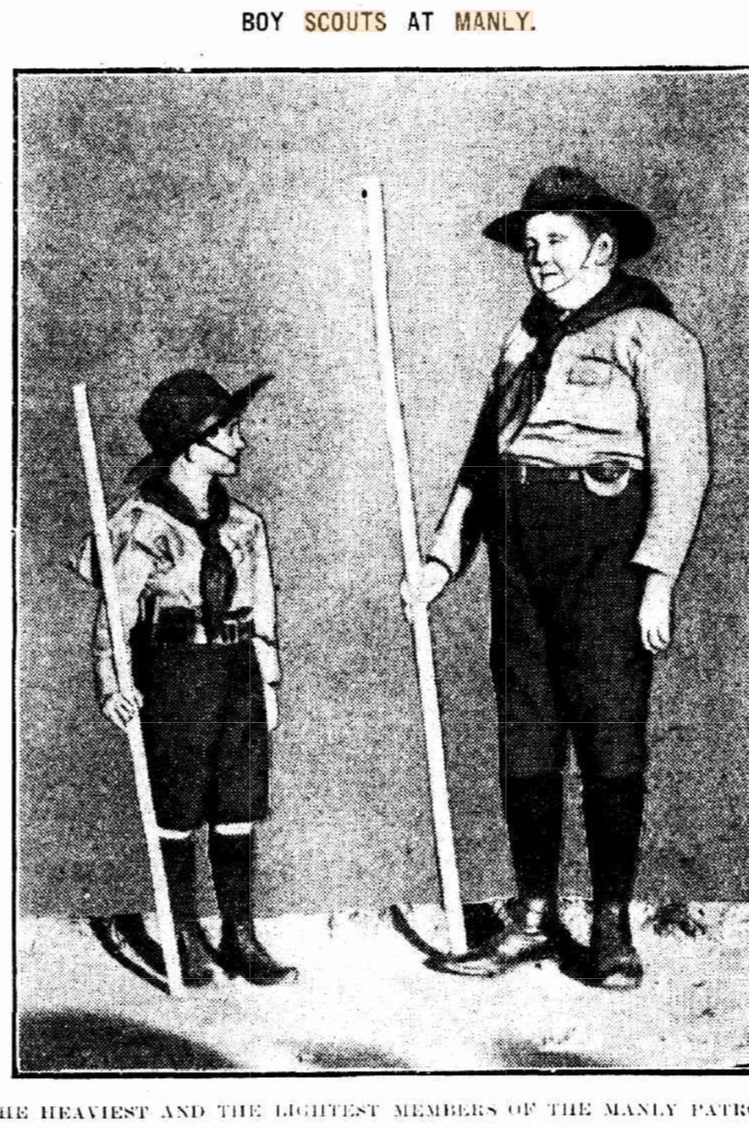
THE HEAVIEST AND THE LIGHTEST MEMBERS OF THE MANLY PATROL BOY SCOUTS AT MANLY. (1909, June 28). The Daily Telegraph (Sydney, NSW : 1883 - 1930), p. 9. Retrieved from http://nla.gov.au/nla.news-article238287523
Some of their activities:
AMONG THE PATROLS
NO 1 DISTRICT – Manly; scoutmaster Foggon reports that a successful afternoon’s work was carried out last Saturday. The Troop was marched out to Balgowlah. Having arrived there a base of operations was established and patrols were sent out in various directions with instructions to find their way back, unseen, by a different track to that on which they set out. After this, three scouts were sent out, unbeknown to the remainder, who, having given them a reasonable start, set out to track them. The tracking was very satisfactory, but the three that had been sent out arrived at the base without being caught, after being chased for about half an hour.
The following is the personnel of this Troop: Scoutmaster Foggon. No 1 Patrol; Leader A. Clarke, Corporal; F. Piggott, Scouts; J. Miller, C. Townshend, S. Grimes, H. Farr, and B. Carroll. No 2 Patrol; Leader; J. Skinner, Corporal; H. Forster, Scouts; N. Gritilin, A, Savage, C. Reilly, H. Hardy, J. McLaughlin and M. MacAuliffe. No 3 Patrol; Leader; C. Smith, Corporal; N. Lyons, Scouts; S. Turner, J. Bonner, F. Stewart, C. Bown, G. Todd and D. McLeod. No 4 Patrol; Leader; F. Dully, Corporal; B. McEwan, Scouts; R. Walker, M. Phillips, L. Bridge, J. Burnett, C. Gibbons and H. Dale. No 5 Patrol; Leader; A. Phillips, Corporal; L. Scully, Scouts; D. Doherty, M. Tomm, H. Macconi, B. Johnston, F. Roberts and B. Dunn. No 6. Patrol; Leader; G. Evans, Corporal; R. Goldsborough, Scouts; D. Evans, M. Goldsborough, Scouts; D. Evans, M. Goldsborough, R. Dart, J. Lawler, J. Travers, and M. Young. Scouts Luker V. Smith, G. Patrick, W. Charters, and W. Maddock are yet to be allotted to Patrols.
No 2. District – SSM Valentine reports that last weekend the district held a two-days camp at Mr. Mark Foy’s ground at Killara …..
Scout-master Sheedy, of the Petersham 2nd Troop, gave a very interesting recount of his experience in South Africa during the Boer War. Drill, as prescribed by ...;is engaged in, and the evening ended in various scouting games. Petersham 2nd Troop.— Scout -master Sheedy reports that a couple of recruits presented themselves for enrolment at the meeting on Tuesday evening. After a little preliminary drill and instruction in lifting the wounded; and how to find water when in the Held, a short but very interesting account of his doings in South Africa. AMONG THE PATROLS. (1909, July 4). Sunday Times (Sydney, NSW : 1895 - 1930), p. 3 (The Sunday Times MAGAZING SECTION). Retrieved from http://nla.gov.au/nla.news-article126576772
By August 1909 a Patrol at Narrabeen has eventuated:
Among the Patrols…
No. 22 DISTRICT. Manly A. S.S.M. Foggan reports that the Manly Scouts are going ahead splendidly. There are now 58 on the roll and six at Narrabeen under S.M. Chester. Meetings are held two nights Weekly, and an outing every Saturday afternoon. The Scouts are well on with knot tieing and signalling, and are making arrangements for first aid lectures. They have now secured a hall. On Saturday, July 31, they went to Freshwater, where they had attack and defence ; the defenders were victorious, although the attacking party, under Quarter-Master C. Smith, worked very well. Last Monday night a paper-chase was held, the hares having twenty minutes' start over a course of about four miles. The hounds arrived only a couple of minutes after them. Last Saturday, 7th inst., a despatch run between Manly and Narrabeen und Manly and The Spit was held. The Narrabeen boys joined in. A Scout was placed at each mile-post. The foot messengers left Manly at 3 p.m. and arrived back at 4.50 p.m. The mounted section left 3.15 and arrived at 4.25. The cyclist section left 3.30 and arrived back 4.30, the distance in all being 14 miles. The S.S.M. had charge of Manly end and S.M. Chester at Narrabeen. The Spit run was carried out by the rest of the Scouts being placed about every eight or nine telegraph poles apart. The message left 4.35, and arrived back at 5.25 a distance of about 3 ½ miles. The Scouts were very eager for this run, and enjoyed it very much. AMONG THE PATROLS. (1909, August 15). Sunday Times (Sydney, NSW : 1895 - 1930), p. 15. Retrieved from http://nla.gov.au/nla.news-article126588620
No. 22 DISTRICT (Manly and Narrabeen).— A. S.S.M. Foggon, Freshwater, Manly.. RECRUITING OFFICE. (1909, August 22). Sunday Times (Sydney, NSW : 1895 - 1930), p. 15. Retrieved from http://nla.gov.au/nla.news-article126571360
The Manly Troop were present when a Balloon ascent from Ivanhoe Park took place in September:
Captain Penfold at Manly.
The first of a series of balloon ascent entertainments was given at Manly yesterday. No more suitable site could have been chosen for the event. A large crowd of spectators viewed the proceedings from the Manly Oval, where a charge, was made for admission to defray the expenses in connection with the proposed erection of a cricket pavilion. Yesterday's ascent was arranged by the Mayor and aldermen of Manly, and the committee will now be in a position to show a very profitable balance-sheet. After a great, deal of excitement the ropes were cut at about 4.45 p.m., and, with a general chorus of "Advance Australia!" and ''Advance Manly!" the aeronaut set off on his perilous flight. ' When he appeared but a dim speck in the heavens, the parachute was parted, and Captain Penfold gradually returned to earth, " He fell rather heavily on the flat rocks on the heights in Augusta-road, but beyond a slight bruise on the right hand, he landed safely. A troop of the Manly Boys' Scouts, under Scout-master Foggan, were lying in ambush, and set off for the spot. . Within twelve minutes of their departure they were' patrolling the oval with the aeronauts' parachute. Captain Penfold returned a few minutes later. Music and Drama (1909, September 5). The Sunday Sun (Sydney, NSW : 1903 - 1910), p. 3. Retrieved from http://nla.gov.au/nla.news-article227021219
Vincent Patrick Taylor (Captain Penfold) was a brother of George Augustine Taylor (1872-1928) who was the first to fly in Australia, at Narrabeen, in December 1909.
3000 BOY SCOUTS.
There are now about 3000 Roy. Scouts in New South Wales, and the rate of progress Is Increasing. The movement is entirely voluntary, and run without' Government assistance of any kind, gentlemen who are justified and willing are invited to communicate with the Council of Control (Box 444, G.P.O:) . In reference to positions as scoutmasters. Every care is taken in the selection of these officers. 3000 BOY SCOUTS. (1909, August 15). Sunday Times (Sydney, NSW : 1895 - 1930), p. 7. Retrieved from http://nla.gov.au/nla.news-article126588886
No. 22 DISTRICT.
Manly.— Q.M. Smith reports that his troop held a swimming parade last Saturday at the local swimming baths. They held several races. The results were :-Championship Scouts : J. Miller1, M. Phillips 2, B. Johnstone 3. 50yds : J. Miller 1, F. Roberts 2. The scouts played a cricket match against the Manly Public School, and won by one run. AMONG THE PATROLS. (1910, March 13). Sunday Times (Sydney, NSW : 1895 - 1930), p. 15. Retrieved, from http://nla.gov.au/nla.news-article123817562
No 22 DISTRICT (Manly and Narrabeen).— S.S. M Foggon, 193 Goulburn-street, City. RECRUITING OFFICES. (1910, April 10). Sunday Times (Sydney, NSW : 1895 - 1930), p. 15. Retrieved from http://nla.gov.au/nla.news-article123836229
No. 1 DIVISION. ...Manly.-S.M. Smith. Clifford Avenue HOW TO JOIN THE BOY SCOUTS. (1910, September 4). Sunday Times (Sydney, NSW : 1895 - 1930), p. 15. Retrieved from http://nla.gov.au/nla.news-article123837222
Scouting along the Newport Road (11 Mile Post was Porters shops at Bungan-Mona Vale – Newport)
THE COMBINED 'CAMP AT NARRABEEN
The combined trek and camp of the school of instruction for quartermasters, the cyclist troop, and the Manly troop was brought to a successful issue last week-end. All the boys concerned, mustered at Brookvale on Saturday afternoon at 3 o'clock the D.C.S.M. being in command. The operations commenced straight away. An enemy was supposed to have effected a landing at Broken Bay, and was pushing his way towards Sydney from: the north. His scouts had been seen by the defenders right along the Manly-Newport-road. The column drawn up and scouts were flung out to protect the line of march. The cyclist troop acted as light horse in this respect. The march ended at Narrabeen where a position was taken up. The scouts were all billeted under active service conditions. After the evening meal scouts were sent out to locate the position of the enemy, and to obtain information as to the possibility of attacking or attack. In this work the cyclist troop acquitted themselves very well. Upon information received, it was decided to attack.
A night march was made in absolute silence. The enemy was not met until the 11 mile post had been reached, where a sharp brush occurred with one of his detached posts. This post was quickly reinforced by more enemy, and the only thing for the defenders to do was to retire on their position at Narrabeen. The retreat was carried out with the same decree of order us the attack had been, and no fault could be found with the work. All orders were passed along a splendid line of communication. The cyclist troop protected the retreat. All those in the operation were of the opinion that it was the finest sham fight in which they had ever participated. Great credit reflects on all ranks for the perfect order that was maintained, although excitement ran high during the whole of the manoeuvres. On the following day the C.S.M. inspected all present. The dismounted and cyclist scouts were Inspected separately, and the C.S.M. was very pleased with the work done. The different units trekked back to Manly later in the afternoon, well satisfied with the time they had had. One thing certain is that the quarter-masters benefited greatly by the instruction they received, and will be able to impart it to their troops. No doubt they will arrange similar operations in their own troops. THE COMBINED CAMP AT NARRABEEN. (1910, September 11). Sunday Times (Sydney, NSW : 1895 - 1930), p. 17. Retrieved from http://nla.gov.au/nla.news-article123832071
THE SCHOOL OF INSTRUCTION FOR QUARTER MASTERS.
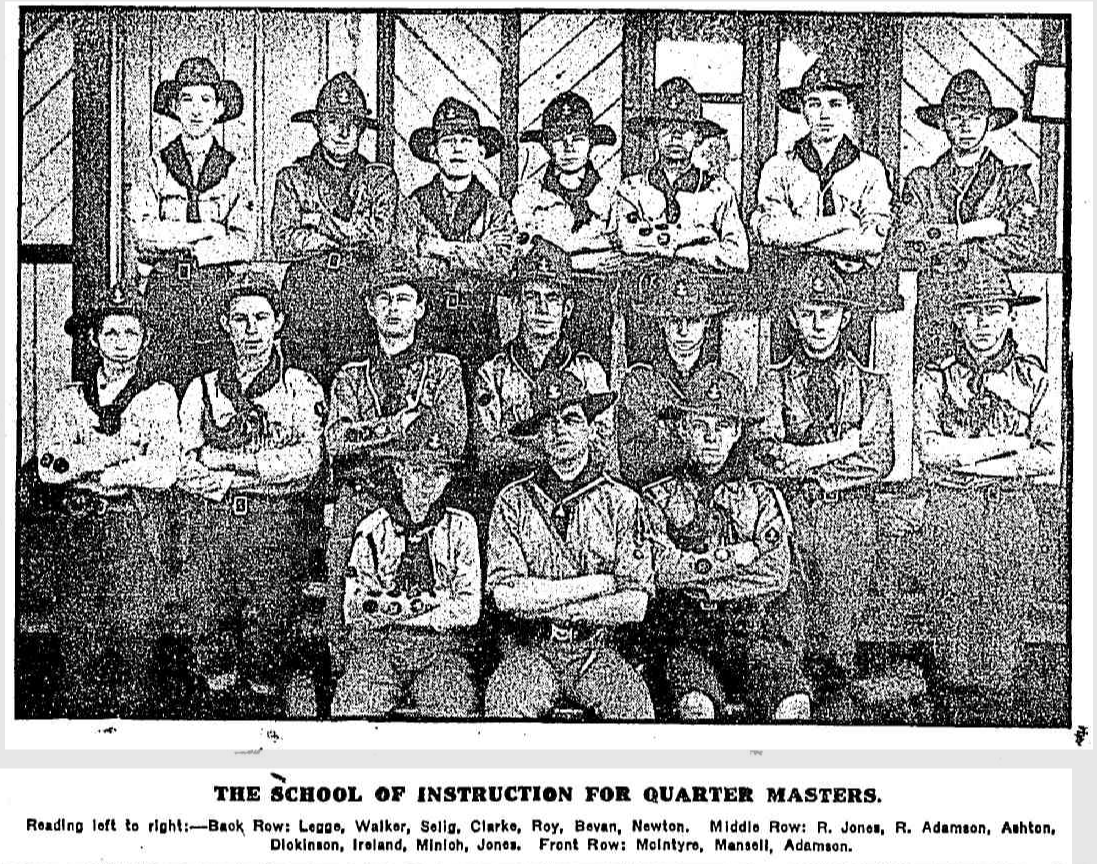
Reading left to right: — Back, Row: Lease, Walker, Selig, Clarke, Roy, Bevan, Newton. Middle Row: R. Jones, R. Adamson, Ashton, Dickinson, Ireland, Minich, Jones. Front Row: McIntyre, Mansell, Adamson. OBSERVATORY HILL TROOP. (1910, September 11). Sunday Times (Sydney, NSW : 1895 - 1930), p. 17. Retrieved from http://nla.gov.au/nla.news-article123832050
A SCOUT IS A FRIEND TO ANIMALS.
So says the Scout Law. Last Wednesday week -Scouts E. Scrivener and J. Rodger, of the Laurieton (Camden Haven) Troop, saw a wallaby in difficulties in the river. In obedience to their chivalrous code, they procured a boat, close handy, and rowed out to the struggling animal. Lifting it into the boat, they brought it ashore, and gave the poor beast its liberty. A boy (not a scout) on the bank said, 'Kill It !' But he was answered : 'We are scouts, and must befriend animals,' plainly showing that the scout movement is a great influence for good in the morals of this community. "A SCOUT IS A FRIEND TO ANIMALS." (1910, September 11). Sunday Times (Sydney, NSW : 1895 - 1930), p. 17. Retrieved from http://nla.gov.au/nla.news-article123832076
THE MANLY TROOP.
Q.M. Walker reports that a special meeting was held on Wednesday, August 24, for the purpose of electing a new quartermaster and new leaders and corporals. Two recruits were sworn in. The following are the details of the troop :— -No. 1 Patrol.— Leader, L. Lawrence ; corporal, C. Brown ; scouts, B. Johnson, B. Walker, M. Phillips, B. Carrol. No. 2 Patrol. — Leader, O. Phillips ; corporal, N. Thorn ; scouts, H. Farr, C. Davidson, M, Tlioni, J. Miller. No. 3 Patrol (unattached). — J. Bonner, H. Maccioni, It. Davidson, -r . Jones, CI. Thompson ; cyclists, S. Grimes, J. Bonner, M. Phillips, E. Woods ; treasurer. Quarter-master R, Walker ; troop bugler, L. Lawrence ; troop signaller, C. Brown ; secretary, B. Johnson. THE MANLY TROOP. (1910, September 11). Sunday Times (Sydney, NSW : 1895 - 1930), p. 17. Retrieved from http://nla.gov.au/nla.news-article123832053
MANLY BOY SCOUTS.
The Manly Boy Scouts attended the examination for proficiency in the training shed at Manly recently. The tests consisted of knot-tieing, scout law, scouts' signs and salutes, and the composition of the Union Jack. Mr. Fred Notting acted as judge of the knot-tieing, and Messrs. S. M. M'Auliffe and G. M. Smith for the remainder, Senior-Scoutmaster Foggan superintending. The following candidates passed:— R. Dart, C. Fallon, M. Thorn, N. Thorn, L. Bridge, V. Smith, D. M'Leod, B. Johnson, C. Gibbons, M. Goldsborough, F. Roberts, B. Carroll, S. Sheppard, H. Macconi, R. Phillips, R. Walker, C. Brown, M. M'Auliffe, F. Stewart, R. Goldsborough, J. Burnett, D. Doherty, C. Susan, N. Griffin, M. Phillips, J. Skinner, and A. Savage. MANLY BOY SCOUTS. (1909, September 12). The Sunday Sun (Sydney, NSW : 1903 - 1910), p. 6. Retrieved from http://nla.gov.au/nla.news-article227021572
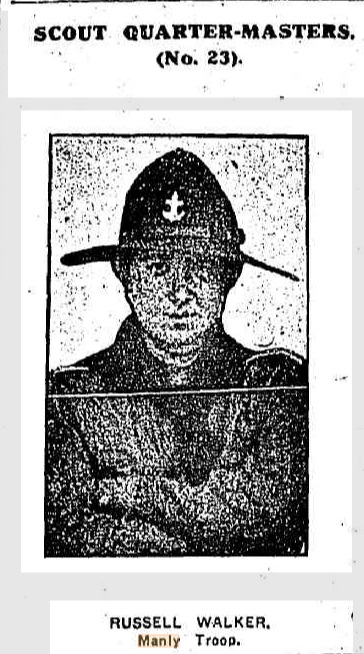
SCOUT QUARTER-MASTERS. (No. 23). RUSSELL WALKER. Manly Troop. AMONG THE PATROLS. (1910, November 6). Sunday Times (Sydney, NSW : 1895 - 1930), p. 17. Retrieved from http://nla.gov.au/nla.news-article123835405
One of the first whole membership qualified troops in lifesaving was:
BOY SCOUTS AS LIFE-SAVERS.
Among the candidates who recently passed at Casino for the Royal Life Saving Society's certificate of proficiency were five members of the Casino 'Cuckoo' Boys' Scouts, who had been drilled by their scout master. This is the first patrol of boy scouts to qualify in Australasia as life savers, and no doubt many at the patrols throughout New South Wales will emulate the Casino boys nest season. BOY SCOUTS AS LIFE-SAVERS. (1909, April 27). Evening News (Sydney, NSW : 1869 - 1931), p. 10. Retrieved from http://nla.gov.au/nla.news-article115502330
Boy Scouts.
By Scout Master.
When the members of the Casino Cuckoo Patrol Boy Scouts passed their examination in life-saving, I sent a group photo to our leader, General Baden-Powell, in England and also wrote to the editor of the Sunday "Times" in Sydney, notifying the fact that my patrol was the first in Australia, and probably in the world, to ' go up for that "useful test. I hope to hear from General Baden-Powell in a week or two now in reply. ' The editor of the Sunday " Times" made no reference to the fact until Mr. Williams, the examiner, reported the result of the life-saving examination in Casino. The " Daily Telegraph" had a report of it, so I wrote to its editor offering to supply a group photo of the life-saving scouts for illustration. By return mail I got a courteous reply asking me to forward the photo. This I did on Saturday, and most likely our scout's group will be published in that paper this week. It is pleasant to state that two other patrols have been formed in Casino, one seniors, and the other juniors. The three patrols form a troop and Casino has the distinction of being the first town on the Northern Rivers in which a troop of scouts has been organised.
During this winter I hope to have every member of the scouts pass the ambulance and first aid test and have them all up for the life-saving test in the water before the end of the year, some for the second, (bronze medallion), and the rest for the proficiency, examinations. The ambulance and first aid work is most useful and, combined with the knowledge of rescuing drowning persons, will make our boy scouts most serviceable members of society. It is difficult to obtain the sympathy or recognition of the public in such matters, but it is hoped that the co-operation of the Municipal Council and military authorities may be secured. Nearly all the members are cadets, but there is room for several civilian patrols of boy scouts and it is as easy to put fifty through the drill as one patrol. The standard laid down by General Baden-Powell in his ' book '' Scouting for boys," is a high one, and is based on the manly and chivalrous lines of gentlemanly conduct. The exercises will be interesting and instructive, and will entail occasional camping out in the bush under conditions that would obtain in case of war. Scouting knowledge would be a valuable adjunct to the cadets' curriculum and life saving and a thorough acquaintance with ambulance and first-aid drill would make them ideal Australian soldiers.
I am aware that nothing succeeds like success; and after the manner in which the pupils set about their task of learning the life-saving drill in eight days, I have the greatest faith in them turning out first-class scouts. It will be necessary now to get a meeting room and provide the appliances and equipment for physical and mental exercises, that in any case will make them better men than they would be without it. Spasmodic attempts have been made in the direction of forming a gymnastic club, and some of the senior members of that club are quite capable of teaching the juniors very useful exercises ; but such attempts generally end in failure unless the leading men of the town take a hand. The Town Band and Fire Brigade are examples. They are both most creditable to the town, but if they had not been backed 'up by the practical support of a few leading citizens, they would have never arrived at their present status. The ambulance and first-aid class has practically died out, but it is expected that by the end of this year at least fifty Casino lads will have won the badge of competency in ambulance work. I am endeavouring to secure the co-operation of the towns on these Northern Rivers in forming branches, and arranging a central executive association wherever it may be considered most suitable to work, in harmony with, but independently of, the metropolitan bodies, in scouting and life saving. I can ill spare the time to carry these movements on successfully, and when someone more capable is available I will gladly hand over the management and assist privately to form a Northern Rivers Brigade of boy scouts equal to any in the world. Until such a one tarns up, I will carry it on as best I can, trusting that the boys' parents will realise the importance of the movement and encourage their sons to become proficient in the accomplishments that later on will result in an army of citizen soldiery nobler and grander, more Australian and more British than the gift of a dozen "Dreadnoughts." Boy Scouts. (1909, May 12). Casino and Kyogle Courier and North Coast Advertiser (NSW : 1904 - 1932), p. 5. Retrieved from http://nla.gov.au/nla.news-article233914364
SCOUTS AT PLAY. , THE MANLY TROOP AT TUG-OF-WAR
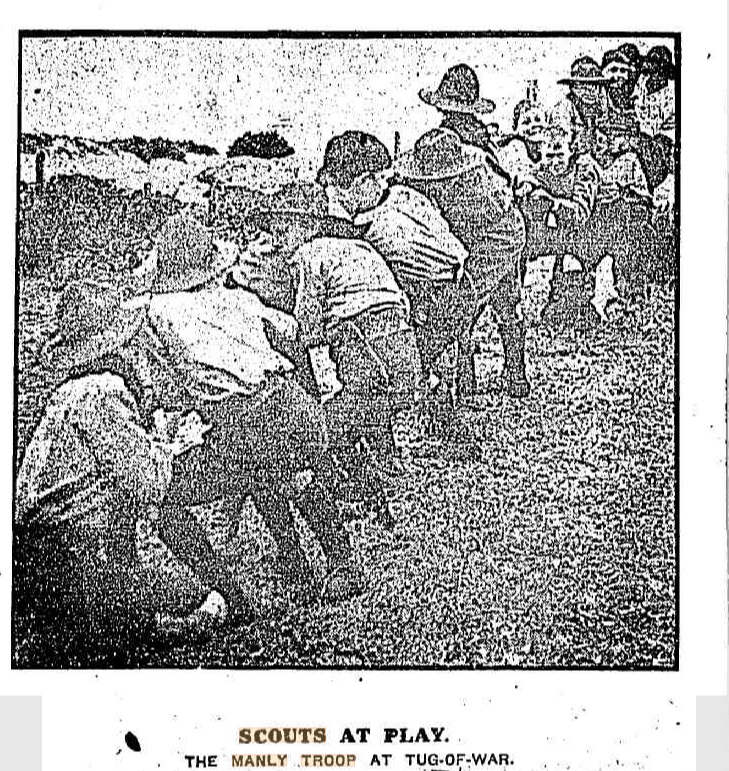
WOOLLAHRA TROOP. (1910, October 30). Sunday Times (Sydney, NSW : 1895 - 1930), p. 17. Retrieved from http://nla.gov.au/nla.news-article123822683
By October 1910 those who held a lifesaving certificate from the Royal Life-saving Society could automatically get the lifesaving badge form scouts for their uniforms and scouts were advised to go ahead and do this training and gain that certificate.
BOY SCOUTS AND LIFE-SAVING.
Quartermaster J. Clark, of the Petersham First Troop of Boy Scouts, and Scout Turner, of the Balmain East Troop, have been awarded the silver cross by the council of control for saving life. This is the first time the award has been made in Australia. As orders for the cross have to be sent to England, the presentation will not be made for some weeks. A troop has been formed at Macksville, on the Nambucca River, by Scoutmaster W. G. Smart. The scouts are taught first aid and signalling, etc., and have week-end outings.
Mr. T. R. Roydhouse, the chairman of the council of control, is on a holiday in New Zealand, and intends discussing with the league authorities there matters concerning the scouts' organisations. It is intended to arrange a scoutmaster class in life-saving. The lectures will be delivered by members of the Royal Life-saving Society. There will be a nominal fee of a shilling for scoutmasters, which includes the certificate. Scoutmasters who are desirous of joining this class are requested to communicate -with the general secretary (Mr. A. D. Johnston, S.S.M.) at once.
It has been decided by the council of control that every patrol shall be attached to a district, and that each district shall be In charge of a senior- scoutmaster. All districts will be in a division, which will be in charge of a divisional scoutmaster. Returns are being prepared of all scouts in the division. These are to be supplied to the general secretary, Staff Scoutmaster A. D. Johnston, by February 25. BOY SCOUTS AND LIFE-SAVING. (1910, February 17). Evening News (Sydney, NSW : 1869 - 1931), p. 2. Retrieved from http://nla.gov.au/nla.news-article116048845
Many a report from Sydney area scout troops that ventured to Narrabeen for camping records that one or another member of the troops saved someone while there. The impact of young men and young women being trained to help others in this capacity shows through in just one report a decade and a half on, from May the previous year (?):
LIFE SAVING BY SCOUTS.
It will interest every Scout to know that, up till May this year, the following is the total of gallant deeds performed by Boy Scouts. Nine Scouts have given their lives in attempting to save the lives of others. One thousand and fifty-two lives have been saved from drowning by Scouts. Fifty lives have been saved from fire by Scouts. One hundred and sixty-five runaway horses have been stopped. Forty-two cases have been rewarded where Scouts have given help to police in difficult circumstances. Two hundred and forty-nine other cases of gallantry, not coming under the above heads, have also been rewarded. I call it a jolly good record for boys! LIFE SAVING BY SCOUTS. (1926, February 7). Sunday Times (Sydney, NSW : 1895 - 1930), p. 6 (PRANKS The Children's Newspaper). Retrieved from http://nla.gov.au/nla.news-article128134797
Although girls were excluded from joining Boy Scouts as it was deemed tramping about in the bush was an unsuitable activity for them they too had access to a similar skill set being offered.
The emphasis from the outset was to provide self-empowerment, self-reliance and self-pride and to do this through providing skills that would set each Boy Scout or Ranger with lifelong physical skills that would also enable and promote those that are unseen, or 'inner' skills such as resilience and fortitude and to do this with practical knowledge. This spread and grew, or changed with the times although the message and the way it was practiced was always in the same framework that is utilised today.
Scoutcraft, as one of the cores, evolved from the skills people needed when venturing into wilderness so that they could sustain themselves, keep themselves safe, and not get lost. Skills needed were and are camping, cooking, first aid, wilderness survival, orienteering and pioneering. Scoutcraft encourages self-reliance, resourcefulness and confidence in an individual's own ability, develops skills to be used in the outdoors and provides training for what to do in emergency situations - ergo 'Be Prepared'.
The other priority was to be part of the community, to contribute to and build the community and in doing so, recognise you are a part of your community - valued, able to do something worthwhile that will benefit others as much as yourself.
Equally important was also developing your own spirituality and although this began in reference to one particular church, there was still an element of recognising that every individual is having an ongoing unheard by any other conversation with something, be it a Christian God, Nature, their own soul, and that the act of prayer, 'orare', enunciating what you may need to grow or what you would wish for others, is of benefit too.
Independence and self-reliance in the bush was paralleled by a focus on having financial independence and self-reliance too.
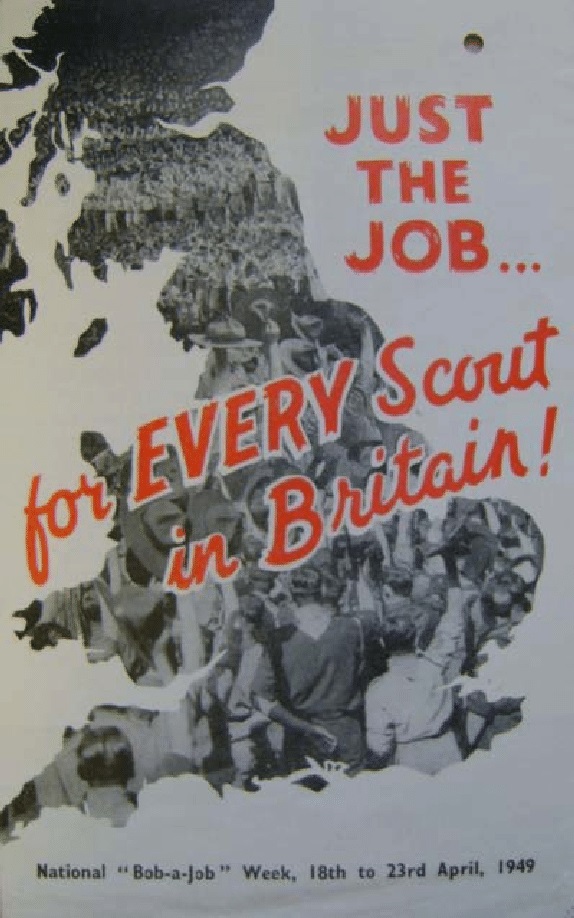 Job Week was first introduced as a ''good turn day'' in 1914 by the Scout Movement Founder Lord Baden-Powell. It was known as “Bob a Job Week” in the earlier days. The scheme got its nickname from shilling, colloquially ‘bob’, that the youngsters were paid for completing their good turn.
Job Week was first introduced as a ''good turn day'' in 1914 by the Scout Movement Founder Lord Baden-Powell. It was known as “Bob a Job Week” in the earlier days. The scheme got its nickname from shilling, colloquially ‘bob’, that the youngsters were paid for completing their good turn.
A great example of this being extended in co-operation with other organisations would be what was initiated by Rotary in 1920 as 'Boys Week' and became, afterwards the post-Second World War a revival of the 'Bob-A-Job' week for Scouts which is now known as 'Scouts Week'. The first Boys’ Week was held in New York City in May 1920 by the Rotary Club of New York and other local groups. The event was part of an effort to promote youth development in education, citizenship, health and hygiene, and vocation. As time went on there was a greater focus on 'vocation', especially for nations coming out of the Great Depression, the message was to be in charge of your own financial independence, a concept that won't work when a financial depression goers on for a decade, capped by yet another world engulfing conflict, but did lead to the 'job for life' concept that evolved throughout the 1950's, 1960's and 1970's until the 1980s when so many ended up taking many 'jobs' for life. 'Boys Week' soon spread to hundreds of other countries and by 1928 girls could be included too. The initial 'boys only' focus stems from males as the main breadwinners and females as those who bore children and kept the household in order. Roles that began to change as women sought the vote and their own right to work to achieve financial independence - which may still be going on today, but at least by the 1920's the shift to include future adult women as breadwinners was on the table.
That a need for this was identified is also a reflection of the times once again when the men coming home either broken physically or damaged in spirit and mind, unseen, were disaffected and reacting to fitting back into society and this also played out in the private homes and on the youngsters growing up under such conditions from their fathers or other influential menfolk. The influx of men to Pittwater, and every other area from here to Manly and west, either through the 5 acre 'Soldiers Grants' at Frenchs Forest and Terrey Hills, or simply taking up an on water vocation here because they could have some peace, quiet, freedom and privacy, has been delved into here previously. Visit: Pittwater Restaurants You Could Stay At Pasadena Road House – Church Point and Remembrance Day 2018 - 100 Years From Armistice Day 1918: Some Pittwater Veterans From The First World War and Roads To Pittwater: The Mona Vale Road and Roads To Pittwater: The Wakehurst Parkway Along Old Oxford Falls Track
For the 1924 Sydney 'Boys Week' the Sydney Morning Herald reported the over 25 thousand boys took part in processions in the city and throughout the suburbs. This instance of the 'Boys Week' being taken up enmasse in New South Wales also shows us a new Scout-master was in charge at Manly and an association between the boys and C D Paterson, and important man in the formation of Life Saving in Australian and locally, while the North Sydney boys were addressed by Walter Reeks, famous Australian naval architect. Also worth noting from 1924 is:
MANLY BOY SCOUTS
Manly Boy Scouts are proud of their representative appointed to attend the big Jambouree in England, and tonight the members of the 1st Manly Troop will give Assistant Scoutmaster Clem Goetze a send-off at the Manly Presbyterian School Hall. MANLY BOY SCOUTS (1924, April 24). The Sun (Sydney, NSW : 1910 - 1954), p. 6 (FINAL EXTRA). Retrieved from http://nla.gov.au/nla.news-article223393344
IN THE SUBURBS.
NORTH SYDNEY.
Mr. Walter Reeks represented the Rotary Club at the North Sydney demonstration. About 1200 boys took part, there being detachments from North Sydney, Milson's Point, Mosman, Neutral Bay, Crow's Nest, Naremburn, Greenwich, Northbridge, Middle Harbour, and Suspension Bridge. The procession, marshalled by Mr. O. Earl, of Naremburn School, marched through the principal streets of North Sydney, and the boys witnessed a picture programme at the Union de Luxe Theatre.
Mr. Reeks-said that nothing truer had ever been written than when Shakespeare wrote, "This above all, to thine own self be true, and It must follow as the night the day, thou cans't not then be false to any man." The Australian adaptation of that quotation was "Play the game" and both meant the same thing exactly. Many boys were brought up from babyhood to be clean and honourable, and to play the game, but many, on the contrary, particularly In congested areas, drifted from the course that was set.
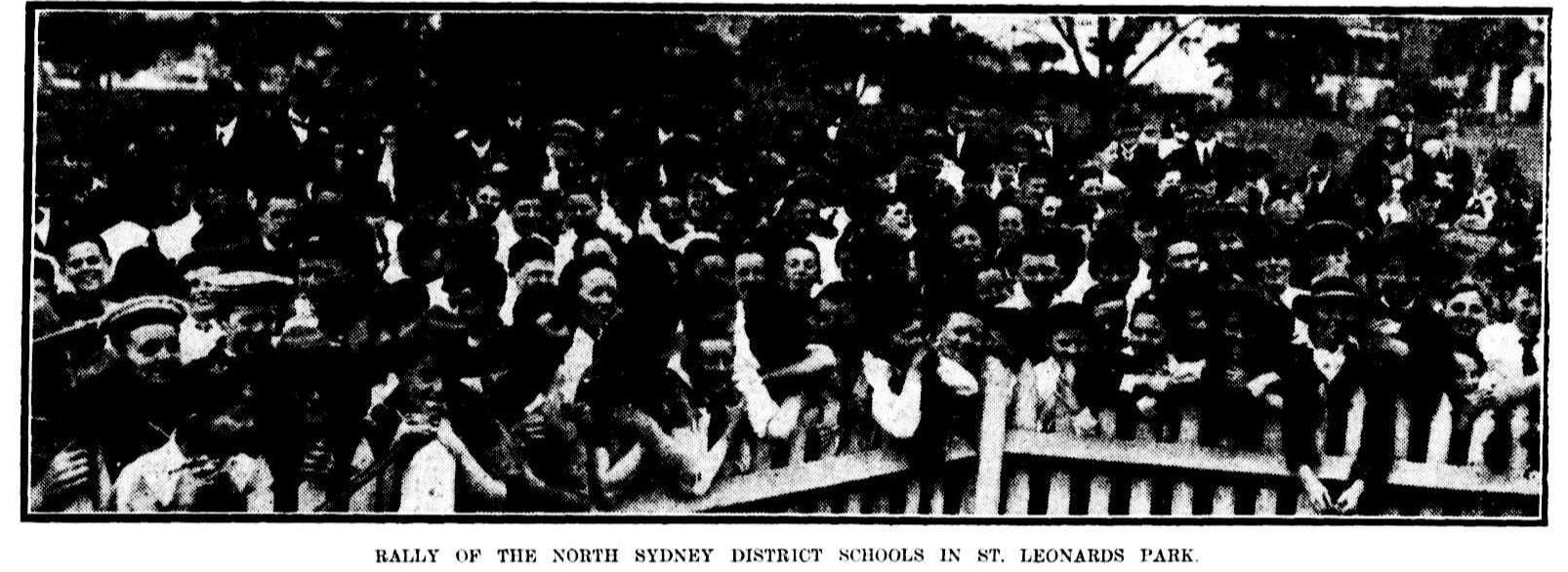
MANLY.
About 1100 boys took part In the Manly district procession, which was marshalled at the local oval. The schools represented were Manly, Manly West, Balgowlah, Harboard, French's Forest, Brookvale, Deo Why, Narrabeen, Mona Vale, and Newport.
The procession was organised by the Manly and Warringah section of the Boys' Week movement, of which Mr. A. S. Gardiner-Gardon is chairman, and Mr. S. Turner hon, secretary. The Manly troop of Boy Scouts and Wolf Cubs, with flags flying, and in charge of Scoutmaster Goetze, headed the procession, and In the centre of the column was the Dee Why (Salvation Army) troop of Scouts. Many of the detachments wore the colours of their respective schools, and large crowds of people witnessed the procession as it passed along the ocean front, and along the Corso. The column then proceeded to the Arcadia Theatre, where a programme of pictures was gone through. During the Interval Mr. C. D. Paterson addressed the gathering on behalf of the Rotary Club.
Mr. Paterson said that the Boys' Brigade at Surry Hills was doing exceedingly good work, and the statistics of the Children's Court reflected that fact. There were fewer cases from the neighbourhood of Surry Hills than from other suburbs. He advised the boys to remain at school as long ns possible, and to retain their schoolboy friendships. It was a fine thing to earn money, but a finer thing to save money. Their surroundings, with glorious beaches and open spaces, were as nearly ideal as possible, and they should remember the boys in densely populated districts, who were not so well situated as they were. IN THE SUBURBS. (1924, September 9). The Sydney Morning Herald (NSW : 1842 - 1954), p. 10. Retrieved from http://nla.gov.au/nla.news-article16177898
By 1925 there was a bigger hut at Manly for their Scouts:
Manly Boy Scouts
The Manly Council has given a block of land to the local troop of Boy Scouts. On the allotment, which is 200ft. by 100ft.: and is situated on the northern side of Ivanhoe Park, a scout clubroom is to be built. Manly Boy Scouts (1924, May 9). The Sun (Sydney, NSW : 1910 - 1954), p. 10 (FINAL EXTRA). Retrieved from http://nla.gov.au/nla.news-article223389876
MANLY BOY SCOUTS
CLUBHOUSE OPENED
THE new clubhouse which the Manly Boy Scouts' Association has erected In the Manly Oval at a cost of £400, was officially opened on Saturday by the Governor. The clubhouse, which is practically free of debt, is in an ideal situation just on the slope of a hill with green woods surrounding It and a flame tree, which spread Its blooms over the heads of the officials who attended at the opening. The Oval seemed full of Boy scouts and Girl Guides. The Manly Municipal Band was In attendance and several thousand people witnessed the opening. Speeches were made by the Mayor of Manly, Ald. Samuels, Mr. Easterbrook, C.B.E., president of the Scouts' Association, Mr. Hope Johnson, Capt. Bennett (State Secretary), and Mrs. Quirk, secretary of the Manly Association. In declaring the clubhouse open, the Governor paid a high tribute to the Initiative of the Manly people and their council and congratulated the scouts on possessing such a fine clubhouse. During the afternoon, Sir Dudley, on behalf of the Boy Scouts, made a presentation to Mrs. Quirk and Mr. Farrington, who have rendered such practical assistance to the association. MANLY BOY SCOUTS (1925, September 21). The Labor Daily (Sydney, NSW : 1924 - 1938), p. 6. Retrieved from http://nla.gov.au/nla.news-article238115581
Narrabeen's first Scoutmaster was John Lewis Chester, who served in WWI, although he enlisted in the Mosman Light Horse Division in 1907 and did military studies at Sydney University. He was a Captain prior to departure for Service in WWI and there are reports he served in the Boer War too, although no official records could be found, although he may, like Charles Foggon, have taken horses to Africa and enlisted while there:
One of Sydney's oldest Scout troops is celebrating its birthday this week. It's the 1st Narrabeen Troop, started in 1909 by a Captain Chester, who'd been with Lord Baden Powell, founder of the Movement, in the Boer War. The troop was carried on by Captain Chester until the First World War broke out and he left for the Near East.
It was reformed in 1920, carried on until 1926, then lapsed for a couple of years to bob up again in 1928. Part of its birthday celebrations will be a hobbies' exhibition and film night at the Collaroy Methodist Church Hall tonight and a final Scouting display on the Collaroy Oval on Saturday afternoon. SYDNEY DIARY (1950, September 21). The Sun (Sydney, NSW : 1910 - 1954), p. 27 (LATE FINAL EXTRA). Retrieved from http://nla.gov.au/nla.news-article230472155
John Lewis Chester was born in Queenslandon the 9th of August 1884 to Emily Eglantine Bernays and Charles Henage Bagot Chester. He enlisted in 1914 – became a Captain in the 3rd Battalion and was in the Landing at Gallipoli as part of offensive on Geba Tepe and offensive (first 4 days).
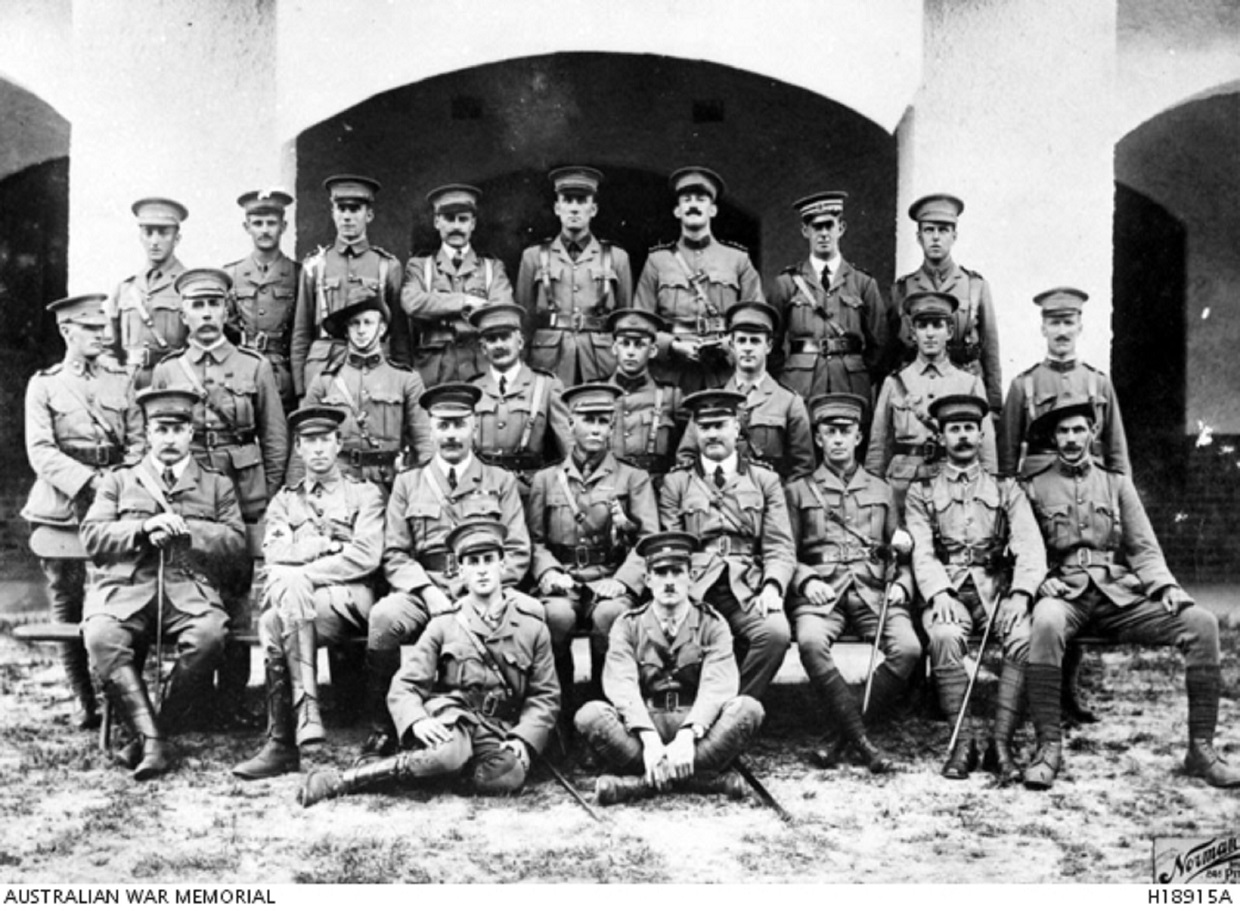
Photo: Group portrait of the Commanding Officer and other officers of the 3rd Battalion, AIF, at Kensington racecourse, September 1914. Identified in the back row, from left to right: Lieutenant (Lt) Cedric Errol Meyer Brodziak (later awarded the DSO and killed in action in France on 31 August 1918); Captain (Capt) Ronald Burns (later killed in action at Gallipoli on 25 April 1915); Lt William Christian Beeken (later killed in action at Gallipoli on 6 August 1915); Capt John Carandini Wilson (later died on 21 May 1915 of wounds received at Gallipoli); Lt Ronald Orlando Cowey (later promoted to Major); Lt David McConaghy (later promoted to Lieutenant Colonel, awarded CMG and DSO and died of wounds in France on 9 April 1918); Capt Leonard Sydney Kent Stevenson, Transport Officer; and Lt Lawrence Whistler Street (later killed in action at Gallipoli on 23 May 1915).
Second row from left to right: Capt John Lewis Chester; Capt Charles Edward Leer (later killed in action at Gallipoli on 25 April 1915); Lt Edward MacFarlane MacFarlane (later promoted to Captain and died on 2 August 1915 from wounds received at Gallipoli); Lt Colin Austin (later Temporary Major and killed in action at Gallipoli on 8 August 1915); Lt Harold Edmund Butler (later Captain);
Lt Eric George Goldring (wounded in action at Gallipoli and returned to Australia in March 1916);
Lt Owen Glendower Howell-Price (later awarded the DSO and MC and died of wounds in France on 4 November 1916); and Lt George Edward McDonald (later Captain).
Third row from left to right: Capt George Wall, Quartermaster (later promoted to Lieutenant Colonel and awarded CMG); Capt John Willoughby Butler Bean, Medical Officer; Major Alfred Joshua Bennett DSO (later Lieutenant Colonel and awarded CMG); Lieutenant Colonel Robert Haylock Owen, Commanding Officer (later awarded CMG); Capt Ernest Samuel Brown, Adjutant (later killed in action at Gallipoli on 8 August 1915); Capt Malcolm St John Lamb (later Lieutenant Colonel); Capt Thomas Oscar Smith (later killed in action at Gallipoli on 7 May 1915) and Capt William Bowman Douglas (later died on 5 May 1915 of wounds received at Gallipoli).
Front row from left to right: Lt Harold William Goldring (later wounded at Gallipoli and returned to Australia in March 1916); and Lt Kenneth John Hinde (later killed in action at Gallipoli on 5 May 1915)
Mr. Chester, an Accountant, was part of the Narrabeen Community and later, after marrying his second wife, Jean Coxon whom he met while serving overseas, lived at Manly. They were also friends with the Rowohl family, who were part of the ‘Girl Aids group of Manly from 1909 and the first Girl Guides Group of Manly:
NARRABEEN PROGRESS ASSOCIATION
At the annual meeting of the Narrabeen Progress Association the report referred to the advance of the district, a fact attributed somewhat to the presence of the association. The balance-sheet showed a credit of £4/12/. The meeting recorded its appreciation of the action of the council in placing lifelines on the beach for the safety of bathers. The following officers were elected for the ensuing term: — President, Ald. H. Gordon, J.P ; vice-presidents, Messrs. R. Marshall, J.P., and D. D. M'Lean; hon, secretary, Mr. G. Powell; hon. treasurer, Mr. F. Loder; executive committee, Messrs. A. O. West, J. S. Russell, M'Intosh, Chester, and Hinchcliffe. NARRABEEN PROGRESS ASSOCIATION (1909, January 15). The Daily Telegraph (Sydney, NSW : 1883 - 1930), p. 11. Retrieved, from http://nla.gov.au/nla.news-article238215179
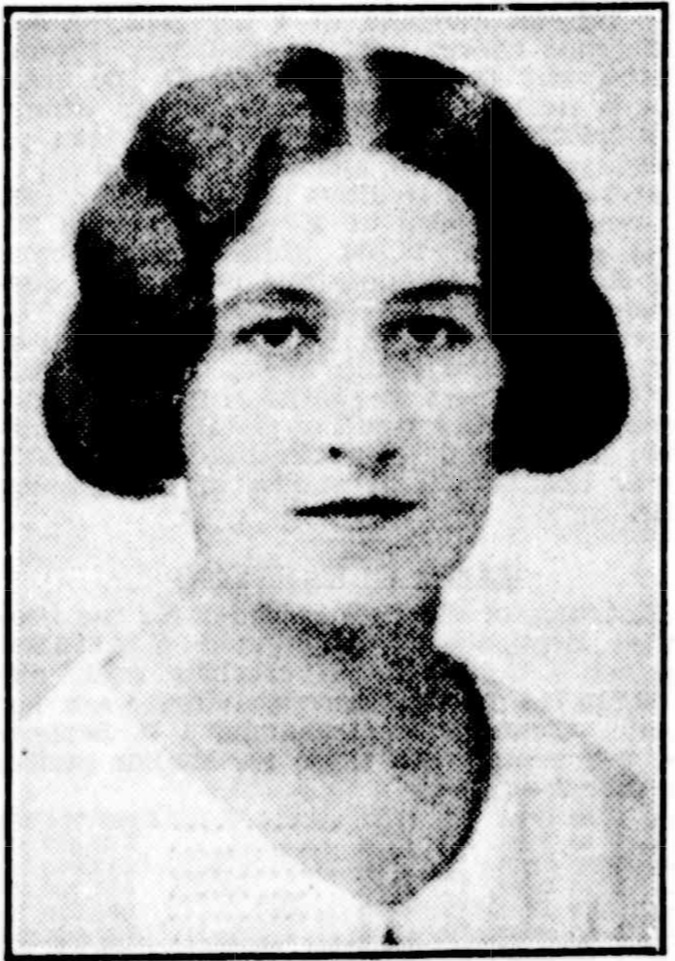
Dr. Willa Rowohl, of Manly, whose marriage with Dr. Selwyn Nelson, of Blayney, will take place on Saturday, was the guest at several functions in her honor during the past week. Mrs. S. Flower and Mrs. J. S. Chester, of Manly, were hostesses at a shower tea at Romano's, at which she was presented with a basket of Radiance roses as well as numerous other gifts.
She was also entertained by fellow ex-students at Sydney High School, where she was presented with a posy of pink carnations and some charming silk and knitted trousseau sets. Other presentations made to the bride-elect were leather travelling-cases from the house staff and X-ray staff at R.P.A. Hospital. Dr. Rowohl has been in charge or the latter department for the past two years; a massive silver entree dish was the gift of fellow graduates at Sydney University. The LIFE OF SYDNEY (1933, May 12). The Daily Telegraph (Sydney, NSW : 1931 - 1954), p. 4. Retrieved from http://nla.gov.au/nla.news-article246241111
Their son, John Bagot Chester who served in WWII as a Gunner, was born December 19, 1920 at Manly to John and Jean Chester – he enlisted May 30th, 1940 at Paddington.
CHESTER JOHN B8819/1920 JOHN L JEAN N MANLY – he died on 27th of June 2011 North Ryde, New South Wales John Bagot Chester.
Parents Marriage: 3170/1917 CHESTER JOHN L COXON JEAN N SYDNEY
MANNSELL—COXON.
A wedding of more than ordinary interest to Lismore people was solemnised at St. Matthew's Church of England, Manly (Sydney), on-July 30th, when Minion, youngest daughter of Mr. and Mrs. E. Coxon, 'Moruga,-' Canaiba, was married to Vero St. John, eldest son of the late Mr. Charles Mannsell, and Mrs. Mannsell, of Brighton, Melbourne ("Vic.). The bride who was escorted to the church and subsequently given away by her brother, Mr. E. Weller Coxon, was attired in her travelling costume, a coat and skirt of nigger brown gabardine, the small droop hat in the same shade was relieved with, touches of royal blue and one of the new long flowing veils to tone. Mrs. J. L. Chester (sister of the bride) was maid of honour, her frock of golden brown Velvet was surmounted by a hat in deeper shade adorned with gold fruit. The bridegroom, was attended by his brother as best man. The bridegrooms gifts were, to the bride a walking cane having a large ajabe knob with solid silver setting, to the maid of honour a signet ring. At the wedding tea, which was held at the Pacific-Hotel, Mrs. Coxon, the. bride's mother, was assisted by her daughter (Mrs. Chester) in receiving and entertaining the guests. Mr. and Mrs. Mannsell will reside at Manly. The gifts received were a very choice lot, and bore testimony to the esteem in which the happy couple are held. Family Notices (1921, September 26). Northern Star (Lismore, NSW : 1876 - 1954), p. 6. Retrieved from http://nla.gov.au/nla.news-article93109133
Lieut. J. L. and Mrs. Chester (nee Sister Jean Coxon), who have both recently returned from the front, are the guests of Mr. and Mrs. E. Coxon, " Moruga," Lismore. Both speak highly of the wonderful work accomplished by the Red Cross Society, without whose assistance life in hospitals would have been very comfortless and sweetless. The sister is the proud possessor of two towels bearing the Booyong-Pearce's Creek branch's stamp, which she received while on the staff of the Harefield Hospital. She also wishes to gratefully acknowledge receipt of a Christmas parcel from the Lismore War Chest, the contents of which were in perfect order. The pipe and tobacco were handed to a sad case of spinal trouble the sister was nursing. PERSONAL. (1919, March 28). Northern Star (Lismore, NSW : 1876 - 1954), p. 2. Retrieved from http://nla.gov.au/nla.news-article92983237
CAPT. AND MRS. J. L. CHESTER HONORED.
On Thursday afternoon last Capt. and Mrs J. L. Chester (nee Coxon), who have been on a visit to Mrs. Chester's sister (Mrs. C. A. Mann), Alstonville, were the guests of the Alstonville Red Cross at afternoon tea. Despite the inclement weather the attendance of patriotic workers, was good, and the function, proved a most delightful one. The welcome took place at Mr. C; Nuttall's refreshment rooms, which were most prettily and tastefully decorated. Mrs. J. A. Daley presided, and amongst the invited guests were the Ven., Archdeacon Lampard, Mrs. F. H. Bartlett (presidents Rous Red Cross), Mr. A. L. Elvery (hon. secretary War Service Committee), Miss Abernethy and Miss E. Cooke (pres. and sec. Girls' Patriotic Club), Mrs. E. Coxon (Lismore), and many others. Apologies for non-attendance were received from Mrs. S. J. Gibson, Miss Edna Smith (president Junior Red Cross), Cr. J. A. Daley, Revs. G. W. McAlpine, Kay Mason, and Mr. C. B. Laidman.
After the National Anthem, Mrs. Daley, in extending a welcome to the guests, mentioned that Capt. Chester left with the famous 3rd Battalion in the first transport that left Australia. He was at the Gallipoli landing, and saw some of the worst fighting there. He was then returned to Australia ill, but he then went back to England, and was in France until September last, when he was returned ill, through a severe attack of pneumonia.
Mrs. Chester for some 18 months did service in Harefield, Southall, and the nurses' hospital at Kensington, where she did splendid work. She was delighted to welcome Mrs. Chester as a Red Cross nurse. The society had done splendid Work, but nothing compared to the work, of the nurses. For this they should get every honor possible. She congratulated them both on their safe return, and, wished them long life and happiness. Mrs. F. H., Bartlett, on behalf of the Rous branch, also welcomed Capt. and Mrs. Chester, and thanked them for what they had done for her by their going across the seas. Archdeacon Lampard, Mr AL Elvery and Miss Abernethy also spoke most appropriate and kindly words of welcome. Mrs. Daley presented Mrs. Chester with a very handsome bouquet, from which hung long streamers, upon which were red crosses. Mrs. Daley also extended a welcome to Mrs. Coxon (who is president of the Caniaba Red Cross Society), and referred to the splendid patriotic work not only of the nurse's mother, but of her sisters Miss Mignon Coxon and Mrs Claude A. Mann.(hon. Secretary of the Alstonville Red Cross. All their work; deeply appreciated. Mrs. Chester, on rising to respond, was loudly applauded. She said she did not deserve half the good things said of her. She could not express to them in words the magnificent work of the Bed Cross Society everywhere. Their work was truly wonderful. The parcels received from the various branches came as rays of sunshine. She valued very much indeed a parcel she received with the name of a branch in this district marked on some of its contents. They could not have managed without the help of the Red Cross Society and other bodies who worked for the soldiers and the nurses, would never be for gotten. She thanked them all for their very kind remarks and delightful-bouquet.
Capt. Chester made a brief response. He too, referred to the work of the Red Cross on the other side. As one who had been seriously ill, he knew what they did, and could assure them it was appreciated by all ranks. He referred to what their grand womenfolk had suffered in silence during the great struggle, waiting for the return of the men. Theirs was a heavy cross, borne with fortitude and in silence. "For, They are Jolly Good Fellows'.' was then sung. Afternoon tea and a pleasant chat was then indulged in, after which the singing of the National Anthem concluded a pleasant afternoon's gathering. CAPT. AND MRS. J. L. CHESTER HONORED. (1919, April 23). Northern Star (Lismore, NSW : 1876 - 1954), p. 6. Retrieved from http://nla.gov.au/nla.news-article92986625
WELCOME HOME
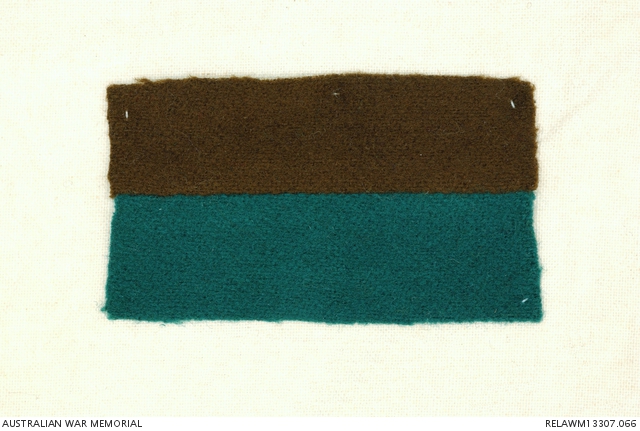 A very pleasant afternoon was spent on Wednesday, ?th inst.', when Mr.-, and Mrs. Coxon, 'Moruga,' Lismore, entertained about -forty guests at afternoon tea at the --'M.G.' Rooms, Lismore. The occasion' was the welcoming home of Captain J. L. and Mrs. Chester (nee Sister Jean Coxon). By a strange coincidence their battalion colors are brown and green, and these colors formed part of the decorative scheme in streamers of bebe ribbon. The table decorations consisted of pink and white roses and ferns, and bowls of the same beautiful blooms, with the Union Jack as a background, completed the pretty effect. The hostess was 'assisted in receiving the guests by Mrs. Claude A.. Munn (Alstonville) and Miss Mignon Coxon. Amongst the guests present were Ald. and Mrs. McKenzie (Mayor and Mayoress of Lismore), Mrs. G. T. Hindmarsh and Mrs. F. N. Harris (president and hon, secretary of Lismore Red Cross Society), Mrs. Clarke -arid Mrs. (Dr.) A. J«\ Parker (president and hon.', secretary Lismore War Chest Society), Mrs. Watson (hon. secretary Soldiers' Aid Society), Miss Butler and Miss A. Parker (president and hon, secretary Lismore Girls' Patriotic Guild), Mrs. .T.- A. Daley- (president Alstonville Red Cross), Airs. Marks (ton. treasurer Cniliaba. Red Cross), Matron Beeby (a returned nurse, now of Lismore District Hospital). A delightful' musical programme, was enjoyed, the singers being 'Misses Hannah Ivann and, Isabel Clarke, M. Coxon, and Major (Dr.) Cahill, Mi-. T. H. Massey 'playing the accompaniments. T
A very pleasant afternoon was spent on Wednesday, ?th inst.', when Mr.-, and Mrs. Coxon, 'Moruga,' Lismore, entertained about -forty guests at afternoon tea at the --'M.G.' Rooms, Lismore. The occasion' was the welcoming home of Captain J. L. and Mrs. Chester (nee Sister Jean Coxon). By a strange coincidence their battalion colors are brown and green, and these colors formed part of the decorative scheme in streamers of bebe ribbon. The table decorations consisted of pink and white roses and ferns, and bowls of the same beautiful blooms, with the Union Jack as a background, completed the pretty effect. The hostess was 'assisted in receiving the guests by Mrs. Claude A.. Munn (Alstonville) and Miss Mignon Coxon. Amongst the guests present were Ald. and Mrs. McKenzie (Mayor and Mayoress of Lismore), Mrs. G. T. Hindmarsh and Mrs. F. N. Harris (president and hon, secretary of Lismore Red Cross Society), Mrs. Clarke -arid Mrs. (Dr.) A. J«\ Parker (president and hon.', secretary Lismore War Chest Society), Mrs. Watson (hon. secretary Soldiers' Aid Society), Miss Butler and Miss A. Parker (president and hon, secretary Lismore Girls' Patriotic Guild), Mrs. .T.- A. Daley- (president Alstonville Red Cross), Airs. Marks (ton. treasurer Cniliaba. Red Cross), Matron Beeby (a returned nurse, now of Lismore District Hospital). A delightful' musical programme, was enjoyed, the singers being 'Misses Hannah Ivann and, Isabel Clarke, M. Coxon, and Major (Dr.) Cahill, Mi-. T. H. Massey 'playing the accompaniments. T
he singing of the National Anthem and 'For They are Jolly Good' Fellows' concluded the programme. Dainty souvenir programmes, with bows of the colors of Capt. and Mrs. Chester, were presented to all present. Mrs. Chester is well known in Lismore, having lived there for some years prior to taking up the nursing profession at Casino District Hospital, where she received all her training.
Captain Chester, an original Anzac, left Sydney in the first transport and participated in the famous Gallipoli landing us a member of the 3rd Battalion. he was returned home ill, but re-enlisted and went to France, from where he was again returned ill, suffering from a severe attack, of pneumonia. Capt. and Mrs. Chester received the hearty, congratulations and good wishes of their, many friends. WELCOME HOME. (1919, April 25). The Richmond River Express and Casino Kyogle Advertiser (NSW : 1904 - 1929), p. 8. Retrieved from http://nla.gov.au/nla.news-article120240460
In fact he was suffering from severe what is termed today Traumatic stress syndrome, the records in his file of War papers note this and that also, then he managed to re-enlist and get sent into France that the same thing occurred there, although he had pnuemonia at the time he was sent to England.
At Narrabeen WWI Veteran Gilbert Filshie took up the work of being Scoutmaster for the 1st Narrabeen Scout Troop on moving there in 1928. In 1931 when the Manly-Warringah Scouts seceded the Mosman Branch, Mr. Filshie was appointed District Scoutmaster. Later in the same year he was appointed as the first District Assistant Commissioner of the Manly-Warringah District. A position he held until 1936 when ill-health compelled him to resign from the Movement.
Mr. Filshie had had a long association with our area - some insights from the pages of the past:
FILSHIE— MILLAR
The wedding of Miss Isabella R. Millar with Lieutenant Harold J. Filshie, M.C., 5th Div. Trench Mortars, was solemnised at the Manly Presbyterian Church, on May 14, the Rev. A. Simms officiating. The bride wore a cream frock, with hat and veil, and carried a posy of white flowers, tied off with the bridegroom's colors. She was attended by her two sisters, Miss Margaret Millar, who wore mastic crepe-de-chine, with hat to match, and Miss Netta Millar, who was in mauve crepe-de-chine and a white hat. The bride's mother wore grey silk, with black panne hat, her bouquet and that of the bridesmaids' being of pale pink carnations. Driver G. Millar was best man, and Sapper G. Matheson grooms-man, both of whom were in uniform. A number of relatives and friends assembled at the church, which had been decorated with flags, flowers, and greenery by the bride's girl friends, a floral horseshoe being suspended above the pulpit. The reception was held at "Calhkin Braes," where guests to the number of about 50 assembled after the ceremony, after which Lieut. and Mrs. Filshie left for Narrabeen, where part of the honeymoon is being spent. Later they will leave on a visit to Lieutenant Filshie's parents in Melbourne. The soldier bridegroom is at present on furlough, following his return from France. FILSHIE--MILLAR (1919, June 8). The Sun (Sydney, NSW : 1910 - 1954), p. 16. Retrieved from http://nla.gov.au/nla.news-article221458499
THE HOME MISSION SOCIETY - TRINITY SUNDAY
THE Offertories on behalf of the above Society will be taken up In the following Churches; …
Narrabeen St- Faith’s, Narrabeen 8 a.m. and 9.15 am., the Rector, 7 30 pm Mr Filshie Newport, 11 a m Mona Vale 7 15 p m the Rector … Advertising (1931, May 30). The Sydney Morning Herald (NSW : 1842 - 1954), p. 6. Retrieved from http://nla.gov.au/nla.news-article16781734
An Exchange of Flags
PRIOR to the departure of the Changte for Chinese ports a happy little function was held on the wharf, when Miss Muriel Swain, a delegate to the Institute of Pacific Relations, was presented with a flag from the 1st Narrabeen Troop by Commissioner Filshie, of the Manly-Warringah District. Miss Swain will exchange the flag for one of a Scout Troop in China.
Eighteen Scouts from Narrabeen, in charge of A.S.M. Ron Cooper, and ten Cubs from 1st Harbord, in charge of G.S.M. A. W. Newman, attended. Scout George Morrison presented Miss Swain with a bouquet in green and gold.
Awards Presented
the annual meeting of the Assn., further particulars of which will be given next week, H.E. the Chief Scout presented various awards for gallantry and for good services and also warrants to some newly-appointed commissioners.
(1) Posthumous Silver Class to the next-of-kin of the late Cub, Lance Coyle, of 4th Glebe (Toxteth) Troop.
(2) Gilt Cross to Patrol Leader John Bertram, of 1st Campale Troop.
(3) Medal of Merit to District Scoutmaster Frank Heron, Blue Mountains District.
(4) Certificates of Gallantry to Scout John Watson and Patrol Leader Noel Morse (1st Mosman Troop), Scouts William Baker, Hector Wood, and Ronald Minister (1st Campsie Troop).
Warrants of appointment were handed to:—
(1) Mr. Phillip Shipway, as Headquarters Commissioner for Sea Scouts and Deep Sea- Scouts.
(2) Mrs. Georgina Farquharson, as Assistant Headquarters Commissioner for Wolf Cubs.
(3) Mr. Frederick R. King, a§ District Commissioner, Murumbidgee District.
(4) Mr. Hedley Z. Palmer, as Assistant District Commissioner for Cubs, South Sydney District.
(5) Mr. Gilbert Filshie, as Assistant District Commissioner, Manly-Warringah District.
The District Cubmaster of South Coast was to have received his Certificate of Merit for Good Services, and also Mr. H. Bowden-Fletcher • his warrant as District Commissioner for the Western District, and Dr. R. C. Geeves, the hon. medical officer of the Baden-Powell camp, a thanks badge, but unfortunately these gentlemen were unable to attend. Scouts & Scouting (1931, October 14). The World's News (Sydney, NSW : 1901 - 1955), p. 19. Retrieved from http://nla.gov.au/nla.news-article136313488
Australian Flag for Chinese Troop
PRIOR to her departure on a trip to the East Miss Muriel Swain was requested by the Scouter and Scouts of the Narrabeen Group to present, on their behalf, a flag to the Hangchow Scouts. This ceremony took place on the wharf prior to Miss Swann's embarkation, when the flag was handed over. Advice is now to hand, so the District Commissioner of the Manly-Warringah District, Mr G. Filshie, reports, that the presentation of the flag was made to representatives of the Hangchow Scouts on the occasion of a wonderful Chinese dinner given by the Governor of the Province and the Mayor of the Municipality. On the following day a powwow was held with the Scouts at their encampment, when many photos were taken. The China Council and the Hangchow Scouts are very pleased at the idea of the gift, and delighted to receive it, and were loud in their expressions of regret that their gift in return had not been ready to be handed over at the dinner. Perhaps some of the photographs will find their way to us in due course, when, if suitable, they will be reproduced. Scouts and Scouting (1932, February 3). The World's News (Sydney, NSW : 1901 - 1955), p. 23. Retrieved from http://nla.gov.au/nla.news-article131477177
The whole Filshie family were great workers for community - this is his sister:
VICTORIAN WOMAN M.P.
MELBOURNE, Thursday.
MRS. CLARENCE WEBER, Victoria's only woman member of Parliament, who was elected member for Nunnawadding last year, will come to Sydney for the 150th Anniversary Celebrations. She will leave next Monday night in the express, and many other members of Parliament will travel on the same train, bound for Sydney. Mrs. Weber has been spending some weeks holidaying with her children at Ferny Creek, Victoria, and will return to the city this week. In Sydney she will stay most of the time with her brother, Mr. G. Filshie, at Narrabeen.
She is particularly interested in the Australian Council of Youth Conference, and will go into camp at Thornleigh on January 28. Her talk at the Women's International Conference, which will begin on February 4, is to be on "Women in Politics.". After the celebrations, Mrs. Weber hopes to stay on and take part in the Parliamentary sports from February 14 to 21. If so, she will take part in most of the matches,' for she is a good tennis player and an experienced Mrs. Weber's eldest brother, Mr. H. J. Filshie, has just left Canberra, where he has been headmaster since the public school opened, to take up an appointment at the Woollahra school.
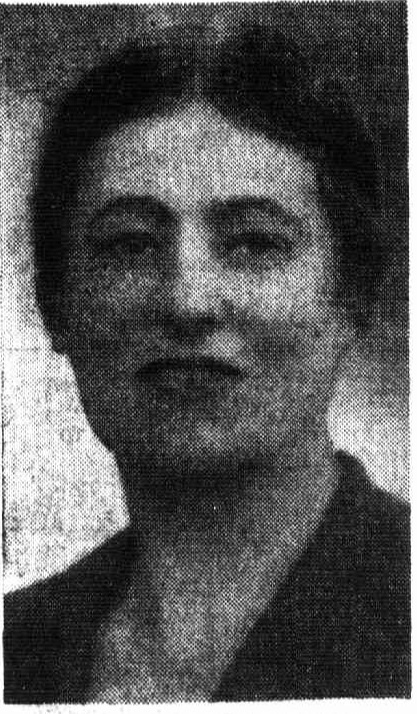
MRS. CLARENCE WEBER. — Brootnorn. VICTORIAN WOMAN M. P. (1938, January 21). The Daily Telegraph (Sydney, NSW : 1931 - 1954), p. 9. Retrieved from http://nla.gov.au/nla.news-article247399836
Woman M.L.A. to Take Part in Celebrations
AMONG the many Interesting visitors to Sydney for the celebrations ls Mrs. Clarence Weber, Victoria's first member of Parliament, who was elected last year for Nunnawadding. She will stay most of the time with her brother, Mr. G. Filshie, at Narrabeen Lakes, but, as she is tremendously interested in all youth movements, arranged to go Into camp at Thornleigh on January 28 to attend the Australian Council of Youth Conference.
At the International Conference of Women she will talk on women in politics, and hopes to remain to take part in the parliamentary sports from February 14 to 21. A keen tennis player, she also played cricket for many years, but at the sports doesn't Intend to re-strict her activities to these two, and will try her hand at everything. What Women Are Doing (1938, January 29). The Australian Women's Weekly (1933 - 1982), p. 35. Retrieved from http://nla.gov.au/nla.news-article45657401
Beach Girl Weds - Flying Officer
Miss Hilda de Berri Wachsmann, one of the Sunday Telegraph-Red Cross Beach-Girls-of-the-Week for 1942, was married on Saturday night to Flying-Officer Mervyn Willman, R.AA.F, at Scots Church, Margaret Street. She is known at Collaroy for her capable handling of the surf-ski in heavy seas, and, as well, is an expert marks-woman, a show-ring horse rider, an ice skater, and holds the L.A.B. degree from the Sydney Conservatorium of Music. Plans for the wedding were all made after 12.30 pm. on Friday, when Miss Wachsmann received a telegram from the bridegroom, telling that he had leave. In the course of Friday afternoon and Saturday morning her oyster satin bridal gown and Brussels net veil were made, and friends were invited to the reception at the Australia Hotel. Miss Ukie McGillicuddy, who was bridesmaid, wore a gown or pale /blue and white lace, and a white toque. Sergeant John Willman attended the bridegroom, who Is the youngest son of Mr. and Mrs. W. Willman, of Hurlstone Park. The bride Is the only daughter of a former Deputy-Registrar-General of New South Wales (the late Mr. A. A. de Berri Wachsmann) and of Mrs. Wachsmann, of Beecroft. She was given away by Mr. Gilbert Filshie, of Narrabeen, whose marriage with her mother will take place on March 21 at St. Faith's Church, Narrabeen, will be the first wedding to be celebrated in this church, which was only completed two weeks ago. Beach Girl Weds Flying Officer (1942, March 2). The Daily Telegraph (Sydney, NSW : 1931 - 1954), p. 7. Retrieved from http://nla.gov.au/nla.news-article247917793
St. Faith's Church of England Narrabeen was opened on the 9th of October 1897 – this must be a second St Faiths at Narrabeen:
FILSHIE—WACHSMAN.—March 21, 1942, at St. Faith's Church of England, Narrabeen, by the Rev. F. G. Standen, Ethel May Wachsman, of Beecroft, to Gilbert Filshie, of Narrabeen. Advertising (1942, April 11). The Sydney Morning Herald (NSW : 1842 - 1954), p. 21. Retrieved from http://nla.gov.au/nla.news-article17809808
Back to school celebrations at Dungog:
EX-STUDENTS' 'EXCUSES.'
The following interesting 'excuses for non-attendance at the 'Back to 'School' festivities were read at the celebrations: —
Bert. Filshie, Narrabeen, wrote:—' Dear Teacher,— Kindly excuse me for being absent from- school on Monday. Having joined the Boy Scouts, as a spare time activity, I must 'do my good turn' in the Manly-Warringah district. P.S. — I sent my school fees to the Parents and Citizens' Association.
Gilbert Filshie, Narrabeen, wrote:— Gentlemen, — -Your circular in reference to the above-mentioned matter reached me to-day. I greatly regret that I am unable to avail myself of your invitation, but would very much appreciate a further invitation on some future occasion. The Boy Scouts Association, of which I am the representative in this District, is taking an active part in the matter of Jubilee celebrations, and it Is imperative for me to attend the functions to be held in this district on Monday next. I enclose herewith an ''excuse for my absence,' together with arrears of 'school fees.' . I should be glad to have an account of the function, if such will be available. I should also be happy if you would tender my kind regards to all my old schoolmates. EX-STUDENTS "EXCUSES." (1935, May 14). Dungog Chronicle : Durham and Gloucester Advertiser (NSW : 1894 - 1954), p. 5. Retrieved from http://nla.gov.au/nla.news-article141477179
MARRIAGE AT REGISTRY 'LAST RESORT'
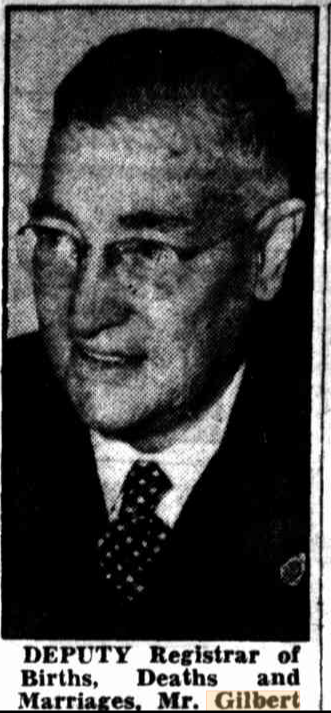
DEPUTY Registrar of Births, Deaths and Marriages, Mr. Gilbert Filshie, who retires today (see story be-low).
Deputy-Registrar of Births, Deaths and Marriages, 63-year-old Gilbert Filshie, who has married 3000 couples in the past two years to day advised people to marry in a registry office only as a last resort. Mr. Filshie retired to day after 48 years in the Public Service, which he entered as a pupil country teacher on a salary of 10/8 a week. He became a junior clerk in the Registrar-General's Department in 1910, Deputy Registrar-General in the Lands Titles Branch in 1945 and Deputy Registrar of Births, Deaths and Marriages in 1950. "I love romance and lovers," Mr. Filshie said today, "And it makes me sad to leave the job of uniting people in wed-lock." Mr. Filshie, who has been marrying couples at the rate of 30 a week, gave these views:
"I'm not in favor of hurried marriages.
"The ideal marrying age is from 21 to 25, with the husband a little older than the wife."
"Get married in a church — if you possibly can. Use the registry office only as a last resort." MARRIAGE AT REGISTRY 'LAST RESORT' (1952, May 23). The Sun (Sydney, NSW : 1910 - 1954), p. 7 (LATE FINAL EXTRA). Retrieved from http://nla.gov.au/nla.news-article230214727
The commencement of 'Bob-A-Job' Week after World War Two was similarly based on giving options other than delinquency to the next generation of youngsters to be affected by menfolk and this time, womenfolk too, who came home from horrific experiences and were expected to just go about their lives ever after. Obviously they all wanted to, but doing so when physically or emotionally and mentally maimed made this difficult for some and impossible for others. The statistics for those who took their own lives past both these World Wars has never been calculated in Australia, but many a newspaper report post WWI in Australia refers to a person who has taken their own life, some of them horrifically, as someone who 'served in WWI and was never the same after coming home' - the recurrence of these words hintys at what they could not fully report.
Bob-A-Job week was a reaction to the youth reaction in being 'unruly, deviant, delinquents' - think of every place heading into those smooth polished photographs of the perfect housewife in the perfect kitchen of the 1950's, which were about to become the pot-smoking 1960's hippies with long hair and rock and roll, but all still needing a few guidelines as a backbone once the tangerine dreams evaporated and the mouldy lentils left over in the pot weren't enough to feed them.
The Bob-a-Job Week was one week in April, initially, all Scout groups 'hired out' their Scouts, issuing them with job cards and instructions to go round to local homes and ask for any jobs the householder needed doing in exchange for a 'bob' -the colloquial term for a shilling, or ten cents - but still a fair amount of money for odd jobs in post WWII times.
The concept was made larger when the idea of 'Work Experience' became what was made available for older Scouts and Rangers and even led to some landing a job. The concept now available in High Schools throughout the state, and Australia, began in Scouts and Girl Guides and the idea of testing out what you are interested in and experiencing what it feels like to get paid for working.
KING'S SCOUT
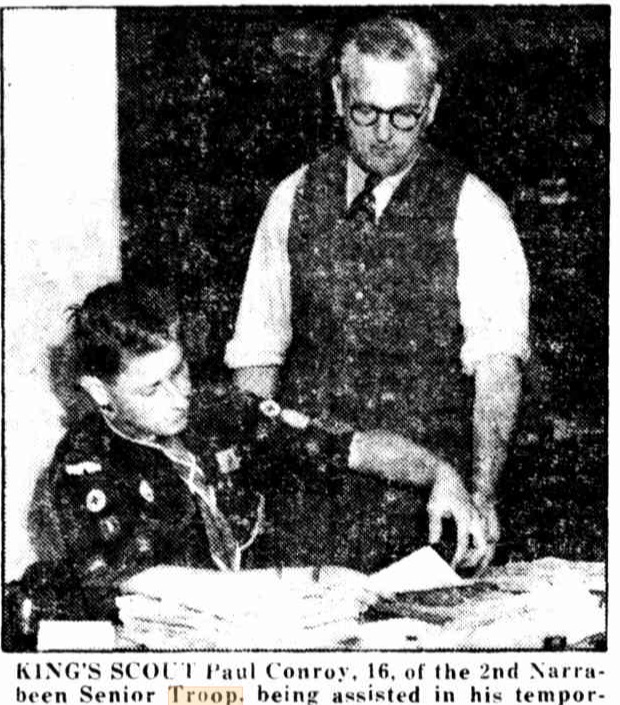
Paul Conroy, 16, of the 2nd Narrabeen Senior Troop, being assisted in his temporary job by accountant Mr. R. White, at the Australian Consolidated Industries works. Waterloo. Paul was given the job to help the Boy Scouts'Association's "bob-a-job" week, Paul, who gave up his sports day at Manly High School, was given £2/2/- for his work. Scout works at factory (1951, October 25). The Sun (Sydney, NSW : 1910 - 1954), p. 2 (LATE FINAL EXTRA). Retrieved from http://nla.gov.au/nla.news-article229730655
Boy Scouts were Great Help during local Fires
The Long Reef, Narrabeen, Ingleside & Newport Camps
The September 11, 1909 exercise of the Manly and Narrabeen Boy Scouts to Newport is just one of many reports of Scouts coming to these places to do their 'scoutcraft'. Although Sydney then was still a place of many trees with lots of bush to practise 'scoutcraft' in, the added attraction of water was a real boon for boys brought east to the lagoon. Coming to Narrabeen to camp, with Deep Creek being a favourite place for scout troops from all over the metropolis, would continue for decades.
At Long Reef after the then state Government announced in 1912 it would resume, for public recreation, 175 acres and all that land that encompasses the open green space many are familiar with this became a popular camping spot for both Boy Scouts and Girl Guides, with some troops formed through the Salvation Army, from who the land had been resumed, also camping there.
What would later become 'Griffith Park' was also where the 1st Narrabeen Boy Scouts Troop requested, in 1934, of the then Warringah Shire Council a space to build their own scout hut. They were in Goodwin Street by the late 1940's, where a hall still stands. The first version was a thin walled fibro construction and subject to a good flood every time the lagoon filled. Even into the 1950's they were requesting more 'fill' to be sent in by Council to counter the problem.
By far the biggest boon for Scouts and Guides in the Pittwater area was the land given to the organisation by Frederick Danvers Powers at Ingleside, a place that still is being used by the movement:
BOY SCOUTS' CAMP.
A patrol from the Tamworth Boy Scout troop will spend a week of the vacation in camp at Mona Vale, near Narrabeen. A large estate has been placed-at the disposal of the Scouts Association; and a number of troops from the city and country will go into camp there during the holidays. The grounds are admirably adapted for scout training, and the boys are highly delighted with the idea of their; trip. . With the assistance of the leaders of the Scout' committee;- Mrs, Lambert, Mrs. Nankervis, Mrs. Teakle, and Mrs.' Vidler, the boys have raised sufficient money to purchase two bell tents. Mr. Lambert-(who is the badge examiner for swimming and life saving), donated a guinea towards the purchase of tents, and several others have also promised donations. During the coming year, when they have sufficient -tents,- the whole troop intend to 'go into camp near Tamworth, to give the parents an opportunity of seeing the boys under camping conditions. The: boys will leave Tamworth on Monday night, in charge of Mr. Holden, and will be met on arrival in Sydney, by their Scoutmaster, Mr. A. Glynn, who will take charge of them while they are in Sydney. BOY SCOUTS' CAMP. (1918, December 12). Daily Observer (Tamworth, NSW : 1917 - 1920), p. 3. Retrieved from http://nla.gov.au/nla.news-article105063188
A Cycling Expedition
[As carried out by the Rover Patrol, affiliated with the First Burwood Troop of Boy Scouts]
At 2 pm on, Saturday, Rover Mate T. Hovenden, Second T. Vote, and Rovers N. Hopton and H. Magill left Burwood with the intention of completing the excursion to Tumbledown Dick by the medium of push bicycles. It was a scorching hot day, with just a fleeting overcast of high white clouds and refreshing cool breeze. Passing through Five Dock and Abbotsford, we eventually arrived at Drummoyne Bridge. Thereafter a good downhill grade of about 1 in 5 was traversed, on which we forgot there was a speed limit, as well, as a board with a large 15 displayed on it at the bottom of the hill, and trusted to good luck that there vital no carts or motors waiting to embrace us at the bottom. Still, as there are two sides to a hill, as well as an argument, we had to dig at the pedals rather strongly to carry us into Figtree, and incidentally to soda-fountains.
After what seemed an age, but was in reality about an hour and a quarter, we arrived at Pymble. At this juncture the good scenery and hard luck commenced, for before we had, been on the Stony- Creek-road 15 minutes, which was now our route straight through to our destination, three punctures had to be mended — two on Second Rover Mate Vote's bicycle, and one on Rover Mate Hovenden's. We were now traversing the ridge of the hills, and oncittel side on occasions the sides of the road dropped down to give-views of the gullies of the truest Australian character. The road from Pymble had, for the most part, been of that red gravel which cyclists admire so well, but from the little township of St. Ives it assumed the more grim aspect of small pot-holes filled with dust, while on the last three miles to the camping spot it became a road of treacherous bend's and deep, heavy, red dust, where we proved ourselves worthy of being called cyclists.
The famed Tumbledown Dick Hill was eventually encountered, with a grade of about 1 in 3, or even less. A sudden stop at the bottom of the hill and we were at our turning-off point. An unsurpassed view of the surroundings gully-serrated country, for about eight miles was obtained here.
Scoutmaster Power, his sons, and friends must have had hard work to build the track which now led to the bed of the gully. After a bath in the rock basin we enjoyed the hospitality of our S.M. by his turning over to us the use of his guest house, complete with all the cooking utensils and beds.
Sunday morning was spent in mending another four patches which had lifted on Rover Hovenden's cycle, sitting in a waterfall wearing out any stiffness of the limbs which may have accumulated, and gathering bunches from a profusion of flannel flowers, Christmas bells, Christmas bush, and other wild bush flowers.
At 4.30 p.m. on Sunday, the 20th, we started for Burwood, via Mona Vale, Rocklily, Brookvale, Dee Why, Collaroy, Narrabeen, Manly, and Sydney. The road was now mostly down-hill. At Mona Vale the rain started to come down in solid sheets, so we promptly took refuge under a fallen log until it cleared off a little, when we-started off again.
Afternoon tea at Narrabeen Lake proved to be very acceptable. Mate Rover Magill mended two punctures and a blow-out. Three miles out of Narrabeen the punctures we had mended lost their punch, so Rover Magill decided to finish the trip per tram, ferry, and train. Darkness overtook us before we reached Manly.-For the last hour and a half we had been battling against heavy headwinds and rain, and riding through water 3in deep in some parts. On arrival at Manly we discovered that, though the rain had effectually dampened our clothes and boots through to the skin, our spirits were still perfectly dry and cheerful. At Manly Wharf we were left in doubt whether it was our wet and muddy clothes or our flowers the people envied most. In the final ride home from the city R.M. Hovenden and Second T. Vote finished at Burwood at 10.5 p.m. A Cycling Expedition (1921, December 4). Sunday Times (Sydney, NSW : 1895 - 1930), p. 3 (SUPPLEMENT TO THE SUNDAY TIMES). Retrieved from http://nla.gov.au/nla.news-article123241387

Frederick Danvers Power (1861–1955) was an Australian academic, a lecturer in geology and metallurgy. Born in England, a son of Samuel Browning Power (1824–1892), a shipowner of London, and his wife Rebecca Danvers (1835–1902), he was educated at Malvern College, the Royal School of Mines, London, and the Mining Academy, Clausthal, Germany.
In 1884 he migrated to Australia, settling in Melbourne. He worked in an assay laboratory in Bethanga until 1887. While assayer for the Union Bank, he was in 1890 a key witness in the trial of Robert J. W. Pound, accused of the theft of some £5,000 worth of platinum from the Otway Ranges Company. He was appointed consulting engineer to the Overflow Company in 1897.
In 1902 he was appointed lecturer in mining at Sydney University, which he held until 1935. Power acted as manager of the Great Cobar mine in 1913 during the four months Bellinger was away on leave. Interested in the propagation of technical knowledge, he was for many years associated with the Australasian Institute of Mining Engineers that later became the Australasian Institute of Mining and Metallurgy, including his role as a President of the Institute. Power was a Fellow of the Geological Society, and a member of the American Institute of Mining Engineers, of the Institute of Mining and Metallurgy in London, and a member of the Mine Managers examination panel.
He travelled extensively to North and South America, North and South Africa, Java, China, Japan, New Caledonia, New Zealand and various islands in the Pacific and Indian oceans where, among perusing other interests, he collected native artefacts. He donated many artefacts directly to the Australian Museum.
Mr. Power was a prolific writer of technical books and journal articles. His book Coalfields and Collieries of Australia, written in 1912, became a standard reference text. He formed his own publishing company Rhincru Press and in retirement published a number of works on technical and social issues. Apart from his lifelong interest in mining, Power was an assistant Commissioner in the Boy Scouts Association, wrote many articles for the Scouters Gazette and was author of the Australian Boy Scouts Handbook.
A little more about him and his connections to scouting is told in this item:
BOY' SCOUTS. .
New Officials.
Mr. Hartley MacAllister has been appointed deputy camp chief commissioner for training of the Boy Scouts' Association of New South Wales, in consequence of which appointment he has resigned his position of deputy chief commissioner. His new duties will include the organisation and supervision of the training of the 8000 scouts in this State.
.png?timestamp=1607194252915)
MR. HARTLEY MACALLISTER.
Mr. MacAllister has been associated with the Boy Scout movement for the past 16 years. On their return voyage to Australia he was in charge of the contingent which attended the Jamboree in England. He saw four years' service during the Great War, but while he was so engaged oversea he always associated himself when opportunity offered with the scout movement In England and other lands. He was appointed district scoutmaster of the Western Suburbs in 1919, and only resigned to take up the honorary position of deputy chief commissioner.
Mr. F. Danvers-Power has been selected to replace Mr. Hartley MacAllister as deputy chief commissioner of the Boy Scouts through-out New South Wales.
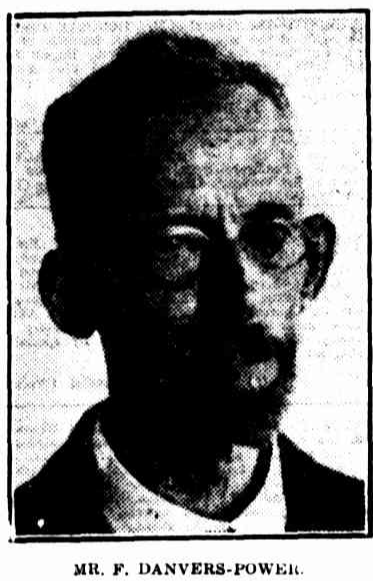
MR. F. DANVERS-POWER.
Mr. Danvers-Power, who is lecturer in mining at the Sydney University, was first actively associated with the Boy Scouts during the war, when he filled the position vacated by scoutmasters on active service. Prior to his last appointment he was acting scoutmaster In the Burwood district, and, then district scoutmaster for the Western Suburbs. His brother Is the chief wolf commissioner of the world, while his nephew is a scout instructor at Gillwell Park, England.
Mr. Power is a cousin of Lord Harrowby, who recently visited Australia. He Is the author of a work entitled "The Australian Boy Scout Handbook." BOY SCOUTS. (1925, January 22). The Sydney Morning Herald (NSW : 1842 - 1954), p. 8. Retrieved from http://nla.gov.au/nla.news-article16207921
THREE CHEERS FOR MR. AND MRS. DANVERS POWER.
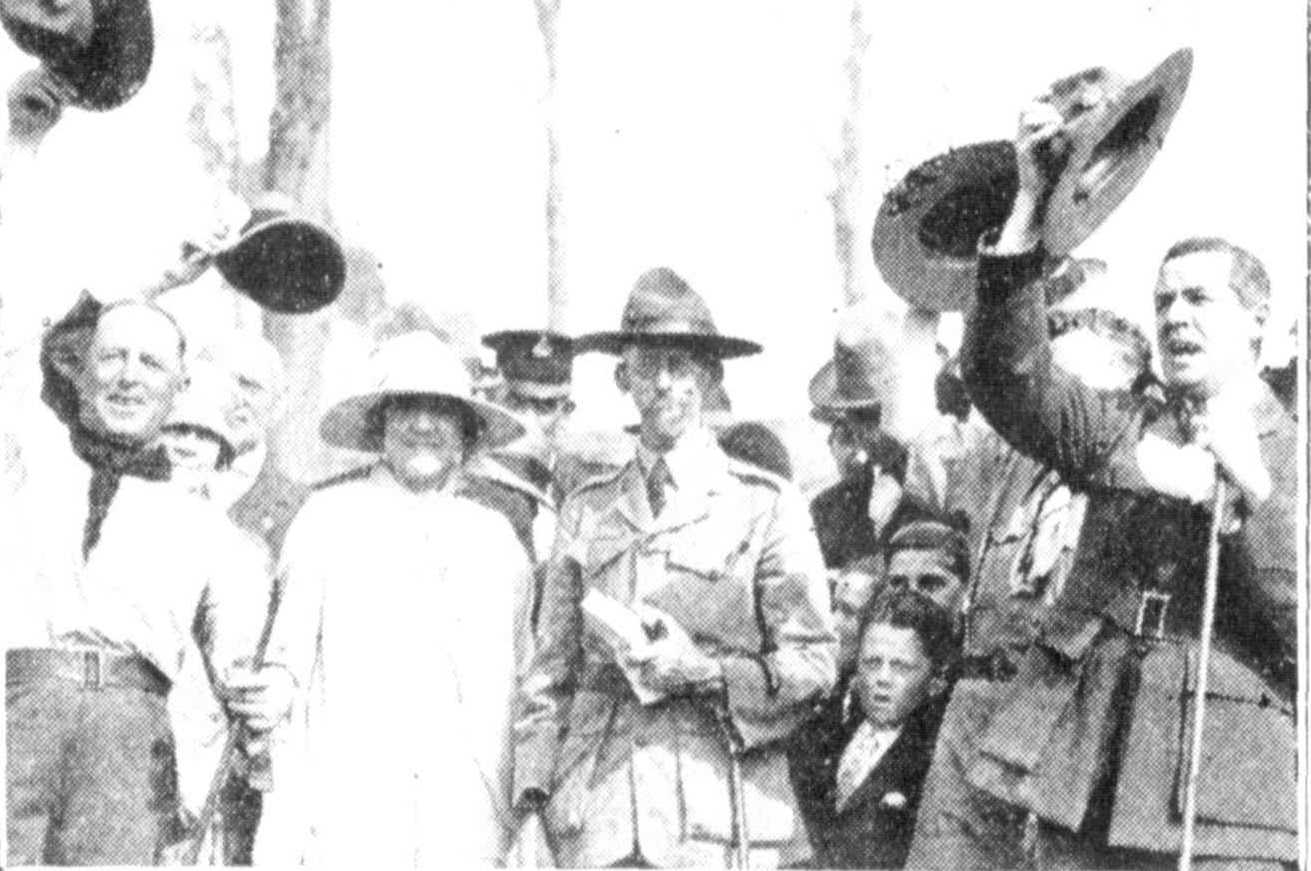
All incident at the boy scouts rally at Riverside Park, Marrickville, on Saturday. Mr. F. Danvers Power, the Deputy Commissioner, and his wife were cheered by the Scoutmasters.
.jpg?timestamp=1607200685400)
SCHOOL ADDITIONS AT WEST MANLY. Officially opened by Mr. Mutch, Minister for Education on Saturday. Half of the building in the picture (on the left) represents the additions.
.jpg?timestamp=1607200749854)
HOSPITAL FETE AT ST. LEONARDS. Mr. W. M. Hughes, M.P., is seen addressing the gathering. The fete was held in aid of the Royal North Shorn Hospital and the Orphans' Home.
.jpg?timestamp=1607200824579)
Rally of Boy Scouts at Riverside Park, Marrickville. Although mainly composed of lads front the Dulwich Hill and Burwood districts, several other troops are represented. A representation of a model camp was given by the First Mosman Troop under Mr. Howard Pilcher. This troop, having won the Fairfax flag, is the lending Scout troop in the State. The First Ashfield Troop led By E.E. Ross. was successful in the marching competition. An interesting hobby and Scoutcraft display was given by the Dulwich Hill Scouts. Boy Scouts—A Variety of Current Events (1926, November 17). Sydney Mail (NSW : 1912 - 1938), p. 13. Retrieved from http://nla.gov.au/nla.news-article166522921
The enthusiasm which has been such a marked feature in connection with the Easter Ball, which will be held in the Town Hall on the Tuesday evening Of Easter week. April 14, is in no way abating. Mrs. Geoffrey Fairfax presided over a large meeting In the ball-room of the Hotel Australia yesterday morning. The various sub-committees made satisfactory reports, and there seems little doubt that the ball will be one of the finest ever held at the Town Hall. Mrs. Bolton offered a prize of one guinea to whoever sold the most ball tickets. General A. Jobson and Mr. F. W. Hughes each donated £10/10/ towards the expenses. An attractive souvenir programme is being prepared and will be sold at a small charge. A practice parade of the fancy sets is to take place at the Town Hall at midday on April 14. Among those present yesterday were Mr. and Mrs. Kelso King, Miss Kelso King, Mrs. V. Bennett. Commander and Mrs. Quick, Mr. Danvers Power, Mrs. Hamilton Marshall, Lady Denison, Mrs. Howard Vernon, Mrs. Wilshire, Mrs. Mayne, Mrs. Mather Mr. G. Merivale, Mr. Russell Crane, Mrs. Reece, Mrs. Hoskins, Mrs. Jacobs, Miss Shanks, Miss Stella Fawcett, Miss Josephine Marks, Mr. Roy Bennett. WOMAN'S WORLD (1925, April 3). The Daily Telegraph (Sydney, NSW : 1883 - 1930), p. 5. Retrieved from http://nla.gov.au/nla.news-article245228689
In this item he mentions 'photography' and 'naturalist' badges that may be earned by Scouts under the 'Hobbies' heading - he was both:
BEGINNINGS OF SCOUT MOVEMENT
Uniform and Badges
(By COMMISSIONER F. DANVERS POWER.)
This is the third of a series of special articles which will be published in this column each week. The uniform has been designed so as to put -the boy's parents to as little expense as possible. Most young boys wear dark-coloured shorts, dark stockings and black boots, so that all they have to buy to complete their uniform is the coloured shirt, Scouts' hat, belt, neckerchief and lanyard. There are one or two extras which all boys are to possess, e.g., a clasp knife, a whistle, and if he goes out in the bush certain camping equipment. When a boy first joins a troop he is called a recruit, and has no right to wear the Scout uniform until he is a Scout. To become a Scout he must have been trained for at least a month to see if he is fit to become a Scout and really endeavours to keep the Scout Law, and has to pass a few simple tests. This being done satisfactorily ha takes the Scout promise, and is then allowed to wear the Scout uniform, the Scout emblem — the fleur' de-lis — and his Patrol colours, which consist of certain coloured braid worn on the left shoulder. The next stage in his advancement is to become a second-class Scout, and to do this he has to pass more difficult tests. The third stage is still more severe, and when these tests are passed he becomes a first-class Scout.
RANK BADGES
For each of these stages be has a right to wear a rank badge. When he becomes a second-class Scout he can, if he wishes, try for proficiency badges. These are badges granted for proficiency in certain subjects which might be classed as public utilities, - e.g., ambulance and firemans trade (e.g., carpenter and bookbinder), recreations ( e.g., athlete and camper), hobbies (e.g., naturalist and photographer); and so on. These badges are worn, on the sleeves. They are not given or sold to the boys, but only hired out. The reason why a boy is not allowed to possess them right out is because if they belonged to him he might give, lend or sell them to someone who had no right to wear them; also, if he loses his ability to do what the badge indicates, the badge can be taken away from him till he qualifies again. If, on leaving the association, he has a good record, and wishes to retain the badges as souvenirs, he is allowed to do so on condition that he does not give, lend or sell them to anyone else.
WORLD-WIDE BROTHERHOOD
Scouting has now been in force sufficiently long to prove its good influence on the younger generation. Scouts make themselves felt in schools. Suburbs in which a troop is established notice the improvement in the boy. Infant criminals are less in proportion to the population since scouting has been instituted, not that scouting is a reformatory institution in the ordinary sense of the word, but half the mischief boys get into is not due to viciousness, but to misdirected energy. There are several houses in Sydney which engage boys who have been Scouts in preference to those who have not. This shows that the Scout training is appreciated by employers. Scouting is not a mere boys' club. Scouts have certain principles to uphold. It is world-wide brotherhood, and it is much easier to go straight when you feel you have the moral support of over two million other Scouts — to say nothing of right thinking adults — than if you have to stand alone; for a boy or man may have plenty of physical courage but lack in moral courage. Considering the surroundings among which some children are brought up, it is a constant astonishment to me how some boys' keep as straight as they do. One great help to scouting is that it is voluntary. Australians hate feeling compelled to do a thing, even if it be for their own good. Another pull that scouting has over the military system is that instead of others doing all the thinking and planning, the boys are encouraged to think for themselves, become self reliant and independent, not in a selfish way, but considering others. SCOUT and GUIDE NEWS (1925, August 23). Sunday Times (Sydney, NSW : 1895 - 1930), p. 6 (PRANKS The Children's newspaper). Retrieved from http://nla.gov.au/nla.news-article128160631
Mr. Danvers Power married the only daughter of another mining magnate, Charles R. Blain:
POWER — BLAIN. — Nov. 28th, 1901, at the residence of the bride's parent, by the Ven. Archdeacon Langley, Frederick Danvers Power, Mining Engineer, second son of the late S. B. Power, of Co. Waterford. Ireland, to Muriel Faucett, only daughter of C. R. Blain, of Drummoyne House, Drummoyne. Family Notices (1901, December 7). The Daily Telegraph (Sydney, NSW : 1883 - 1930), p. 5. Retrieved from http://nla.gov.au/nla.news-article237384206
The couple had twins sons in 1903, Charles and Reginald. They lost Reginald the same year he was born. In 1907 another son, Robert, was born.
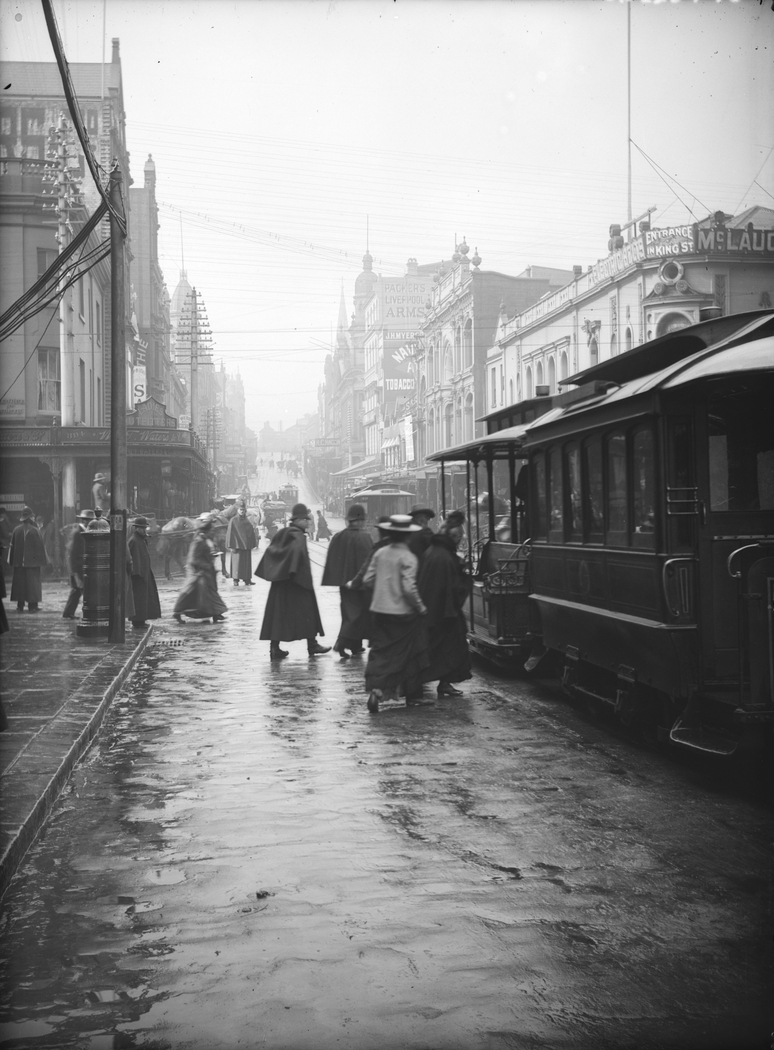
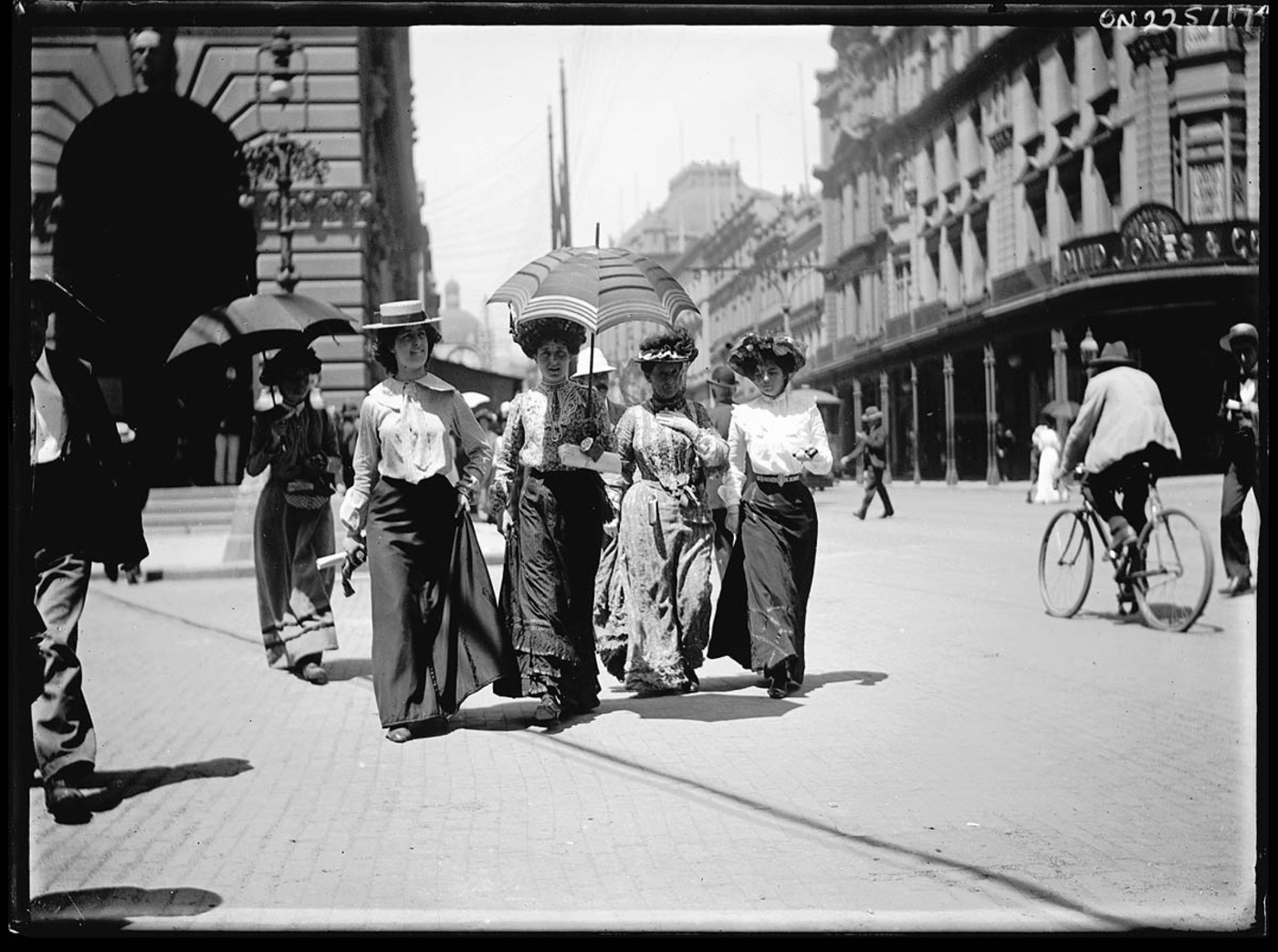
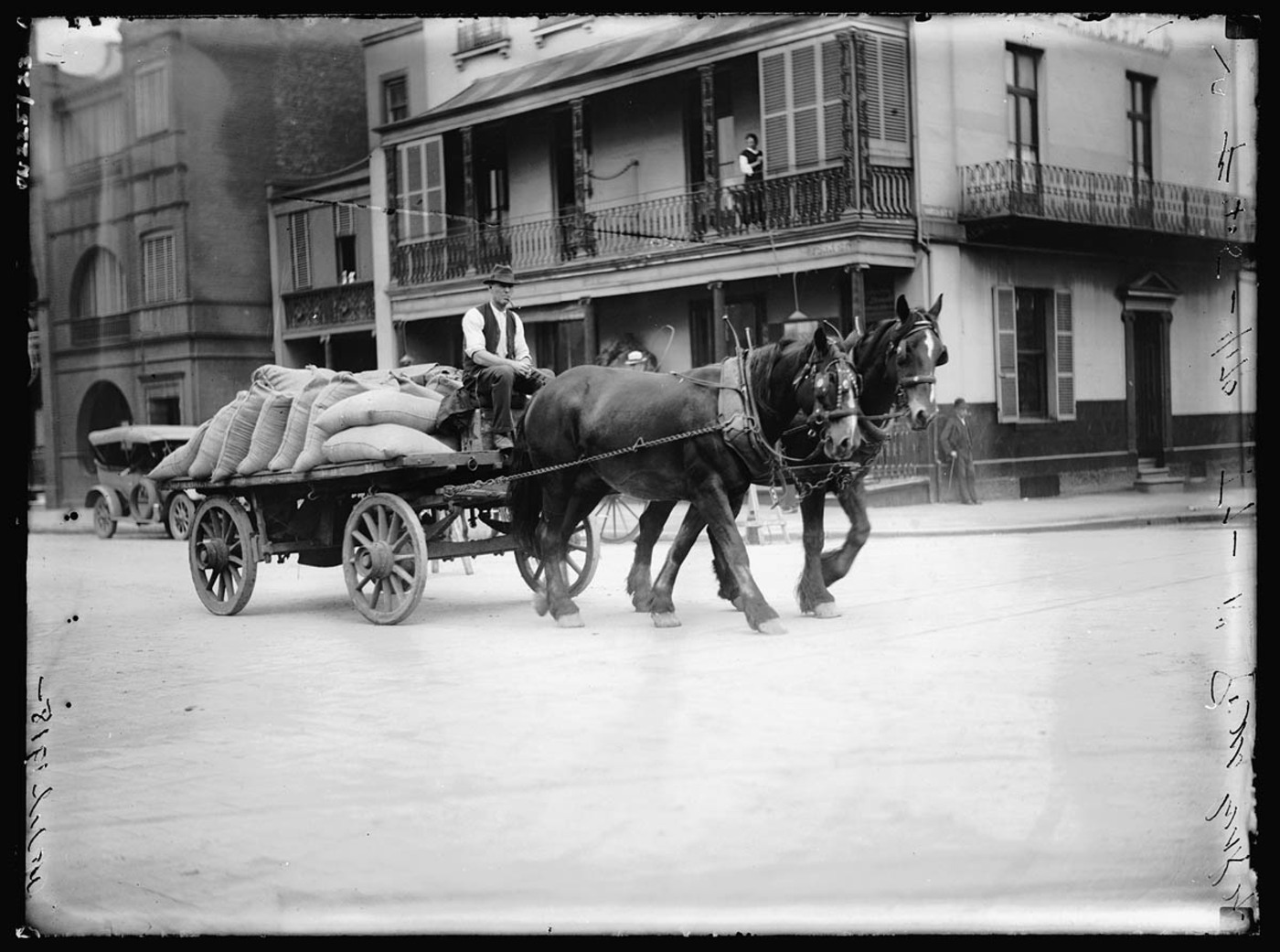
Frederick Danvers Power - photonegatives, 1898-1926, Images: a422010h, a422005h, a422003h, a422011h, a422004h, courtesy the State Library of New South Wales
Both Scouts and Guides are now allowed to keep their badges and many of we who have been a part of either when growing up will recall having some of our first experiences in 'sewing' through adding these to the sleeves of our shirts.
At Newport, before the formation of the local Troop in the late 1930's, and asking Warringah Shire Council about land that is available for a Scout Hall in 'Bardo Road' in October 1947, an area was established for Scouts who lived far away from fresh sea breezes. Later reports indicate a few acres were made available on the Newport-Bungan Beach verges. The name 'Kelso King' keeps popping up among these reports as well, as does one Mr. Munro-King.
Sir George Eccles Kelso King (1853-1943), businessman, was born on December 30th 1853 in Sydney, seventh child of Rev. George King and his wife Jane, née Mathewson. He was educated at Calder House, leaving school young because of his father's financial difficulties. After working briefly as a jackeroo in Queensland, he returned to Sydney and joined the Bank of New South Wales in 1870. In December 1877 he became secretary of the new Mercantile Mutual Insurance Co. Ltd. In 1880-81 King managed the Anglo-Australian Investment, Finance & Land Co. Ltd.. He was early associated with Walter and Eliza Hall, whom he met travelling in a Cobb & Co. coach. Later he acted for Walter Hall in many of his business activities, and was his executor. He assisted his widow with her affairs and to plan the Walter and Eliza Hall Trust of which he was an original trustee.
Sir King also became a director of many companies including Mount Morgan Gold Mining Co. Ltd, the Electrolytic Refining & Smelting Co. of Australia Ltd, Metal Manufacturers Ltd, Australian Fertilizers Pty Ltd, Illawarra & South Coast Steam Navigation Co. Ltd, the Colonial Mutual Life Assurance Society Ltd, Beale & Co. Ltd and the Bank of New South Wales (1929-40), chairman of Mort's Dock & Engineering Co. Ltd and Brisbane Theatres Ltd, and first managing director of the Australian General Insurance Co. Ltd from 1912.
He was also very active in philanthropic work. He was a lay canon of St Andrew's Cathedral and church warden of All Saints, Woollahra, a member of the Church of England Property Trust and Sydney Diocesan Board of Finance, honorary treasurer of a number of church funds, and a governor of The King's, Trinity Grammar and Canberra Grammar schools. He was a trustee of Royal Naval House, honorary treasurer of the New South Wales branch of the Navy League, president of the Royal Life Saving Society, commander of the Order of St John of Jerusalem and, from 1937, president of the New South Wales branch of the St John Ambulance Association. He was a foundation member of the Australasian Pioneers' Club (president, 1928-43) and belonged to the Australian and Union clubs. He was president of the Royal Empire Society and a benefactor of the Royal Australian Historical Society.
Mr. Kelso King was also elected Chairman of the Boy Scouts State Executive in 1923 and continued to serve as Chairman until his death in 1943. Knighted in 1929, he was also awarded Silver Wolf in 1930. On November 13th 1907 at Christ Church, South Yarra, Melbourne, he married Alicia Martha Kirk, a cousin of Eliza Hall, who, like her husband, was active in community organisations and was assistant State commissioner for the Girl Guides' Association in 1925-31.
Seeing the Sights
By 'ONE OF THEM'
I suppose, Mr. Editor, Katoomba is the same, though the Scouts are out of it. And let me assure all Mountain friends that we are having a good time. We arrived safely at Newport, all in good fettle. We landed in Sydney at 9. 50 on Monday, and at once inspected the big gun at the rear of the station. It is a beaut., and a relic that will tell young Australians of the future of the deeds our fathers did in the great war.
After listening to the details, we fell In and marched down George-street to the Quay — Circular Quay. 'We out some dash, believe me, and more than one of the spectators applauded, and said how well we looked and how splendidly we marched.' In spite of our heavy packs our chests went out, and we had grown inches (in our own estimation) long before we reached Manly wharf.
Once aboard the ferry we set off. In fact, the man with the rope said he waited for us, but I fancy he was 'pulling our leg.' When passing Garden Island, we saw several gift submarines and cruisers. After lunch we boarded the tram for Narrabeen, our Mascot, a large collie, amusing the crowd by his loud and excited burking. He was probably telling the seasiders that 'The Mountain Scouts are here,' but they only laughed at him and stared at us.
On reaching Narrabeen, we filed into motor cars (some style), and had a splendid run to Newport. Here tents were pitched and — best news of all — dinner was served by the ladies, Mesdames F. Barclay, F. Marshall und Miss Bruce. It was a good meal, and we ‘’deserved it,’' all eating more than our share. The seashore claimed us all the afternoon, some of the boys proving lucky fishermen (?). Tea was served at 5.30, and the camp-fire was made for the night. Round this we spent a happy time; all singing, reciting und telling stories. Scoutmaster F. Barclay, who is spelling here, gave us some good advice, and ere bedtime we sang 'This Is the end of a perfect day,' after which we gave cheers for the ladies, Messrs, Marshall, Barclay and Monro King, who was a real patron to us.
'Lights out' sounded at 8.30 p.m., and soon after all was silent for the night. At least, I heard no more.
Next morning we were out at bugle cull — 7 a.m. they said, but I thought it was earlier. After a hearty breakfast away we went, hill-climbing, fishing, bathing, running, games, etc, just tiring ourselves out, and outing for spells. We are all happy, and the holiday promises big, I'm just, writing to let all our relatives know we are well, and I will forward later news for next Issue. If you see Mr. Monro King, just tell him we think he is grand, and we'll tell him so when we get home, through 'The Echo,' the Mountain paper.
[The above arrived too late for our last Issue. — Ed, E.]
I finished my last to you on Tuesday night, and it is no credit to our postal service that, it didn't vouch you till Friday morning. I put the case before our Assistant-Scoutmaster (Mr, Marshall), who is in the P.O., but he only joked about it, and said, my notes were just on the edge of the waste-paper basket. I hope that |s not so, Mr. Editor, as the Barclay Boys are big hits — at least, we think we are at the present time, having the holiday of our lives.
On Wednesday we had our first route march to Bushrangers Hill, from the summit of which we had a glorious view of Manly. In all we tramped about eight to 10 miles, and the outing gave us a great appetite for our tea. We curtailed the camp-fire concert, and most of us were under the rugs when 'Lights Out' sounded.
Thursday was the big day, 'Reveille' sounded at 6am, and after a boson breakfast we fell in and started on a route march to Barrenjoey, seven miles away. Mr, and Mrs, Marshall, and Aubrey Dartnell paced with us, and kept, us all in the best of spirits. We were shown all over the lighthouse, and eagerly climbed to the top and enjoyed the magnificent outlook. To several of us, the outing marked our Introduction to the city,' the sea and all surroundings, and we, one and all, blessed Mr, Monro King, whose generosity made the trip possible, and to the good people who gave their time and attention to supervise the outing, and watch over us while away from home.
After seeing all that was to be seen, and making our stock of refreshments look silly, wo footed it back to camp, and we think Mr. and Mrs. Marshall finished the freshest of the lot. In all we walked about 17 miles, and we were pleased when the camp fire hove in sight.
Among the many sights of the day great interest was centred in the view of the spot where the Maitland was wrecked, plainly discernable through the glass, also Lion Island and Cape Three Points. We were very quiet round the fire side on Thursday and Scoutmaster Barclay’s concluding prayer sent us all to bed well satisfied with all things.
Friday was an easy day, we spent it on the beach surfing, fishing, boating and ‘scouting’. The watermen fared well, securing some nice oysters, and the scouters secured some nice lemons.
Saturday we were up early, and, with sad hearts, we struck the camp where we had spent a happy week. Tents were folded and all equipment packed away. At 10 sharp the motors called, and, contrary to expectations, and greatly to our delight, we were motored right into Manly, the hours run being a genuine treat.
‘More Monro King’ was what all thought, and again we wafted him our grateful thanks.
At Manly we accounted for buns and cakes and going over in the ferry we had the view of our gallant Navy, our own watchdogs of the deep, who ably played a art in defending the Empire in the recent struggle.
‘’ Sons of the Sea, All British Born.’’
It was, indeed, good to think that we were one of them and in the presence of the fleet. I felt, in fact we all felt, that the Scouts of Katoomba have something to live up to, so as to be worthy of the traditions of our Navy and the Aussies who manned it.
We trammed it from the Quay, and after much trouble, secured our reserved carriages which our Scoutmaster had provided for, and landed in Katoomba all feeling the better for the weeks’ outing, and all truly grateful to the ladies and gentlemen who had provided it for us.
Mr. R. A. Monro King comes first. He is a toff. Then Mr. and Mrs. Marshall, who are, without doubt, the Scouts’ best friends. Then Mr. and Mrs. Barclay, our new master and his good wife, Miss Bruce, a loyal worker, Mr. John S. Henderson and Mr. M Davison are also to be thanked, the first for a cash donation and the latter for two beautiful cakes. Gifts in kind were also received from Messrs. James Bros., E. Delaney, Carlisle, Rouche, Martin, Webb and Bell (grocer).
Of the boys, Les Messiter, with his mouth organ and his songs, not forgetting ‘the green grass’ was the life of the party, Aubrey Dartnell, also played the music well. The musical Scouts included Bert Johnson, who knows ‘King Cole’, Doug Marshall, Keith McKenna, with his specialty ‘P.C. 49’, and Ron Stewart, ‘Tubby’, was the champion chewer of the party, and whenever his spirits flagged, a pinch of gum was always sufficient to revive them.
It was, without doubt, the trip of our lives – the best we have ever had since the formation of the Scouts, and our hearts are full of gratitude to the good friends who gave it to us.
The Mountain party included; -
Scoutmaster F Barclay and Mrs. Barclay, Assistant Scoutmaster F. L. Marshall and Mrs. Marshall, Miss Polly Bruce.
Troop Leaders A. Dartnell and Doug Marshall, Scouts; J. Brown, J. and N. Willo (?), A. and E. Johnson, E. Clampett, R. Stewart, R. McKenna, E. Knight, L. Messiter, W. Williams, N. Carter, O. White, E. and G. Alderson, B. Burnett, A. Samuels, F. Hammond.
Cubs; R. Knight, D. Marshall, A. Skinner, K. Lennlo, S. Harrison, L. Dowton, M. Carter, G. Williams. Scouts at the Seaside (1920, June 18). The Blue Mountain Echo (NSW : 1909 - 1928), p. 6. Retrieved from http://nla.gov.au/nla.news-article108237390
This was probably meant to be spelled ‘Bungan’, as it was in later reports:
SCOUTS' CAMP.
Lithgow Boys by the Sea.
No. 1 Troop, of which the Rev. P. Hope is Acting Scoutmaster, has just returned from Burgen Bay, near to Newport, where they thoroughly enjoyed their first scout camp by the sea. Four 12 x 10 tents sheltered 10 scouts and the S.M. and, well pitched, withstood several southerly busters. The cooking and fatigue work was done by the scouts, who acquitted themselves most creditably.
The object of the trip was to give Lithgow boys an opportunity of surfing and swimming, and to train them in the necessary arrangements of an extended camp. From "reveille" at 6.30 a.m. to ' ' lights out ' ' at 10 p.m, every day was brimful of happiness and, if appetite is a sign of vitality, the troop was thoroughly vitalised. No accidents occurred and the conduct of the scouts was in keeping with the high ideals of the movement. It was with regret that the tent pegs were drawn and Burgen Beach camp added to history, the scouts returning to Lithgow in charge of Troop Leader Hinder.
Scoutmaster Hope is staying on with his family until the end of the month. During the camp Troop Leader Hinder and Second Galvin were tested in Manly Baths by Mr. Dick Eve and passed the life saving tests, which entitle them to wear the scouts rescuers proficiency badge. SCOUTS' CAMP. (1928, January 23). Lithgow Mercury (NSW : 1898 - 1954), p. 4. Retrieved from http://nla.gov.au/nla.news-article219698713
Rev. P. Hope B.A. and Mrs. Hope return to Lithgow tomorrow after a holiday spent, at Bungan Head, in the Newport district. At the commencement of his vacation, Mr. Hope spent ten days in camp with the Lithgow troop of Boy Scouts and, according to a letter received in Lithgow, he says their sojourn by the sea has been one of uninterrupted delight. He praises the natural beauty of the stretch of coast north of Manly, and forecasts for that area 'immense possibilities as a residential and tourist centre. BREVITIES. (1928, February 1). Lithgow Mercury (NSW : 1898 - 1954), p. 4. Retrieved from http://nla.gov.au/nla.news-article219690265
The first Lithgow Troop of Boy Scouts will spend 10 days in camp at Bungan Beach, Newport, under Rev. P. Hope. VETERAN PRIEST (1930, December 30). Daily Pictorial (Sydney, NSW : 1930 - 1931), p. 14. Retrieved from http://nla.gov.au/nla.news-article246187471
First Lithgow troop of Boy Scouts will spend the next 10 days in camp at Bungan Beach, Newport,- under the guidance of the Rev. P. Hope. Mr. Hope and family will spend the remainder of their month's holiday in the metropolis. BREVITIES (1930, December 29). Lithgow Mercury (NSW : 1898 - 1954), p. 2. Retrieved from http://nla.gov.au/nla.news-article219580426
REV. P. HOPE.
Rev. P. Hope, B.A., pastor of St. Mary’s Presbyterian Church, returns to-day from a holiday at Corrimal. He found the roads there worse than at Lithgow. At Corrimal, coke-ovens are only separated from the station by a narrow lane, yet the rustic surroundings are hardly marred by the industrial smudge on the landscape — a useful suggestion to Lithgow. At Corrimal he met several former Lithgowites. Sergt. Borger and his son are at the police station; Mr. W. Bilkey has established an up-to-date garage; Mr. Deegan, the custodian of the School of Arts, is a former Lithgow resident. In Dr. Charles Palmer, of Bulli, he found an old schoolmate. At the State school he had the pleasure of listening-in to a service at the Petersham Congregational Church — an innovation which promises great things for isolated residents in rural districts. REV. P. HOPE. (1926, February 5). Lithgow Mercury (NSW : 1898 - 1954), p. 6. Retrieved from http://nla.gov.au/nla.news-article224588782
He resigned in March 1932 after a bad car accident but took up another more senior position with the church.
PRESBYTERIAN CHURCH
Visit By Rev. P. Hope
The Sustentation Fund Officer of the Presbyterian Church in New South Wales, Rev. Percival Hope, is at present visiting Kyogle, with a view to organising the finances of the congregation. Mr. Hope came first to Kyogle in 1908, when he was a guest of the late Rev. and Mrs. Johnston. At that time he was commissioner under the General-Assembly for the Professorship Endowment Fund, which aimed at raising £18,000 as a capable sum for the establishing of a third professorship in the Theological Hall. So successful was Mr. Hope's work that £20,000 was subscribed by the Presbyterians of the State in about 18 months. In 1910, Mr. Hope became minister of Kirklands in Tasmania. He was minister in the Tasmanian church in 1913 and Home Mission Convener for five years. He joined the A.I.F. as a padre in 1916 and saw active service with the 5th Brigade in France during 1917 and 1918, being attached to the 20th. Battalion. He returned to Tasmania after the war and in 1921 was called to Lithgow, N.S.W., a large industrial centre with thriving coal mines and steel works and the small arms factory. During his ministry, the Hoskins Memorial Church was erected as the gift of Mr. Charles Hoskins and his wife in memory of deceased children. It cost £60,000 and is a very beautiful' edifice; situated in three and a half acres of lawns and gardens, which are kept in fine order. Three years ago, Mr. Hope resigned from Lithgow and undertook the organising work on which he is now engaged. He will preach on Sunday in Kyogle morning and evening, and at Wiangaree in the afternoon. PRESBYTERIAN CHURCH (1936, July 10). The Kyogle Examiner (NSW : 1912; 1914 - 1915; 1917 - 1954), p. 4. Retrieved from http://nla.gov.au/nla.news-article235257804
Percival Hope was born in Penrith in 1879 to George and Mary Hope. In 1906 he married Florence Scotchford, a daughter of the then deceased William John Scotchford, Mayor of Bathurst, who died due to dysentery a day after a daughter passed away from the fevers then associated with this. He had only been elected a few months prior to his death with cleansing the streets of Bathurst and putting in a decent water system to combat what was happening his priority. He was a Captain of the local Bathurst Boys Brigade, a forerunner of Boy Scouts.
The first child of Percival and Florence was Alec Derwent Hope, born in Cooma, New South Wales, on July 21st 1907. In 1924, aged 17, he was awarded a scholarship to study arts at Sydney University and graduated with first-class honours in English in 1928. He also studied Japanese and psychology, encountering Professor John Anderson whose interest in the human mind had a lasting effect on him and the poet, Christopher Brennan, who had a place at Newport, up on Myola road.
As the Brennan family spent a fair amount of time at Newport, as well as at their Mosman home, this may have been where the Lithgow boys stayed.
Another early scouting camp at Newport goes to a Drummoyne connection once more.
Great Day at Villa Maria.
Welcome to the Governor and the Archbishop. NEW SCOUTS' HALL OPENED.
PERCHED on a picturesque site overlooking part of the Drummoyne Golf Links with a vista of bushland stands an attractive Catholic Boy Scouts' Hall, which was opened by his Excellency the Governor, Sir Philip Game (Chief Scout) on Sunday afternoon after his Grace the Archbishop had blessed the building.
This is the second hall, the first being at Kogarah, which stands to the credit of this splendid organisation. The land was a grant, being the dead end of Mary-street, by the Hunter's Hill Council, and the erection was the work of the boys assisted by many St. Vincent de Paul members and other willing friends. The cost of the building which, as shown in the photograph published hereunder, is rather attractive, was £162. Towards this the Villa Maria Scouts collected £20 on Sunday to augment their funds. The. day was a great one for the district and for the Scouts.
His Excellency, who had with him Scoutmaster L. J. Skewes as A.D.C., and his Grace the Archbishop, attended by Rev. Father P. McDonnell, were received with guard of honor of many Scouts, led by the Papal Banner winners, 2nd Randwick, in charge of A.S.M. K. Lee. Others represented were Villa Maria, in charge of Scoutmaster Talty and A.S.M. Kavanagh; Gladesville, Scoutmaster Roberts; Belmore Rovers, in charge of Scoutmaster L. De K. Huon, president of the Catholic Section of the movement; Leichhardt Rovers, Scoutmaster Crowley; 1st Boronia, Scoutmaster Coombes, with Mr. E. J. Flint, president; Parramatta, Scoutmaster Sullivan; Ryde, Scoutmaster Fitzpatrick; Hunter's Hill Cubs, Scoutmaster Pearce; Five Dock, Scoutmaster - -Hurley. His Excellency was highly delighted with the arrangements. He carefully inspected the Troops and exchanged more than one word with cub and scout and expressed to his Grace the Archbishop his gratification of the reception tendered to him.
After the blessing a public meeting was held at which his Grace insisted upon his Excellency taking the chair, although Sir Philip preferred the honor going to the Archbishop. On the platform were noticed Rev. Father L. Kelledy, S.M., Villa Maria, Rev. Father Bertin, S.M., Rev. Father Wache, S.M., Rev. Father Rigard, S.M., Rev. Father J. O'Toole, Rev. Bro. Denis (Director of St. Joseph's College, Hunter's Hill), Rev. Bro. Camillus (of Randwick), Chief Commissioner Lieutenant-Colonel J. M. Maughan, D.S.O., Mr. W. A. Windeyer (Deputy Chairman Boy Scouts' Association), .Mr. F. McAlister (Deputy Camp Chief), Mr. J. L. Mullen, L.C., President of the Superior Council), Mr. W. J. Coogan, L.C., President of the Particular Council of the St. Vincent de Paul Society, Mr. F. Du Boise. Mr. C. P. Doust (State Commissioner for Cubs). North East Sydney District of the Scouts was represented by Mr. A. E. Roberts (president), Mr. H. Alexander (district secretary), Mr. C. E. Farthing represented the Hunter's Hill Council, Mr. W. J O'Brien, of Scone, represented Mr. V. J. Gattenhof, former president, also Mr. L. De K. Huon, president of the Catholic Boy Scouts' Section, Mr. G. Phillpott, hon treasurer, Mr. G. Hurley, publicity director, Mr. W. H. McCarthy, asst. hon. secretary, Mr. T. O'Sullivan, vice-president, and Scoutmaster L. J. Skewes, A.D.C. to the Governor.
After Mr. L. De K. Huon had asked his Excellency to declare the hall open, Father Kelledy extended a hearty welcome to his Excellency, -and his Grace and said that it was fitting that representatives of God and of country were present because a love of God and of country held first place in the scout's training. Love of God had brought his Grace because he has a vital interest in anything having to do with good citizenship and good character, and Scoutism set forth real foundation of religion arid love of country. After explaining the rules and ideals of the Scout Movement, 'Father Kelledy explained that in the parish there were 12 schools having to do with the formation of-character, and of these six were in the hands of the Sisters and Brothers, thus Indicating the regard of the Church for the complete education of the young. He. then explained that there were more Catholic Scouts than the others combined and mentioned that in France the total was 25,000, while a large number in other Catholic countries were under the patronage of the Church.
His Excellency the Governor.
His Excellency the Governor declared that he didn't desire any thanks, as he was delighted to come among the scouts, although he was a tenderfoot, having joined but two years before. He was grateful for the privilege to open the hall and said that it was wonderful the way the Villa Maria troops had carried on under such difficulties and hoped that they would make the best use of their hall. A lot of useful work was done indoors in' -preparation for outdoor 'work, and in that, respect he explained the advantages of learning useful things in the bush, and he gave some interesting points in that respect when he cited how post and rails could give the scout an indication of the points of the compass. If they noticed post and rails they would find that the side of the fence was facing, south, and east had signs of vegetation, whereas those on the north and west had none because the sun kills it. His Excellency then paid tribute to the interest of the Archbishop in the scout movement and said that while- it had friends all over the world there was none better than the Church because the ideals of the scouts were in conformity with those of the Church. (Applause.)
His Grace the Archbishop.
His Grace declared that the remarks of his Excellency would do for the occasion because they could derive great profit from them for him to continue would be like a carpenter driving a nail home and then another carpenter coming along and doing the same thing. His Excellency had driven the nail home, and to confirm them in their scout movement he would say, particularly to the Catholic Scouts, to hold on to their ideals. Concerning his interest in the movement, his Grace said: 'If the Archbishop for a year or two gave no apparent sanction to the movement it was because he saw so many scouts marching on Sundays with their banners just -alter breakfast, but when Father Hogan came as chaplain it was made sure that the scout movement would not interfere with the school nor the altar boys, and that the lads would attend their duties, then it was all right. If you be as good as you can, let us hope the others will be better for the sake of the scout movement.' (Applause.)
Chief Commissioner Lieut-Col. J. M. Maughan, D.S.O., added words of congratulations and spoke in an interesting way of the necessity of the scouts learning to appreciate love of trees and of the bush, and expressed a wish that around the hall they would plant trees.
Tribute to Father Laurent.
Mr. W. A. Windeyer in a vigorous address moved that a subscription list be opened and handed in his cheque. He knew the good being done by the scout movement and said that the hall, must have its influence in the place. In an eloquent way he paid tribute to the great work of Father Laurent, then of Villa Maria, during the war and the great assistance he gave in any movement for the betterment of everyone. He hoped that the spirit of Father Laurent would 'be carried along and reflected through the community. Mr. J. I. Mullen declared that the scout movement would help in a way to solve the boy problem. It was an excellent idea to join up when at school and afterwards continue their association until they reach the age of 19 or 20. In keeping up that association and particularly so with those controlled by religious denominations it could be fairly hoped that the training received would stand to them in the battles of life in the world.
At the close of the speeches cheers were given for the Governor and his Grace, who, with the visitors, were entertained in the hall at gaily decorated tables. The ladies' committee responsible for the hospitality included Mrs. L. Murray, hon. secretary; Mrs. Barrar and Mrs. Kavanagh, joints hon. treasurers, assisted by Mrs. Stevens, Miss Stevens and Miss Kavanagh, with Mr. E. Deschamp. president of Villa Maria Scouts.
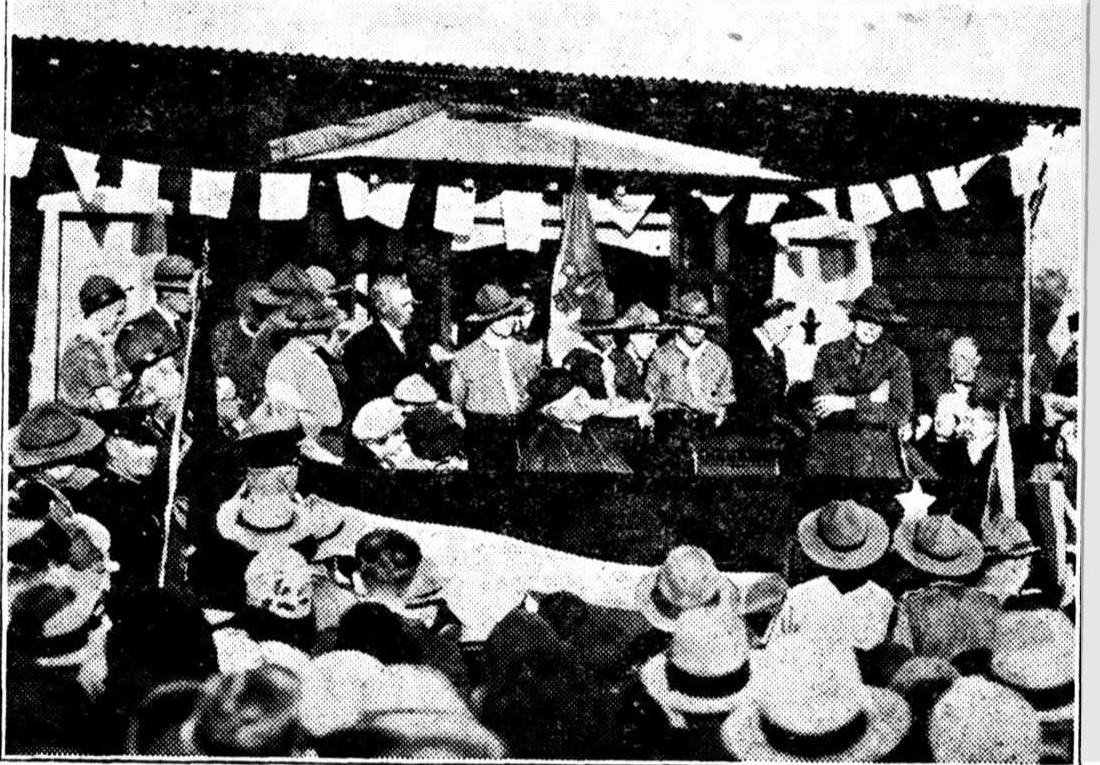
His Excellency the Governor addressing the Boy Scouts after opening the Scouts' Hall at Villa Maria. Mr. J. L. Mullen, L.C., President of the Particular Council of the St. Vincent de Paul Society, is at the right of the Governor. At his Excellency's left is noticed Rev. Bro. Denis, Director of St. Joseph's College. His Grace the Archbishop is also an interested listener, as well as 2nd Randwick Troop, winners of the Papal Banner, who are mustered at the back of the Archbishop. Great Day at Villa Maria. (1931, August 6). Freeman's Journal (Sydney, NSW : 1850 - 1932), p. 26. Retrieved from http://nla.gov.au/nla.news-article118079132
Lesley John Skewes was born in 1879 to Samuel Sidney and Sarah (nee Pennell). One of his six sisters was Caroline Mary Skewes, mother of June Dally Watkins.
Of 32 in Villa Maria Troop no fewer than 16 have bikes. Hence bike-hikes are a feature. The gear goes ahead in Mr. L. J. Skewes's car, and is carried to the camping ground. Our picture was taken in St. Ives Showground, on the occasion of a ride to Mona Vale.
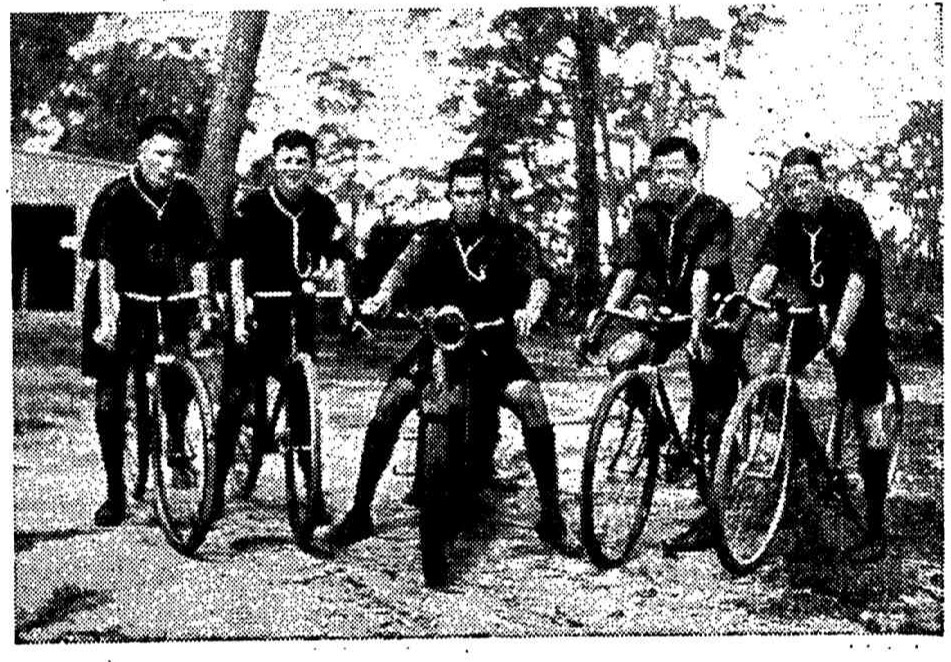
Left to right: John Butler, Vincent Wills, Kevin Hickey, John Dwyer, William Gray. SCOUTING (1936, March 25). The World's News (Sydney, NSW : 1901 - 1955), p. 34. Retrieved from http://nla.gov.au/nla.news-article136323606
SCOUTS HOUSE AT NEWPORT
1st Villa Maria Scout Troop.
On Sunday afternoon week the 1st Villa Maria Boy Scout Troop parents celebrated the official opening of their Holiday House at Newport by Mrs. W. Whitelum (wife of the President of the Catholic Section of the Boy Scouts), who was accompanied by Mr. Whitelum. They were met on arrival by the Scoutmaster, Mr. L. J. Skewes, and the Troop Leader, Arthur Cooke. Mrs. Whitelum was presented with a sheaf of red roses by Scout James Cox.
The scoutmaster, L J. Skewes, welcomed the guests and explained the object of this permanent camp site of two acres. It had been an old home which his troop had been fortunate in securing for some years, and with the hard work of the members of the troop, assisted by several of the fathers of the boys, had been turned into a very fine Holiday Home for the boys. It was thoroughly equipped in every way and would be used by his troop to bring boys from other troops and thus giving them a holiday. It would give the Scouts an opportunity of entertaining boys from families who were brought under their notice by the St. Vincent de Paul Society, as well as hoys who were the sons of men now in the A.I.F. Mr. Skewes paid a tribute to his Patrol Leaders and Scouts whom he said had given many months of their spare time in order that the house and grounds would be all that they desired.
Mr. W. Whitelum Pays Tribute.
Mr. W. Whitelum, President, of the Catholic Section of the Boy Scout Movement, congratulated the Troop and its Scoutmaster on the very fine achievement in securing this Ideal holiday home. He praised the very fine motive that the boys had in mind of giving other lads less fortunate than themselves an opportunity of having a holiday in happy surroundings. He also thanked the boys for the fine way In which they had helped the Catholic Section In visiting other Troops, ... teaching them the various phases of Scouting which they knew so well. Rev. Father R. Nowlan, S.M. Rev. Father R. Nowlan, S.M., Chaplain to the Troop, paid a high tribute to the very worthy motive that was behind the new Home; he congratulated the S.M. and the boys on their achievement, and he also thanked the parents on the splendid support that they had given to the Troop generally. Rev. Dr. Girinski, S.M. Rev. Father Girinski, S.M.. from the Marist Seminary at Toongabbie, thought that the Holiday Home of the Villa Maria boys was an excellent idea and hoped that they would have many happy times in it. Mr. Houston in a very happy speech congratulated the boys on the good work they were doing and the very loyal manner in which they supported their Scoutmaster. He said that theirs was the only troop that he knew of in N.S.W. that had such a house. Mr. N. Bateman, whose son is a Patrol Leader in the Troop, praised the work of the boys and mentioned what scouting had done for the boys of the district.. He paid a high tribute to the standard of efficiency that the Troop had attained. He said that Mr. Skewes richly deserved the support that had been given to him and hoped the parents would continue to support a troop that meant, so much 'to the boys.
Mr. W. T. Carr, District Commissioner. Mr. W. T. Carr, District Commissioner, heartily approved of the house and gladly accepted the offer to use it as an occasional meeting place for the Rovers of the district.
House Declared Open.
Mrs. Whitelum then turned the key in the door and said that it was a pleasure to declare the Holiday House open. Some of the guests noticed were: Rev. Father R. Nowlan, S.M. (Chaplain to the Troop), Rev. Dr. Girinski, S.M., Rev. Father Podoo, S.M., Mr. and Mrs. W. Whitelum, Mr. and Mrs. A. N. Houston, Mr. and Mrs. W. T. Carr, Mr. B. Ryan and Miss Ryan (5th Glebe), Mr. and Mrs. Moroney, Mrs. IQ. Skewes and the Misses P. and Mrs. Skewes, Mrs. W. R. Davis, Mr. and Mrs. N. Bateman, Mr. and Mrs. A. McRae, Mr. J. Eather (President St. Vincent de Paul, Hunter'' Hill), and Mrs. Eather, Mr. and Mrs. E. F. Dwyer (Randwick), Mrs. L. Murray (Secretary Villa Maria Troop), Mrs. and Miss Long, Mr. and Mrs. Arnold, whose son John is one of the senior members of the Troop, came from their country home at Tumburumba to be present; Mr, and Mrs. Burge, Mr. and Mrs. Leach. Mr. and Mrs. Smith, Mr. and Mrs. 1-\ Kemp, Mr. and Mrs. Hogan. Mr. and Mrs. Benfield, Mr. and Mrs. Whiteford, Mr. and Mrs. Housega, Mr. and Mrs. Sohier. SCOUTS' HOUSE AT NEWPORT. (1940, October 31). Catholic Freeman's Journal (Sydney, NSW : 1932 - 1942), p. 13. Retrieved from http://nla.gov.au/nla.news-article146102182
SCOUT HOLIDAY HOUSE.
A Scout holiday house at Newport, provided by the 1st Villa-Maria Troop of Boy Scouts was opened yesterday by Mrs W. Whitelum, wife of the president of the Catholic section of the Boy Scouts Association. The house, an old property in large grounds, was redecorated by the members of the troop. It will be available to Scouts from other districts who are unable to afford a camping holiday, and to soldiers' sons. SCOUT HOLIDAY HOUSE. (1940, October 21). The Sydney Morning Herald (NSW : 1842 - 1954), p. 3. Retrieved from http://nla.gov.au/nla.news-article17712263
Jottings by Mr. Skewes, by then Director of Publicity for Catholic Boy Scouts, filled the pages of their journals for years to come.
Avalon Beach, Mona Vale & Elanora
Prior to an Avalon Beach Scout Troop being officially formed in 1951, the beach attracted its troops of Boy Scouts for camping, some of them the sons of those associated with the early land subdivisions:
FEE CHARGED.
Tents on Private Property.
Property owners and persons who camped near the many beaches in the Warringah Shire during the Christmas holidays have protested against the action of the Warringah Shire Council in levying a camping fee of 5/ for every tent erected on private property.
Campers were surprised when officers of the council asked them to pay the camping fee. Their attention was drawn to notices signed by tile shire clerk (Mr. R. G. Jamieson) stating that "any person erecting a tent or camp on his own land or on any other private land without first making application and obtaining permission from the council to do so, will be prosecuted." The notice added that the fee for the erection of each tent was 5/, which must be paid on application. There was an addendum, "Fee for one night only, 2/6." Receipts were issued in each case where the fee was paid.
Several meetings of protest were held by campers. A meeting held at Avalon beach on Monday night passed a resolution recording a "strong protest against the charge levied as a building permit on tents," and appointed a deputation to wait on tile president of the Warringah Shire Council.
Mr. A. J. Small (vice-president and past president of the Parks and Playgrounds Association) said yesterday that it was astounding that the council should have the audacity to collect camping fees from persons camped on private property. In his opinion, the charge was an interference with the liberty of the people.
Councillor Sheppard said last night that the council was within its rights In levying the fee, which was really a building fee. The council had power to levy the fee under Clause 85 of Ordinance 71, which read: "A person, shall not erect a tent unless upon application made for the purpose he obtains the approval of the council or of a representative of the council authorised to grant such approval."
Councillor Sheppard said the council, In deciding to levy the fee, had taken the view that the campers should contribute towards the cost of cleaning up the areas used as camp sites after the holidays. This work had been a heavy charge on the council's finances in previous years, The fee charged was nominal and should not cause resentment. The 5/ fee was charged for those camping on private property. Those camping on public reserves were charged a larger fee.
He added that the council had decided to exempt Boy Scouts from the fee. By error some Scouts had been charged the fee, but these amounts would be refunded. FEE CHARGED. (1932, December 29). The Sydney Morning Herald (NSW : 1842 - 1954), p. 8. Retrieved from http://nla.gov.au/nla.news-article16941707
Warringah Shire Council Minutes of Meetings records: Boy Scouts Assoc. of N.S.W. 11/4/33, requesting a refund, of 10/-, said to have been paid to Council for permission to camp on Mr. Small's land at Avalon Beach Resolved, - That the fee paid be refunded.
At Avalon Beach, what the son of J T Stapleton, real estate gentleman at Avalon, and his friends, in their Boy Scouts uniforms, which a lot of Boy Scouts wore on weekends and holidays as they were 'scouting', found while at the beach:
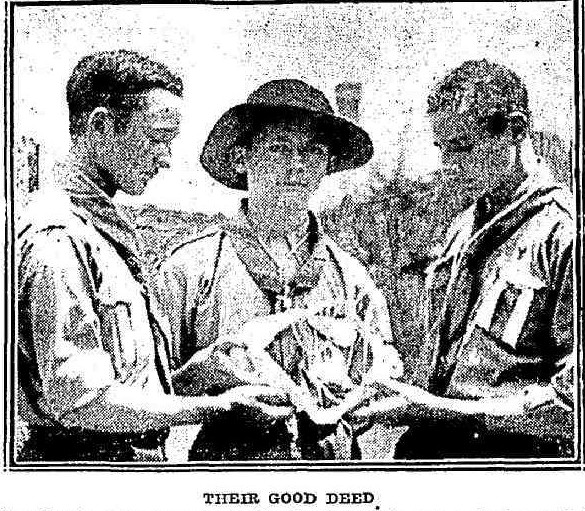
THEIR GOOD DEED These Scouts, while fishing at Avalon Beach recently, saw a shark near their rowing boat. One stunned the monster with an oar, and all three then dived overboard and dragged the 6ft. wobbegong ashore after having jagged a boat-hook into its mouth. From the left: J. Keegan, B. Kitson and P. J. Stapleton, who are seen holding the Jawbones. THE CALL OF SPORT. (1933, January 19). The Cumberland Argus and Fruitgrowers Advocate (Parramatta, NSW : 1888 - 1950), p. 13. Retrieved from http://nla.gov.au/nla.news-article107809364
Warringah Shire Council records show that correspondence was received from the Avalon Boy Scout Group Committee, 19/11/51, stating that a Boy Scout Troop has been formed in the district, and that a hall is needed for the holding of meetings and for training purposes, and inquiring whether Lot 16, Barrenjoey Road, could be made available in this regard. Council Resolved that this be referred to the Engineer for report as to whether Lot 19 could be made available to the Committee.
One newspaper report states the council was going to allocate £5000.00 for this edifice - nothing could be found to indicate it was.
Local lore has it that the same Scout Hall in Dunbar Park currently being used was originally a shed placed there for the benefit of members of the Avalon Beach RSL Club, formed by the Returned Servicemen in 1947, the first official meeting was held at the rear of the general store and later at the Avalon Golf course. The Club was formed in 1950 with 60 members who purchased a temporary shed, which now stands in Dunbar Park. This building was the Scout Hall for many years and was renovated as part of the Plan of Management for Dunbar Park by Pittwater Council in 2012.
Old Warringah Shire Council records show that Avalon Boy Scouts Committee wrote, dated 5/9/52, stating that advice of the Council's intention to postpone consideration of the granting of land for a Scout Hall at Avalon until receipt of the Progress Association's "overall plan" for Dunbar Park, has been received with regret; contending that the Association does not necessarily represent the true wishes of the population of Avalon in this matter and that the Scout movement at Avalon represents directly at least 60 families, and that the Committee has raised about £800 towards the cost of building, and that building plans has been submitted to the Council; and requesting that the Council reconsider its original suggestion for a grant of Scouts land in Barrenjoey Road.
In July 1953 it was resolved they could build a hall 'on Council's land' as long as the space in questions was filled in as required by the Department of Health, the area chosen being subject to floods and sitting in an old creek bed, as Avalon Guide Hall was when first built too.
By August 1958 the Council had forwarded Notice of Intention to Resume on the owner of Lot 15, D.P.9151, Barrenjoey Road, Avalon (Mrs. I.D.White) for the purposes of Section 348 (recreation, etc). The land is zoned as Open Space, and is on the western side of Barrenjoey Road between the shops and, the Scout Hall. Council decided, on the recommendation of the TP.D. Committee 2/6/58 (Min.8) that Lot 15 be adopted as the most site for a rest park and public conveniences, that its acquisition be expedited and that plans be prepared for the conveniences. This response was to calm J. Harry, of Elouera Road, Avalon Beach, and Messrs .A.E.& M.M. Geake, Avalon Health Foods, and two other lessees of the shops in question who were protesting against the Council's proposal to erect public conveniences on land adjoining these premises.
Members of the Avalon Beach Beautification Scheme, (letter dated 21.11.61) were advising Council the Committee ''views with alarm the decision forced upon the Council by a Court decision to open Old Barrenjoey Road at the north section of Old & New Barrenjoey Roads opposite the Fire Station, as the planning of the layout of amenities and beautification of this area was on both beauty and safety for adults and Children and it is felt that the opening of this-road has produced a safety hazard, as this area contains a Village Green, Scouts, Hall, Girl Guides, Kiddies Playground and proposed Baby Health Centre and public tenets. They added the Committee trusts that every effort will be made by Council to have this decision rescinded.''
As most residents know, that road is now open. There is also a record that the hall was moved in 1968 to its present position with its flagstone entrance and flagpole moved too.
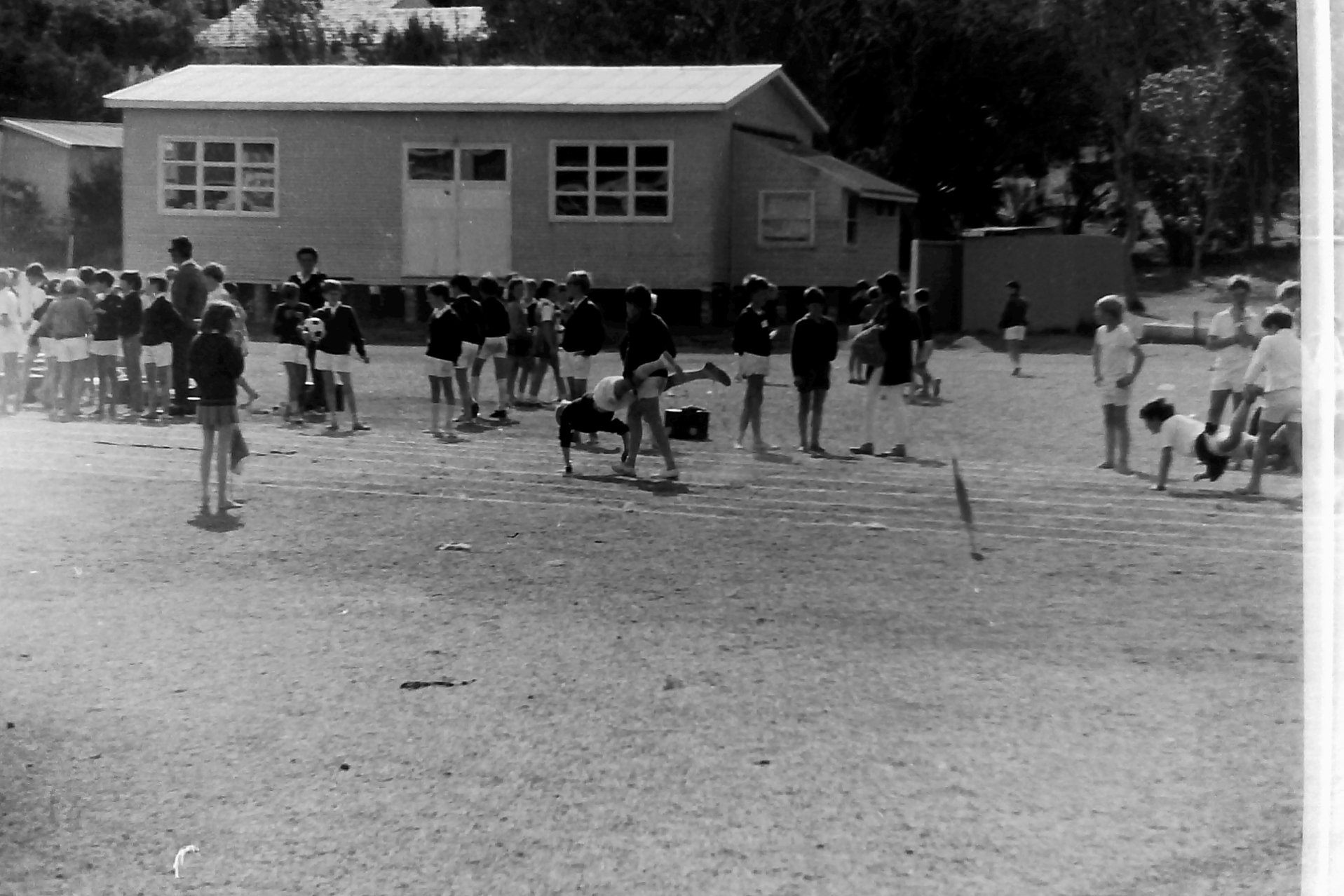
1970s Avalon Public School sports day in Dunbar Park - Scout Hall in background, photo courtesy Gary Clist
On March 4th, 1955 the Department of Education advised Council that it had resumed 10 acres of land for a school between Elanora and Mirrool Roads, Narrabeen North. Anywhere that needs a public school will shortly need rooms and grounds for Scouts and Guides to meet.
Ten years later correspondence from the Elanora Heights Group Boy Scouts Organisation,(12.3.65) is asking the matter of a scout hall be brought before council to enlist it in assistance to find a suitable site for them. Council Resolved; that the Elanora Heights Group Boy Scouts Organisation be advised there is no land available, council is unable to consider a proposition, during this financial year and the matter will be listed in conjunction with the 1966 estimates.
A year prior to this the Elanora Heights Progress Association was thanking Council for funds allocated for a Kindergarten and Recreation Centre and forwarding plans for the structure.
On the 19/9/1966: Cr. Lindsay: is asking; 'Could the Town Planner bring forward a report on the availability of land for a Scout Hall on land on the northern side of the Methodist Church in Mirridong Road, Elanora Heights, for the next Town Planning meeting?' Referred it was, however, it seems their meetings initially took place in the Recreation Centre.
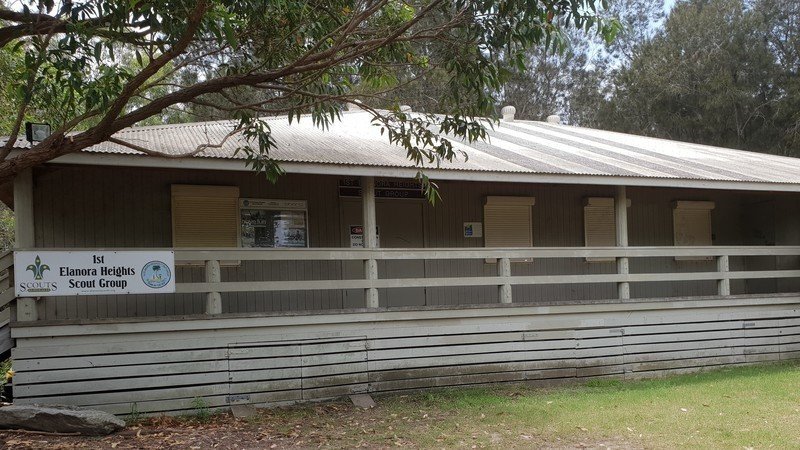 On the 14th of June 1977 a Public Meeting was held in the Elanora Heights Community Centre. Approximately ninety interested persons attended the meeting, the purpose of which was to consider the proposed extensions. Background Information was; - The Shire President outlined to the background to the proposal as- (a) Council in late 1974 considered and approved in principle a number of proposals for extensions to the Elanora Heights Community Centre. The main purpose of these extensions was and is now, to upgrade accommodation for existing users. In this regard the proposed extensions are seen to include:- (i) increased storage space. (ii) enlarged library space. (iii)undercover play area (iv) multi purpose meeting room for Scouts, Brownies, Guides etc. (v) additional kindergarten room (vi) the additional kindergarten room to be elevated so as to be capable of being used as a stage for the Elanora Player Productions. (b) Concurrent with this extension proposal Council considered, and in the light of resident's objections, rejected a proposal for acquisition of adjoining properties. This proposal would have enabled the ultimate development of a village green type park, thereby relating the shopping centre and community centre as a community focus for the suburb. (a) A Public Meeting was caned by Council in February 1975 when the proposed extensions were discussed. After considerable discussion this meeting carried by 99 votes to 27 ...
On the 14th of June 1977 a Public Meeting was held in the Elanora Heights Community Centre. Approximately ninety interested persons attended the meeting, the purpose of which was to consider the proposed extensions. Background Information was; - The Shire President outlined to the background to the proposal as- (a) Council in late 1974 considered and approved in principle a number of proposals for extensions to the Elanora Heights Community Centre. The main purpose of these extensions was and is now, to upgrade accommodation for existing users. In this regard the proposed extensions are seen to include:- (i) increased storage space. (ii) enlarged library space. (iii)undercover play area (iv) multi purpose meeting room for Scouts, Brownies, Guides etc. (v) additional kindergarten room (vi) the additional kindergarten room to be elevated so as to be capable of being used as a stage for the Elanora Player Productions. (b) Concurrent with this extension proposal Council considered, and in the light of resident's objections, rejected a proposal for acquisition of adjoining properties. This proposal would have enabled the ultimate development of a village green type park, thereby relating the shopping centre and community centre as a community focus for the suburb. (a) A Public Meeting was caned by Council in February 1975 when the proposed extensions were discussed. After considerable discussion this meeting carried by 99 votes to 27 ...
Today Council has allocated the Hall in Bilarong Reserve, North Narrabeen for the Troop's use and has recently upgraded and renovated that hall.
Further north 1st Mona Vale Boys Scouts recieved a £100 donation in August of 1965. By March 1966 they were asking Council to ask the Dept. of Lands if they could have some space in Kitchener Park to build a Scout Hall, where they still are today.
Meanwhile, at Bayview, the Sea Scouts building, the old Pittwater Aquatic Clubhouse, is in danger of being demolished due to its dilapidated state. It was saved but again came under potential demolition orders with a scheme to widen the road.
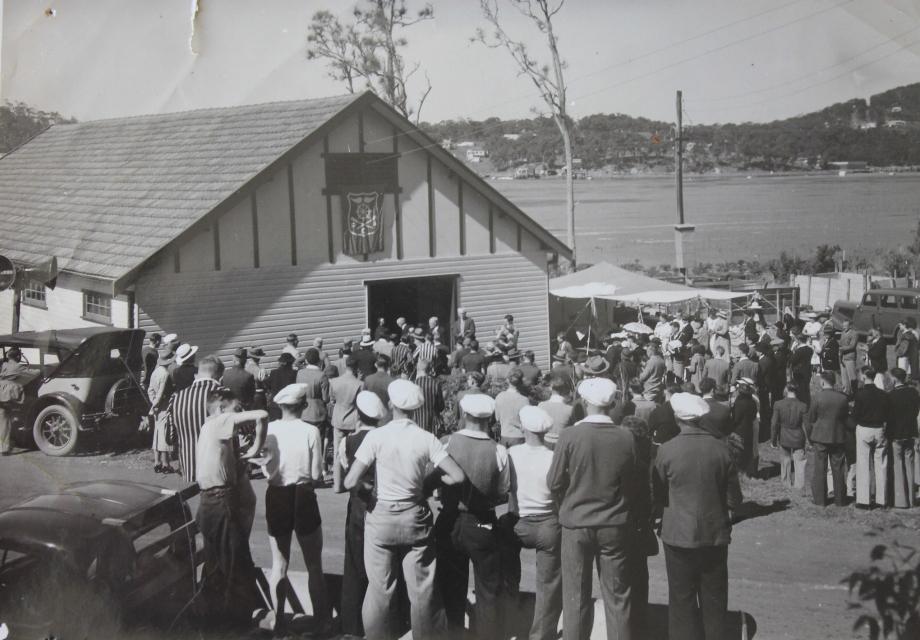
Pittwater Aquatic Club 1930's (where Bayview Sea Scouts hall is now) - Cedric William's photo
The Scout Association of Australia was inaugurated on 15 December 1958 and subsequently incorporated by a Royal Charter granted by Her Majesty Queen Elizabeth II on 17 October 1967.
Adapting to the general changes in society, Australian Scouting admitted females to its Venturer and Rover Sections in 1973, and to the Cub Scout and Scout Sections in 1988. When the Joey Scout Section commenced in 1990, girls and boys were both admitted.
Today the shirt is a dark blue shirt with a collar, yoke and sleeve in the following colours depending on the section of the Youth Member:
- Tan for Joey Scouts
- Yellow for Cub Scouts
- Green for Scouts
- Maroon for Venturer Scouts
- Red for Rovers
In 2020 the purpose of the Scout Movement is still to contribute to the education of young people in achieving their full physical, intellectual, emotional, social and spiritual potentials as individuals, as responsible citizens and as members of their local, national and international communities.
The Scout Association of Australia recognises the following values:
1. The importance of individuals developing a sense of personal identity and self-worth which leads to responsibility for oneself and one’s actions as a citizen.
2. The belief that young people are able and willing to take responsibility and contribute to society.
3. The rights and responsibility of individuals to regulate their own health.
4. The importance of adults in providing suitable role models for young people.
5. The importance of not exposing young people to harm or exploitation.
6. The importance of individuals and the community adopting a lifestyle that allows ecologically sustainable development through preventing environmental overload, environmental degradation and resource depletion.
7. The importance of respect for and equity in dealings with all people, irrespective of culture, gender, religion or impairment.
8. The importance of mutual support and help between members of a community to maximise the quality of life for all.
9. The importance of the development of understanding between individuals as a contribution to peace between nations.
10. The importance of gainful employment in contributing to the sense of dignity and self-worth of the individual.
11. The importance of harnessing technological innovation to benefit human society.
There are still over 25 million 'Scouts' of both genders worldwide which is some indication that, with all the youth movements the next generation can be a part of, whether it is surf life saving, climate strikes, mountain bike riding or something similar, there is still great value placed in being able to save lives through first aid, through knowing how to use a compass or how to save the drowning, or even find water in an arid landscape. Being Prepared through knowledge, training, camaraderie, equipped to acknowledge your own personal and individual emotional and spiritual growth means it is quite likely you will Be Prepared to cope with anything that comes your way.
References and Extras
- TROVE - National Library of Australia
- SOUTH AFRICAN MEMORIES - SOCIAL, WARLIKE & SPORTING. FROM DIARIES WRITTEN AT THE TIME, BY LADY SARAH WILSON, WITH ILLUSTRATIONS. LONDON, EDWARD ARNOLD. 1909 - Project Gutenberg
- South Africa and the Transvaal War BY LOUIS CRESWICKE, AUTHOR OF "ROXANE," ETC. WITH NUMEROUS ILLUSTRATIONS AND MAPS. IN SIX VOLUMES. VOL. II.—FROM THE COMMENCEMENT OF THE WAR TO THE BATTLE OF COLENSO, 15TH DEC. 1899. EDINBURGH: T. C. & E. C. JACK. 1900 - Project Gutenberg
- Hazel King, 'King, Sir George Eccles Kelso (1853–1943)', Australian Dictionary of Biography, National Centre of Biography, Australian National University, http://adb.anu.edu.au/biography/king-sir-george-eccles-kelso-6957/text12083, published first in hardcopy 1983
SYDNEY'S BOY SOLDIERS at a MILITARY DRAMA.
THERE was an inspiriting sight at the Theatre Royal on Friday afternoon, when 2000 of our boy soldiers, accepting the generous invitation of Mr. J. C. Williamson, witnessed a special production of ''An Englishman's Home.' Scouts and cadets from city and suburbs were in uniform, creating much public interest as, in perfect order, they proudly marched along the streets to the theatre. The building was literally packed. The boys enjoyed themselves immensely. Many of the younger ones ?did not realise the significance of it ?all, and saw comedy where tragedy was intended. But all joined heartily in boo-hooing the foreign invaders, and jeering the younger Brown for his cowardice, while old Brown was obviously a hero of heroes to the youthful soldiers. They applauded him tremendously, and when, having been taunted by the German officer with ''You are not a soldier,' he proudly replied, 'But I am an Englishman!' £he roof was almost lifted off with *he cheers that resounded, so that they ?could be heard far off in the streets. A similar demonstration followed old Brown's brave but futile stand in his ruined home against the enemy. At the close all joined in singing the -National Anthem.
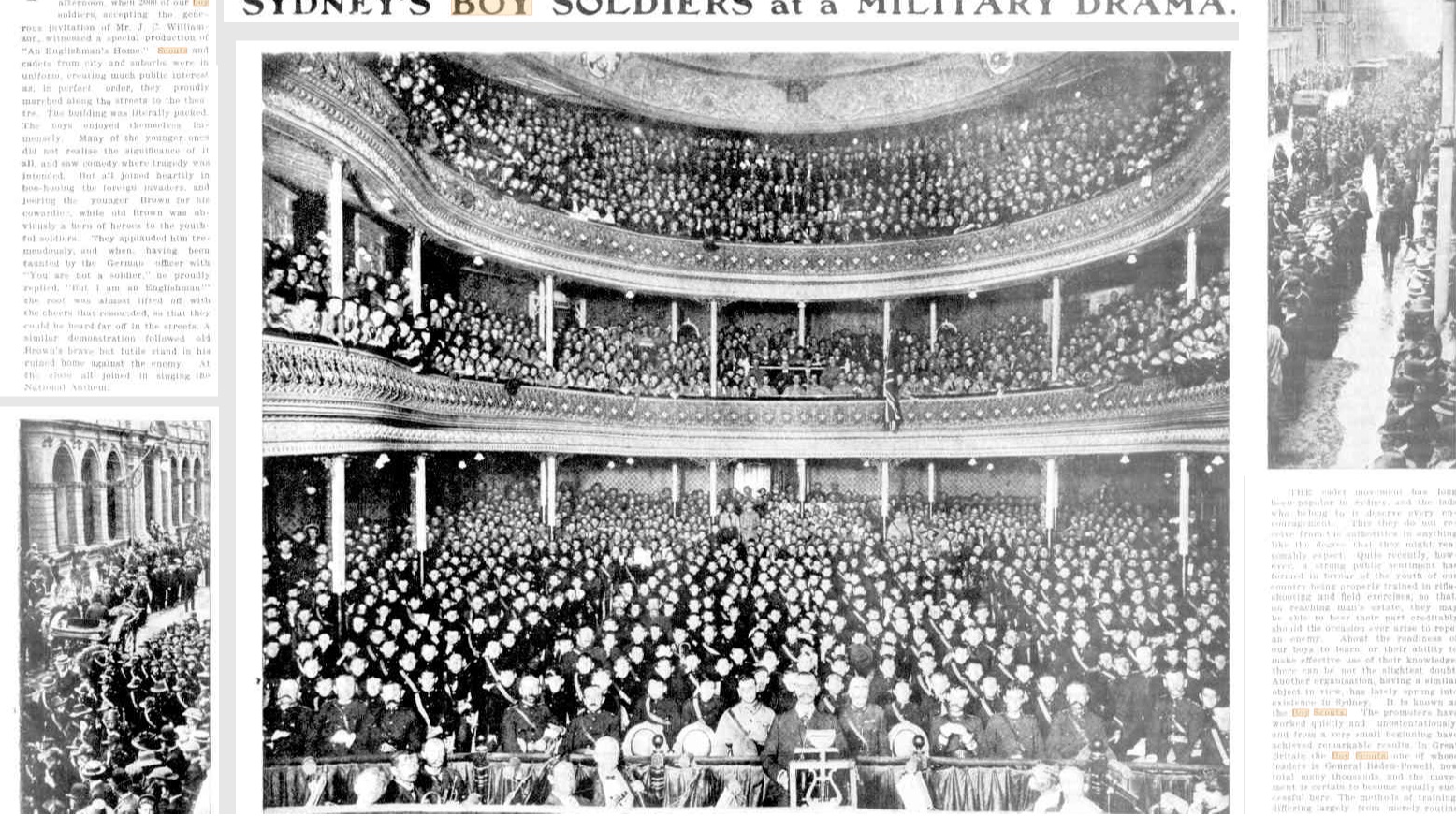
PUBLIC SCHOOL CADETS AND BOY SCOUTS AT A PERFORMANCE OF ' AN ENGLISHMAN'S HOME ' AT THE THEATRE ROYAL.
THE cadet movement has long been popular in Sydney, and the lads who belong to it deserve every encouragement. This they do not receive from the authorities in anything like the degree that they might reasonably expect. Quite recently, however, a strong public sentiment has formed in favour of the youth of our country being properly trained in rifle-shooting and field exercises, so that, on reaching man's estate, they may be able to bear their part creditably should the occasion ever arise to repel an enemy. About the readiness of our boys to learn, or their ability to make effective use of their knowledge, there can be not the slightest doubt. Another organisation, having a similar object in view, has lately sprung into existence in Sydney. It is known as the Boy Scouts. The promoters have worked quietly and unostentatiously, and from a very small beginning have achieved remarkable results. In Great Britain the Boy Scouts, one of whose leaders is General Baden-Powell, now total many thousands, and the movement is certain to become equally successful here. The methods of training, differing largely from merely routine drill, must appeal to Australian youths; and it is gratifying to learn that in Sydney there have been attracted to the ranks scores of lads who were little better than street arabs, and who have already benefited Immensely, both physically and morally, from their association with the Boy Scouts. SYDNEY'S BOY SOLDIERS at a MILITARY DRAMA. (1909, May 5). The Sydney Mail and New South Wales Advertiser (NSW : 1871 - 1912), p. 31. Retrieved from http://nla.gov.au/nla.news-article164294201
THE BOY SCOUTS.
INTERESTING ORGANISATION. ITS GROWTH IN SYDNEY. WHAT THE LADS ARE TAUGHT. MORAL AND PHYSICAL TRAINING.
The Boy Scouts are sufficiently familiar figures in the streets of Sydney to-day as to require little introduction to the public. Their organisation is one of the most remarkable In this, the country of rapid development, and now that Defence, Australian and Imperial, is the leading subject of the hour, it may be interesting to readers to learn, something in detail of the creation of a corns which in 14 months has grown to 1700 strong.
ORIGINATOR OF THE IDEA.
Major-GeneraI Baden-Powell, the hero of Mafeking, originated the idea of the Boy Scouts in England, where it has been taken up with avidity. 'B. P.' published a book, setting out the idea of training boys along the lines of the Red Indian scouts, familiar -to all youngsters who have read Fennimore Cooper's stirring tales of North American enterprise and adventure. The republication of portions of the British officer's volume, and the zeal and enthusiasm of a Sydney journalist, Mr. R. Packer, resulted in the formation, in March of last year, of two patrols of Boy Scouts in this metropolis. Adopting the picturesque proposal to call each patrol by the name of birds or animals, the scouts at Mosman styled themselves 'Kangaroos.' while those at Darlinghurst chose the title of 'Mountain Kings.'
A PROPER ORGANISATION.' The youthful trackers had not been long at work before their example fired the breasts of others, and by October of 1908 there were about half-a-dozen patrols in and around Sydney, and Mr. Packer -was besieged with requests from scores of youngsters who wished to Join the gallant little army. The leader felt, however, that affairs should be on a substantial basis, if permanent success was to be hoped for, and a meeting of citizens was called with that object in view. A number of gentlemen formed themselves into a committee of control, and at once proceeded to draw up a systematic plan of training, arrange for competitions, the discipline of the corps, decide upon the uniform, and take all other requisite steps towards placing the new juvenile force on a firm foundation.
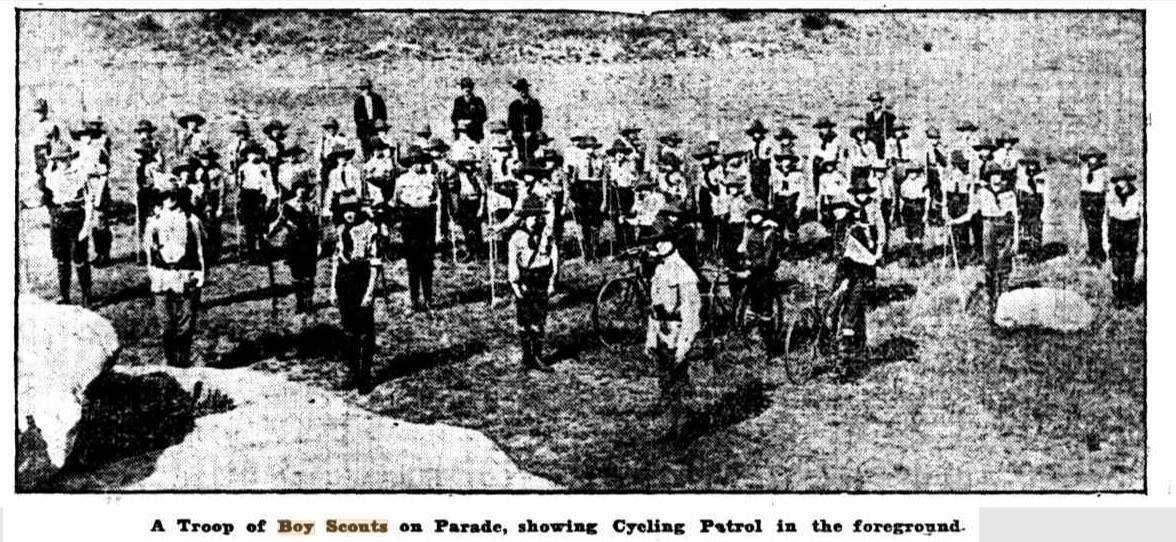
A Troop of Boy Scouts on Parade, showing Cycling Patrol in the foreground
.jpg?timestamp=1606259507829)
Boy Scouts march in Indian File in the Bush, and they are here shown advancing.
.jpg?timestamp=1606259537030)
An Ambulance Party of Three Boy Scouts (one relief) carrying in a wounded Comrade.
.jpg?timestamp=1606259572605)
Ambulance Work is a strong feature with the Boy Scouts. This Picture shows the arrival of a Stretcher Party at the Field Hospital, built of Brush by the Scouts
COMMITTEE OF CONTROL.
His Excellency the Governor-General freely accepted the post of patron of the Scouts (his little son is one of the members of the corps), and Sir Harry Rawson took a similar position for the New South 'Wales sections, while the Premier (Mr. Wade) became president of the Committee of Control. The members of this executive comprise Dr. Lane Mullins. Captain M'Marland. Lieutenant-Colonel Holmes, Mr. Cooper (senior inspector of schools). Major Simpson, Major Dove, Mr. Newton, and other enthusiasts. The Chief Scout Master, who also discharges the duties of hon. secretary, is the founder or the corps, Mr. Packer, and a vast, amount of work has fallen on his capable shoulders.
COMPREHENSIVE PROGRAMME.
A syllabus of classes of instruction, as drawn up by the committee, and already largely in operation, is as follows:—
Scout practice, mapmaking, first aid, life-saving, flag-signalling, Morse alphabet (with the heliograph signal lamps by night, and smoke by day), compass reading, knotting and splicing, hut-bmlding, and camp training. A fairly comprehensive list it will be admitted, and some knowledge of the subjects contained in it will clearly be of value to all boys, whether io warfare or in the piping times of peace. And the best part of the whole scheme is that the lessons arc learned, toe valuable hints and experience acquired, all in the form of play, or something which so closely resembles it as to be miistinguishable. For example, the 'War Game.' one of the most popular of the useful exercises through which the boys are put, is simply 'Prisoners' Base' on an extended scale.
THE FORMATION OF TROOPS.
Patrols of Scouts increased so rapidly that it soon became necessary to form them into Troops, each allotted a certain district. At the end of the year fully 700 boys were enrolled, and at work, and thirteen districts were mapped out for their more systematic training. Each or these was placed under the direction of a Scout Master, usually a military man of experience, whose duty it was, and is, to teach the syllabus of instruction carried out as far as possible. Honorary teachers have not been lacking for most of the subjects, and the progress of the young pupils has been marked. Boys who were regarded rather as dunces in school, have proved the aptest of learners in Nature study, and a youngster who boggled at a simple sum in addition has been known to acquire remarkable proficiency in flag signalling.
SCHEME OF OFFICERING.
When the famous march to 'Cranbrook' was undertaken a couple of months ago, to bid farewell to Sir Harry Rawson, nearly 900 Scouts took part. It was a splendid advertisement of and fon the corps, which has been so rushed since, that the numbers are almost exactly doubled. The districts have been re-, -luc-?d in sfae, the troops increased, and tha cry is 'Still they come'.' The organisation, so well planned at the commencement, has proved equal to the strain. There are now district inspectors, whose business it is to see 4hat the Scouts are receiving their due training in various subjects; and district 'instructors, who go around teaching the Scout Masters, who in turn pass the knowledge on to the patrol leaders — the most Important link in the chain that binds the Boy Scouts together.
PART OF THE PATROL LEADERS.
Even greater and more important than the 'non-coms.' to a regular army, are the patrol leaders to the Boy Scouts. A patrol is composed of six or seven lads. They elect their own leader and a corporal, and to these 'officers' they give implicit obedience and enthusiastic support. The leader has wide powers,' and generally uses them wisely. He is interfered with by scout masters and the committee of control as little as possible, but is encouraged to -work out the scouting salvation of. his devoted little band. That he does it' well is beyond any question. The boys themselves always show keen judgment in electing their leaders; there is in every group of youngsters one who naturally takes command; and some ordinarily' incorrigible youths have been wonderfully tamed by having thrust upon them the responsibilities attaching to leaders of patrols. Needless to say. there is ever at work a healthy spirit of rivalry, which keeps the scores of patrols well up to the mark of efficiency.
AN ECONOMICAL CORPS.
The cost of running this juvenile organisation is practically nil. No one charges for services, the boys' parents provide them with uniforms, costing 10s each, and where halls or rooms for instructional purposes are required, the Scouts contribute a penny a week themselves. In several cases these meeting offices are made available without fee, and possibly when municipal councils and other bodies learn what good training the corps affords, some practical assistance will be given. At present the Boy Scouts hold a record as the most economically-raised and administered quasi-military force ever formed in Australia.
WHAT THE BOYS PROMISE.
'I promise on my honor to be loyal to God and the Sang, to help other people at all times, and to obey the Scout law.' This is the form of oath which every boy takes, and the supporters of the corps aver with truth that it is faithfully carried out, both in letter and spirit. Loyalty to God and to the Sovereign is impressed upon the lads as the first duty of those who aspire to be good citizens, and they endeavor to discharge that duty well. Best of all, however, is the carrying out of the admirable principle of 'helping other people at all times.' All the boys are urged to do at least one good turn for a fellow-being each day, and nine-tenths of them do it. They help their mothers by chopping wood, or doing other household 'chores;' they assist blind persons, old ladies, and little children, in the streets; they are ever ready to run messages for those in authority on the occasion of fires, accidents, or street sensations of any kind. In short, they keep their eyes and ears open for opportunities of making themselves useful, without becoming officious.
MAKING GOOD CITIZENS.
Absolute obedience to the patrol-leader is the chief feature of Scout law, and it is the leader's responsibility that his boys shall live up to their profession. The Scout must neither drink, smoke, nor swear, and prompt expulsion follows upon any breach of this commandment. The members of the control committee assert that they have personal knowledge of the poori effect the moral and physical discipline has upon boys as a whole, and a number of 'hard cases' in particular. Certainly, if 1700 boys are receiving the excellent grounding in good citizenship involved by observance of the oath, the movement has been well worth the effort.
SCOUTS OR CADETS?
There still exists a certain amount of distrust, if not actual jealousy, of the Boy Scouts by those who have interested themselves in strengthening the Cadet Corps. Speaking on this point Mr. Packer, the Chief Scout Master, declares that in no respect are the two movements to be regarded as inimical. 'We have had, and are still having, scores and scores of applications from lads,' he said; 'and we always recommend them to join the Cadets; failing that, to join the Scouts. The popularity of our corps arises largely from the fact that there is less drilling — often monotonous drilling — of the Scouts. Boys get very tired of that sort of thing and especially of having a number of 'bosses,' otherwise officers. Still, when by our methods of training we have managed to steady up the lads, we will urge them to join the Senior Cadets. Our work is preparative to strict military training. It has the additional advantage of developing the powers of observation, of initiative, and of rapid thought and action, besides which it gives the-' boys a knowledge of scouting that must -prove helpful if they are ever called upon to assist in the defence of their country.' The Boy Scout movement is spreading rapidly to the country districts and to the other States. The foundations of corps have been laid in New Zealand and Victoria, and it is thought likely that in 12 months time there will be patrols and troops in all parts of Australasia. THE BOY SCOUTS. (1909, June 5). Evening News (Sydney, NSW : 1869 - 1931), p. 3. Retrieved from http://nla.gov.au/nla.news-article115495999
Developing Australian Patriotism.
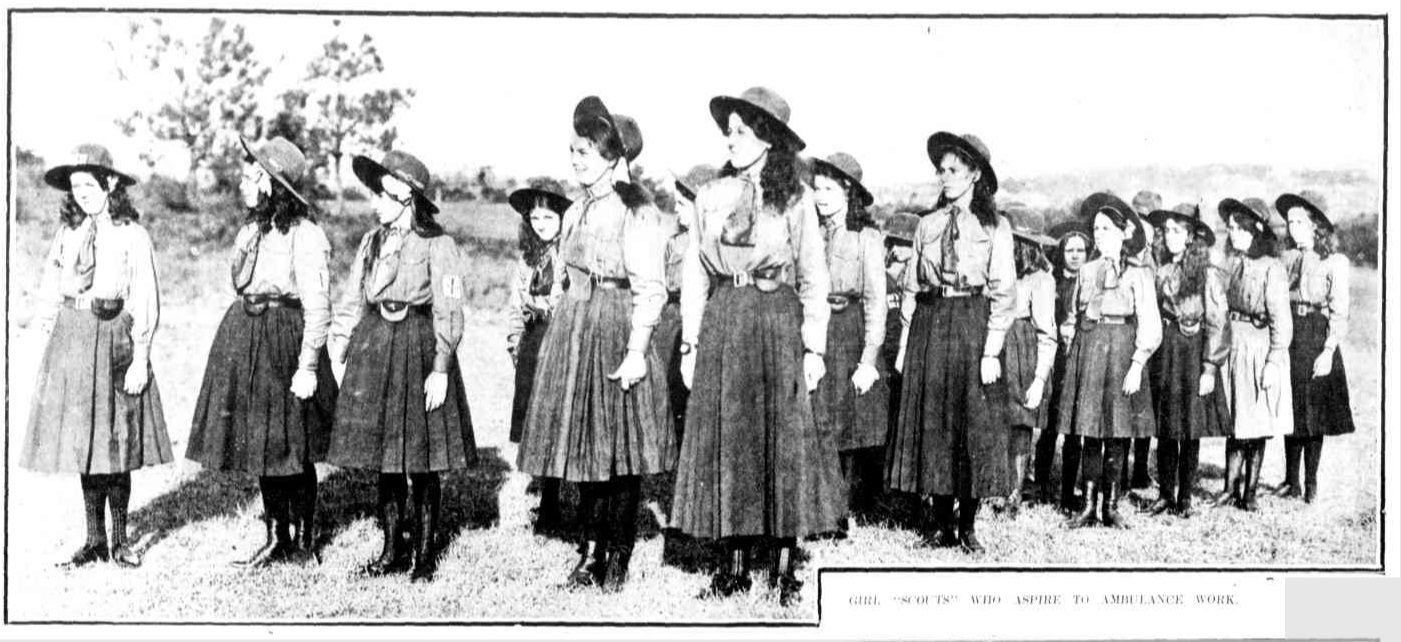
GIRL SCOUTS WHO ASIRE TO AMBULANCE WORK
.jpg?timestamp=1606257468056)
MARCH PAST OF THE BOY SCOUTS AT CENTENNIAL PARK ON SATURDAY, IN THE PRESENCE OF ADMIRAL SIR RICHARD POORE AND THE BRIGADIER-GENERAL GORDON. W P. THE CYCLISTS' CORPS.
ABOUT 2000 metropolitan boy Scouts were reviewed in Centennial Park on Saturday afternoon. They were inspected by Brigadier-General Gordon, C.B., and by Admiral Poore. The stand at the base w&s draped with Union Jacks. To the right stood H.M.S. Challenger's band. Fifty yards or so in front were the State Military Band, the Newtown Model Highland Pipe Band, and the Scouts' Bugle Band; and immediately behind them were grouped the district flags. Behind these again lay the long line of the Scouts, khaki and blue, with the white-jerseyed Mosman boys about the centre. All round the enclosure were scattered onlookers, gathered about the saluting base into a crowd. The girl Scouts were there, too, about 60 of them in blue skirts and khaki blouses, but they took no part in the review. In the march past the Scouts' Band led, the Newtown patrol followed with the league flag, and all the other districts. The district flags remained grouped in the centre of the ground, but each patrol carried its patrol leader's flag, with the patrol badge. There was a whole zooful of these totems; crows, kangaroos, wallabies, peewhits, bears, wolves, and hounds; all worked in black on little triangular white pennants. The boys looked well and healthy, but the size-contrasts were extraordinary. Here you would see amongst a pack of middle-sized youngsters some tiny little chap of 8 or 9, and once there was a big lump of a boy walking in step beside an enthusiastic infant of, say, 7. There were a couple of ambulance stretchers carried, and the rear was brought up by the bicycle patrol. The second march past was in column of fours, in districts. The boys passed closer this time to the stand, and every now and then there was a cry of recognition and a burst of clapping as the most important of patrols went by saluting the base. Then came the advance with flags, the flags leading, and the Scout Band just behind; the pipers played for this. A complicated gridiron movement followed, the flags were marched up opposite the base for the salute, and the spectators stood up for the National Anthem. Both Admiral Poore and Brigadier-General Gordon expressed the pleasure the review had given them, and complimented the growth of the movement and the efficiency of the boys, Brigadier-General Gordon expressed his intention of cabling, with the permission of the Minister for Science, to lieutenant-General Baden-Powell the impression the inspection had made upon him. He was satisfied the Scouts' training would help them to become capable defenders of their country. In a recent issue we described the remarkable growth of the movement, which was started in Sydney by Mr. Packer, a pressman. Developing Australian Patriotism. (1909, July 28). The Sydney Mail and New South Wales Advertiser (NSW : 1871 - 1912), p. 27. Retrieved from http://nla.gov.au/nla.news-article164338527
Baden-Powell Chief Scout's Australian Tour
THE name of Lord Baden-Powell, famous soldier and defender of Mafeking in the Boer War, will always be associated with the Boy Scout movement. Since it was founded by him in Dorsetshire in 1907, with the major aim of training boys to fit them for good citizenship, the Chief Scout has lived to see the fulfilment of his hopes, for to-day the movement has grown to a vast organisation with millions of adherents, not only throughout the British Empire, but in many other parts of the world.
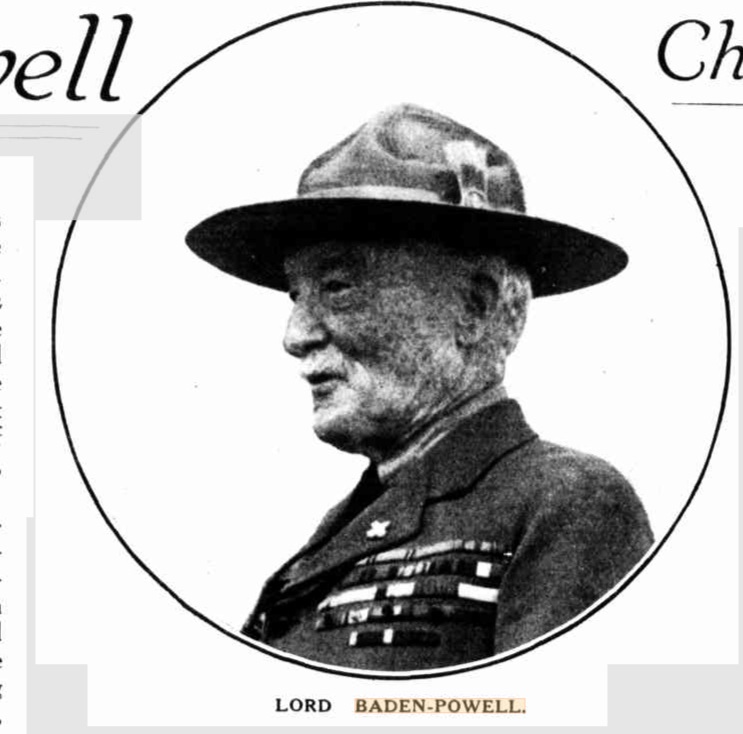
LORD BADEN-POWELL.
The principles upon which the Scout movement is based are set out in the well-known 'Scouting for Boys,' familiar to nearly every lad in Australia. From the national point of view our aim is solely to make the rising generation into good citizens — to develop 'character,' which is more essential than anything else to a lad for making his way in life,' in the words of the founder, sums up the whole of the ideals behind it.
The Chief Scout is not a stranger to Australia. In 1912 , as Lieutenant-General Sir Robert Baden-Powell, he came to Sydney, and was given a tumultuous reception at the Central Railway Station by a crowd described at the time as the largest ever seen at the terminus. Among those who were present to welcome him was Deputy-Chief Scoutmaster Arthur Gray, M.C., who was later killed in the Great War. During his stay in the city Sir Robert held many conferences, and imparted valuable knowledge to the leaders of the movement, which at that time had a membership of about 5000.
THE first Scout group in Australia was formed in June, 1908, shortly after the organisation had been founded in the Mother Country, through the initiative of a Mosman boy, Charles Hope, who had seen active service in the Boer War. Attracted by a copy of 'Scouting for Boys' in a city stationer's window, he purchased it, studied it, and induced some of his friends to co-operate with him in forming the first patrol in Australia — the 'Kangaroo' patrol. Its personnel comprised : Leader, C. Hope ; assistant, A. Jacob; and Scouts N. Hope, R. Shearer, F. Rolls, H. Titchen, R. Middlecoat, and C. Cox. White sweaters and regulation English equipment were worn, and the small body set about the work of training on the lines laid down by the Chief Scout in his book. Badges and patrol-flags were ordered from Scout headquarters, London, and received eventually after a great deal of trouble. Regular parades were held and scouting expeditions and camps arranged. Great interest was aroused by the enthusiasm of the members of the small unit, and little difficulty was experienced in obtaining halls for meeting-places and grounds for drills.
As a result of the successful launching of the Mosman patrol Charlie Hope, afterwards senior scoutmaster, received numerous applications from boys in the city and suburbs wishing to join the movement, and requests for information on matters relating to scouting. He readily agreed to supply all information required, and visited many suburbs, where he explained the principles of scouting and assisted in the formation of patrols. Meanwhile the 'Kangaroos' made good progress, and in competition with other units at later dates annexed many prizes for all-round efficiency and sport contests., The movement grew in popularity, and spread to Balmain, Petersham, and thence to many parts of the State. A patrol was formed in Victoria towards the end of 1 908 ; other States followed suit, and the movement finally spread to New Zealand. So rapid had been its growth that it was considered necessary for the States and the Dominion to form their own headquarters, instead of the organisation being controlled from Sydney.
.jpg?timestamp=1606253092253)
.jpg?timestamp=1606253126351)
MR. CHARLES HOPE As he is to-day. See portrait on opposite side of page. MR. CHARLES HOPE When he formed the first patrol of Boy Scouts in New South Wales.
.jpg?timestamp=1606253166319)
THE FIRST PATROL OF BOY SCOUTS FORMED IN NEW SOUTH WALES (1908). From Left to Right — Back Row: Charles O. Hope, R. Shearer, C. Cox, A. Jacob, H. Titchen. Front Row: N. 'Hope, R. Middlecoat, F. Rolls.
WHEN the Mosman patrol had reached troop strength in a very short period, the Hon. Roderick Ward, son of the then Governor-General, Lord Dudley, joined, and participated in the exercises and scoutcraft. The colours were presented to the troop at Rose Bay by the Governor, Sir Harry Rawson.
Among those who were whole-heartedly behind the Scout movement in its infancy was the late John S. Shearston, superintendent of Royal Naval House, Grosvenor-street, city. In order to encourage the boys in their worthy efforts he permitted them to use the hall for a meeting-place, and placed the gymnasium at their disposal. The greatest interest was taken in the movement in its initial stages by Mr. T. R. Roydhouse, and his advocacy in the press was largely responsible for its rapid growth.
A Council of Control was formed in 1909 and General Holmes appointed hon. secretary. For years the organisation work was carried on by Mr. Roydhouse and his staff, until the present Boy Scouts' Association, New South Wales branch, was formed, and the headquarters later transferred to the Royal Naval House. The name of Mr. A. D. Johnston, ex-Commissioner for the State, will be familiar to all who were associated with scouting in its early stages. Mr. Johnston was the founder of the third (Petersham) troop, and was general secretary of the Scout organisation in New South Wales prior to the formation of the existing controlling body. In 1915 he was appointed Acting-Commissioner, and four years later Commissioner. The latter position he filled till 1924. Arrangements have been made for the members of the first patrol to meet the Chief Scout at the grand review at Rand wick on March 21.
TOWARDS the end of the year 1900 a fund was opened for the purpose of presenting the hero of Mafeking 'with a token of the regard in which he is held by the people of Australia,' in the shape of two chargers and a sword of honour. Mr. Roydhouse was prominently identified with the tribute. Committees were appointed, and horses were paraded at Victoria Barracks. Orara, bred by the late Mr. P. J. O'Donnell, of Mingay station, Coolac, was the first horse selected. The other was a beautiful black gelding, Black Prince. They were heavily insured and despatched to Capetown by the Sussex in October, 1900, in charge of Mr. J. G. Rowley. In a letter to Mr. Rowley, written at Zuurfontein, Transvaal, dated April 28, 1901, Baden-Powell conveyed his thanks for the safe arrival at Capetown of both horses. Owing to the prevalence of horsesickness, he stated, he intended to keep them at Johannesburg, where the climate was healthy for them. It was his intention, when he had a little leisure, to put the bay (Orara) into training, as the animal appeared to have become acclimatised.
Subsequently Baden-Powell took Orara to India and won numerous events in jumping contests and steeplechasing.
THE enthusiasm over the visit of Lord and Lady Baden-Powell has spread right throughout the Scout movement in all the States. For evidence of it in Sydney one has only to see the great numbers of both city and country Scouts moving about the streets. Many come down to welcome the Chief Scout, who was due to arrive from New Zealand yesterday by the steamer Marama, and many more will be in Sydney by the week-end, when they will marshal in their thousands at the Randwick Racecourse.
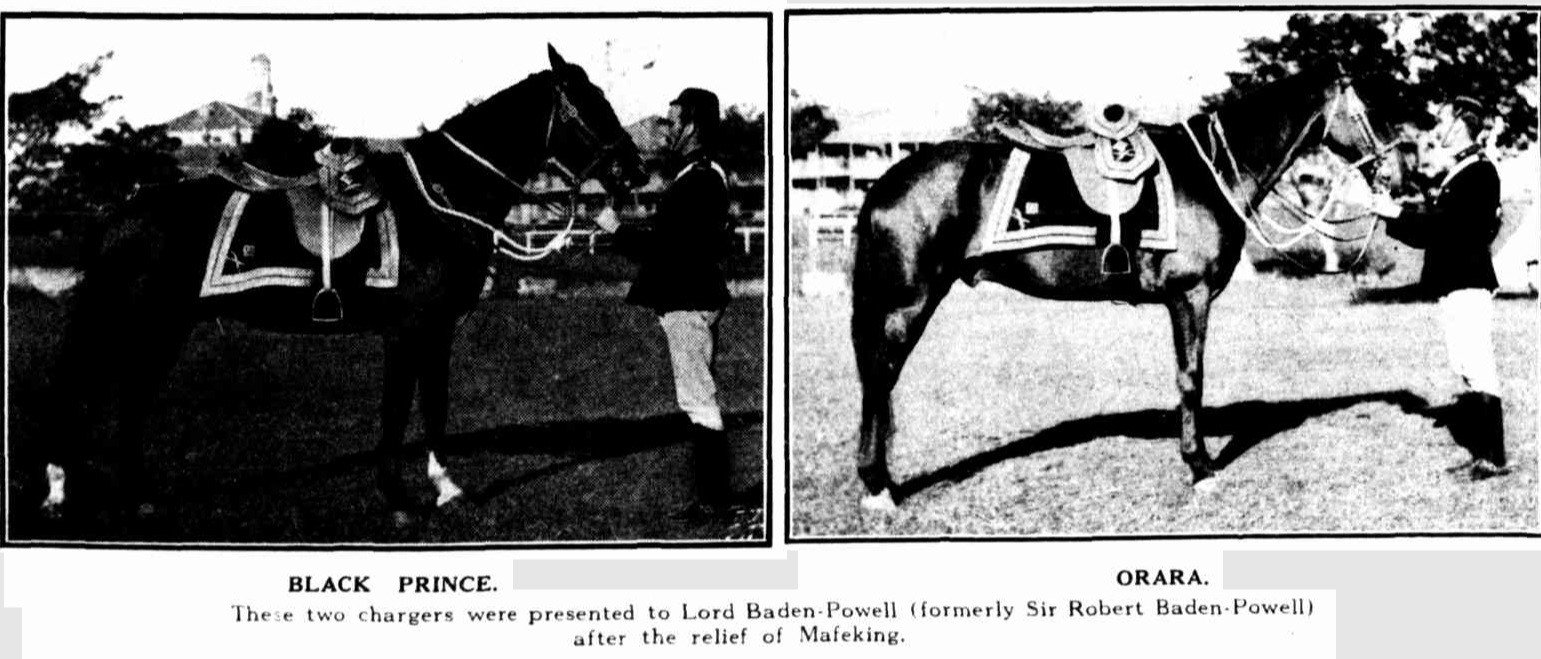
BLACK PRINCE. ORARA. These two chargers were presented to Lord Baden-Powell (formerly Sir Robert Baden-Powell) after the relief of Mafeking.
To-day the schedule includes a visit to the Premier, Mr. Lang, at 11 a.m., and a civic reception at the Town Hall half an hour later. In the afternoon Lady Baden-Powell will be entertained by the Lady Mayoress (Mrs. Joseph Jackson), and in the evening there will be a 'Scouters' tea' at Anthony Horderns' Welfare Hall. To-morrow evening the Governor will give a dinner-party in honour of the visitors, and there will be a reception at Government House at 8.45. On Friday there will be a procession through the city streets, and in the afternoon the senate of the University will confer the degree of Doctor of Laws on his lordship. Saturday will witness the great Scout rally at Randwick Racecourse. On Sunday there will be a combined Scout and Girl Guide service at the Sydney Cricket Ground, and on Monday Lord and Lady Baden-Powell will visit the Scout training camp at Pennant Hills. Baden-Powell (1931, March 18). Sydney Mail (NSW : 1912 - 1938), p. 8. Retrieved from http://nla.gov.au/nla.news-article159790908
Baden-Powell's Chargers.
The chargers and equipments, which are the Australian presentation to the hero of Mafeking were shipped on board the Sussex on Saturday, and, at the invitation of Messrs. Birt and Company (managing agents of the Federal S.N. Company), a large number of citizens visited the vessel to inspect the gifts. The splendid chargers, Orara and Black Prince, are very comfortably housed in the forward part of the ship, where also a large number of other horses intended for military purposes in South Africa are stationed. The horses for Major-General Baden-Powell are in the charge of Mr. J. G. Rowley, who has had very extensive experience in the shipping of horses. They are each Insured for £150, while the saddlery and equipments are insured for £75. The horses are consigned to Sir Alfred Milner, the-High Commissioner in South Africa, who will make the presentation to the Major-General in the presence, if it can be arranged, of some of the Australian troops now in South Africa. There is some delay in forwarding the sword of honor, as the blade is being specially made in England; but that token of esteem will follow in due course. Favorable comment was made by the visitors upon the arrangements for the comfort and safety of the chargers. Australian Town and Country Journal (Sydney, NSW : 1870 - 1907), Saturday 27 October 1900, page 22
A Pioneer of the Eastern Horse Trade.
INTERESTING INTERVIEW WITH MR. J. G. ROWLEY.
Mr. J. G. Rowley, who, at one time, was a constant visitor to the Northern Rivera, and whoso face was as familiar to Grafton citizens as the town clock, has again turned up. To say who Rowley is, what he does, or whence he comes, would indeed be a series of very hard questions to answer. In conversation with a representative of the R. R. Herald, who knows him well, he was asked,
' Well, Joe, where have you been all these years '? Joe drove his hands deep down into breeches pockets, looked reflectively on the ground, and replied —
'Well, really, I don't know. Do you mean since I saw you last in Grafton. Now, that is about 14 years ago. I have been in many countries since, have been in shipwreck, and in war, nearly gaoled in barbarous Russia, and, in between times, have been shipping stock to any country where I saw an opening.'
' Yes, I did remarkably well,' he replied to a question, ' but it was all a bubble, a mere dream, I lost it all again. I started off scratch in the China trade ; did really well — so well that the South Australian Government subsidised Laurie and Holmes against me. Their subsidy was £6000 per annum, but I beat them badly ; but in beating them I beat myself. They retired from the trade with a One fat banking account, and Holmes is now living in a mansion in Yokohama, Although opponents they were fine fellows, were Laurie and Holmes.'
' Would you mind giving the R. R. Herald a short sketch of your travels, say, during the last 12 years — that is, since you were last here ? ' ,
'Not in the least, but I scarcely know where to begin. You know that in '97 I went to England with Sam. Bradbury and a team of 15 jumpers. I worked hard, and I rode hard, for Sam, and we did well. I returned to Australia, but Sam. Bradbury is now an auctioneer at Spitalfields markets. I afterwards made many trips East, but, when the war broke out in South Africa, I, as you may remember, was selected to represent N.S.W. in the matter of the famous presentation to Baden-Powell, the hero of Mafeking — the selection being made from over 500 applicants. I afterwards landed 1778 horses for various owners. I saw the China-Japanese war ; I fought with America against Spain, and also against the Philippines ; I saw the Russo-Japanese war, and, during the progress of that war, I landed the best horses that stand in Japan to-day. For instance, Diplomatic, 2500 guineas. This horse, by St. Simon, was imported from England by Messrs. J. and A. Brown, of coal fame. The Japs bought him, but it was a sin he ever left Australia. He will be the sire of the Japanese horse, as was Lexington the sire of the American turf animal. I also took Glenore, Belltrees, Bruuilo, Haut Gent, Fitzsiuimer, Master Correze, Tethford, and others, over to the land of the chrysanthemum. I am just now enjoying a spell, and shall probably return to China in October.'
'Yes, I shall be about the Richmond for a week or two,' said Mr. Rowley in conclusion, ' but before I leave I shall give you a sketch of the countries I have visited, and some of my experiences therein.' [The first instalment of Mr. Rowley's entertaining reminiscences appears elsewhere this issue.] Pioneer of the Eastern Horse Trade. (1908, August 7). The Richmond River Herald and Northern Districts Advertiser (NSW : 1886 - 1942), p. 9. Retrieved from http://nla.gov.au/nla.news-article127874889
Horses at Manila.
Market Glutted.
Among the passengers by the steamer Chingtu, which arrived here this morning from the east, was Mr. Joseph Rowley, of Denison street, Waverley, Sydney, a well known shipper or horses. Mr. Rowley was bound from Manila, and during the course of conversation said the horse Market at Manila was almost dead. This, no doubt, was due to the glutted state of the market. No less than five shipments of horses turned up almost at the same time. He believed the conversion of the trams to electric traction had a very bad effect on the horse market. Horses at Manila. (1905, April 28). The Telegraph (Brisbane, Qld. : 1872 - 1947), p. 2 (SECOND EDITION). Retrieved from http://nla.gov.au/nla.news-article174664792
It is worth noting that the Sussex carried 250 other horses which had been purchased by the British military. The conflicts in South Africa were obviously great for export trade and it seems that buyers were not fussy about quality. McColl, when he inspected the horses before the Sussex departed, was not impressed and he told the Sydney Mail on 27 October 1900:
‘Roughly speaking two classes were represented, very ordinary gunners and very weedy remounts. There were a few good horses among this lot, but taking them all round they were the very classes which Australian breeders should be glad to get away from their places at any price.’
On Monday 3rd December 1900 Black Prince and Orara arrived in good condition and arrangements were made to present them to General Baden-Powell.
THE BADEN=POWELL CHARGERS.
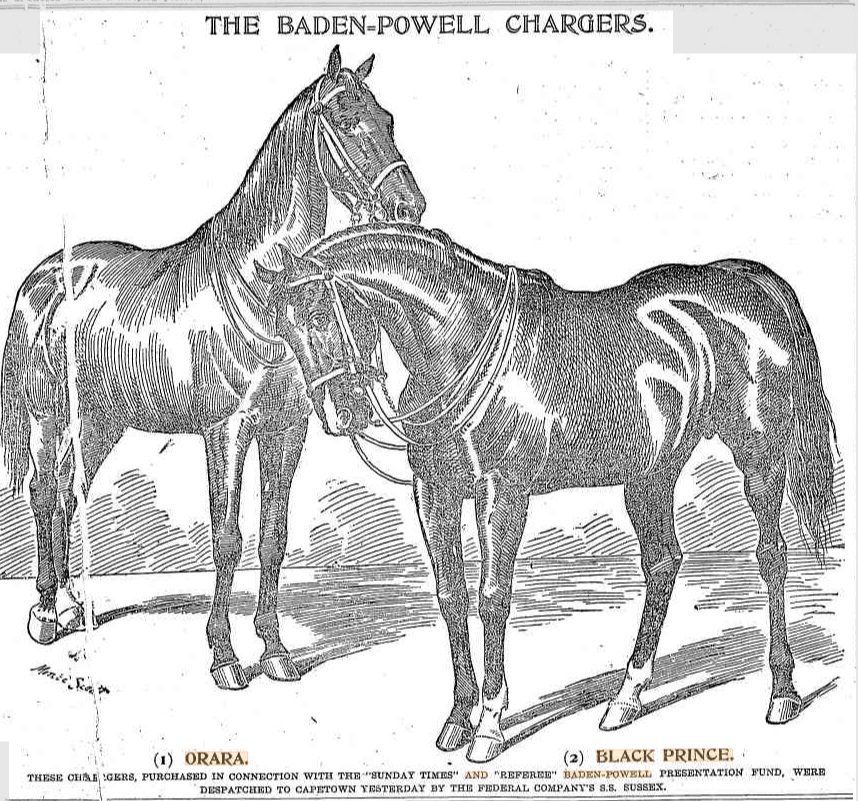
(1) ORARA. . LM (2) BLACK PRINCE.
THESE CHARGERS, PURCHASED IN CONNECTION WITH THE 'SUNDAY TIMES' AND 'REFEREE' BADEN-POWELL PRESENTATION FUND, WERE DESPATCHED TO CAPETOWN YESTERDAY BY THE FEDERAL COMPANY'S S.S. SUSSEX. BADEN-POWELL CHARGERS. (1900, October 21). Sunday Times (Sydney, NSW : 1895 - 1930), p. 8. Retrieved from http://nla.gov.au/nla.news-article126282541
This item from 1910 shows a wariness around Germans persists in the reports, and the word choices used in them, as well as some news on one of these ‘chargers’:
GERMANS INVADE AMERICA.
England is not the only nation that has to fight German competition. From the United States we learn : 'There Is much significance in the recent capture by the Germans of several big contracts in this country. The Rhenish-Westphalian works have contracted to build three more 10,000 horse-power turbines for the Niagara Falls power plant, which will make fifteen in all with a total horse-power of 150,000. Other German firms have obtained orders to build a series of largo coke ovens for the Bethlehem Steel Company. The order Includes 400 ovens with a capacity of 3000 tons a day, and the cost will be about £900,000. GERMANS INVADE AMERICA. (1910, May 22). Sunday Times (Sydney, NSW : 1895 - 1930), p. 17. Retrieved from http://nla.gov.au/nla.news-article123830512
Black Prince later went to England and his life there until he passed away at the age of 30 years. However, one of the photos accompanying this page shows Lord Baden-Powell in full regalia mounted on Black Prince, and this suggests he was involved in much pomp and ceremony. Black Prince became a 'Poster Boy':
BADEN-POWELL'S AUSTRALIAN CHARGER.
After the relief of Mafeking on May 18, 1900, the people of Australia, per-medium of the 'Sunday Times,' raised a fund to present General Baden- Powell with a charger and gold sword of honor. In the end two chargers, Black Prince and Orara, were sent as well as the sword. A picture of Black Prince was received by the last English mail, and a reproduction of it appears on page 19 of this issue. The photograph was taken under specially interesting circumstances, as will be noticed by a perusal of the General's letter accompanying the illustration. BADEN-POWELL'S AUSTRALIAN CHARGER. (1910, May 22). Sunday Times (Sydney, NSW : 1895 - 1930), p. 7. Retrieved from http://nla.gov.au/nla.news-article123830771
BLACK PRINCE.
Lieut.-Gen. Sir R.S.S. Baden-Powell ;writes to the Editor-in-Chief as follows :—
32 Prince's Gate, S.W.,
March 26, 1910.
Dear Mr. Roydhouse.
In case any of the kind donors of my horse, 'Black Prince,' should be interested to hear of him this next anniversary of Mafeking's relief, I enclose his portrait.
I am, as you may know, resigning my army career in order to get more time to devote to the Boy Scouts' organisation, which is fast developing. And the old horse is getting on in years, and his retiring from his army career to an excellent home, which has been provided for him by Miss Lucy Kemp Welch, the celebrated animal painter. I have lent him to her to live in her paddock and stable, and to stand as a model when required— and he will have a very happy, easy going time of it in his old age.
The photo shows him in his new quarters, with Miss Kemp Welch making much of him.
Yours sincerely,
R.S.S. BADEN-POWELL.
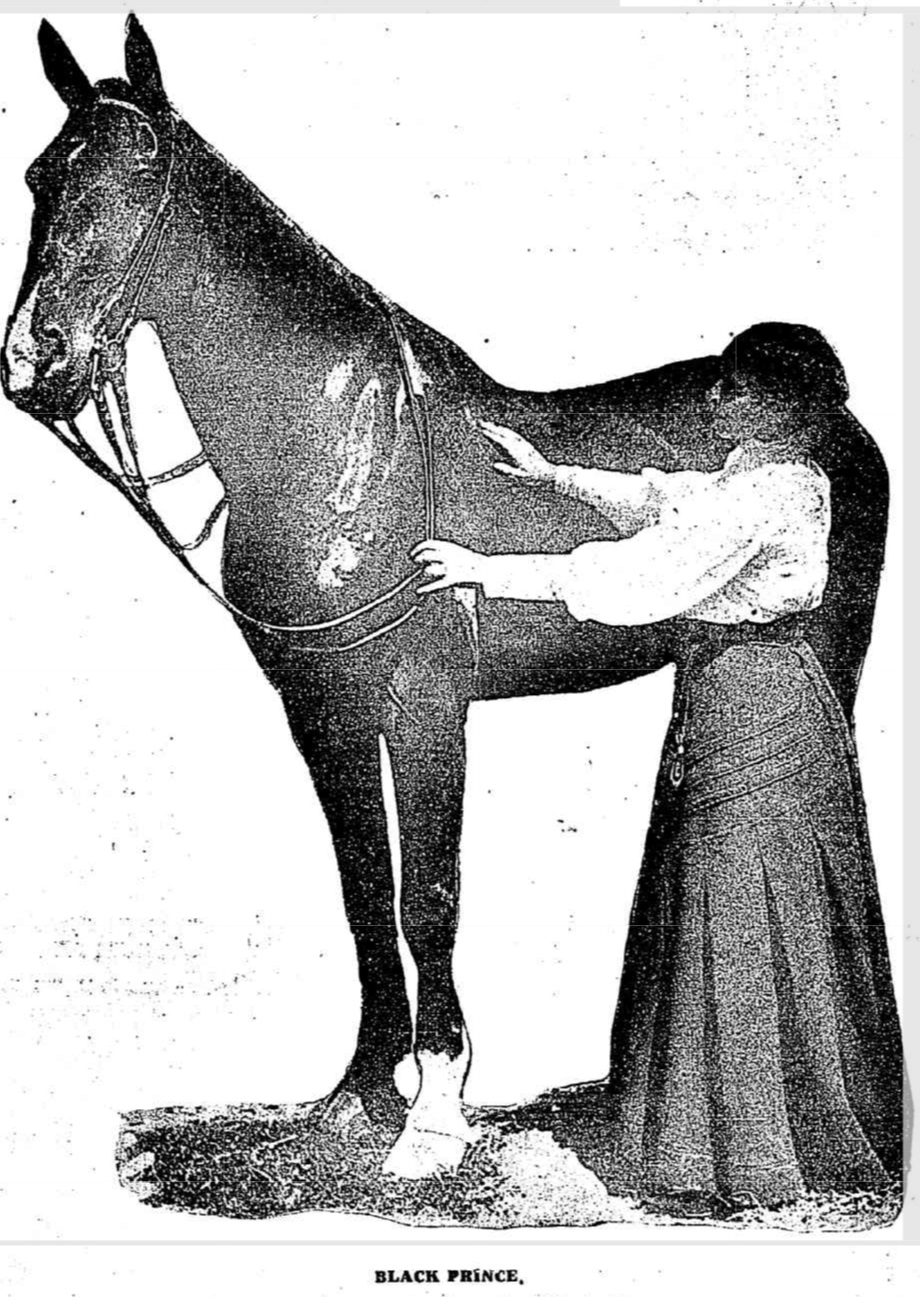
A Changed Horizon (1910, May 22). Sunday Times (Sydney, NSW : 1895 - 1930), p. 19. Retrieved from http://nla.gov.au/nla.news-article123830624
BADEN-POWELL'S CHARGER, Gift Horse Dead.
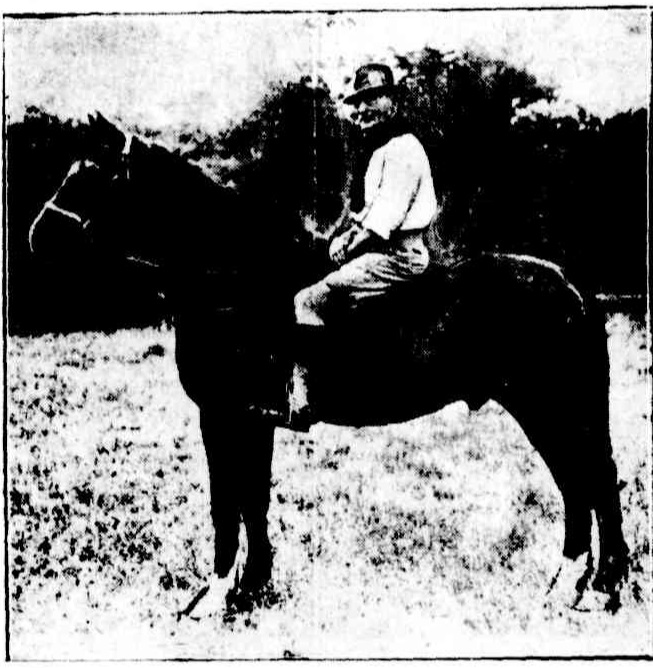
Mr. G. H. Thomas, chairman of the Federal Council of the Boy Scouts' Association has received a letter from Sir Robert Baden-Powell relating to the horses which were presented to him by Victoria and New South Wales, after the South African war.
The Boy Scouts' Association,
25 Buckingham Palace Road,
London. S.W., 1.
My dear Thomas,
After the seige of Mafeking, in the Boer War, in the year 1900, the people of New South Wales and Victoria sent to me in South Africa two fine horses, Black Prince and Orara. Orara died some years ago, but Black Prince has gone on happily ever since until this last week, when one morning we found him lying dead in his stable, having died peacefully of old age. He was aged nearly 30 years. I want to ask if you could help me to make the fact known to the many kind friends in Australia who contributed to providing these horses.
It may interest them to hear that when I could no longer use him as a charger, Black Prince stood as a model in the studio of the celebrated animal painter, Miss Kemp-Welch, and his portrait appears in her great war picture "Forward the Guns." He is the officer's charger in that group.
He has lived in these later years to be the pet of my children, who have all had their first lessons in riding, and horse friendship from old Black Prince.
It was a grief to all of us to lose him-but though he is gone, the kindness and goodwill of the people of Australia who presented him to me will always remain a live and happy memory.
I send herewith a photograph taken only a short while before his death.
Yours truly
(Signed) ROBERT BADEN-POWELL. BADEN-POWELL'S CHARGER. (1924, January 24). The Argus (Melbourne, Vic. : 1848 - 1957), p. 7. Retrieved from http://nla.gov.au/nla.news-article1919865
BADEN-POWELL'S AUSTRALIAN CHARGER.
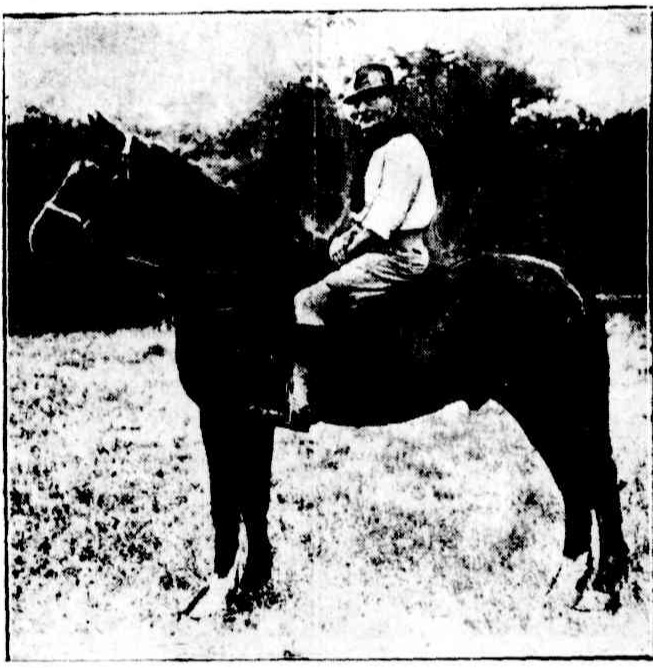
Sir Robert Baden-Powell has advised the chairman of the Federal Council of the Boy Scouts' Association (Mr. G. H. Thomas) that Black Prince one of two chargers presented to him by oitlzens of Victoria and New South Wales after the siege of Mafeking in 1900, has just died in his stable at the ripe old age of 30 years. Sir Robert is shown on Black Prince, who in his later years was a children's pet. BADEN-POWELL'S AUSTRALIAN CHARGER. (1924, January 24). The Argus (Melbourne, Vic. : 1848 - 1957), p. 7. Retrieved from http://nla.gov.au/nla.news-article1919888
Lucy Elizabeth Kemp-Welch (20 June 1869 – 27 November 1958) was a British painter and teacher who specialised in painting working horses. She is best known for the paintings of horses in military service she produced during World War One and for her illustrations to the 1915 edition of Anna Sewell's Black Beauty. In December 1914, Kemp-Welch was engaged by the British Parliamentary Recruiting Committee to paint the artwork for the famous army recruitment poster, Forward! Forward to Victory Enlist Now which she signed, 'L.K.W 1914.'
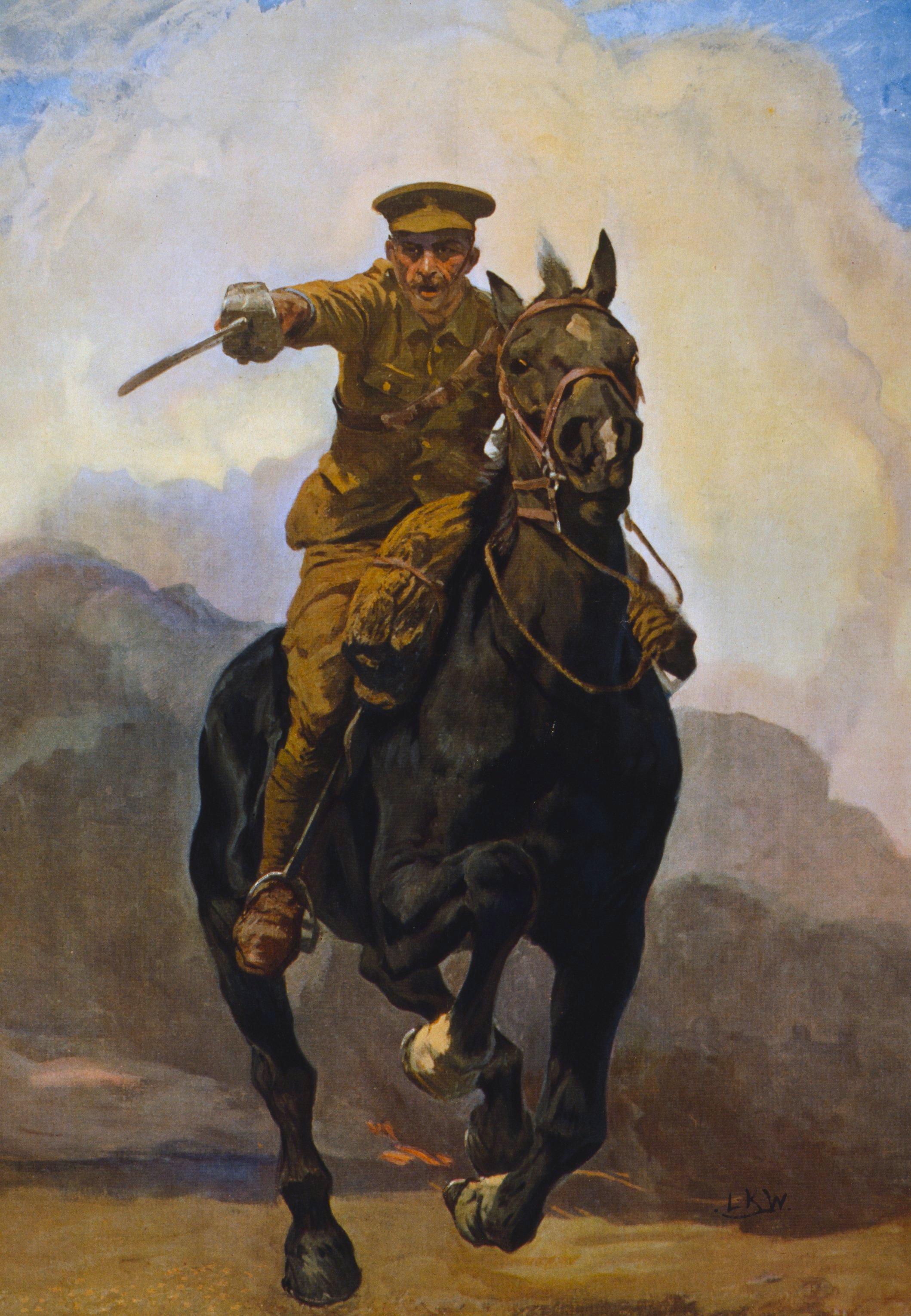
Forward! Forward to Victory Enlist Now which she signed, 'L.K.W 1914.' - reported as Black Prince being used as the model for this work
During World War One women were employed at Army Remount Depots in training and preparing horses for military service. Kemp-Welch was commissioned by the Women's Work Section of the Imperial War Museum to paint a scene at the largest such depot, one staffed entirely by women, at Russley Park in Wiltshire. The Museum authorities were unhappy with the painting, The Ladies Army Remount Depot, Russley Park, Wiltshire which Kemp-Welch first submitted but were aware of a larger and much better composition on the same subject that she had painted and intended to sell to a private client for £1,000. Kemp-Welch agreed that the second painting, The Straw-Ride- Russley Park, Remount Dep't Wiltshire was the better of the two and agreed to sell it to the IWM to forefill her commission. However she was unable to agree a fee with the Women's Work Section and after protracted discussions, donated it free of charge to the Museum.
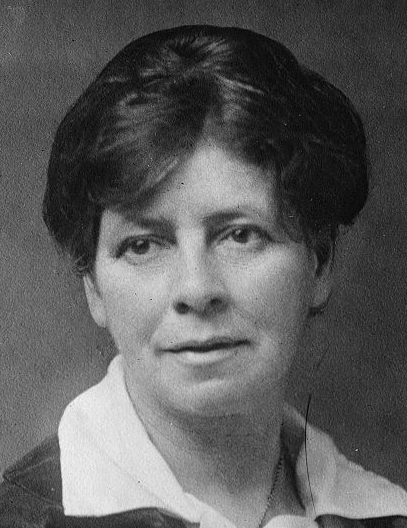
English painter Lucy Kemp-Welch (1869–1958) from George Grantham Bain Collection (Library of Congress) - This image is available from the United States Library of Congress's Prints and Photographs division under the digital ID ggbain.36847.
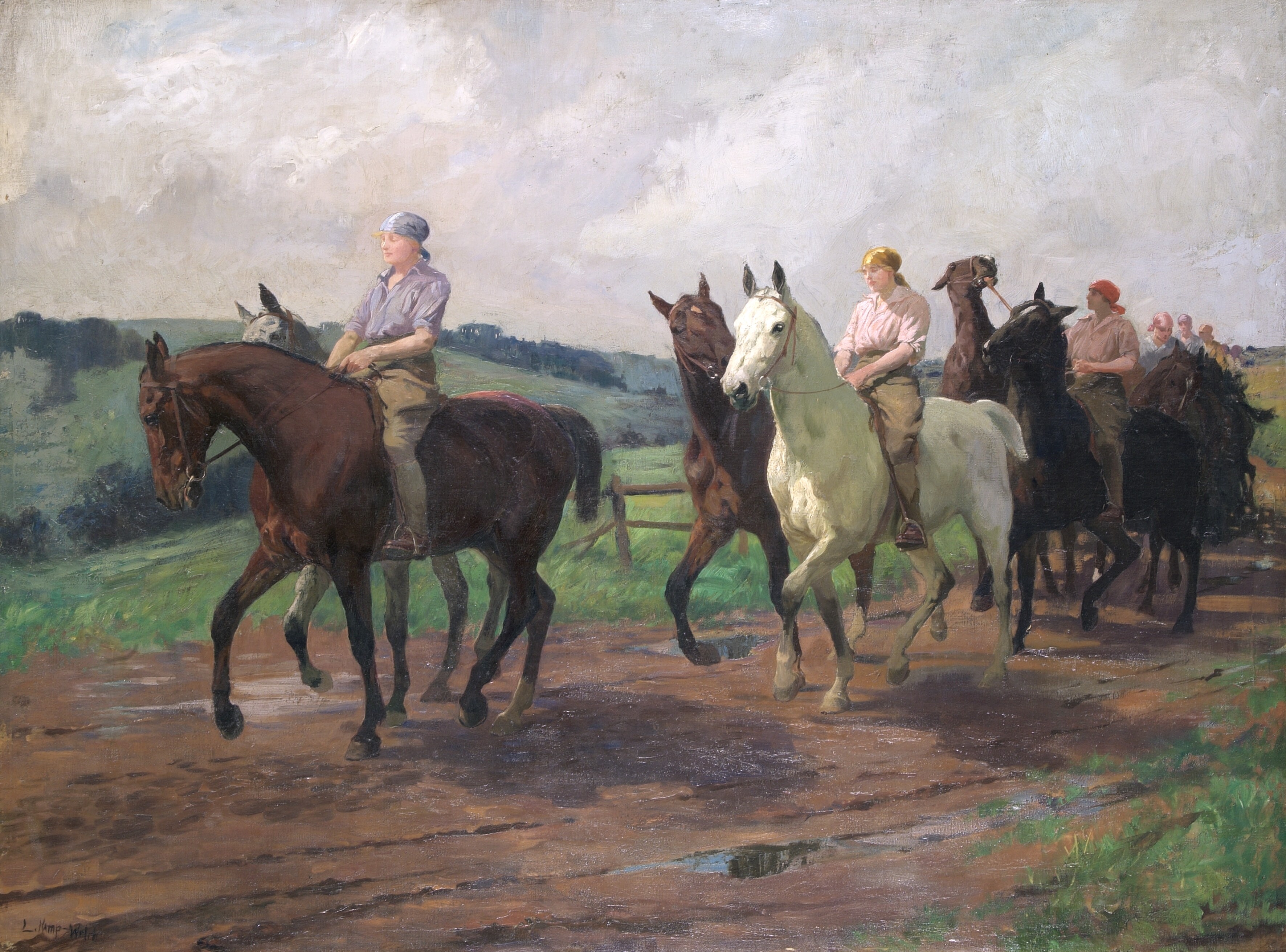
The Ladies' Army Remount Dep't, Russley Park, Wiltshire, (1918) (Art.IWM ART 3094)
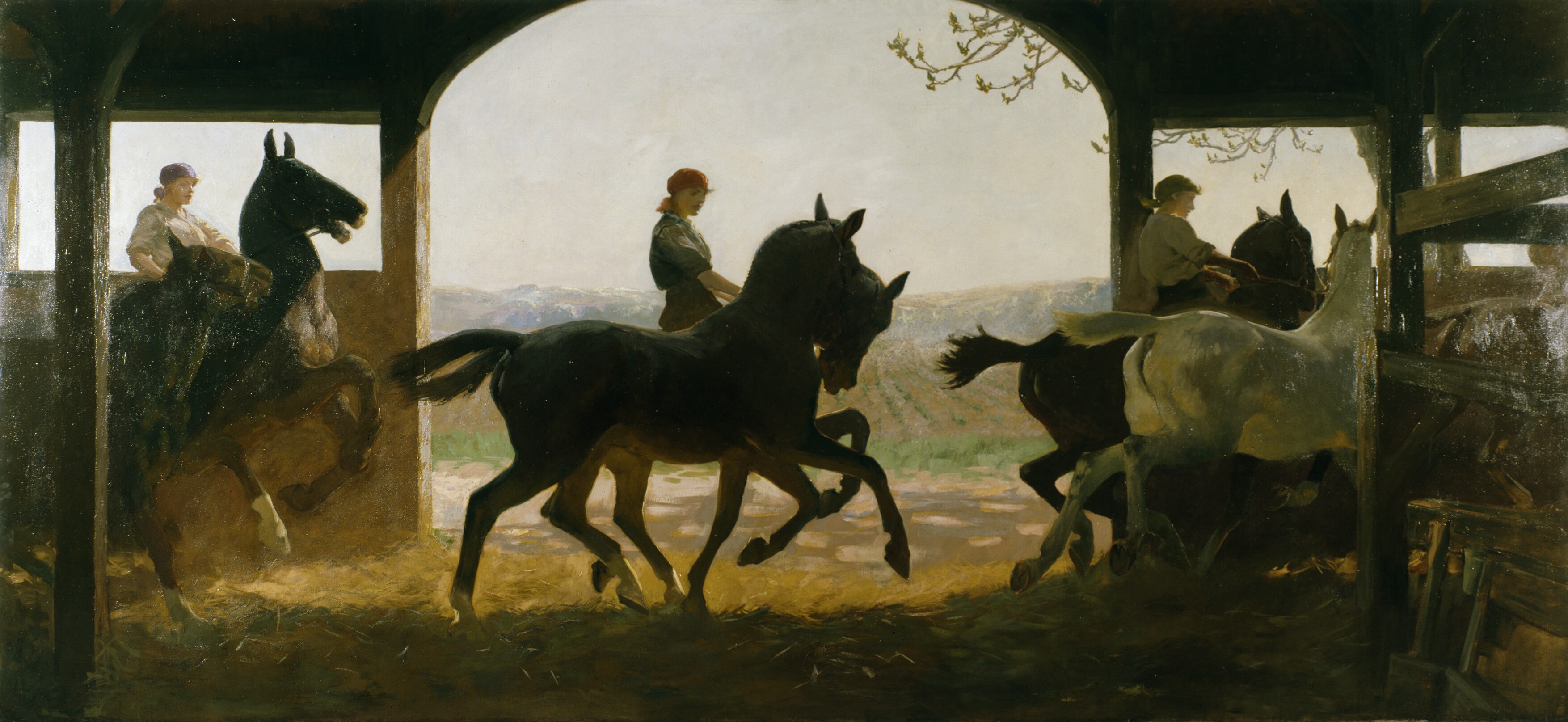
The Straw Ride- Russley Park Remount Dep't, Wiltshire (Art.IWM ART3160)
From Lucy Kemp-Welch - http://media.iwm.org.uk/iwm/mediaLib//179/media-179826/large.jpg This is photograph Art.IWM ART 3160 from the collections of the Imperial War Museums.
In 1924, for the Royal Exchange, Kemp-Welch designed and completed a large panel commemorating the work of women during World War One. From 1926 onwards she focussed on depicting scenes of gypsy and circus life and spent several summers following Sanger's Circus, recording the horses.
She resided in Bushey, Hertfordshire for most of her life and a major collection of her works is in Bushey Museum. They include very large paintings of wild ponies on Exmoor, galloping polo ponies, the last horse-launched lifeboat being pulled into a boiling sea, heavy working horses pulling felled timber and hard-working farm horses trudging home at the end of the day. The Lucy Kemp-Welch estate has been represented by Messum's Fine Art since 1975.
Her younger sister Edith, who died in 1941, was also an artist as was her cousin Margaret Kemp-Welch (1874–1968). Like her sister, Edith Kemp-Welch also produced a poster for the British war effort, an image of Britannia with the slogan "Remember Scarborough".
___________________________________________________________________________________________________
GIRL SCOUTS.
The boy scout has evidently come to stay, and has already become a national feature in the life of most corners of the British Empire, and we take it that on the ground of popularising an open-air life and of encouraging alertness and the exercise of individual intelligence, there can at the present day be very few opponents to the scheme. Such a unanimous point of view, however, is by no means the case with regard to the girl scouts who are now being enlisted under Sir R. Baden-Powell's scheme. There is no doubt that in the abstract it is an excellent thing to train our women in all that may tend to turn their special capabilities to the best advantage in time of war, and un-questionably, in these days of athletic womanhood, their services could be extended far beyond that of the army nurse pure and simple.
To be accurate, this new corps is described as "girl guides," and among other things they are to be taught to trace the wounded, to send messages, to tie up wounds temporarily, to make stretchers, to cook, and to nurse. There is no doubt that were England to be invaded women would play an immensely important part in such a war, and even more so would this be the case in the event of the invasion of any outlying parts of the Empire. Thus the training now suggested should in itself be a good and important thing. The only difficulty, and this is a great one, is the finding of the best means of putting it into effect satisfactorily. As at present organised the administration of the various companies of the girl guides is to be carried on locally by committees of ladies and each company is to be divided up into patrols of eight girls under a scout mistress or "captain." This officer must be over 21 years of age, and the rank and file are to be from 12 to 16 years old. The uniform is to be a navy blue skirt, jersey, and tam-o'-shanter, and no fancy costumes are to be allowed. The chief objection raised by the critics of this scheme is that, while it may be a good thing to let our boys loose all over the country more or less on their own account, this same policy does not necessarily apply as satisfactorily to the girls. This movement, however, is in its infancy at the present, and as the girl scouts seem to be every bit as keen as the boys, it is probable that a satisfactory solution will come of it in one form or another. GIRL SCOUTS. (1910, January 26). Examiner (Launceston, Tas. : 1900 - 1954), p. 7 (DAILY). Retrieved from http://nla.gov.au/nla.news-article50403896
BRITISH BOY SCOUTS.
AUSTRALIAN DIVISION.
President, Sir Francis Vane; Commonwealth patron, H E the Governor General (Lord Dudley) Australian president, D McDonald, chief commissioner for Australia, J. R. Coory; head office and council chamber, 44, Cowra Chambers, Grenfell street, secretary. N. H. Morphett, 81 Waymouth street, press department, employment advice, and intelligence office, headquarters, 7 Payneham-road. East Adelaide
THE BB.S. UNIFORM.
In reply to several correspondents we publish the following details relative to uniforms:
All BBS wear the same uniform, to ensure uniformity in appearance when on parade. The following is a list of the official equipment made to scaled samples, which are at headquarters -
Hat-Khaki felt, flat wide brim, with band round crown, and adjustable chin strap.
Shirt-Khaki drill, two military pockets, shoulder straps, and brass buttons.
Knickers-navy blue, two side pockets
Haversack-khaki, with adjustable strap. Belt-Brown leather.
Stockings-Black. folded below the knee
Ties- 1 ½ inches wide, worn in a sailor's knot under the collar of shirt, the color to be the same as the patrol color.
Neckerchief-Navy Blue. 30-in square, for use ii cold weather, or at order of S M
Staff-stout ash.
The following accessories are useful, viz. -Knives, whistles, lanyards, axes, money, pouches, axe pouches, coat straps, knife sheaths, swagger canes, and water bottles.
The correct articles are supplied through headquarters only.
A NEW DEPARTMENT,
Employment, Advice, and Intelligence Office
The BBS organisation must keep up with the times, and we realise that unless B boys' organisations can cope with every side of a boy's life it will meet with much that is akin to failure The objects of our new department, which by the way, will be conducted personally and by post at headquarters, are as follows –
1 To find suitable employment for boys requiring situations, to assist employers in obtaining satisfactory boys, to help boys to improve their present positions, to assist country boys to find town situations, and vice versa.
2. To advise boys on all matters relating to or of interest to themselves A staff of experts will assist in answering enquiries. Any and every subject will be dealt with. Our advisory staff consists of leading business and professional gentle men, first-class athletes, artisans, kc, kc
3. To assist parents and guardians in dealing with wayward and difficult boys. The office is at the service of all boys, whether scouts or not. No charge is made. Enquiries by post must enclose stamp for reply. Personal enquiries may be made any evening from 7 to 9.
DUTIES OF SCOUTMASTERS
The company commander or scoutmaster shall represent his company on the local committee, and be responsible for the scout training and discipline within his company. He will see that the educational side of the movement be understood by the parents and friends of the boys, and that the scouts themselves realise that they form part of a chivalry, the principles of which are self improvement, both mental and physical responsibility in their duties as citizens outside their own personal interests.
The best scoutmaster is he who brings what is best and noblest out of his young comrades, and this may be done in many ways, perhaps the best of which is through inducing the same of collective and individual responsibility, and that honorable and adventurous knight-errantry which compels the scout to seek his excitement in finding useful work to perform. The S.M. will be responsible for all contributions from the scouts, and for the supply of uniforms, and he will, within his command m all matters specially affecting the company, act as far as possible with the advice and assistance of a court of honor, composed of the non commissioned officers
HEADQUARTFRS JIU-JITSU CLASS.
This class is making splendid progress under the able instruction of Professor Hill, and there was a good attendance on Friday night, when the instructor explained and illustrated attack and defence in jiu jitsu to a number of lads and young men who were present as spectators The boys of the headquarters company earned out the vinous grips and throws exceedingly well, and onlookers were much surprised to learn that, so efficient, they had only received three lessons. The class will make its first public appearance in a jiu jitsu display at the Central Hall next month, where it has been specially engaged. There are still vacancies for a few boys from 13 to 16 years of age, but boys wishing to learn this useful art should apply early, as the class membership must necessarily be limited. Scouts from other companies wishing to learn jiu jitsu under Professor Hill should send in early application through their scoutmasters
RECRUITING COMPETITION
This is our special recruiting month. The blooming; of the wattle reminds us that summer will soon be here, and with it will come the days that seem specially ordered for the work of the boy scouts. Inter-company competitions in dispatching, running, stalking, scouting etc, will be on the programme while boating, exploring, camping hut and bridge building will also be practiced. Swimming will be practised and taught, also life-saving, and in all probability aquatic sports will be held. Let us then increase our membership now that the essential rudiments of scout craft may be learnt before we take the field
Here are particulars -
1 What You Have to Do- Form a patrol of not less than eight boys who must all be over 10 years of age. Send to headquarters for registration forms and register your patrol as B B S comrades.
2. What We Will Do for You – When you have sent in jour registration form you will be gazetted sergeant of your patrol and will have the right to choose your own corporal. Should you enrol two patrols before the competition closes on August 31 a handsome book will be sent to you from headquarters in recognition of your services. Upon being gazetted sergeant you will have the right to sign the letters Sgt B B S , - Co’ after jour name, as T Brown Sgt BBS 14th Co.
PATH FINDING
The majority of lads hare a good sense of direction which can with a little practice, be much developed, and will be found most useful in all stages of life, In order to develop this sense a map should be used, and instead of asking your way, study the map, well observing the places you are leaving on your right and left, and noticing as you go along landmarks, such as churches, inns, farm buildings, &c.
Look back frequently, and observe how your re-turn Journey will appear. If you will be returning by night when it will be dark, try to commit to memory the landmarks which will show themselves against the sky. Church spires, factory, chimneys, and high buildings can usually be seen even on fairly dark nights.
Carry with you a pocket compass, and practice using it in connection with your map. On departing on a travel it is advisable to depart from some landmark from which you can correct your bearings later on. When your first landmark is out of sight, choose another, studying the relation of direction it bears towards the first one.
AN APPEAL FROM THE HEADQUARTERS.
No one who has had any insight into our B.B.S. work will deny for a moment that it deserves the sympathy and support of the public. It is a movement capable of doing more real good. At present the boys' headquarters is sadly handicapped for funds. Improvements are needed which must be carried out at once, but 'cannot be unless more assistance is obtained. The boys' subscriptions are only 1/ per month, or 3/ per quarter for each boy, and outside of this our sole income consists of sundry donations. More indoor games are sadly needed, as are books and maga-zines, one or two more tables, crockery for the coffee stall, tents, and camping outfits, and a host of other really necessary thing*. We appeal to our friends to help us. A few pounds only will be sufficient to supply the equipment needed, and make the required alterations.
ANOTHER CITY COMPANY.
We are pleased to hear that another company in Adelaide has decided to march under B.B.S. colors. Our special recruiting month has begun well. From news to hand we learn that this company has two full patrols, and is forming a third. It has secured a good hall for meeting, and is conducted by an efficient and enthusiastic scoutmaster.
HAMLET BRIDGE COMRADES.
The deputy-commissioner received this week an interesting and encouraging letter from Sergeant S. W. Tamblyn, of Company IT, Hamley Bridge, he reports that the company is getting splendidly to work, and that two more comrades were enrolled at their last meeting. Boys from the surrounding district might find it profitable to visit Sergeant Tamblyn's company, and then extend the B.B.S.
OUR WEEKLY BUDGET.
Country correspondents should see that reports for publication reach headquarters not later than Saturday of each week. The official press correspondent will be pleased to receive B.B.S news from all ever Australia.
PUBLIC WARNING.
We are again compelled to warn the public against encouraging any person collecting on behalf of the British Boy Scouts. No one is authorised to do so.
Sunday evening services are held regularly at headquarters, which are attended by young and old. It is with much regret that we learn that Scoutmaster Chaplain Rev. E. J. Drummond has been absent for the past two Sundays on account of the serious illness of his children. Both he and Mrs. Drummond have been much missed. Services have been conducted by the workers during the chaplain's absence.
HEADQUARTERS MAILBAG.
"W-N.," Truro.-L Cannot get our manual until more arrive from London. 2. You are not old enough for Imperial Scout Corps. Why not join B.B.S. You could form a patrol yourself. BRITISH BOY SCOUTS. (1910, August 10). The Advertiser (Adelaide, SA : 1889 - 1931), p. 17. Retrieved from http://nla.gov.au/nla.news-article5220695
No. 1 District — Mosman and Neutral Bay (also Manly temporarily), bounded by a line from Milson's Point Wharf to the Suspension Bridge. Senior scout-master; Hope. METROPOLITAN DISTRICT ORGANISATION. (1909, January 24). Sunday Times (Sydney, NSW : 1895 - 1930), p. 3 (The Sunday Times MAGAZING SECTION). Retrieved from http://nla.gov.au/nla.news-article126575873
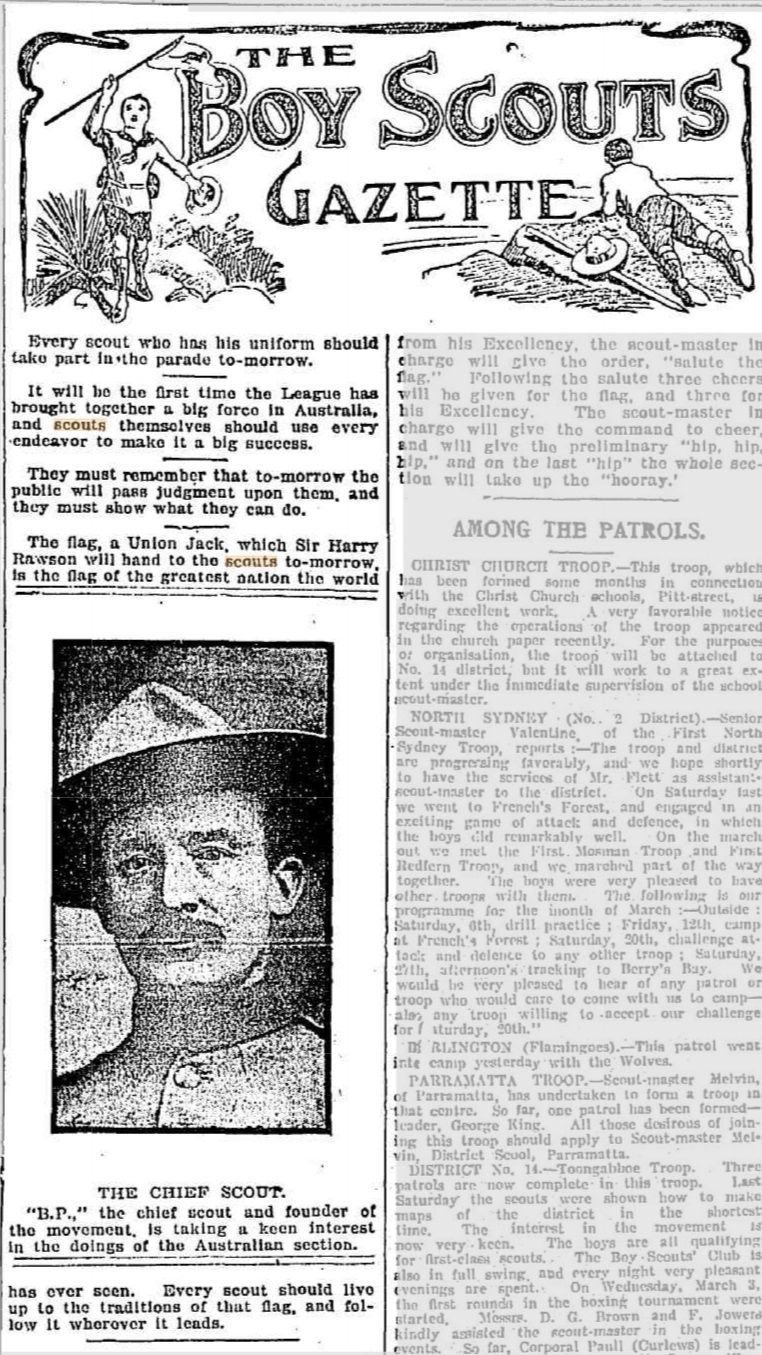
Sunday Time Scouts page from 07 Mar 1909 - THE BOY SCOUTS GAZETTE - Trove - showing cover of Baden-Powell's book was used as Illustration Header for the page
Recruiting Office
No.: 1 District. Scouts in Mosman or Manly desiring to form or join a Patrol should apply to Senior Scout-Master C. Hope, Shadforth -street, Mosman. Or Box 444, G.P.O. Sydney. Neutral Bay – Recruits wanted for Neutral Bay 1st Troop. Apply to A. SM R. Penley, 262 Military Road, Neutral Bay, or Patrol-Leader M. Druitt, Falcon-street, North Sydney. RECRUITING OFFICE. (1909, May 9). Sunday Times (Sydney, NSW : 1895 - 1930), p. 3 (The Sunday Times MAGAZING SECTION). Retrieved from http://nla.gov.au/nla.news-article126596939
AMONG THE PATROLS.
No. 1 DISTRICT.
S.S.M. Hope reports that the 1st Mosman Troop went into camp at the Manly Waterworks, for three days, last week. The scouts in camp numbered 42, and the time was spent in general scout work. The heavy weather interfered with the original programme, but the period under canvas was thoroughly enjoyed. AMONG THE PATROLS. (1909, October 10). Sunday Times (Sydney, NSW : 1895 - 1930), p. 15. Retrieved from http://nla.gov.au/nla.news-article126584416
JUNIOR RED CROSS DELEGATES IN CAMP AT MONA VALE
Twenty-five boys from metropolitan Junior Red Cross circles and teenage-clubs were in camp at Mona Vale from May 10 to May 17. THEIR ages ranged from eight to thirteen, and they were delegates from their local clubs. They will instruct their club members in many of the activities which they learnt at camp.
During handicraft periods they made plaited leather belts, watch-bands, horse-whips, and change purses. Knives and small ornaments were made from perspex, and there were also lessons in bookbinding. An International Display, a collection of photographs and magazines from U.S.A., Great Britain and Russia showed many of the handicrafts of these countries.
Daily chores included wardroom duty, setting and clearing the tables, stoking and lighting the fires, and peeling vegetables, washing-up and tidying the rooms. These were done to the tune of general recorded music sessions.
Boys were elected from various groups to the camp Council. These members discussed any breach of behaviour, and decided punishment for any offences. The camp was a self-governing community.
The boys had a full week. In addition to handicrafts and Nature study periods, they enjoyed an all day hike, a scavenger hunt, a paper chase, a concert, at which each group performed a film and a slides night, a picnic, a fish fry, a banquet, a marshmallow toast and a sports' day.
Gymea Bay delegates won most of the events at the sports' day. Sixteen-year-old Hugh Casey carried off the honours for throwing the cricket ball and putting the shot. He was also a member of the team that won the senior relay race. Brian Penny won the cannon ball throw, the senior hop, step and jump, and was second in putting the shot and throwing the cricket ball.
Geoff Fallow (14), of Mosman, won the 75 yards camp championship sprint and was third in the junior putting the shot, and with Noel O'Brien, Rick Kemp and Brian Cassel won the junior relay.
John Wordsworth (12), of Beecroft, won the junior putting the shot and the hop, step and jump. He came third in the junior 75 yards race.
Miss Finetta Norton, Youth Leader of the Junior Red Cross in N.S.W., organised the camp.
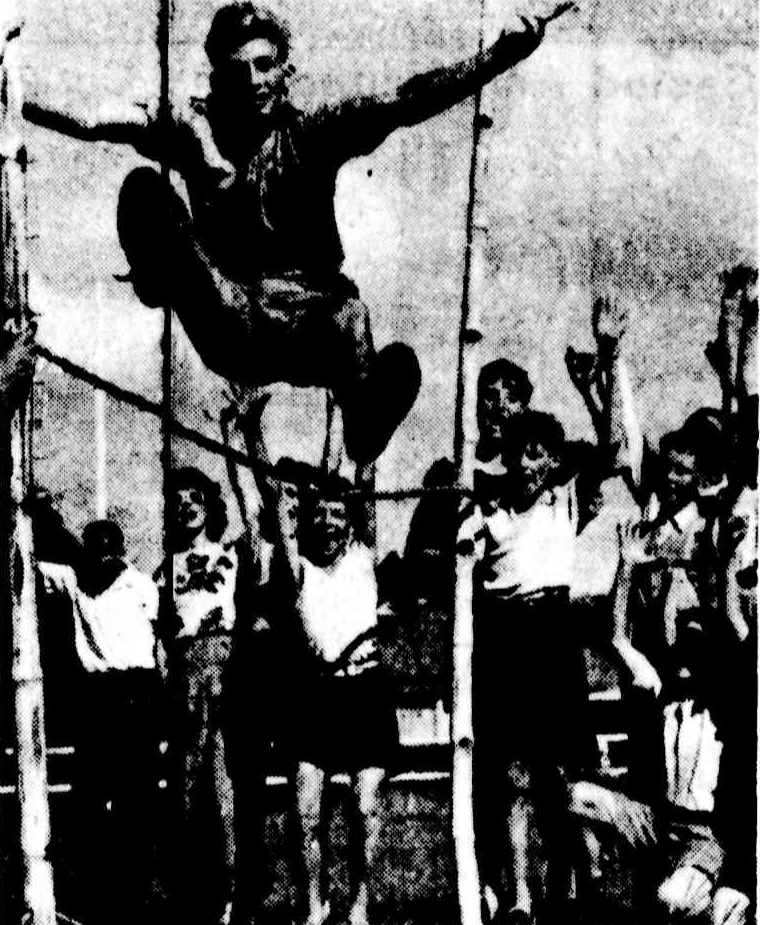
Onlookers cheer Hugh Casey, of Gymea Bay, as he clears the 5ft hurdle.
JUNIOR RED CROSS DELEGATES IN CAMP AT MONA VALE (1947, May 21). The Sydney Morning Herald (NSW : 1842 - 1954), p. 4 (Playtime). Retrieved from http://nla.gov.au/nla.news-article27900032
William Henry Cory Allison
Born in 1886 in Newcastle: ALLISON WILLIAM H C 999999/1886 D188602525 GEORGE D LOUISA E
Death: ALLISON WILLIAM HENRY C 1578/1953 GEORGE DUNCAN LOUISE NORTH SYDNEY
Father’s death: ALLISON GEORGE DUNCAN 3721/1944 parents: JOHN HELEN GERIOCH MOSMAN
ALLISON.—March 9, 1944, at a private rest home, Mosman, George Duncan Allison, beloved husband of Louisa Elston Allison (deceased), late of West Street, Balgowlah, and loving father of Billy, Les. (deceased), father-in-law of Gwen, and grandfather of George and Irene. Privately interred, Rookwood, March 10, 1944. Family Notices (1944, March 13). The Sydney Morning Herald (NSW : 1842 - 1954), p. 8. Retrieved from http://nla.gov.au/nla.news-article17870311
Other Allisons at Manly:
ALLISON-WARTON - January 6, 1912, by Rev. C. Bell, George, eldest son of the late Walter Allison, of Liverpool, England, to Effie May, youngest daughter of Edmund Warton, of Manly. Family Notices (1912, February 10). The Sydney Morning Herald (NSW : 1842 - 1954), p. 16. Retrieved from http://nla.gov.au/nla.news-article15309271
Child born at Manly: ALLISON BETTY L 38316/1915 GEORGE A EFFIE M MANLY
W. H Allison is involved in North Steyne Surf Club as well as swimming (champion) and lacrosse at Manly –:
LACROSSE. MANLY DISTRICT CLUB.
At the annual meeting of the above club the following office-bearers were elected: Patron, Captain, Arthur Holmes; president, Dr. H. Graves-Bennetts; eight vice-presidents; captain, A. Little; vice-captain, H. D. Nicholls; hon. secretary, A. A. Ollivier; 'hon. treasurer, A. Little; general committee, C. Whitehead. W. H. Allison, H. E, Bowden, S. Bros, E. Nicholls, R. H. Walker. It was decided to write to the Manly Wanderers Club, asking that three delegates be appointed to confer with delegates from the district club concerning the amalgamation of the clubs. The club will enter the second-grade competition, and full arrangements have been made in regard to carrying out the competition, and allowing for the drilling of the members, all of whom belong to various rifle clubs. LACROSSE. (1915, March 27). The Sydney Morning Herald (NSW : 1842 - 1954), p. 20. Retrieved from http://nla.gov.au/nla.news-article28108803
ALLISON— WILLIAMS
The marriage was celebrated at St. Stephen's Church by the Rev. Jamieson Williams of Miss Gwendoline Charlotte Williams, daughter of the late Evan Williams and Mrs. E. A. Williams, of Cremorne, to Mr. William Henry Cory Allison, son of Mr. and Mrs. G. Allison, Manly. The bride wore a gown of Ivory charmante, embroidered In silver. Her court train was of ivory satin beaute lined with pink pleated chiffon. The veil, of embroidered Brussels net (lent by Mrs. E. H. L. Williams, Adelaide), was held In place by a silver bandeau and orange blossoms. The bridesmaid, Miss Mabel Gosper, wore a frock of salmon pink crepe de chine with ostrich trimming. The best man was Mr. Leslie Ellison. The guests were entertained at Cafe Eccoslas by the bride's mother, who wore a black morocain frock and black velvet hat, trimmed with osprey. The bridegroom's mother wore black crepe de chine embroidered with silver, and black hat. The bride travelled in a frock of navy blue Ottoman silk, and a brown hat, brown coat and furs. The honeymoon was spent at the mountains. ALLISON--WILLIAMS (1925, August 16). The Sun (Sydney, NSW : 1910 - 1954), p. 24. Retrieved from http://nla.gov.au/nla.news-article223733410
Robert 'Bob' Edward Adrian & Thomas 'Tommy' Adrian - NB: Surname Was Originally Spelled 'ADRAIN'
Birth 1874 in Sydney, NSW
Mother: Emma Swadling: Birth: 24 Apr 1846 in Phillip St, Sydney, NSW. Death: 1931 in Manly, NSW - Parents: John Swadling, Mary Ann Baker. Spouse(s): Thomas Adrain. Children: John, Mary Ann, Margaret Maria, Thomas Gordon, Robert Edward
Parents married: 326/1842 V1842326 26C SWADLING JOHN BAKER MARY ANN MU
John arrived in Sydney via Hercules in 1832, aged 14. He had been convicted at the Old Bailey in London for stealing a handkerchief. In 1842 he married Mary Ann BAKER, a convict via Henry Wellesley in 1836. She was also convicted at the Old Bailey, aged 15 in 1835, for stealing a pair of shoes. Both were sentenced to seven years transportation to NSW. John and Mary Ann had seven children in Sydney: John, Thomas, James, Emma, Edward, Mary Ann, and Martha. John ran a successful blacksmithing business in Sydney until his death in 1858, from epilepsy. Mary Ann lived until 1890.
NSW BDMs: SWADLING EMMA 751/1846 V1846751 31A JOHN MARIANNE
They had seven children:
- John, b.1941 or 1942, d. 1898 Manly
- Thomas W., b. 1843, m. 1873 Eliza O'DONNELL, d. 17 Dec 1883
- James, b. 10 July 1844, m. 1873 Rose HARDING
- Emma, b. 24 April 1846, m. 1865 Thomas ADRIAN or ADRAIN
- Edward, b. 7 April 1848, m. 1873 Mary Ann DAVIES
- Mary Ann, b. 18 October 1850, m. 1874 Thomas TURNER
- Martha E., b. 15 Jan 1853, d. 25 June 1854, buried at Camperdown
John became a farrier in Castlereagh Street, Sydney, and was followed in this trade by two of his sons, John and James. The elder John was buried at Camperdown cemetery with his daughter Martha. His widow, Mary Ann, died in December 1890, and was also buried at Camperdown.
Deaths:
SWADLING THOMAS W209/1884 JOHN MARY A SYDNEY
SWADLING MARY A1801/1890 Parents: UNKNOWN BAKER UNKNOWNSYDNEY
SWADLING JOHN 2192/1898 JOHN MARY A MANLY
DEATHS. On the 5th instant, John Swadling, farrier, of Castlereagh-street, aged 48 years. Family Notices (1858, February 6). Empire (Sydney, NSW : 1850 - 1875), p. 4. Retrieved from http://nla.gov.au/nla.news-article60263406
POCKET PICKING.—William Rowand a boy nine years of age was brought up before the bench on a charge of pocket-picking. The prosecutor, John Swadling, of Castlereagh-street, stated that, on the previous day, he went to bathe at the Fig Tree, in the Domain. While in the water, saw the defendant at his clothes, and afterwards saw him in conversation with another boy. On proceeding to dress himself, prosecutor missed from his pocket a purse containing a gold ring and some money in silver. Witness was positive as to the property being in his possession when he wont to bathe, as he had placed the ring in the purse a short time previously. The youthful delinquent was admonished and discharged, upon his father entering into a bond of £20 for his good behaviour during a period of three months. CENTRAL POLICE COURT.—MONDAY, APRIL 26. (1858, April 27). Empire (Sydney, NSW : 1850 - 1875), p. 2. Retrieved from http://nla.gov.au/nla.news-article60427912
SWADLING—O'DONNELL—October 23, 1871, by the Rev. Dr. Bailey, Thomas Swadling, second son of the late Mr. John Swadling, Castlereagh-street, Sydney, to Eliza O'Donnell, of London, England—also, on July 21, 1873, by the Rev. Dr. Fullerton. Family Notices (1873, August 9). The Sydney Morning Herald (NSW : 1842 - 1954), p. 7. Retrieved from http://nla.gov.au/nla.news-article13322666
TO THE EDITOR OF THE HERALD
Sir.-With reference to the useful measure Fire Brigades Bill) now before Parliament there appears to be an impres- sion abroad that the whole of the Volunteer Fire Brigades, city and suburban, are opposed to the bill; such, however, is not the case, as we, the undersigned after having care-fully read the details of the proposed bill, are full convinced that the measure will, if passed, place the Volunteer Fire Brigades in a more effective and satisfactory position, thereby securing for the public good a more efficient fire brigade organization.
We are, Sir, yours obediently,
JOHN SWADLING, Superintendent, City Volunteer Fire Company No. 3
WILLIAM AEXANDER FRENCH, Superintendent Balmain Volunteer Fire Company No. 4
CHARLES JAMES LANE, Superintendent, Newtown and Camperdown Volunteer Fire Brigade
JOHN HENRY SEAMER, Superintendent, Glebe Volunteer Fire Company
GEORGE BURROWS, Superintendent, Woollahra Volunteer Fire Brigade. TO THE EDITOR OF THE HERALD: (1876, August 4). The Sydney Morning Herald (NSW : 1842 - 1954), p. 2. Retrieved from http://nla.gov.au/nla.news-article13377683
LOYAL ROSE OF AUSTRALIA, Lodge No. 4024, I.O.O.F., M.U.-The Officers and Brothers of the above Lodge, together with the Officers and Brothers of the various Lodges, are requested to attend the Funeral of our late Brother, ARTHUR W DENISON ; to move from No. 8, Corben-street, THIS AFTERNOON at a quarter to 2 o'clock.
JOHN SWADLING. N.G.
JAMES ERWIN. Secretary. Family Notices (1879, July 10). The Sydney Morning Herald (NSW : 1842 - 1954), p. 10. Retrieved from http://nla.gov.au/nla.news-article13438136
SWADLING.—December 9, at her residence, 178 Castlereagh-street, city, Mrs. Mary A. Swadling, aged 71 years. Family Notices (1890, December 11). The Sydney Morning Herald (NSW : 1842 - 1954), p. 1. Retrieved from http://nla.gov.au/nla.news-article13788381
Her will mentioned her eldest daughter Emma ADRAIN, widow - I leave £100 and my house at Manly, second daughter, Mary TURNER - I leave £100 and my house in Surry Hills, first son John ..., second son Thomas's orphans ..., third son James SWADLING - I leave £100 and life interest in my two cottages in Cross Street, Forest Lodge (nos. 22 and 24), fourth son, Edward - I leave £100 and life interest in a cottage in Forest Lodge, grandchildren John, Margaret, Gordon, and Robert ADRAIN ..., granddaughter Mrs. SMITH ...
Edward was the landlord of the Whalers' Arms hotel in Miller's Point, Sydney for several years. He filed for bankruptcy in October 1892. Thomas died on 17 December 1889, and his will left his estate to his wife of only twelve years: I Thomas Swadling, residing at the corner of Goulburn and Sussex Streets, licensed publican, give to my wife Eliza Swadling ... lease licence and goodwill of the public house known as the Friendship Inn.
John, the eldest son, died on Boxing Day 1898, and his will states he was: late of Manly, farrier of 176 Castlereigh (sic) Street - I leave to my sisters Mrs Emma ADRAIN and Mrs Mary TURNER all my possessions to be divided equally.
SWADLING.—December 23, at Ivanhoe Hotel, Corso, Manly, Mr. John Swadling, aged 57 years. Family Notices (1898, January 8). The Sydney Mail and New South Wales Advertiser (NSW : 1871 - 1912), p. 101. Retrieved from http://nla.gov.au/nla.news-article163801568
SWADLING.—The Funeral of the late Mr. JOHN SWADLING, Farrier, late of Castlereagh-st., Sydney, will leave the Ivanhoe Hotel, Corso, Manly, THIS DAY, 27th inst, for the Manly Cemetery, at 11.30 a.m. Friends are kindly invited, WAUGH, Undertaker, Manly. Telephone 42.
SWADLING.—The Officers and Brethren of the Loyal Rose of Australia Lodge, No. 8, Sydney District, Manchester Unity. I.O.O.F., together with the Officers and Brethren of the various Lodges, are respectfully invited to attend the Funeral of our late Brother, Past Provincial Grand Master JOHN SWADLING; to move from his sister's residence, The Ivanhoe Hotel, The Corso, Manly, at 11.30 a.m., THIS DAY (MONDAY), for the Manly Cemetery. E. LAPHAM, N.G.; S. E. HILLIARD, Fin. Secty. Family Notices (1897, December 27). The Daily Telegraph (Sydney, NSW : 1883 - 1930), p. 8. Retrieved from http://nla.gov.au/nla.news-article238436703
Marriage of Emma and Thomas: 674/1865 ADRAIN THOMAS SWADLING EMMA SYDNEY - NB; surname is spelled Adrain, not Adrian
Thomas Adrain was born circa 1835 in Larne, Antrim, Ireland, the son of John Adrain and his wife Mary. He immigrated to Melbourne, Australia, in 1857 on board the ship ‘Screamer’. At least one brother, James, a stationer, also came to Australia - although he died on his way here. Thomas Adrain married Emma Swadling (1845-1931) on August 1st 1865 at St James Church, Sydney, and they had four sons and two daughters. Thomas Adrain died August 30th 1884, aged 49 years, late of the Ivanhoe Hotel, Manly Beach, and he was interred in Manly Cemetery. He left no Will. Thomas Adrain had previously lived in Newtown Old Road, Darlington.
Thomas Adrain was a successful tenderer for several government plumbing contracts and was a Plumber and Publican by trade. He was the contractor for the laying down of the main pipeline for the Parramatta Gas Company and the service pipes for intending customers. Thomas Adrain was the licensee of the Ivanhoe Hotel, in Fountain Street, Manly, from 1875 until his death when his wife took over the licence.
At a council meeting in April 1871, Alderman Adrain successfully moved that Darlington Council resolve itself into a ‘Committee of the Whole’ for the making of an assessment upon the rateable property within the borough in accordance with the provisions of the Municipalities Act of 1867. He was an alderman on Darlington Council in 1872-73. He was the Treasurer for Darlington 1871-1873.
MARRIAGE.
ADRAIN—SWADLING.—On the 1st August, by special license, at St. James' Church, by the Rev. Canon Allwood, Thomas Adrain, of George-street, to Emma, eldest daughter of the late John Swadling, Castlereagh-street. Family Notices (1865, August 11). Empire (Sydney, NSW : 1850 - 1875), p. 1. Retrieved from http://nla.gov.au/nla.news-article64142463
His death: ADRAIN THOMAS 5923/1884 Parents: JOHN MARY MANLY
DEATHS. ADRAIN. — August 30, at his residence, Ivanhoe Hotel, Manly Beach, Thomas Adrain, aged 49 years. Family Notices (1884, September 6). Evening News (Sydney, NSW : 1869 - 1931), p. 6. Retrieved from http://nla.gov.au/nla.news-article107271622
THE FRIENDS of the late Mr. THOMAS ADRAIN are invited to attend his Funeral, THIS (Monday) AFTERNOON; to move from his residence, Ivanhoe Hotel, Manly Beach, at half-past 3, for Manly Cemetery. WALTER STEWART, Undertaker, Bathurst-street. N.B.—Friends from Sydney take 2.15 steamer from Circular Quay. Family Notices (1884, September 1). The Sydney Morning Herald (NSW : 1842 - 1954), p. 12. Retrieved from http://nla.gov.au/nla.news-article28369757
In the Supreme Court of New South Wales.
ECCLESIASTICAL JURISDICTION.
In the will of Thomas Adrain, late of Manly, near Sydney, in the Colony of New South Wales, licensed victualler, deceased.
NOTICE is hereby given, that after the expiration of fourteen days from the publication hereof in the Government Gazette of the said Colony, application will be made to this Honorable Court that probate of the last will and testament of the abovenamed deceased, who died on the thirtieth day of August, one thousand eight hundred and eighty-four, be granted to Emma Adrain, of Manly aforesaid, the widow of the said deceased, the sole executrix by the said will appointed.—Dated this second day of September, one thousand eight hundred and eighty-four.
JOS. LIDDLE, Proctor for the said Executrix, 51, Hunter-street, Sydney. ECCLESIASTICAL JURISDICTION. (1884, September 9). New South Wales Government Gazette (Sydney, NSW : 1832 - 1900), p. 6108. Retrieved from http://nla.gov.au/nla.news-article221675304
Deaths. ADRAIN.-August 19, crossing the Red Sea per steamship Sultan, arrived in this port 25th September, from heat apoplexy, Mr. James Adrain, of Belfast, Ireland, brother to Mr. Thomas Adrain, Manly Beach. Family Notices (1879, October 9). The Sydney Morning Herald (NSW : 1842 - 1954), p. 1. Retrieved from http://nla.gov.au/nla.news-article13452091
Thomas and Emma Adrain (uncertain when Adrain became 'Adrian') opened the Ivanhoe Park Hotel, first version, on Friday December 3rd, 1875 - probably with his brother-in-law, Thomas Turner, when reports are already spelling the surname as 'Adrian'. Manly Library history records state the building materials came from the Wynyard Square Post Office and were transported to Manly and reused:
Manly Beach Festivities
On Friday evening last a large concourse of Manly Beach residents attended at the Pavilion,-in response to invitation cards from the enterprising proprietors of the new hotel at Ivanhoe Park, Messrs. Adrian and Turner. The Pavilion was tastefully decorated and illuminated, and Messrs. Lees and Websters's drawing-room entertainment proved a fair success. Part 1 was devoted to magic, In which VJB. Lees proved himself no mean proficient in the subtle art, his tricks being manipulated with quite the skill of a Heller ; and as a ventriloquist the same gentleman, is to be complimented as no mean rival to the great Davis. W. Webster gave immense gratification in his 'comic and character songs,' as also in his clever impersonation of Trotter in a very capital farce entitled '* Chiselling,' with which the entertainment concluded. It may not be generally known, that 'Messrs. Adrian and Turner have recently become proprietors of the pavilion and cricket ground at Ivanhoe Park, Manly beach, and that not only have they erected a very extensive and well-appointed hotel, but they are endeavouring to make the grounds a popular place of resort to all holiday-seekers. Manly Beach Festivities. (1875, December 6 - Monday). Evening News (Sydney, NSW : 1869 - 1931), p. 2. Retrieved from http://nla.gov.au/nla.news-article130502609
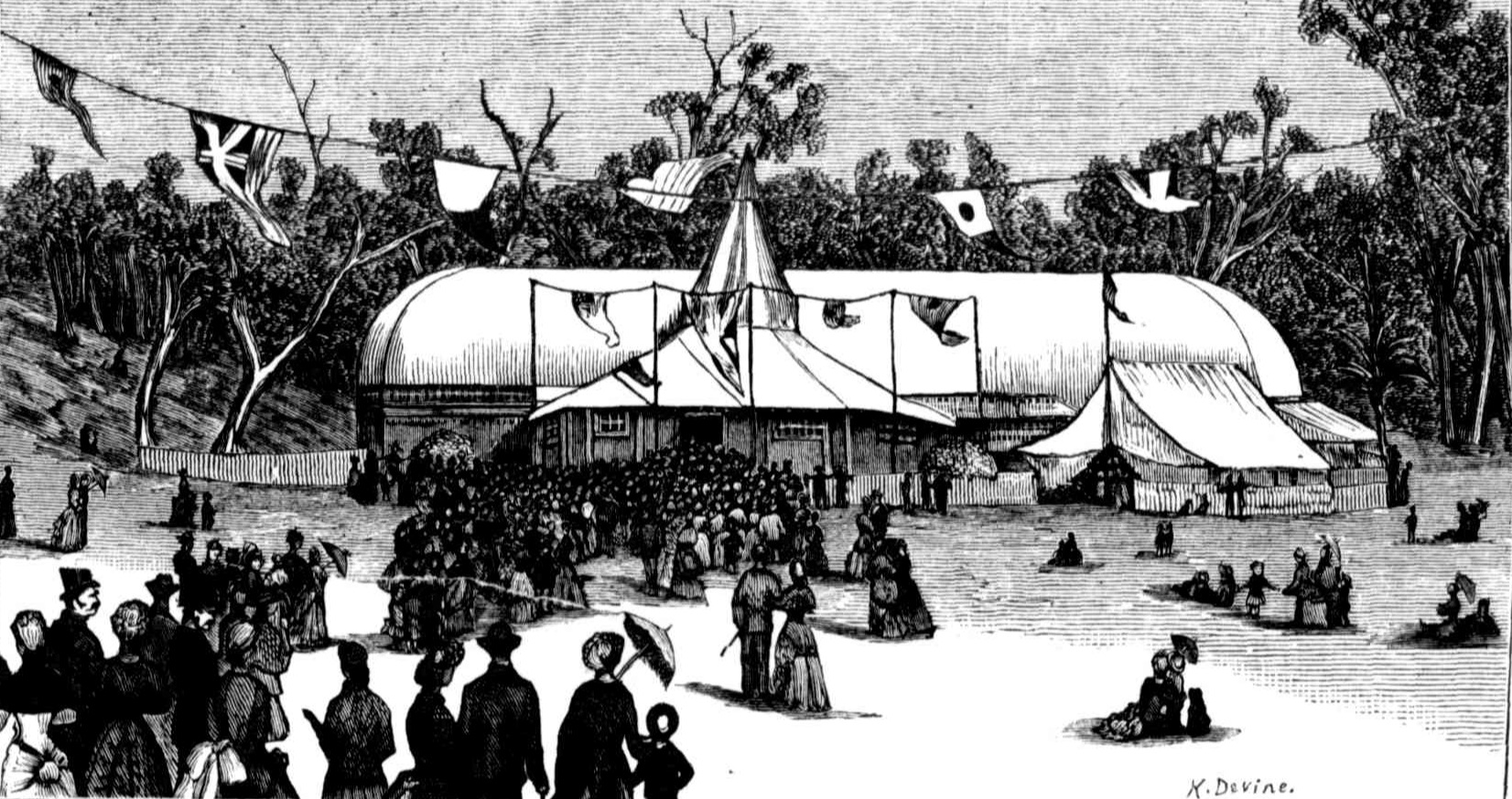
Sketches from Manly Wildflowers Show of September 1883 showing pavilion and original hotel in Ivanhoe Park, Manly and one of the displays within
.jpg?timestamp=1607309264492)
Municipal District of Manly.
The nominations for the first election in the Municipal District of Manly were lodged with John Woods, Esq., the returning officer, yesterday. The fol-lowing gentlemen were nominated :— For Aldermen — Messrs. J. C. Peters, John Fox, J. B. Smithers, J.P., W. Redman, E. Badmington, R. R. Austin, Thomas Rowe, J.P., C. H Hayes, John T. Smith, A. Hilder, L. R. Saillard, and Thomas Adrain. For Auditors Phillip Jenkins and George Kilminster. Municipal District of Manly. (1877, January 31). Evening News (Sydney, NSW : 1869 - 1931), p. 2. Retrieved from http://nla.gov.au/nla.news-article108195965
MANLY BEACH FIRE BRIGADE.
Yesterday evening the ceremony of christening the engine of the Manly Volunteer Fire Brigade was performed at the residence of the captain, it may be remembered that about a year ago a disastrous fire occurred at Manly Beach, and that on the following day a meeting was held at which it was resolved that a local fire brigade should be formed. Subscription lists were distributed, and the pecuniary feature of the movement was greatly aided by a very successful concert held shortly afterwards. Subsequently the matter was placed in the hands of the Corporation. After some delay a brigade was at length formed, an engine purchased, and a house built for it in the Market-square.
The brigade is under the command of Captain Rowe, Mr. Adrain being superintendent ; Mr. H. Wood, jun., foreman ; and Mr. Pomfrey, second foreman. The engine is a manual one, of small size, but powerful, supplied with hose-reel, some hundred feet of piping, with buckets, tanks and all necessary paraphernalia. The engine-house is constructed of galvanized iron, and it surmounted by a bell. At the rear there is a well of water. The local company invited the Sydney brigades to unite with them, and celebrate the christening of the engine in a festive manner. About fifty members of the Nos. 1, 2, and 3 Sydney, Newtown and Camperdown, the Glebe, and the Woollahra Volunteer Fire Companies, with several members of the Insurance Fire Brigades, responded to the invitation, and were conveyed to Manly Beach by the steamer Royal Alfred, and they were accompanied by the Volunteer Artillery Brigade Band.
On their arrival at the wharf at Manly Beach they were met by Captain Rowe and the members of his fire company, and they proceeded to the engine-house to inspect the engine. At 8 o'clock, the members of the different companies having formed themselves in procession with the engine decorated in front, and torches having been lighted, they marched through the principal streets, the band playing various enlivening airs. Captain Rowe, on horseback, led the procession. A considerable crowd followed the fire men, and altogether the event caused quite an excitement in the quiet little borough. After promenading the streets for some time the procession moved to the residence of Captain Rowe, where the firemen were drawn up.
Miss May Rowe was then called on by superintendent Cumb to perform the christening ceremony, and this the little maid duly accom plished by breaking, a bottle of champagne over the wheel of the engine, naming it "The Blanche." after her elder sister, the name which the Fire Brigade had requested should be given to it. Cheers having been given for Captain Rowe and the brigade, the procession was reformed and marched to the pavilion. Here refreshments were partaken of by the firemen. Alterwards superintendent Camb proposed '" Success to Captain Rowe and the Manly Beach Volunteer Fire Brigade." The toast was drunk enthusiastically. Captain Rowe responded on behalf of himself and the company, and expressed their gratification at seeing so many of their Sydney friends present at the christening of their engine. Though a small one, the time would doubtless come when a steam engine would be required, for Manly Beach was doubtless destined to be a great place. He thanked them heartily for their kindness in coming down to Manly Beach on the present occasion. He concluded by proposing the health of their visitors. The toast was acknowledged by Mr. Bird (fore-man of No. 1 Company), superintendent Lane (of the Newtown and Camperdown Fire Brigade), Mr. Barnard (for the Woollahra Brigade), Mr. Fenton (superintendent the Glebe Company), Mr. Dobson (No. 3 Company). Success to the Blanche" was proposed by Mr. Camb; and the chairman having given "The Queen," which was duly honoured, - and cheers given for the Manly Brigade, the firemen quitted the pavilion and marched to the engine house, where the engine was housed with éclat, end cheers given for the local brigade. The visitors were then escorted to the Royal Alfred, and returned to the city, spending their time by the way in a very jovial manner in singing songs. MANLY BEACH FIRE BRIGADE. (1878, July 2). The Sydney Morning Herald (NSW : 1842 - 1954), p. 5. Retrieved from http://nla.gov.au/nla.news-article28394123
The Manly Volunteer [Fire Fighting] Company was formed in June 1877 and occupied premises in Market Square. The Company was registered with the Metropolitan Fire Board in 1886 as Station No.24. The volunteers owned the premises from which the brigade operated in 1895. A new station in Sydney Road opened 25 February 1898. By 1903 Manly had partially-paid staff (1). First permanent staff were appointed in 1912. A new station on the corner of Sydney Road and Thornton Street opened 17 August 1921 (2). In 2000 the station address was 128 Sydney Road, Fairlight (3). (1) Annual Report 1903 p.12 (2) Colin Adrian, Fighting Fire A Century of Service 1884-1984, p.253 (3) NSW Fire Brigades website: http://www.nswfb.nsw.gov.au/about/stations_all.asp
Thomas Adrian, of the Ivanhoe Park Hotel, Manly Beach, applied for a renewal of his license. The police had lodged an objection, but it was considered invalid, and the license was granted. WATER POLICE COURT. (1882, June 9). The Sydney Morning Herald (NSW : 1842 - 1954), p. 3. Retrieved from http://nla.gov.au/nla.news-article13513081
The boot warehouse of Mr. R. E. Adrian has had extensive and well-deserved patronage during the week. "Bob" Adrian, who Is one of Manly's most progressive and up-to-date young citizens, carries the same enthusiasm into his business that he displayed on the battlefields of South Africa, and the rifle grounds of the State. He scores a "bull's-eye" every time he introduces new goods for the people of Manly, and his stock is unsurpassed In any establishment outside the city. MANLY NOTES. (1911, February 17). The Sun (Sydney, NSW : 1910 - 1954), p. 4 (CRICKET EDITION). Retrieved from http://nla.gov.au/nla.news-article221576170
New South Wales Imperial Bushmen- 474 Private Robert Edward ADRIAN From http://alh-research.tripod.com/Light_Horse/index.blog?topic_id=1105078
FAREWELL TO MR. R. E. ADRIAN.
Mr. R. E. Adrian, of Manly, the well-known cyclist, has thrown in his lot with the Imperial Bush-men, and having passed all tests and been accepted is about to proceed on active service. His friends in Manly tendered him on Thursday a concert and social, which came off with great success at the University School-hall. Mr. Dugald Thomson, MIA, presided over n mort enthusiastic meeting. Mr. H. S. Badgery and Mr. John Woods also spoke, and loud plaudits followed their efforts. During the evening Mr. Dugald Thomson presented a smoker's companion to Mr. Adrian, wishing mm every success and a happy career, and the guest made suitable acknowledgment. FAREWELL, TO MR. R. E. ADRIAN. (1900, April 7). The Sydney Morning Herald (NSW : 1842 - 1954), p. 10. Retrieved from http://nla.gov.au/nla.news-article14304462
A MANLY-SEND OFF
The University School Hall at Manly was inconveniently crowded on Thursday, when a send off to Mr. R. E. Adrian, who is leaving New South Wales, as a member of the Imperial Bushmen's Contingent, took place. The Mayor of Manly (Alderman W. H. Fletcher) presided, and during the evening speeches were made by Mr. Dugald Thomson, the Mayor, Mr. H. S. Badgery, and Mr. John Woods. An enjoyable programme of social and instrumental items filled the first part of the evening ,to which Miss Nellie Jones, 'Master Vincent Bolton, and Messrs. Fr Smeaton (Royal Arthur), King, Jones (Scottish Rifles), and E. A. Hind, contributed items. The band of the Scottish Rifles also played a couple of selections. During the evening a presentation of a smokers' companion was made to Mr. Adrian by Mr. Thomson, and in doing so the speaker made a feeling reference to the late Trooper Budd, who was the first to get a send-off from Manly. Trooper Adrian replied, and was much applauded on rising to speak. A torchlight procession, formed of the Manly firemen- (Captain W. Kay), and led by the Scottish Rifle Band, paraded the streets of Manly. The hon. secretary (R. A. Waller) and hon. treasurer (E. W. Quirk) worked energetically to make the send-off a success. An enjoyable dance followed the concert. A MANLY SEND OFF, (1900, April 9). Evening News (Sydney, NSW : 1869 - 1931), p. 2. Retrieved from http://nla.gov.au/nla.news-article113714297
TROOPERS ENTERTAINED.
The citizens or Manly tendered a complimentary dinner to Privates J. W. N.. Simpson, J. Beel, Stevens, and Thompson, on Thursday night, at the Grand Pier Hotel, In honor of their safe return from the front. The chair was occupied by the Mayor (Alderman E. W. Quirk, M.L.A.); The chairman, in proposing the health of the returned soldiers, extended a hearty welcome home, and referred to the fact that Manly had provided no fewer than 21 soldiers, who had left with various contingents since the beginning of the war. Two of these had lost their lives, some of them had returned to the seat of war, and one of them, Lieutenant R. Adrian, was at present on his way to attend the Coronation.
The toast, which was seconded by the vice-chairman, Alderman Ogilvy, and supported by Alderman Stevenson, was drunk with enthusiasm. The returned soldiers briefly responded, and Private Stevens read several letters of commendation from Brigadier-General Rimington prior to the departure of the troops for home. Other toasts proposed were "Absent Comrades," by the Rev. Anderson Gardiner, M.A.; "The Press," and "The Chairman." During the evening a gold medal was presented to Private Simpson and a case of pipes to Private Beel, by the chairman, on behalf of the citizens. The rest of the evening was filled in with musical Items, with Mr. F. Torzillo presiding at the piano. TROOPERS ENTERTAINED. (1902, June 7). The Daily Telegraph (Sydney, NSW : 1883 - 1930), p. 9. Retrieved from http://nla.gov.au/nla.news-article237620122
'Bob' Adrian, now a lieutenant, after lengthy service in South Africa, has returned to his home at Manly. Always of fine physique, he was never sick a day during the campaign. He has entered for the November carnival, and a win or two during the season would be popular. CYCLING CHRONICLE. (1902, October 15). Referee (Sydney, NSW : 1886 - 1939), p. 6. Retrieved from http://nla.gov.au/nla.news-article120116506
Marriage:
9491/1905 ADRIAN ROBERT E SMITH MARION H GLEBE
Children of the union:
ADRIAN WALLACE H 20518/1915 ROBERT E MARION H MANLY
ADRIAN ALAN F 37288/1917 ROBERT E MARION H MANLY
ADRIAN LORNA 15456/1919 ROBERT E MARION H MANLY
ADRIAN MARJORIE 26393/1908 ROBERT E MARION H MANLY
ADRIAN MALCOLM E 6185/1912 ROBERT E MARION H MANLY
ADRIAN BRUCE S 38968/1913 ROBERT E MARION H MANLY
ADRIAN RONALD J 40260/1910 ROBERT E MARION H MANLY
Births: parents and brothers – those registered – many weren’t for some reason:
ADRIAN THOMAS G 4336/1872 THOMAS EMMA REDFERN
ADRIAN ROBERT 1874
ADRIAN EMMA M 29947/1911 THOMAS G HELEN MANLY
ADRIAN THOMAS C 21708/1893 JOHN MABLE L MANLY
ADRIAN JOHN 36134/1906 JOHN MABEL L MANLY
Deaths:
ADRIAN EMMA 4518/1932 JOHN MARY A MANLY - died 1931
ADRIAN SYLVIA M 6245/1899 JOHN MABLE L MANLY
ADRIAN IVY M 7984/1892 JOHN MABLE L MANLY
ADRIAN MABEL L 20959/1919 WILLIAM FANNY MANLY
ADRIAN THOMAS GORDON 23840/1936 THOMAS EMMA MANLY
ADRIAN MARION HAMILTON 22420/1949 JAMES FRASER MARY MANLY
ADRIAN ROBERT EDWARD 23421/1959 THOMAS UNKNOWN MANLY
THOMAS GORDON ADRIAN ; Business and Company Records 1903-1922. Item No: [2/8533] | Page No: 258 | File No: 8916 | Nature of Business: Watchmaker Jeweller & Bicycle Repairer | Place of Business: The Corso Manly
THE MANLY PAINTING & DECORATING COMPANY; Business and Company Records 1903-1922. Item No: [2/8552] | File No: 39921 | Nature of Business: Contracting Painting & Decorating | Place of Business: 22A Sydney Road Manly - Foggon connection.
R E ADRIAN; Business and Company Records 1903-1922. Item No: [2/8531] | Page No: 548 | File No: 7096 | Nature of Business: Boot & Shoe Importer | Place of Business: The Corso Manly Beach
Deaths. ADRIAN.—January 20, at Ivanhoe Hotel, Corso, Manly, John Adrian, of Mount Pleasant, late of Belfast, Ireland, aged 64 years. Family Notices (1895, January 21). The Sydney Morning Herald (NSW : 1842 - 1954), p. 1. Retrieved from http://nla.gov.au/nla.news-article14006241
THE FRIENDS of the late JOHN ADRIAN of Mount Pleasant, Manly are kindly invited to attend his Funeral to more from the Ivanhoe Hotel Corso, Manly THIS DAY MONDAY, at 3.30 p.m., for the Manly Cemetery. T. WAUGH and CO., Undertakers, Manly. Family Notices (1895, January 21). The Sydney Morning Herald (NSW : 1842 - 1954), p. 8. Retrieved from http://nla.gov.au/nla.news-article14006345
Correspondence was received and dealt with as follows: — From G. J. Spilsbury, John Adrian, and ten others, drawing the attention of the council to the bad condition of the roads through Manly Vale and over Burnt Bridge Creek. MANLY. (1888, July 16). Evening News (Sydney, NSW : 1869 - 1931), p. 7. Retrieved from http://nla.gov.au/nla.news-article107326734
Deaths. ADRIAN.—June 5, at the Ivanhoe Hotel, Corso, Manly, Sylbia May, the dearly beloved daughter of John and Mabel Adrian, aged 3 years. Family Notices (1899, June 6). The Sydney Morning Herald (NSW : 1842 - 1954), p. 1. Retrieved from http://nla.gov.au/nla.news-article14241955
ADRIAN, Marion Hamilton. -July 5, 1949, at her residence, 76 Lauderdale Avenue, Manly, beloved wife of Robert (Lieutenant-Colonel Adrian), loved mother of Marjorie, Donald, Malcolm, Bruce, Wallace, Alan and Lorna, and sister of Albert, George, and William Smith.
ADRIAN -The Funeral of the late MARION HAMILTON ADRIAN of 76 Lauderdale Ave Manly will leave St Matthew s Church The Corso Manly after service commencing at 10 o’clock To morrow (Thursday) Morning and will arrive at the Northern Suburbs Crematorium at II 30 o clock T WAUGH AND CO Funeral Directors 92 The Corso Manly Phone XU1118. Family Notices (1949, July 6). The Sydney Morning Herald (NSW : 1842 - 1954), p. 22. Retrieved from http://nla.gov.au/nla.news-article18121340
Municipal. MANLY.—MR. WALTER GERMAN'S CANDIDATURE. - Article - Evening News (Sydney, NSW : 1869 - 1931)Tuesday 4 February 1890 - Page 5 ... Municipal. MANLY. — MR. WALTER GERMAN'S CANDIDATURE. At least 200 ratepayers of Manly attended ... outside Mrs. Adrian's Ivanhoe Hotel, the Corso, Manly, on Saturday evening, to hear Mr. Walter H. German
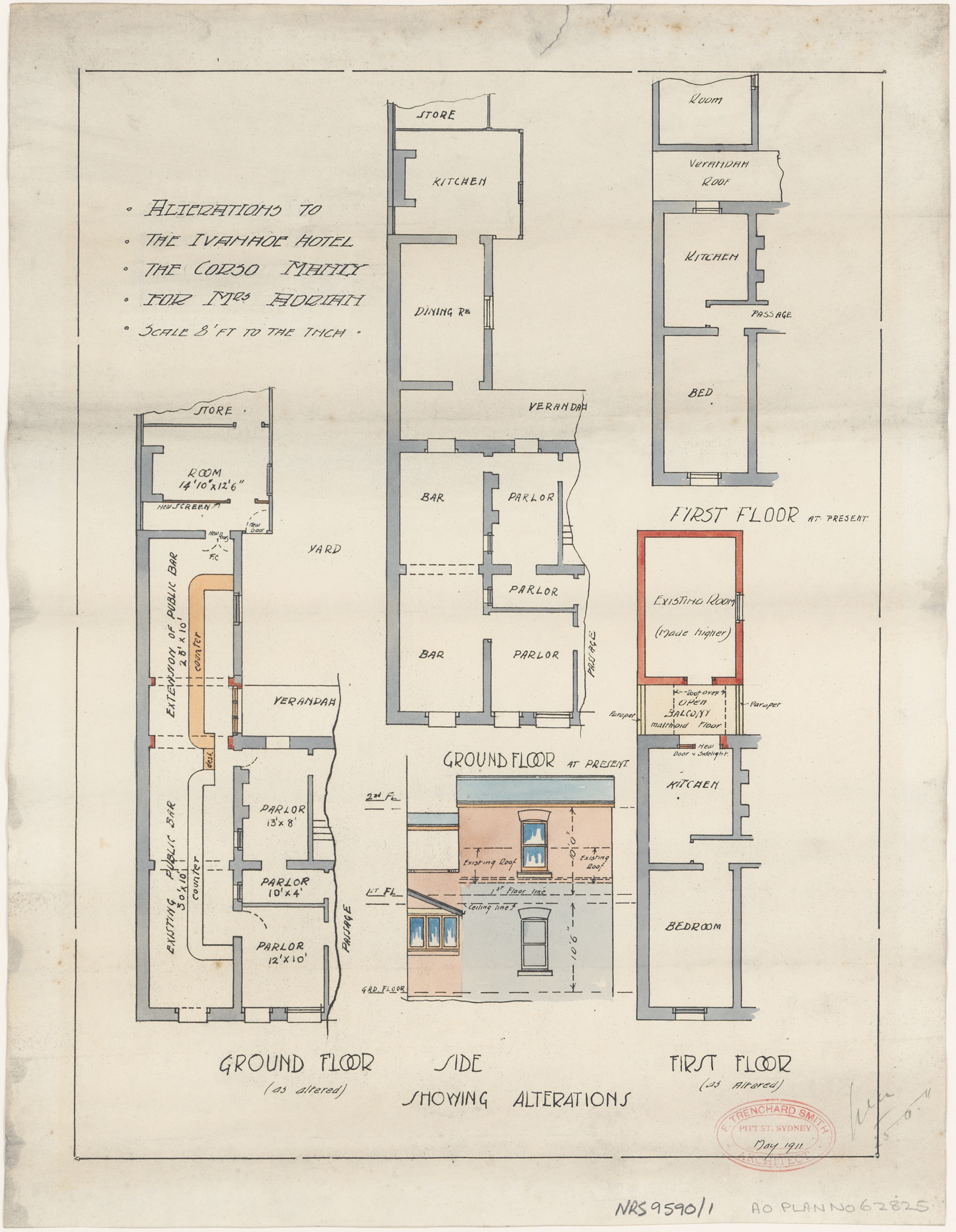
Ivanhoe Hotel, The Corso, Manly, Present and proposed ground and first floor plans, side elevation, Applicant/owner, Mrs Adrian, Architect F Trenchard Smith, Pitt Street, Manly, Signed 25 May 1911. Digital ID: 9590_62825, courtesy NSW State Archives & Records.
FUNERALS. ADRIAN.—The Relatives and Friends of the late Mrs. EMMA ADRIAN are kindly invited to attend her Funeral, to leave her late residence, Nairda, Birkley-road, Manly, THIS AFTERNOON (Thursday), at 3 o'clock, for the Manly Cemetery, T. WAUGH AND CO., Funeral Directors, Tele YU1118. 92 Corso, Manly. Family Notices (1931, December 24). The Sydney Morning Herald (NSW : 1842 - 1954), p. 7. Retrieved from http://nla.gov.au/nla.news-article28036123
In the Supreme Court of New South Wales.
PROBATE JURISDICTION.
In the will and two codicils of Emma Adrian, late of Manly, Sydney, in the State of New South Wales, Commonwealth of Australia, widow, deceased. PURSUANT to the Wills, Probate and Administration Act, 1898, the Testator's .Family Maintenance and Guardianship of Infants Act, 1916, and the Trustee Act, 1925: Notice is hereby given that every creditor and any other person having any claim against the estate of Emma Adrian, the above-named deceased, who died on or about the 23rd day of December, 1931, and probate of whose will and two codicils was granted by the Supreme Court of New South Wales, in its Probate Jurisdiction, on the 30th day of March, 1932, to John Adrian, Thomas Gordon Adrian and Robert Edward Adrian, the executors of the will and codicils, is hereby required to send particulars in writing of such claim to the said John Adrian, Thomas Gordon Adrian and Robert Edward Adrian, to the care of the undersigned, at their office hereunder mentioned, on or before the 10th day of October, 1932, at the expiration of which time the said John Adrian, Thomas Gordon Adrian and Robert Edward Adrian will proceed to" distribute the assets of the said deceased amongst the persons entitled thereto, having regard only to the claims of which they have notice; and notice is hereby further given that the said John Adrian, Thomas Gordon Adrian and Robert, Edward Adrian will not be liable, for the assets or any part thereof so distributed, to any person of whose claim they shall not have had notice at the time of such distribution.—Dated this 4th day of August, A.D. 1932. W. S. GRAY AND PERKINS, Solicitors for the Executors, 375 George-street, Sydney. PROBATE JURISDICTION. (1932, August 5). Government Gazette of the State of New South Wales (Sydney, NSW : 1901 - 2001), p. 2604. Retrieved from http://nla.gov.au/nla.news-article220263542
DEATHS. ADRIAN.—October 20, 1936, at his residence, Havana, Sydney-road, Manly, Thomas Gordon, beloved husband of Nellie Adrian, father of Emma, and brother of John, Robert, Mrs. B. Smith, and Mrs. Payne, aged 64 years. Family Notices (1936, October 21). The Sydney Morning Herald (NSW : 1842 - 1954), p. 14. Retrieved from http://nla.gov.au/nla.news-article29536031
In 1886, Emma Adrian’s Ivanhoe Hotel, removed from Ivanhoe Park, took over the Colonnade Hotel (formerly Farrell’s New Steyne Hotel) next door to John Farrell senior’s Colonnade House.
AFTER 45 YEARS
After having conducted the Ivanhoe-Hotel, The Corso, Manly, for 45 years, Mrs. Emma Adrian has sold out. The buyer is Mr. Diamond. Mrs. Adrian will leave the hotel on November 27, and will live at Manly. AFTER 45 YEARS (1919, November 6). The Sun (Sydney, NSW : 1910 - 1954), p. 7. Retrieved from http://nla.gov.au/nla.news-article222291204
Ivanhoe Hotel, Corso, Manly, from Emma Adrian to Frank Dimond; … LICENSING COURT. (1919, November 28). The Sydney Morning Herald (NSW : 1842 - 1954), p. 5. Retrieved from http://nla.gov.au/nla.news-article15868294
Manly in Sport.
(By A.O.)
There Is no better sport than a Manlyite. True to name, Manly and triers every time. In victory acting modestly; In defeat giving; credit to the other side as better men— no squeaking. In the years that have passed when Manly was truly a village, and when every resident person was a strong bond of unity ever existing between all, each sympathetic in time or trouble; each rejoicing at another's success. The, seed then sown has borne fruit, and the same spirit exists to-day. Once a Manlyite always a Manlyite, in whatever place on this globe you may afterwards reside.
Sports have done a lot in popularising Manly— cricket, football, surfing, surf clubs, swimming, golf, bowls, tennis, sailing, regattas, and other blanches of sport. The brief at present Is for cricket and football, but permit an acknowledgement to be made of the whole-hearted, enthusiastic unselfish work of the officers and committees and members of all these clubs and their share in advancing Manly's interests. Manly Municipal Councils, past and present, have always been ready to lend a helping hand .and give concessions to every sporting body at Manly.
FORMATION OF MANLY OVAL.
Old visitors to Manly In the days of the celebrated steamship Phantom, when 661b. weights were shifted from port to starboard, or vice |Versa, to keep her on an even keel, will doubtless remember the old Ivanhoe Hotel, situated on what is now the Manly Oval, also the old iron dancing pavilion, about where the Bowling Club is now.
Part of the old hotel still exists,' and is used at present as a courthouse. The proprietor of the old Ivanhoe, the late Mr. Adrian, was a very generous public-spirited gentleman. At his own cost he laid down a line of pipes to drain the ground, which at that time was very rugged, even if picturesque. Mr. Adrian decided eventually to sell the ground, and after talking the matter over with Mr. C. H. Hayes, the then Mayor, that gentleman decided himself to purchase it for a public park. I have reviewed all the evidence available in connection with this matter, and whilst other gentlemen rendered assistance and support, the main credit for Initial action in securing this park for the people must be given to Mr. C. H. Hayes, to whom Manly residents owe a debt for good work in many ways, and in particular In securing the park. Afterwards he sold It to the Government on the understanding that It was to be dedicated as a public park for the people of New South Wales.
A lot of work— filling in, cutting out rocks, &c. —was necessary to form the oval, and fix park improvements generally. Messrs. Hayes and Bob Pitt guaranteed with the bank £400.
Appeals were made for public subscriptions, and a good story is told that at all times at Manly It was always deemed advisable to go first to the late Hon. W. Bode Dalley, a fine sport and good resident, to head the list. He was generous to a fault, and gave freely to all objects. Other residents did not like to be behind the subscription given by him, and the result was always good, provided the late Hon. W. Bede Dalley headed the list. Half of the net proceeds of the old wild-flower shows were devoted, to the Improvement of the park. And who does not remember the wonderful financial success of those Manly cricketers, always willing workers at those shows.
The first turf wickets were laid with Richmond soil, or, rather, sods, cut from what was afterwards proved swampy ground. The result was a failure, and subsequently Built soil Was substituted, and the wickets to- day on the oval are as good as Is possible, and equal to any elsewhere, and a credit to Jimmy Randell, the caretaker. Mention should be made of those who materially helped to form the oval, and the names, as far as Messrs. Hayes and Bob Pitt, the late John Woods, the late Alfred Hilder, the late Sir William Lyne, Messrs. Cameron, Lough, C. R. Austen, Tom Wedderburn, C. A. Lawrence, H. T. Robey, the late C. H. Haylock. C. Wagstaff, the late Adam Russell, and others. Mrs. H. T. Robey was a lady who contributed very largely to the success of many functions held, to which the proceeds, or part of some, were for park improvements.
PAVILION AND DRESSING ROOMS.
Tents were good enough In the early days of Manly cricket; then come the old wooden pavilion, which also served its time, and then came the present fine structure. Mr. W. S. Mitchell, when hon. treasurer of the club, obtained the consent of the Manly Council to cater for life members, the object being to start a fund for a new pavilion. The result was that in 1909 the council agreed to erect a new pavilion, and the moneys collected by Mr. Mitchell's efforts were handed over to the Council as part payment of cost. The amount was about £130. Mr. Mitchell also collected, when the pavilion was elected, enough money to furnish the committee room of the cricket club. Mr. Mitchell was a very fine officer of the Cricket Club, and Is now residing In London. The writer wishes him the very best' of luck, as he was certainly a factor in pushing on for the new pavilion to be erected. The Manly Council are entitled to their full share of credit also for erecting the pavilion. The fine training quarters erected at the back of the pavilion for the footballers was paid for by the Council, the Metropolitan Rugby Union, and Manly District Football Club, each contributing a share of the cost. Now, no football club Is better placed than the local club, with every facility for training, and then it should be the best-trained team in the competitions.
.jpg?timestamp=1607153839190)
.jpg?timestamp=1607153884788)
The Oval.,
.jpg?timestamp=1607153785491)
The Croquet Green.
.jpg?timestamp=1607153746935)
Bowling Club House and Greens.
.jpg?timestamp=1607153710132)
The Golf Club House Verandah.
.jpg?timestamp=1607153536278)
Tennis Club House and Courts.
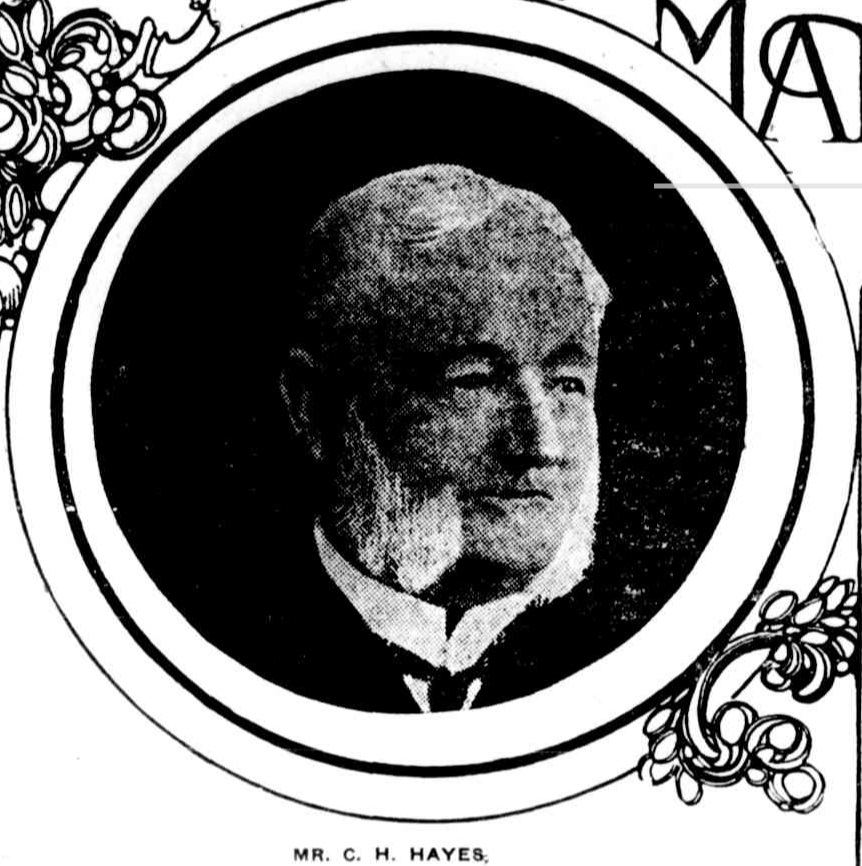
MR. C. H. HAYES; The Father of Manly.
MANLY'S SPORTING FACILITIES (1914, January 17). Saturday Referee and the Arrow (Sydney, NSW : 1912 - 1916), p. 2 (ISSUED AS A SUPPLEMENT WITH THE SATURDAY REFEREE). Retrieved from http://nla.gov.au/nla.news-article117414703
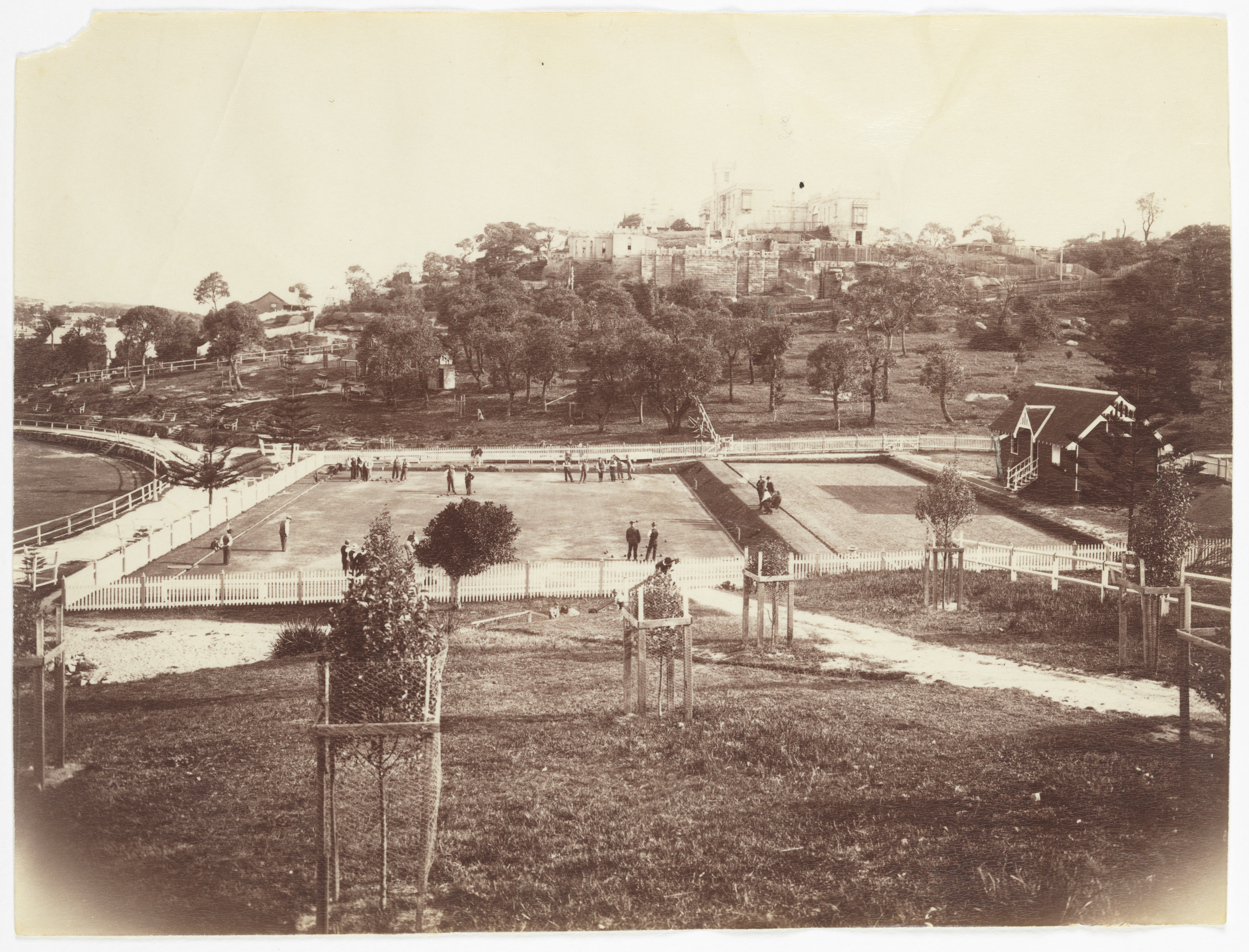
Manly Oval bowling greens, circa 1880-1890, Item e00324_0012_c, courtesy State Library of NSW
CASUALTIES.
FALL OVER A BALCONY.
While assisting to remove some furniture from the Ivanhoe Hotel, Manly, last evening, John Adrian, 38, lost his balance, and fell over the balcony to the roadway, a distance of 15ft. Dr. Harvey was summoned, and on examination found that Adrian had sustained a compound fracture of the skull. He now lies at the Ivanhoe Hotel in a critical condition. The injured man resides at Park-avenue, Manly. CASUALTIES. (1905, October 7). The Sydney Morning Herald (NSW : 1842 - 1954), p. 14. Retrieved from http://nla.gov.au/nla.news-article14728676
MANLY SURF CLUB.
There was a large gathering of surf bathers at the Hotel Steyne, Manly, on Wednesday night, when the Manly turf Club was formed. Mr. F. W. J. Donovan presided. The principal business was the adoption of the sub-committee's report, which consisted of a set of 21 rules to govern the new body. The objects as stated by one of the rules are (a) to obtain improved facilities for surf bathing and otherwise -to promote and encourage the sport; b) to ensure the most effective methods of rescuing persons in distress and the resuscitation of the apparently drowned; (c) to provide for a regulation cost- ae for members and to assist in enforcing the laws governing the conduct of surf bathers; (d); to effect such other proposes as may hereafter be considered necessary in the interest of the sport.
The subscription fee was fixed at 2s 3d per annum.' Subscribers of 10s 6d per annum are to be hon. members and the first 100 subscribers of 2gs and upwards may be life members. The officers elected were:.— Patron, Sir H. Rawson; president, Mr. F. W. J. Donovan; captain, Mr, M. A. Roberts; vice-captain, Mr. Len' Murray; hon. treasurer, Mr. C. J. Burchmore; hon. secretaries, Messrs. W. Tonge and A. W. Relph; committee, Messrs.. D. H. Johnson, J. B. Meyer, R. E. Adrian, T. Ferris, C. F. W Lloyd, C. Calvert, D. Hogan, J. J. K. Taylor, Wallace, S. Smith, H. D. L. Woods, J. P. Wright, Jun.;' auditors, Messrs. M. Ross and D W. Custer. Mr. W. Scott Fell was elected the first life member, and the meeting adjourned till August 26, when the vice-presidents will be elected. MANLY SURF CLUB. (1907, August 8 - Thursday). Evening News (Sydney, NSW : 1869 - 1931), p. 3. Retrieved from http://nla.gov.au/nla.news-article112641188
SWIMMING.
Adrian beats Kahanamoku
The 440 yards swimming championship of New South Wales was contested at the Domain Baths on Wednesday night, resulting in a win for T. Adrian, of the Manly Club, with Duke Kahanamoku (Hawaii) ' second, and Thomas (Sydney) third. Longworth did not start. Thomas held a short lead over the first half-distance, Adrian being in second place, and Kahanamoku lying third. Then the Hawaiian slowly forged ahead to first' place, which he looked likely to hold; but 100 yards from home, Adrian, with a splendid dash, go' slightly ahead, and the remainder of the course was desperately fought with Adrian winning by a few inches. The time was 5min. 38sec., which is 19 seconds slower than that put up by Longworth. G. Cunha, the other Hawaiian visitor, swam brilliantly in the open class handicap over 110 yards, getting over that distance in 1 min 3.3-jsec., thus knocking 1 sec. off A. W. Barry's Australasian record. E. E. G. Finlay, in winning the 220 yards breast stroke championship of New South Wales, did 2.5 sec. better than the previous New South Wales figures. SWIMMING. (1915, January 8). Cootamundra Herald (NSW : 1877 - 1954), p. 2. Retrieved from http://nla.gov.au/nla.news-article139527707
Tommy Adrian.
KAHANAMOKU'S CONQUEROR.
(By OLYMPIC.)
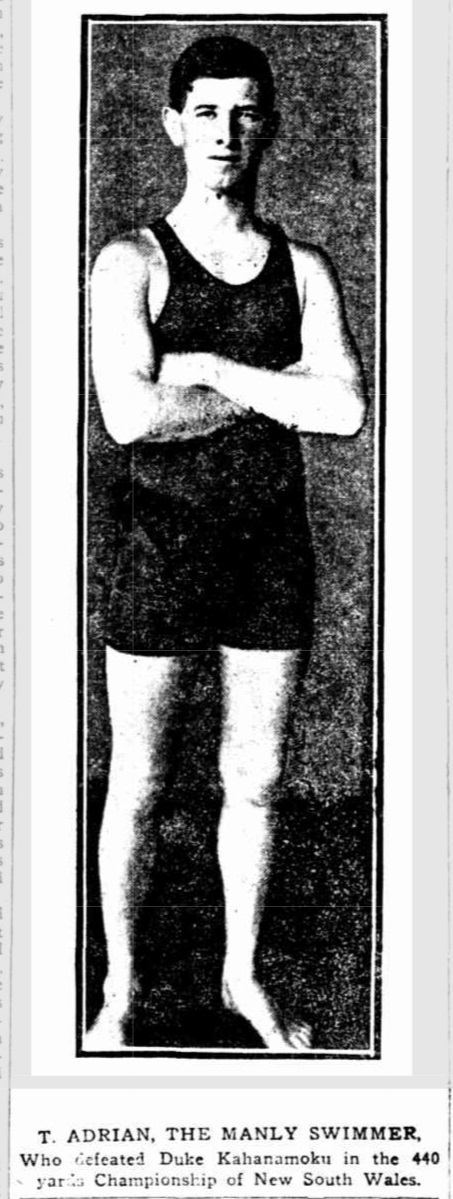 TOMMY ADRIAN, of Manly, New South Wales, is the only Australian that has yet inflicted defeat upon Duke Kahanamoku, the world's greatest swimmer, and this notwithstanding the fact that the cream of Australian swimmers have opposed "the Duke" in two continents. Kahanamoku defeated our best at Stockholm, and only recently outclassed our sprinters in their own waters. But Adrian was too much for the dusky champion over 440 yards. And no one was more surprised than Adrian himself.
TOMMY ADRIAN, of Manly, New South Wales, is the only Australian that has yet inflicted defeat upon Duke Kahanamoku, the world's greatest swimmer, and this notwithstanding the fact that the cream of Australian swimmers have opposed "the Duke" in two continents. Kahanamoku defeated our best at Stockholm, and only recently outclassed our sprinters in their own waters. But Adrian was too much for the dusky champion over 440 yards. And no one was more surprised than Adrian himself.
Tommy is quite a boy. He has some time to go before mans estate is reached, but he has been 10 years a swimmer. And he is —what there is of him—all pluck and determination. He is not one of those big, tall men—the sort of champions Australia has been used to. Cecil Healy, Albert Barry, Harold Hardwick, and others, are head and shoulders above him in stature, but they are not one atom better off in the matter of courage than the Manly idol. "Little Tommy' he is called by the Villagers. He was born at Manly, and has lived there all his days. Chatting with Adrian a few days back, the writer was struck by the simplicity of his advice to budding champions. "Persevere and enthuse and you will win," said he.
But Tommy, although, perhaps, owing much of his success to perseverance, must not forget that there is such a thing as sporting blood. There is much of this very stuff in the Manly boy's veins. Many years ago an uncle of this present-day swimming champion was a foremost cyclist. That was Bob Adrian, and many a time he scored over more greatly fancied candidates for big events. Jack Adrian—Tommy's father—was a fine amateur sculler. When Ned Hanlan was preparing for his races with Bill Beach, he had Jack Adrian for a pace-maker. Tommy's athleticism would appear to be largely inherent.
Adrian made his first public appearance when 11 years old. It was at a school carnival. Many rungs in the ladder of fame have been negotiated since then. Strange to say, the Manly lad, as quite a youngster, did not like short distance events. Send him on a bit of a journey, however, and he revels in the task. Ken Murray, who was one of our best sprinters some years ago, advised Adrian to specialise over the longer distances. Adrian accepted the advice, and to-day he is in the forefront of our champion swimmers. Since giving up an imperfect trudgeon stroke for the more recent swimming acquisition—the crawl—Adrian has knocked seconds off his previous times, and, armed with the knowledge that the scalp of the world famous Kahanamoku has come his way, further championship achievements may safely be predicted. Tommy Adrian. (1915, February 6). The World's News (Sydney, NSW : 1901 - 1955), p. 6. Retrieved from http://nla.gov.au/nla.news-article131503070
CYCLING
THE LEAGUE. SATURDAY'S ROAD RACE, BARKELL A WINNER. BAGNALL THE FASTEST MAN.
An Exciting Contest— Ends in a Surprise. O'Brien and Adrian Hurt— A Muddy Finish— The Death of Harris— The Carnival Entries— May be Made Till To-Morrow— Return of Megson— Body and Walne Doing Well.
(BY- ''WHEELER.')
Owing to a wrong impression abroad that entries for the League Carnival closed on Thursday instead of yesterday, it has been decided to accept nominations up to to-morrow night. Many are coming in from Victoria and elsewhere.
Joe Megson arrived yesterday from Melbourne to be ready for the Carnival. The fifty miles championship which he won when not trained for it knocked him out a bit, and he has been taking things easy, but he looks well, and ought to be fit as a fiddle on June 22. The prizes at the Dave Kirk meeting were trophies. About £50 was realised. Walne made a new flying unpaced quarter-mile record of 27sec, and Jack Green equalled Relph's paced record of 24 4-5sec. A two miles League Handicap will be run at the Cricket Ground on Saturday. A cyclist was hurt the other day through the breaking of the steering tube of his machine. This, Percy Fowles (who knows a bit about cycling and is also a mechanic) says, is the most important part of a bicycle, though few experienced cyclists realise it. The steering tube is very liable to strain and rust, and suffers from grit, and should always be carefully attended to. Saturday's road race was a very successful one, and would have been more so but for the rain, which made the competitors "a touching sight to see" as they went past the winning post. The limit men won, which was, of course, a grievance to the back-markers, but no one ever thought it would happen that way, and the front rank are always growling when the scratch men get a win. The closeness of many of the finishes was remark-able. Another road race over a longer journey is talked of, and perhaps it would be as well if one were tried without pacing, and see who is the best strictly ' on his own.' Harry Bagnall, who made the fastest time on Saturday, was not only practically unpaced, but also had a fall, twisting his handles and saddle. The first report which the crowd got owing to the rain was that Charlie Miller had scored the fastest ride. When the timekeeper, the touring secretary, and ' WHEELER ' turned up at the tea table at the Steyne Hotel, and announced the real state of affairs, Bagnall (who was sitting with his pal, Tommy Barkell, the race winner) could not believe the news. Bagnall and Barkell are old stagers in the League, and no one begrudged them their luck. Barkell admits that he had no thoughts of victory until nearly home. A peculiar thing about it is that Bagnall had been over the course with Cleary on Queen's Birthday, when the latter made 1h 15min, which was thought nearly good enough to win. Bob Adrian, the popular League captain, was unlucky enough to have a heavy fall after passing the post in the road race. The accident was caused through the crowd, which would not keep back and give the tired riders a chance. Adrian was bruised all over. … CYCLING. (1897, June 2). Referee (Sydney, NSW : 1886 - 1939), p. 3. Retrieved from http://nla.gov.au/nla.news-article121519617
CITIZEN FORCES
Bob Adrian Leads
Members of the Citizen Forces R.A. had a field day at Long Bay last Saturday — elimination tests in connection with the representation of New South Wales for the King's Medal match at Hobart in the morning, with an interdivisional match in the afternoon. In the last-named event (20 aside) the 1st Division defeated the 2nd Division by 48 points, the winners being led by Major R. E. (Bob) Adrian, the well-known Manly marksman. CITIZEN FORCES (1924, December 19). Arrow (Sydney, NSW : 1916 - 1933), p. 14. Retrieved from http://nla.gov.au/nla.news-article103547376
ADRIAN DELAYED
May Join Team in Melbourne
Tommy Adrian, "Boy" Charlton's mentor, is in bed suffering from a nervous disorder. He will not sail by the Ormonde to-day. Adrian bus been ill for a fortnight, but Dr. Thomas, who is attending him. is convinced that if his patient continues to progress, as he did last night, and this morning he will be able to catch the express on Sunday night, and join the team in Melbourne. The Ormonde will not leave Melbourne till Tuesday. Adrian was unable to attend the send-off in the Theatre Royal yesterday. Last night he was visited by Charlton and Ernie Henry, for whom Adrian predicts a brilliant future. They handed Adrian his blazer. Both the young swimmers expressed great disappointment that their mentor could not accompany them to-day. Adrian was gassed at the war, and he underwent an operation in London. He has never been perfectly well since. The money to send him to the Games was raised separately from the general fund. ADRIAN DELAYED (1924, April 30). The Sun (Sydney, NSW : 1910 - 1954), p. 4 (FINAL EXTRA). Retrieved from http://nla.gov.au/nla.news-article223398279
TOMMY ADRIAN MAY BE HOME SOON
In a letter to his parents at Manly, Tommy Adrian states that his health 'is greatly Improved, and that he hopes to return home in the near future. He forwarded a guinea to the fund which was Inaugurated, to build the Memorial Gates at Manly Oval In memory of the late Mr.- 0. O. H. Merrett. Great progress ta being made with this fund, and already over £200 is in hand while many promises have been received. To-night, at Dungowan, the Bankers' Operatic Society will present "To-night's the Night," and this, with several other functions which are being arranged, will help materially ' towards the committee's objective of £500. TOMMY ADRIAN (1925, July 21). The Labor Daily (Sydney, NSW : 1924 - 1938), p. 2. Retrieved from http://nla.gov.au/nla.news-article239956670
'TOMMY' ADRIAN HOME
Manly Friends' Welcome
'Tommy' Adrian, former swimming champion and trainer of 'Boy' Charlton, who became seriously ill when abroad with the lust Australian Olympic team, returned home by the Jervis Bay today. Adrian, who looked well and is greatly Improved In health, was met by many Manly friends, including Ernie Henry, a member of the Olympic team, who had also been In Adrian's care. "TOMMY" ADRIAN HOME (1926, April 19). Evening News (Sydney, NSW : 1869 - 1931), p. 7. Retrieved from http://nla.gov.au/nla.news-article117283808
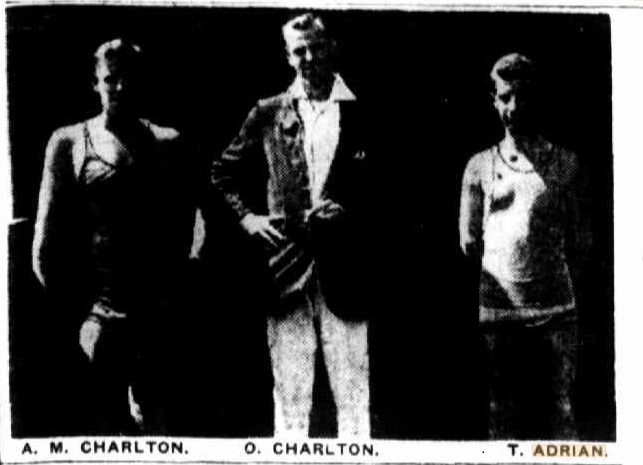
CYCLES CRASH
Kendall Robert Adrian, 22, of Orlando Avenue, Cremorne, and Joyce Alice Smith, 18, of Darley Road, Manly, who was riding the pillion, were seriously injured when their motor cycle collided with another on North Head yesterday. The rider of the other motor cycle, Donald Chauntrill Hughes, 18, of Osborne Road, Manly, was not seriously hurt. He was later charged with causing grievous bodily harm to Adrian and Smith and with being an unlicensed driver. CYCLES CRASH (1951, December 10). The Sydney Morning Herald (NSW : 1842 - 1954), p. 4. Retrieved from http://nla.gov.au/nla.news-article18243533
Charles Foggon [also spelled Foggan], (1880-1969) - Notes
Charles Foggon senior, born was born circa 1855, the third son of Charles Foggon of Stanley, England. He married Margaret Ann Davis on 8 February 1879 at Morpeth, NSW. Margaret was the daughter of Charles Davis of Manly. They marked their silver wedding anniversary in 1904. Charles senior died at Katoomba on 12 September 1931, aged 76. Charles Foggon junior was born 1880 at Lambton to Charles and Margaret Ann Foggon.
The Foggon family moved to Manly around 1896.
The 1900-1901 Electoral Roll for District of Warringah, Manly Division number 369 lists: Foggon, Charles, Eustace Street, painter, presumably Mr Foggon senior. Charles Foggon is at Delhi Villa, Eustace Street (east side) in Sands’ Directory for 1908.
Charles junior was part of the Manly Band under Jack Hawkins. They played in competitions, and also for Corpus Christi functions, and for the arrival of the first American Fleet and the first Japanese Fleet.
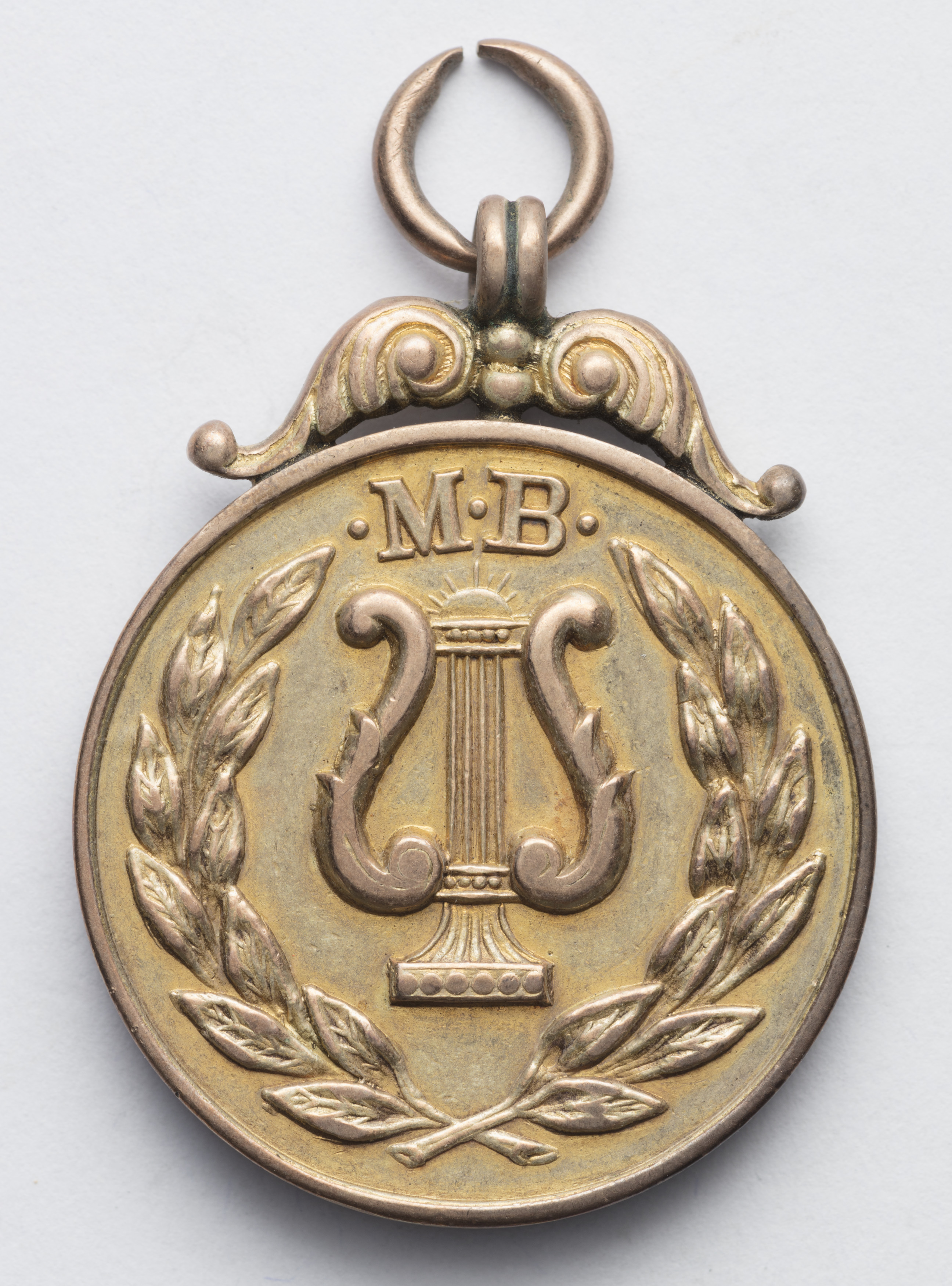
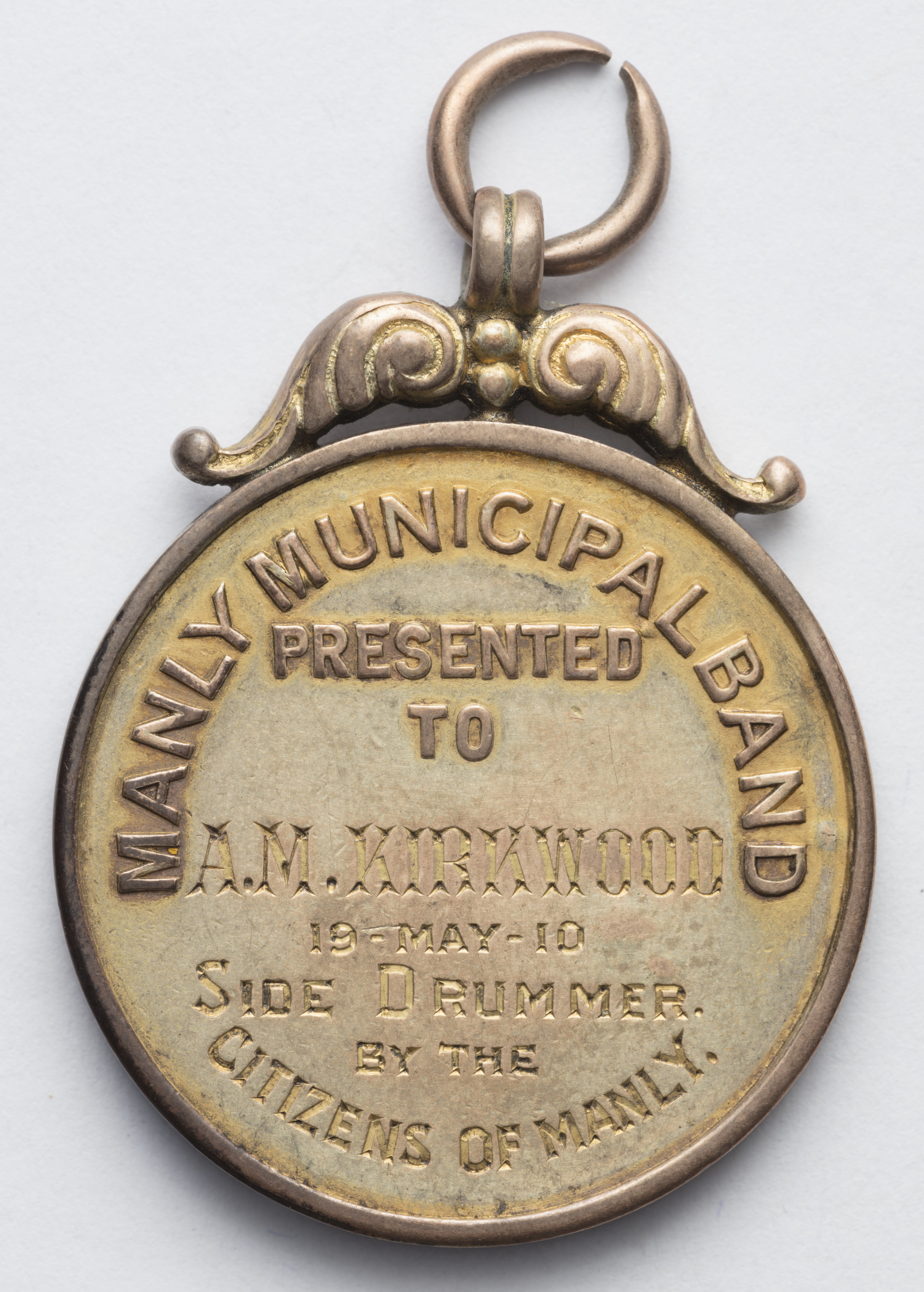
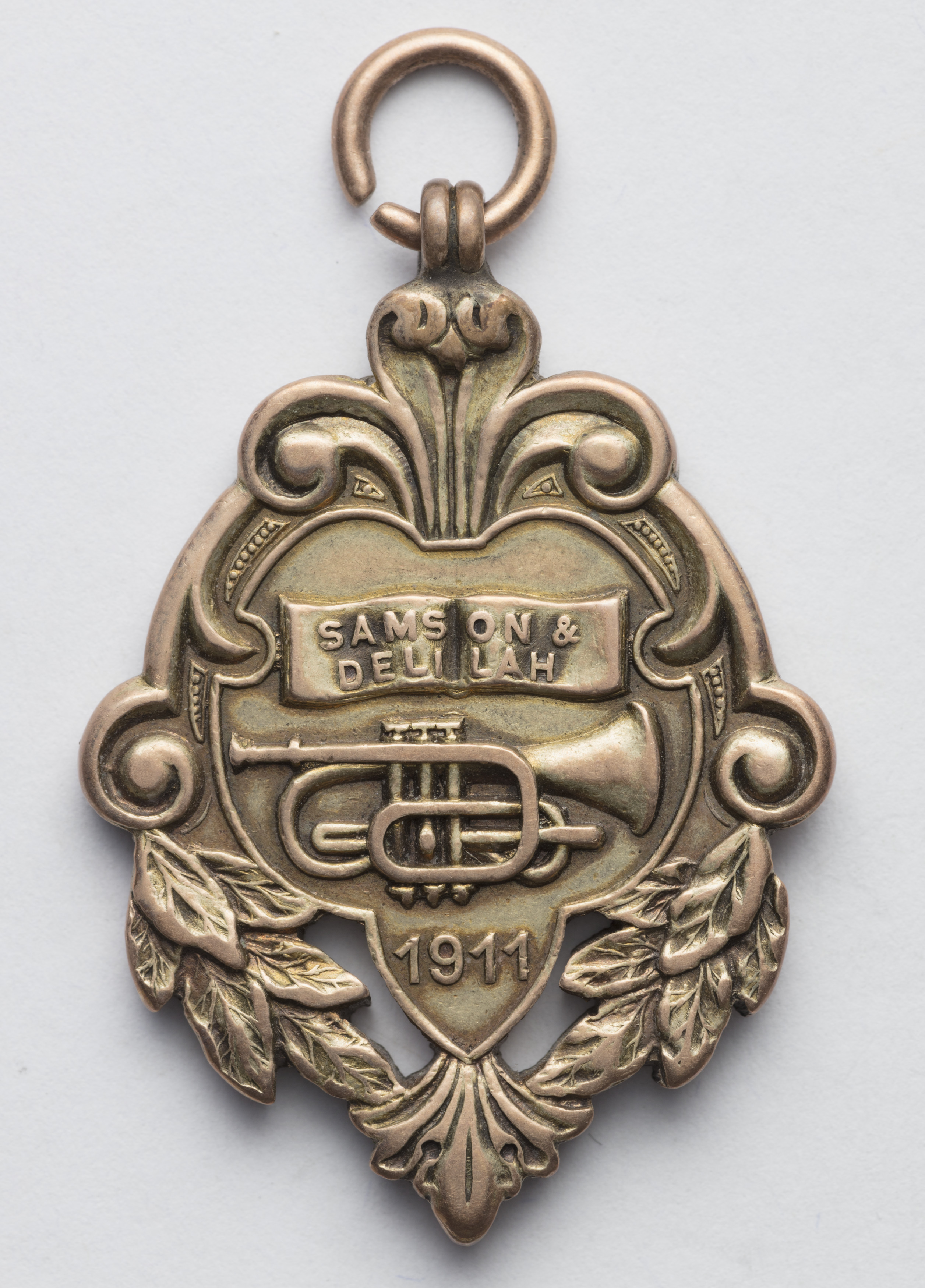
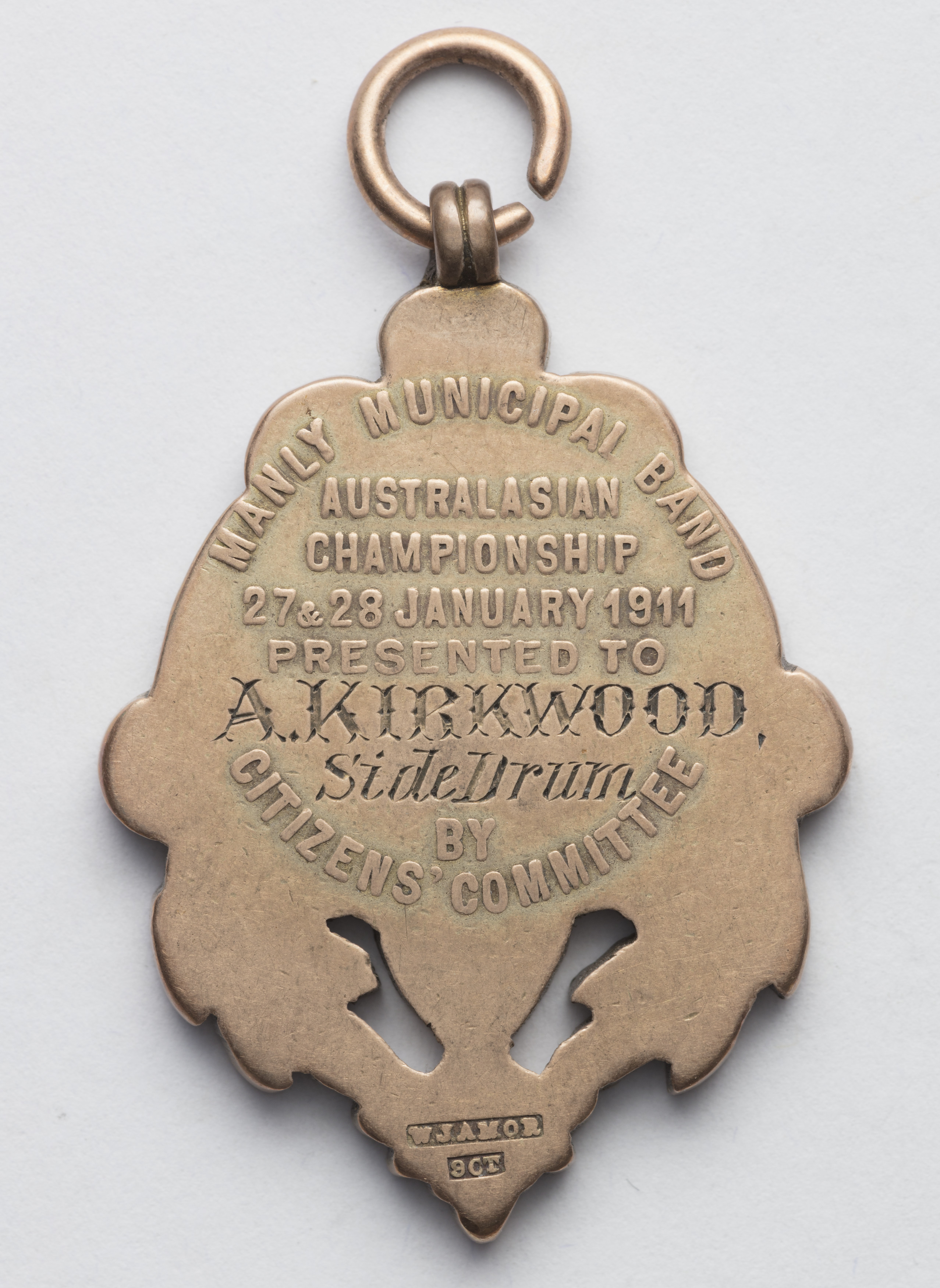
Items in 0698: Awards, Cultural, Manly Municipal Band medals, 1910 and 1911, courtesy State Library of NSW.
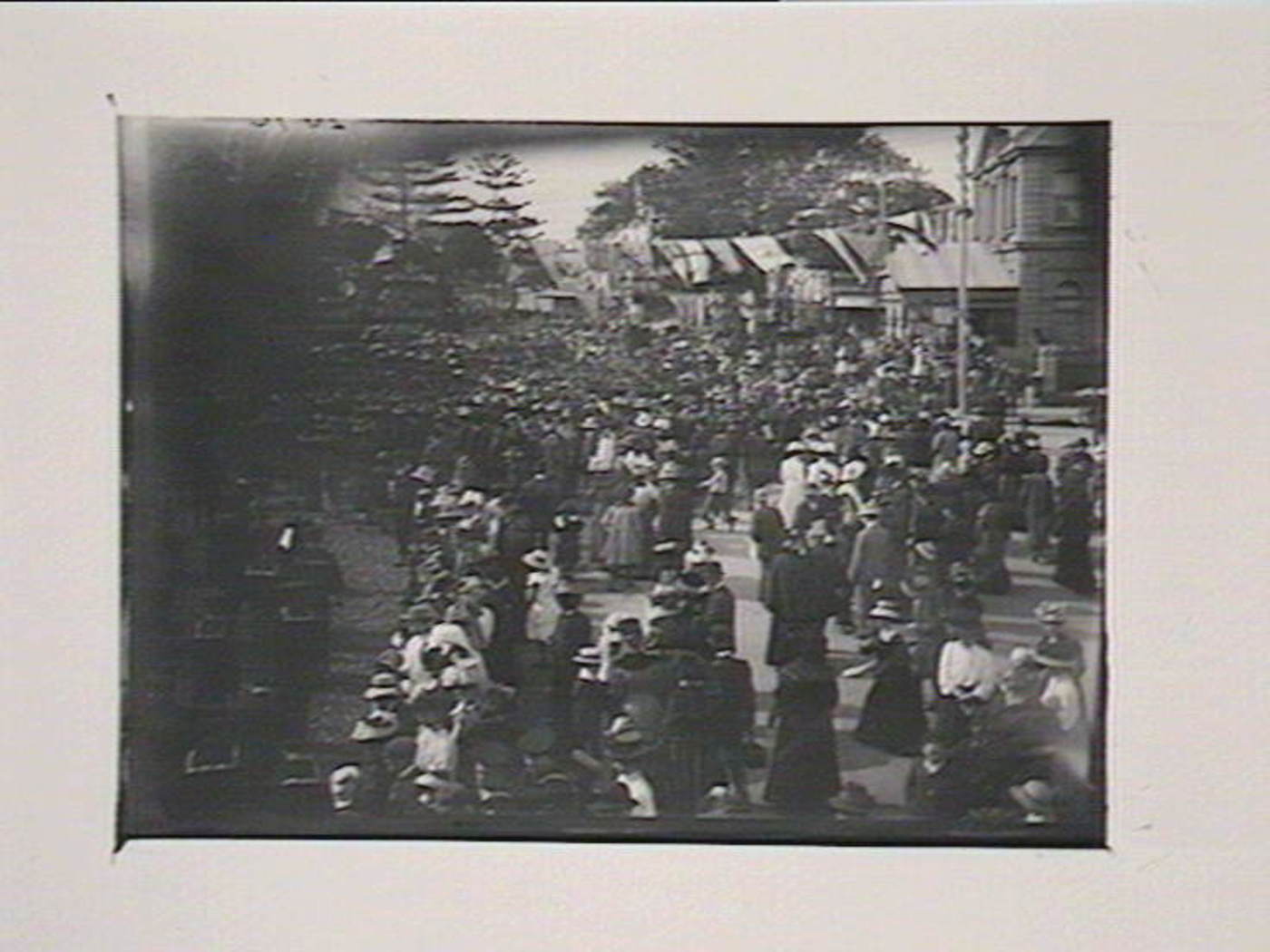
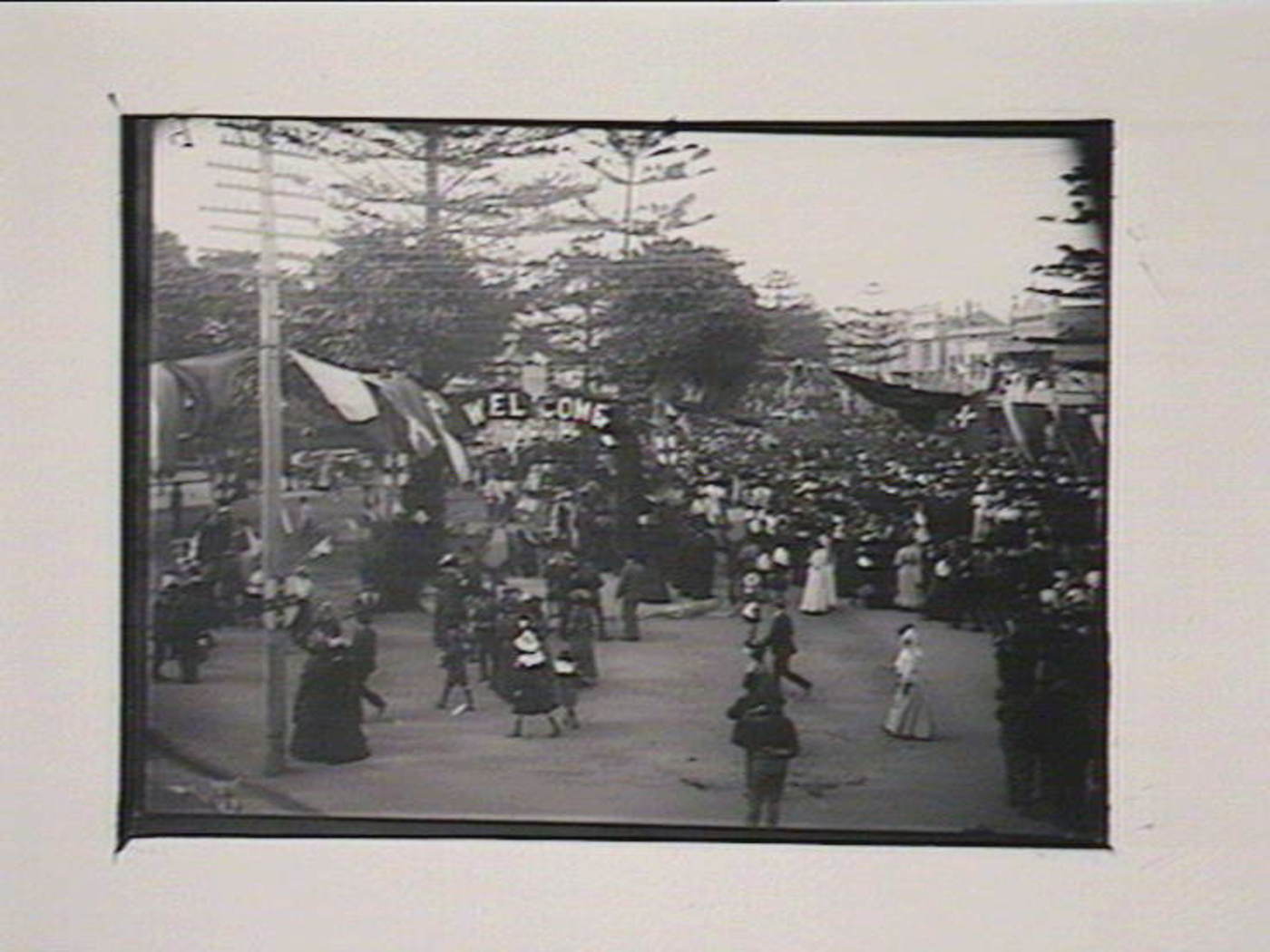
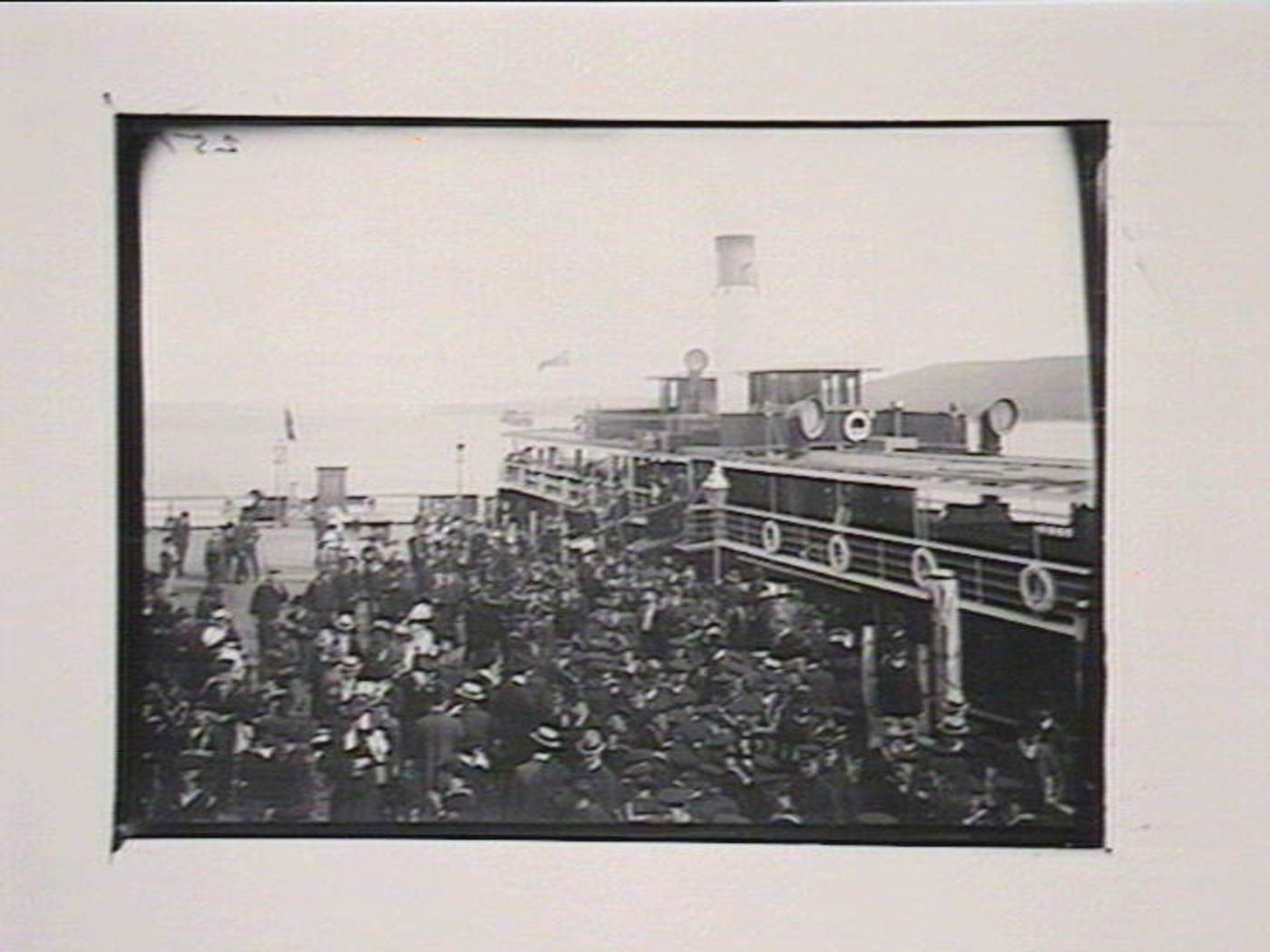
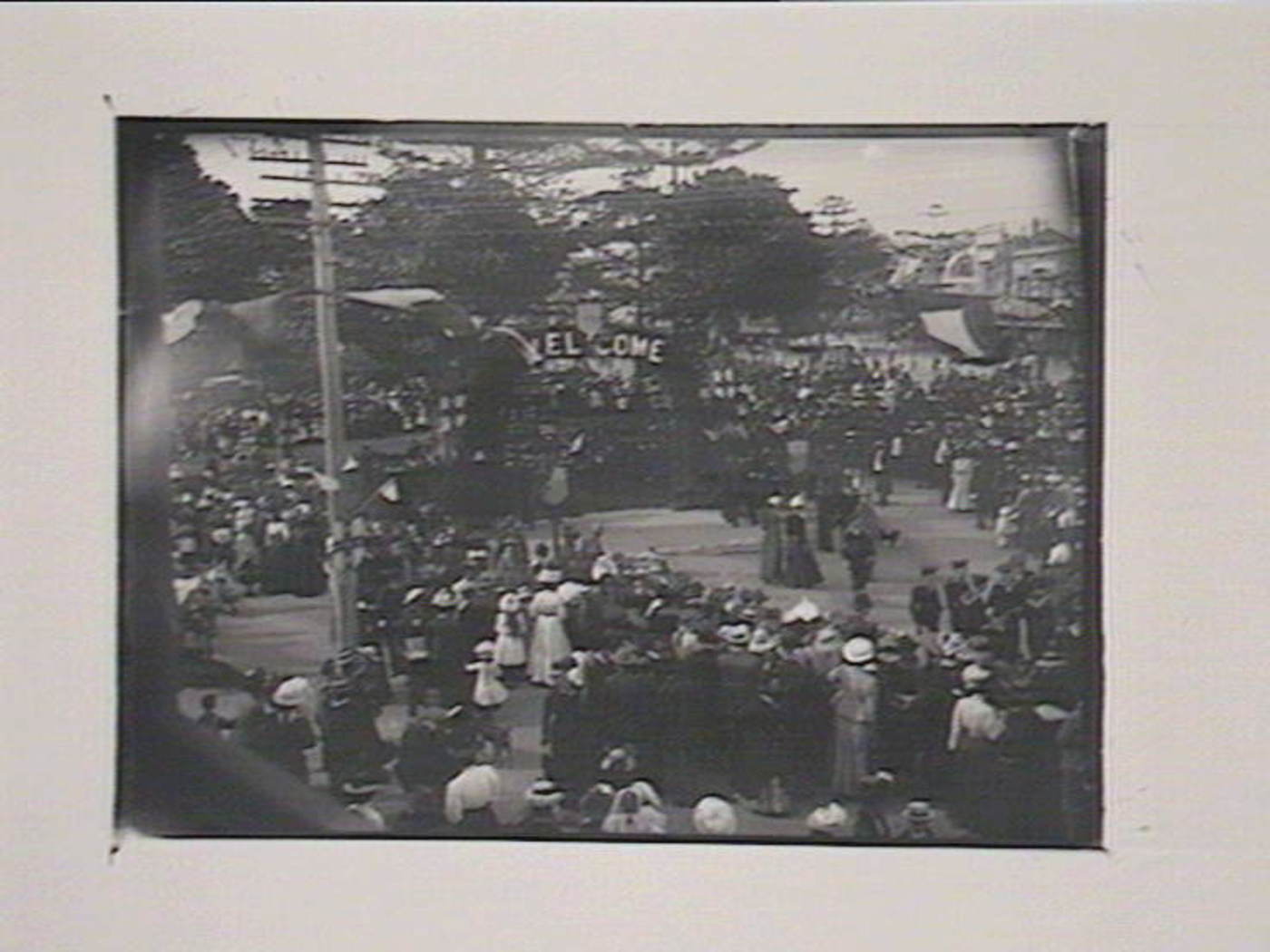
Welcome at Manly: photo items dated 25/8/1908 - From NSW Govt Printer series - American Fleet Visit. Digital order no:d1_49697 - d1_49697h, d1_49696h, d1_49695h, d1_49694h, courtesy NSW State Records & Archives and State Library of NSW.
This item shows the family were members at the Manly Congregational church:
WHITE FEATHERS.
CLERGYMAN AND ALDERMAN. QUARREL AT MANLY. ACTION FOR SLANDER.
An action for alleged slander was set down for hearing before Mr. Justice Pring and a jury in the No. 1 Jury Court this morning. The plaintiff was the Rev. John Frederic Sanders, Congregational Minister at Manly, and the defendant Alfred Albert Edward Ernest Vasa Reid, an alderman of the Manly Municipal Council, and the claim was for £500 damages.
Plaintiff's statement of claim set out that "the plaintiff was a British subject, and minister of the Congregational Church at Manly, and this country, as part of the British Empire, was en-gaged in war, and the defendant falsely and maliciously spoke and published of the plain-tiff the following words: 'He said that when the war commenced the young ladies of certain establishments posted white feathers to certain young gentlemen who had not offered to enlist. Now, these women, he said, made a great mis-take, because they did not understand the matter at all. The young men, he said, knew their own business best. Now what can you infer from that. What conclusion can you draw. Why, that they were quite right in not offering their services. They knew their own business best. I would like to know what right has a young parson like Sanders to get up in his pulpit and incite young men not to enlist,' meaning thereby that the plaintiff was disloyal and unpatriotic, and was endeavoring to prevent young men from offering their services to fight on behalf of this country and against its enemies, and that the plaintiff was an undesirable citizen and not a fit person to associate with, and was a dis-credit to his church, and was a minister whom the people ought not to go to near."
...
Charles Foggon, painter and decorator, and a deacon of the Congregational Church at Manly said that he attended the public meeting on June 13 at which defendant criticised Mr Sanders' sermon on "White Feathers". Defendant asked what right had a young parson to get up in his pulpit and incite young men not to enlist. He also said that in another sermon, Mr Sanders had told the people not to take notice of all the saw in the newspapers. They should read between the lines, as the papers were biased. Reid asked, "Where are we to get our information from if not from the papers?" He also said, "Where does he get his information from? Evidently from the other side, from his German sympathisers." He also warned the people "not to have anything to do with such wasters." Since ... the attendance at the church had fallen off considerably.
To Mr. Broomfield: On a previous occasion plaintiff preached a sermon called "Counted Out". He did know that plaintiff attack-ed Mr Reid in this sermon. Plaintiff, the Rev. J F Sanders, next gave evidence. He said he came out from England ... March ... to take charge of the Manly Church. He had never discouraged recruiting. Such a thing would have been absolutely con-trary to all his prior sermons. A verbatim record of the sermon on "White Feathers" was then ... and read to the jury. To Mr. Broomfield: On the Sunday before he had preached a sermon on "Counted Out". He had been counted out at a public meeting, but it was more in fun than in earnest. The people were anxious to get the meeting over. It was a meeting to carry a resolution in favor of interning all Germans of military age, and there was great uproar all the time. On some points he was even more drastic than the resolution. He said they should not in-tern traitors, they should shoot them. His sermon subsequently had no reference to that meeting. He ... used the title "counted out" as a ... to catch people. He had preached a sermon entitled "After dark in Manly." His sermon on the "White Feather" was not an attack on Alderman Reid, the defendant. The object of the sermon was not to hold up the defendant to public censure because of what he had said in the council meeting regarding the resolution to intern Germans. He did not have the defendant in his mind. It was not his object to discuss the policy of the council, but he considered he had a right to refer to the spirit which actuated public men in order to moralise. Mr. Broomfield said he did not think it was the province of a parson to discuss in the pulpit the utterances of public men. His Honor: "Why not? We frequently hear utterances from the pulpit on the frink ques-tion, which is a public subject. It is not so long ago that the Bishop of Bathurst from the pulpit spoke out in the most extroardinarily plain terms. Surely a matter in relation to the war is a public matter, and a parson is entitled to discuss what public men have said." Another suggestion that there should be a settlement was made by his Honor, and ... parties retired, with his Honor to discuss it, bit without coming to any agreement. William Hill Miller said that he heard Al-derman Reid at the public meeting say the words "this low down crawling parson," and also say, "Before I have done with him I will strip his church and hound him out of Manly."
Arthur Thomas Keirle, Mayor of Manly, said he remembered Alderman Reid charging the plaintiff with being a German sympathiser. The defendant then gave evidence. He said he was a general storekeeper, and had been in the council since February last. At a meeting in the Victoria Hall at Manly to discuss the internment of Germans, Mr. Sanders got a very hostile reception on account of his remarks. He said "If you intern the Germans, what are you golng to do with their sympathisers. The crowd shouted "Shoot tbem," and he replied, "Well, you will have to shoot yourselves." He was hooted, and got the most hostile reception of any speaker at the meeting. Afterwards wit-ness said to him, "I am sorry for you: you ought to judge the pulse of the meeting, and be care-ful what remarks you make." He replied, "I don't care. I can put up with it." They shook hands and parted as friends. Subsequently, at a meeting of the council, when discussing the motion sent out to other councils from Manly, about the internment of Germans, witness said, "Any man who occu-pies a public position should always be pre-pared to speak on any matter that comes be-fore the council, and give his opinion, or he is not fit to be a representative of the people. Any alderman who refuses to discuss this question is exhibiting the white feather." He subsequently heard the sermon delivered by Mr. Sanders, and spoke about it at the public meeting. He said that "Sermons of that char-acter might incite men not to enlist." He referred to the Domsln orators as "crawlers," not to Mr Sanders. He did not say be would "strip his church and hound him out of Man-ly." At a Iater meeting, witness said there were only two sides to the anti-German ques-tion, either for or against it, and those who were against the work of the league were showing sympathy to the enemy. He said Mr. Sanders had preached a sermon against the league. To Mr. Breckenridge: Witness did not care much for people who sympathised with Ger-mans. He had no feeling against Mr. Sanders. "I have offered him my hand," said witness, "and he won't shake hands with me." His Honor: I wish you would go down and shake hands now. Witness: I would, but he wants to drag me down into the dust. He wants to drag me down before the public, and I won't do it." William Henry James said defendant had used the words, "Sermons of this character may incite young men not to enlist." He did not say Mr. Sanders was "a low-down crawl-ing parson," but said he would hound him out of Manly. Other witnesses contradicted the evidence given by plaintiff as to the remarks attri-buted to defendant. The effect of his words was that sermons of this nature might incite young men not to enlist. He did not say he would hound Mr. Sanders out of Manly. This concluded the evidence. "I think this ... unfortunate litigation," said his Honor in summing up. "Here you have two gentlemen, both occupying high pub-lic positions, and both actuated by the very best motives. Yet because there is a ... rift between them, matters drift on until the case comes before you." His Honor added that ther was very little difference between the statements made by the plaintiff's witnesses as to words used by defendant about inciting young men, and what defendant himself admitted saying. The jury would probably have very little difficulty in de-ciding that the use of such words at a ... the p... was slanderous. In times like these it was the duty of all to help the ... A clergyman has just as ... a ... as an alderman or a legislator, and ... ... to give expression to his opinions ... The ... of ... .... not too surprised if his ... man .... There was no question ... ... the defendant, and if a man were ... he must expect retaliation. THE VERDICT The jury met in retirement ... return ... for plaintiff ... damages... His Honor ... declined to grant a certificate of costs ................. plaintiff had brought this criticism on his own head. He had made use of his position .......... disparaging remarks about ........................ expect retali- ation. ................................. brought ... court. WHITE FEATHERS. (1915, December 10). Evening News (Sydney, NSW : 1869 - 1931), p. 5. Retrieved November 17, 2020, from http://nla.gov.au/nla.news-article115267890
Charles junior witnessed a man digging a tunnel through Queenscliff headland to Freshwater (now Harbord) which was a short cut and at that time a novelty. He was one who went through it when completed.
2083 Trooper Charles FOGGAN. From: http://alh-research.tripod.com/Light_Horse/index.blog/1929231/3rd-nsw-imperial-bushmen-nominal-roll/
RAILWAY NOTICES.
GOVERNMENT RAILWAYS.
Departure of Bushmen's Contingent for South Africa on WEDNESDAY, 28th~FEBRUARY, 1900.
Special Cheap Excursion to Sydney will be issued at specially low fares will be leaving NEWCASTLE 6.10 a.m. on above date,
available for return up to and including Wednesday, 21st March, 1900, bhy any ordinary Train except the through mail leaving Sydneyat 6.16 p.m.
Return Fares from Newcastle to Wynyard 12s 9d lst class, 8s.Od 2nd Class.
Handbills and further particulars be obtained from all station masters.
By order of the Commissioners.
H. M'LACHLAN, Secretary. Advertising (1900, February 23). Newcastle Morning Herald and Miners' Advocate (NSW : 1876 - 1954), p. 8. Retrieved from http://nla.gov.au/nla.news-article133214344
The 3rd New South Wales Imperial Regiment, which Charles Foggon became a Trooper of, was raised at Klerksdorp, Transvaal, on 4 May 1901. It was formed with men drafts of 230 officers and other ranks who were intended for the New South Wales Imperial Bushmen and the Citizens' Bushmen but who were instead formed into a separate regiment under the command of the Honourable Rupert Carington. Operating as part of Lieutenant Colonel E.C. William's column, the bushmen took part in all of the column's engagements, except Karanafontein, serving in the Transvaal and marching over 4,000 miles.
From May to October the column operated in west Transvaal, where it captured many prisoners and supplies. For example, after a running fight of 12 miles with the Boers at Koldersdrai on 24 May 1901 and a skirmish the column captured 19 prisoners, 600 cattle, and 1,000 sheep. On 20 August, after a 50 mile night march, the column skirmished with the Boers near Wolmanstadt. One hundred wagons were captured, so too was livestock and "many" wounded Boers. In October the column moved to the east Transvaal, where it took part in General Hamilton's operations against the Boer.
In January 1902 a new squadron for the regiment was formed in Cape Town from Australians already in the country, as was another squadron in February. This brought the strength of the regiment to over 500. About 1,000 men in total are thought to have served in the unit, although it had no more than 600 at any time.
In May some of the men whose time had expired returned to Australia in the transport Ansonia but many more, and all the officers, volunteered for further service. Those who stayed were reinforced by 200 Victorian Riverina bushmen, raised by J.S. Horsfall.
The regiment spent the remainder of its time serving with Williams' column in west Transvaal, until peace was declared in June 1902. On 12 July 1902 the regiment sailed from Durban, Natal, for Australia, on board the transport Drayton Grange, and arrived in Sydney on 11 August.
As Charles did not return until 1906, he clearly spent some time elsewhere as well, possibly staying in Africa, as some of the Australians did. He later took over the leadership of the Boy Scouts from Bob Adrian. The troop soon consisted of 76 boys, and we often marched to Narrabeen at week-ends for scouting purposes.
Family Records:
Charles Foggon (Foggan) – Painter
SILVER WEDDINGS
FOGGON- DAVIS -February 8, 1879, at Methodist Parsonage, Morpeth, N S Wales by the Rev. J.A. Foggon, Charles, third eldest son of the late Charles Foggon, Stanley, England, to Margaret Ann Davis only daughter of the late Charles W Davis, of Manly, N.S. Wales. Present address, Eustace-street, Manly. Family Notices (1904, February 8). The Sydney Morning Herald (NSW : 1842 - 1954), p. 6. Retrieved from http://nla.gov.au/nla.news-article14598002
GOLDEN WEDDINGS.
FOGGON — DAVIS. —February 8, 1879, at the Methodist Church, Morpeth, by the Rev. J. A. Foggon, Charles Foggon to Margaret Ann, only daughter of the late C. W. and M. Davis, late of Manly, N.S.W. Present address: Vera, Honour-avenue, Lawson. Family Notices (1929, February 8). The Sydney Morning Herald (NSW : 1842 - 1954), p. 12. Retrieved from http://nla.gov.au/nla.news-article16529788
Children of the Union
FOGGON CHARLES 20507/1880 CHARLES MARGARET ANN LAMBTON
FOGGON MARIA J 15797/1884 CHARLES MARGARET A BERRIMA
FOGGON MARGARET A 17087/1886 CHARLES MARGARET A BERRIMA
FOGGON JOSEPH G 26174/1890 CHARLES MARGARET A NOWRA
LOCAL NEWS.
ACCEPTED TENDER.--The tender of Charles Foggon, at £25, has been accepted for repairs to the Gerringong Public School. LOCAL NEWS. (1893, July 18). The Kiama Independent, and Shoalhaven Advertiser (NSW : 1863 - 1947), p. 2. Retrieved from http://nla.gov.au/nla.news-article106115421
Paddington.— Externally limiting Victoria Barracks. Charles Foggon, Manly, £400 16s fid. Six weeks. BUILDING AND CONSTRUCTION. (1903, May 5). The Daily Telegraph (Sydney, NSW : 1883 - 1930), p. 6. Retrieved from http://nla.gov.au/nla.news-article237562033
Externally Painting Victoria Barracks, Paddington— Charles Foggon, Manly. Government Gazette Tenders and Contracts (1903, May 8). Government Gazette of the State of New South Wales (Sydney, NSW : 1901 - 2001), p. 3443. Retrieved from http://nla.gov.au/nla.news-article226365092
Death:
DAVIS.—The Friends of the late Mrs. MARIA DAVIS are kindly invited to attend her Funeral, which will leave her daughter's residence, Woodlands, 21 Belgrave-street, Manly, THIS (Saturday) AFTERNOON, at 3 o'clock, for Manly cemetery.
DAVIS.—The Friends of Mr. and Mrs. FOGGON, Senior, are kindly invited to attend the Funeral of their dearly loved MOTHER, Mrs. Maria Davis; to leave their residence, Woodlands, 21 Belgrave-street, Manly, THIS (Saturday) AFTERNOON, at 3 o'clock for the Manly Cemetery.
DAVIS.—The Friends of CHARLES, MATTHEW, JOE, MYRA, MAGGIE, AMELIA, LATINA, and MAY FOGGON are kindly invited to attend the Funeral of their late dearly loved GRANDMOTHER, Mrs. Maria Davis; which will leave their residence, Woodlands, 21 Belgrave-street, Manly, THIS (Saturday) AFTERNOON, at 3 o'clock, for the Manly cemetery. Family Notices (1910, March 5). The Sydney Morning Herald (NSW : 1842 - 1954), p. 28. Retrieved from http://nla.gov.au/nla.news-article15162130
FOGGON JOSEPH G 29/1915 CHARLES MARGARET A SYDNEY
FOGGON. -January 7, 1915, at Sacred Heart Hospice, Victoria-street Darlinghurst Joseph Grundy, dearly beloved youngest son of Mr and Mrs Charles Foggon, 21 Belgrave street, Manly, aged 24 years and 11 months.
FOGGON. - T-imnrv 7 ion at Sacred Heart Hospice, Victorli street Darlinghurst Joseph Grundy, dearly beloved brother of Mr and Mrs C Foggon, Jun., Enfield, aged 24 years and 11 months
FOGGON. - January 7 10!r>, at Sacred Heart Hospice ..dearly beloved brother of Mr and Mrs Harry Foggon, of Brisbane, aged 24 years and 11 months
FOGGON. - of Mon and Mde Mouream, of Rushcutter Bay
FOGGON. - January 7 1915 at Sacred Heart Hospice, .. brother of Mr and Mrs Thomas Hartigan, of Springwood aged 21 years and 11 months
FOGGON. - dearly beloved brother of Mr and Mrs C W Ambler, of Eskbank, a
FOGGON -J inuarv 7 1015, at Sacred Heart Hospice, Y letona street Darlinghurst Joseph Grundy, dearly beloved brother of Miss Amelia and Mary Foggon, Family Notices (1915, January 8). The Sydney Morning Herald (NSW : 1842 - 1954), p. 6. Retrieved from http://nla.gov.au/nla.news-article15536625
NSW BDM’s Deaths
FOGGON CHARLES 6006/1969 Parents: CHARLES WILLIAM MARGARET ANN SYDNEY
FOGGON CHARLES W 13639/1931 CHARLES W 76 YRS KATOOMBA KATOOMBA
FOGGON MARGURET A 19822/1930 CHARLES W MARIA KATOOMBA
FOGGON. — September 12th, 1931, at the residence of his daughter, Mrs. T. Hartigan, "Maxwolton," Delhunty Street, Katoomba, Charles Foggon, dearly loved father of Charles Foggon, of Pendle Hill, Henry Foggon, of Strathfield, Mrs. T. Mourcax, of Lane Cove, Mrs. T. Hartigan, of Katoomba, Mrs. A. Jacques, of Gosford, Mrs. R. Ambler, of Ryde, Miss M. Foggon, of Lidcombe. Aged 76 years. At rest. Family Notices (1931, September 14). The Daily Telegraph (Sydney, NSW : 1931 - 1954), p. 6. Retrieved from http://nla.gov.au/nla.news-article246703946
John Lewis Chester - Notes
Lieutenant John Lewis Chester of the Australian Garrison Artillery was appointed to New South Wales area Number 17A for the region of Mosman with the rank of Lieutenant while holding Temporary Appointment as Area Officer. From: http://alh-research.tripod.com/Light_Horse/index.blog?topic_id=1105080
Enlisted in 1914 – became Captain in 3rd Battalion and was in Landing at Gallipoli – was part of offensive on Geba Tepe and offensive – first 4 days
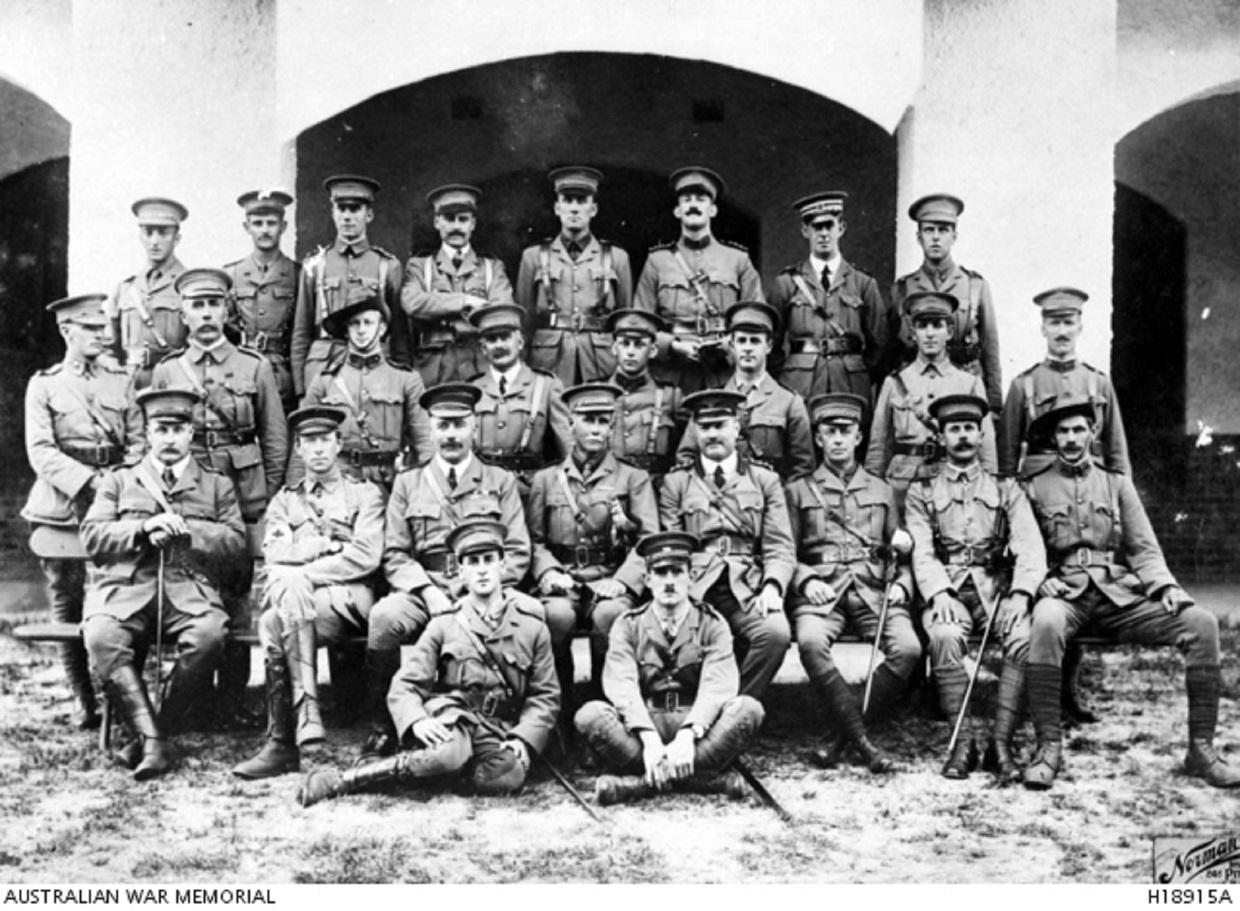
Photo: Group portrait of the Commanding Officer and other officers of the 3rd Battalion, AIF, at Kensington racecourse, September 1914. Identified in the back row, from left to right: Lieutenant (Lt) Cedric Errol Meyer Brodziak (later awarded the DSO and killed in action in France on 31 August 1918); Captain (Capt) Ronald Burns (later killed in action at Gallipoli on 25 April 1915); Lt William Christian Beeken (later killed in action at Gallipoli on 6 August 1915); Capt John Carandini Wilson (later died on 21 May 1915 of wounds received at Gallipoli); Lt Ronald Orlando Cowey (later promoted to Major); Lt David McConaghy (later promoted to Lieutenant Colonel, awarded CMG and DSO and died of wounds in France on 9 April 1918); Capt Leonard Sydney Kent Stevenson, Transport Officer; and Lt Lawrence Whistler Street (later killed in action at Gallipoli on 23 May 1915).
Second row from left to right: Capt John Lewis Chester; Capt Charles Edward Leer (later killed in action at Gallipoli on 25 April 1915); Lt Edward MacFarlane MacFarlane (later promoted to Captain and died on 2 August 1915 from wounds received at Gallipoli); Lt Colin Austin (later Temporary Major and killed in action at Gallipoli on 8 August 1915); Lt Harold Edmund Butler (later Captain);
Lt Eric George Goldring (wounded in action at Gallipoli and returned to Australia in March 1916);
Lt Owen Glendower Howell-Price (later awarded the DSO and MC and died of wounds in France on 4 November 1916); and Lt George Edward McDonald (later Captain).
Third row from left to right: Capt George Wall, Quartermaster (later promoted to Lieutenant Colonel and awarded CMG); Capt John Willoughby Butler Bean, Medical Officer; Major Alfred Joshua Bennett DSO (later Lieutenant Colonel and awarded CMG); Lieutenant Colonel Robert Haylock Owen, Commanding Officer (later awarded CMG); Capt Ernest Samuel Brown, Adjutant (later killed in action at Gallipoli on 8 August 1915); Capt Malcolm St John Lamb (later Lieutenant Colonel); Capt Thomas Oscar Smith (later killed in action at Gallipoli on 7 May 1915) and Capt William Bowman Douglas (later died on 5 May 1915 of wounds received at Gallipoli).
Front row from left to right: Lt Harold William Goldring (later wounded at Gallipoli and returned to Australia in March 1916); and Lt Kenneth John Hinde (later killed in action at Gallipoli on 5 May 1915)
John Lewis Chester - Birth date:09/08/1884. Mother's name: Emily Eglantine Bernays. Father/parent's name: Charles Henage Bagot Chester.
Mr. Chester, an Accountant, was part of the Narrabeen Community and later, after marrying his second wife, Jean Coxon whom he met while serving overseas, lived at Manly. They were also friends with the Rowohl family, who were part of the ‘Girl Aids group of Manly from 1909 and the first Girl Guides Group of Manly:
NARRABEEN PROGRESS ASSOCIATION
At the annual meeting of the Narrabeen Progress Association the report referred to the advance of the district, a fact attributed somewhat to the presence of the association. The balance-sheet showed a credit of £4/12/. The meeting recorded its appreciation of the action of the council in placing lifelines on the beach for the safety of bathers. The following officers were elected for the ensuing term: — President, Ald. H. Gordon, J.P ; vice-presidents, Messrs. R. Marshall, J.P., and D. D. M'Lean; hon, secretary, Mr. G. Powell; hon. treasurer, Mr. F. Loder; executive committee, Messrs. A. O. West, J. S. Russell, M'Intosh, Chester, and Hinchcliffe. NARRABEEN PROGRESS ASSOCIATION (1909, January 15). The Daily Telegraph (Sydney, NSW : 1883 - 1930), p. 11. Retrieved, from http://nla.gov.au/nla.news-article238215179
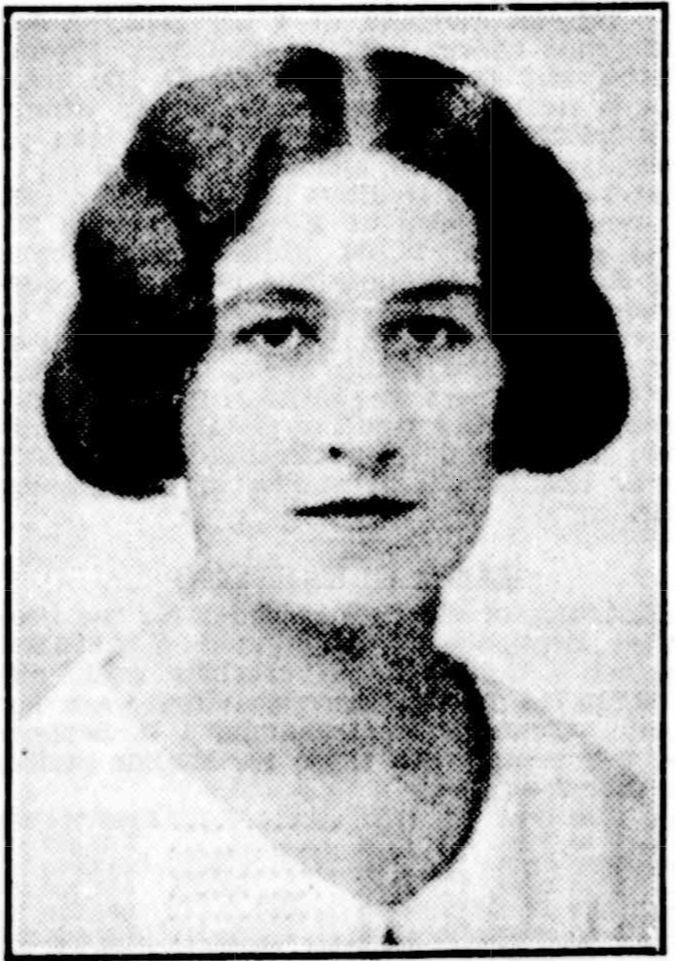
Dr. Willa Rowohl, of Manly, whose marriage with Dr. Selwyn Nelson, of Blayney, will take place on Saturday, was the guest at several functions in her honor during the past week. Mrs. S. Flower and Mrs. J. S. Chester, of Manly, were hostesses at a shower tea at Romano's, at which she was presented with a basket of Radiance roses as well as numerous other gifts.
She was also entertained by fellow ex-students at Sydney High School, where she was presented with a posy of pink carnations and some charming silk and knitted trousseau sets. Other presentations made to the bride-elect were leather travelling-cases from the house staff and X-ray staff at R.P.A. Hospital. Dr. Rowohl has been in charge or the latter department for the past two years; a massive silver entree dish was the gift of fellow graduates at Sydney University. The LIFE OF SYDNEY (1933, May 12). The Daily Telegraph (Sydney, NSW : 1931 - 1954), p. 4. Retrieved from http://nla.gov.au/nla.news-article246241111
Their son, John Bagot Chester who served in WWII as a Gunner, was born December 19, 1920 at Manly to John and Jean Chester – he enlisted May 30th, 1940 at Paddington.
CHESTER JOHN B8819/1920 JOHN L JEAN N MANLY – he died on 27th of June 2011 North Ryde, New South Wales John Bagot Chester.
Parents Marriage: 3170/1917 CHESTER JOHN L COXON JEAN N SYDNEY
MANNSELL—COXON.
A wedding of more than ordinary interest to Lismore people was solemnised at St. Matthew's Church of England, Manly (Sydney), on-July 30th, when Minion, youngest daughter of Mr. and Mrs. E. Coxon, 'Moruga,-' Canaiba, was married to Vero St. John, eldest son of the late Mr. Charles Mannsell, and Mrs. Mannsell, of Brighton, Melbourne ("Vic.). The bride who was escorted to the church and subsequently given away by her brother, Mr. E. Weller Coxon, was attired in her travelling costume, a coat and skirt of nigger brown gabardine, the small droop hat in the same shade was relieved with, touches of royal blue and one of the new long flowing veils to tone. Mrs. J. L. Chester (sister of the bride) was maid of honour, her frock of golden brown Velvet was surmounted by a hat in deeper shade adorned with gold fruit. The bridegroom, was attended by his brother as best man. The bridegrooms gifts were, to the bride a walking cane having a large ajabe knob with solid silver setting, to the maid of honour a signet ring. At the wedding tea, which was held at the Pacific-Hotel, Mrs. Coxon, the. bride's mother, was assisted by her daughter (Mrs. Chester) in receiving and entertaining the guests. Mr. and Mrs. Mannsell will reside at Manly. The gifts received were a very choice lot, and bore testimony to the esteem in which the happy couple are held. Family Notices (1921, September 26). Northern Star (Lismore, NSW : 1876 - 1954), p. 6. Retrieved from http://nla.gov.au/nla.news-article93109133
Lieut. J. L. and Mrs. Chester (nee Sister Jean Coxon), who have both recently returned from the front, are the guests of Mr. and Mrs. E. Coxon, " Moruga," Lismore. Both speak highly of the wonderful work accomplished by the Red Cross Society, without whose assistance life in hospitals would have been very comfortless and sweetless. The sister is the proud possessor of two towels bearing the Booyong-Pearce's Creek branch's stamp, which she received while on the staff of the Harefield Hospital. She also wishes to gratefully acknowledge receipt of a Christmas parcel from the Lismore War Chest, the contents of which were in perfect order. The pipe and tobacco were handed to a sad case of spinal trouble the sister was nursing. PERSONAL. (1919, March 28). Northern Star (Lismore, NSW : 1876 - 1954), p. 2. Retrieved from http://nla.gov.au/nla.news-article92983237
CAPT. AND MRS. J. L. CHESTER HONORED.
On Thursday afternoon last Capt. and Mrs J. L. Chester (nee Coxon), who have been on a visit to Mrs. Chester's sister (Mrs. C. A. Mann), Alstonville, were the guests of the Alstonville Red Cross at afternoon tea. Despite the inclement weather the attendance of patriotic workers, was good, and the function, proved a most delightful one. The welcome took place at Mr. C; Nuttall's refreshment rooms, which were most prettily and tastefully decorated. Mrs. J. A. Daley presided, and amongst the invited guests were the Ven., Archdeacon Lampard, Mrs. F. H. Bartlett (presidents Rous Red Cross), Mr. A. L. Elvery (hon. secretary War Service Committee), Miss Abernethy and Miss E. Cooke (pres. and sec. Girls' Patriotic Club), Mrs. E. Coxon (Lismore), and many others. Apologies for non-attendance were received from Mrs. S. J. Gibson, Miss Edna Smith (president Junior Red Cross), Cr. J. A. Daley, Revs. G. W. McAlpine, Kay Mason, and Mr. C. B. Laidman.
After the National Anthem, Mrs. Daley, in extending a welcome to the guests, mentioned that Capt. Chester left with the famous 3rd Battalion in the first transport that left Australia. He was at the Gallipoli landing, and saw some of the worst fighting there. He was then returned to Australia ill, but he then went back to England, and was in France until September last, when he was returned ill, through a severe attack of pneumonia.
Mrs. Chester for some 18 months did service in Harefield, Southall, and the nurses' hospital at Kensington, where she did splendid work. She was delighted to welcome Mrs. Chester as a Red Cross nurse. The society had done splendid Work, but nothing compared to the work, of the nurses. For this they should get every honor possible. She congratulated them both on their safe return, and, wished them long life and happiness. Mrs. F. H., Bartlett, on behalf of the Rous branch, also welcomed Capt. and Mrs. Chester, and thanked them for what they had done for her by their going across the seas. Archdeacon Lampard, Mr AL Elvery and Miss Abernethy also spoke most appropriate and kindly words of welcome. Mrs. Daley presented Mrs. Chester with a very handsome bouquet, from which hung long streamers, upon which were red crosses. Mrs. Daley also extended a welcome to Mrs. Coxon (who is president of the Caniaba Red Cross Society), and referred to the splendid patriotic work not only of the nurse's mother, but of her sisters Miss Mignon Coxon and Mrs Claude A. Mann.(hon. Secretary of the Alstonville Red Cross. All their work; deeply appreciated. Mrs. Chester, on rising to respond, was loudly applauded. She said she did not deserve half the good things said of her. She could not express to them in words the magnificent work of the Bed Cross Society everywhere. Their work was truly wonderful. The parcels received from the various branches came as rays of sunshine. She valued very much indeed a parcel she received with the name of a branch in this district marked on some of its contents. They could not have managed without the help of the Red Cross Society and other bodies who worked for the soldiers and the nurses, would never be for gotten. She thanked them all for their very kind remarks and delightful-bouquet.
Capt. Chester made a brief response. He too, referred to the work of the Red Cross on the other side. As one who had been seriously ill, he knew what they did, and could assure them it was appreciated by all ranks. He referred to what their grand womenfolk had suffered in silence during the great struggle, waiting for the return of the men. Theirs was a heavy cross, borne with fortitude and in silence. "For, They are Jolly Good Fellows'.' was then sung. Afternoon tea and a pleasant chat was then indulged in, after which the singing of the National Anthem concluded a pleasant afternoon's gathering. CAPT. AND MRS. J. L. CHESTER HONORED. (1919, April 23). Northern Star (Lismore, NSW : 1876 - 1954), p. 6. Retrieved from http://nla.gov.au/nla.news-article92986625
WELCOME HOME
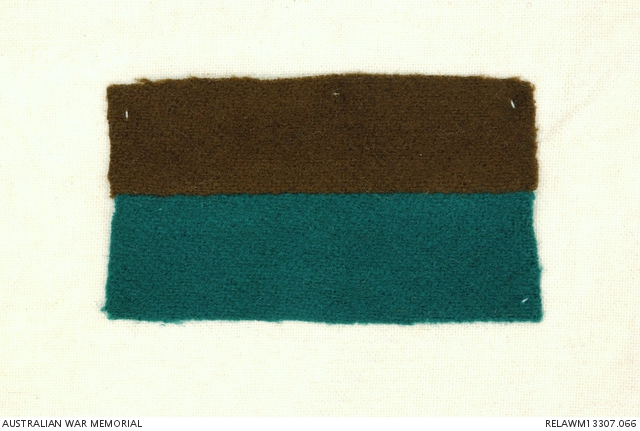 A very pleasant afternoon was spent on Wednesday, ?th inst.', when Mr.-, and Mrs. Coxon, 'Moruga,' Lismore, entertained about -forty guests at afternoon tea at the --'M.G.' Rooms, Lismore. The occasion' was the welcoming home of Captain J. L. and Mrs. Chester (nee Sister Jean Coxon). By a strange coincidence their battalion colors are brown and green, and these colors formed part of the decorative scheme in streamers of bebe ribbon. The table decorations consisted of pink and white roses and ferns, and bowls of the same beautiful blooms, with the Union Jack as a background, completed the pretty effect. The hostess was 'assisted in receiving the guests by Mrs. Claude A.. Munn (Alstonville) and Miss Mignon Coxon. Amongst the guests present were Ald. and Mrs. McKenzie (Mayor and Mayoress of Lismore), Mrs. G. T. Hindmarsh and Mrs. F. N. Harris (president and hon, secretary of Lismore Red Cross Society), Mrs. Clarke -arid Mrs. (Dr.) A. J«\ Parker (president and hon.', secretary Lismore War Chest Society), Mrs. Watson (hon. secretary Soldiers' Aid Society), Miss Butler and Miss A. Parker (president and hon, secretary Lismore Girls' Patriotic Guild), Mrs. .T.- A. Daley- (president Alstonville Red Cross), Airs. Marks (ton. treasurer Cniliaba. Red Cross), Matron Beeby (a returned nurse, now of Lismore District Hospital). A delightful' musical programme, was enjoyed, the singers being 'Misses Hannah Ivann and, Isabel Clarke, M. Coxon, and Major (Dr.) Cahill, Mi-. T. H. Massey 'playing the accompaniments. T
A very pleasant afternoon was spent on Wednesday, ?th inst.', when Mr.-, and Mrs. Coxon, 'Moruga,' Lismore, entertained about -forty guests at afternoon tea at the --'M.G.' Rooms, Lismore. The occasion' was the welcoming home of Captain J. L. and Mrs. Chester (nee Sister Jean Coxon). By a strange coincidence their battalion colors are brown and green, and these colors formed part of the decorative scheme in streamers of bebe ribbon. The table decorations consisted of pink and white roses and ferns, and bowls of the same beautiful blooms, with the Union Jack as a background, completed the pretty effect. The hostess was 'assisted in receiving the guests by Mrs. Claude A.. Munn (Alstonville) and Miss Mignon Coxon. Amongst the guests present were Ald. and Mrs. McKenzie (Mayor and Mayoress of Lismore), Mrs. G. T. Hindmarsh and Mrs. F. N. Harris (president and hon, secretary of Lismore Red Cross Society), Mrs. Clarke -arid Mrs. (Dr.) A. J«\ Parker (president and hon.', secretary Lismore War Chest Society), Mrs. Watson (hon. secretary Soldiers' Aid Society), Miss Butler and Miss A. Parker (president and hon, secretary Lismore Girls' Patriotic Guild), Mrs. .T.- A. Daley- (president Alstonville Red Cross), Airs. Marks (ton. treasurer Cniliaba. Red Cross), Matron Beeby (a returned nurse, now of Lismore District Hospital). A delightful' musical programme, was enjoyed, the singers being 'Misses Hannah Ivann and, Isabel Clarke, M. Coxon, and Major (Dr.) Cahill, Mi-. T. H. Massey 'playing the accompaniments. T
he singing of the National Anthem and 'For They are Jolly Good' Fellows' concluded the programme. Dainty souvenir programmes, with bows of the colors of Capt. and Mrs. Chester, were presented to all present. Mrs. Chester is well known in Lismore, having lived there for some years prior to taking up the nursing profession at Casino District Hospital, where she received all her training.
Captain Chester, an original Anzac, left Sydney in the first transport and participated in the famous Gallipoli landing us a member of the 3rd Battalion. he was returned home ill, but re-enlisted and went to France, from where he was again returned ill, suffering from a severe attack, of pneumonia. Capt. and Mrs. Chester received the hearty, congratulations and good wishes of their, many friends. WELCOME HOME. (1919, April 25). The Richmond River Express and Casino Kyogle Advertiser (NSW : 1904 - 1929), p. 8. Retrieved from http://nla.gov.au/nla.news-article120240460
In fact he was suffering from severe what is termed today Traumatic stress syndrome, the records in his file of War papers note this and that also, then he managed to re-enlist and get sent into France that the same thing occurred there, although he had pnuemonia at the time he was sent to England;
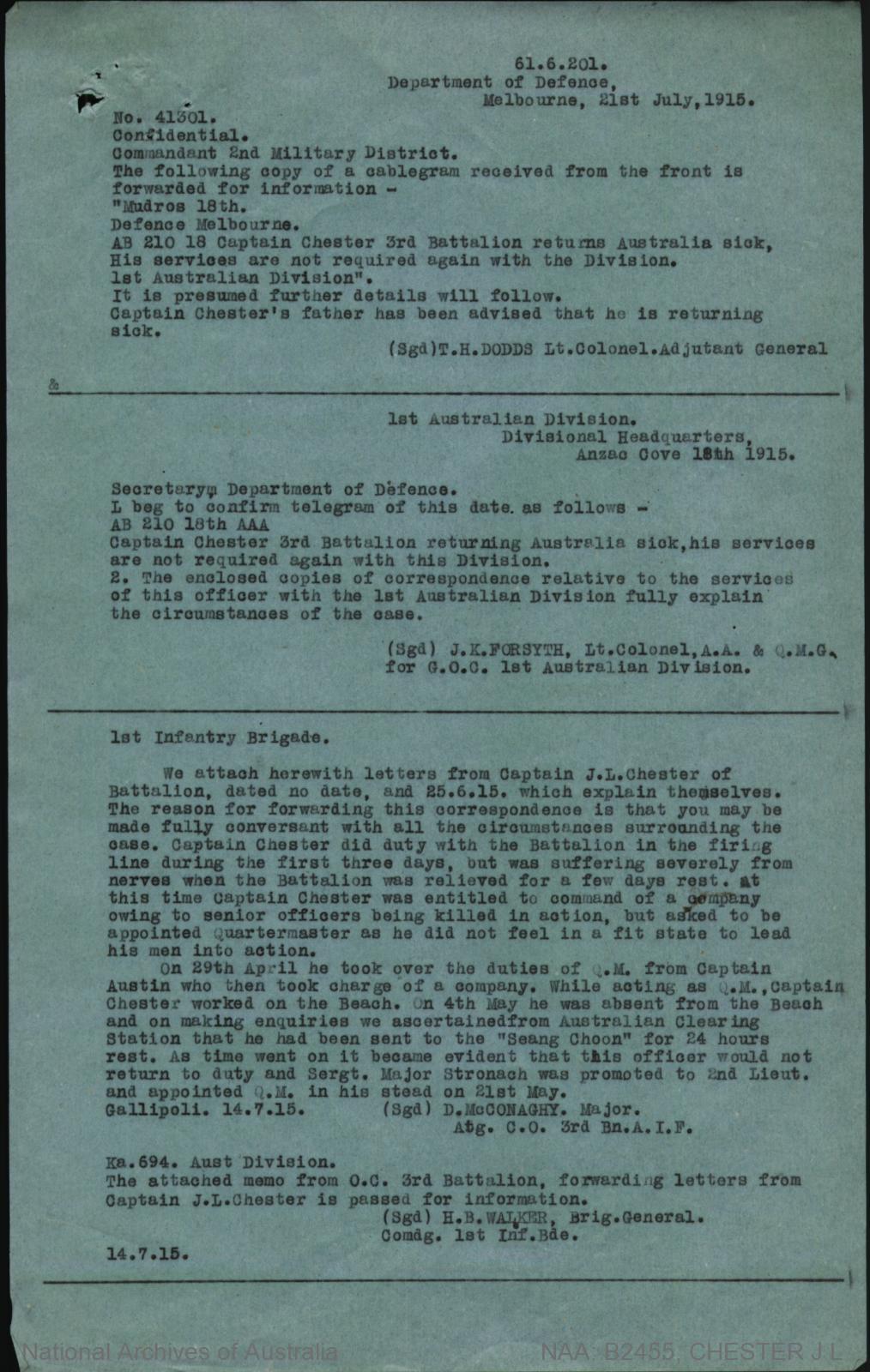
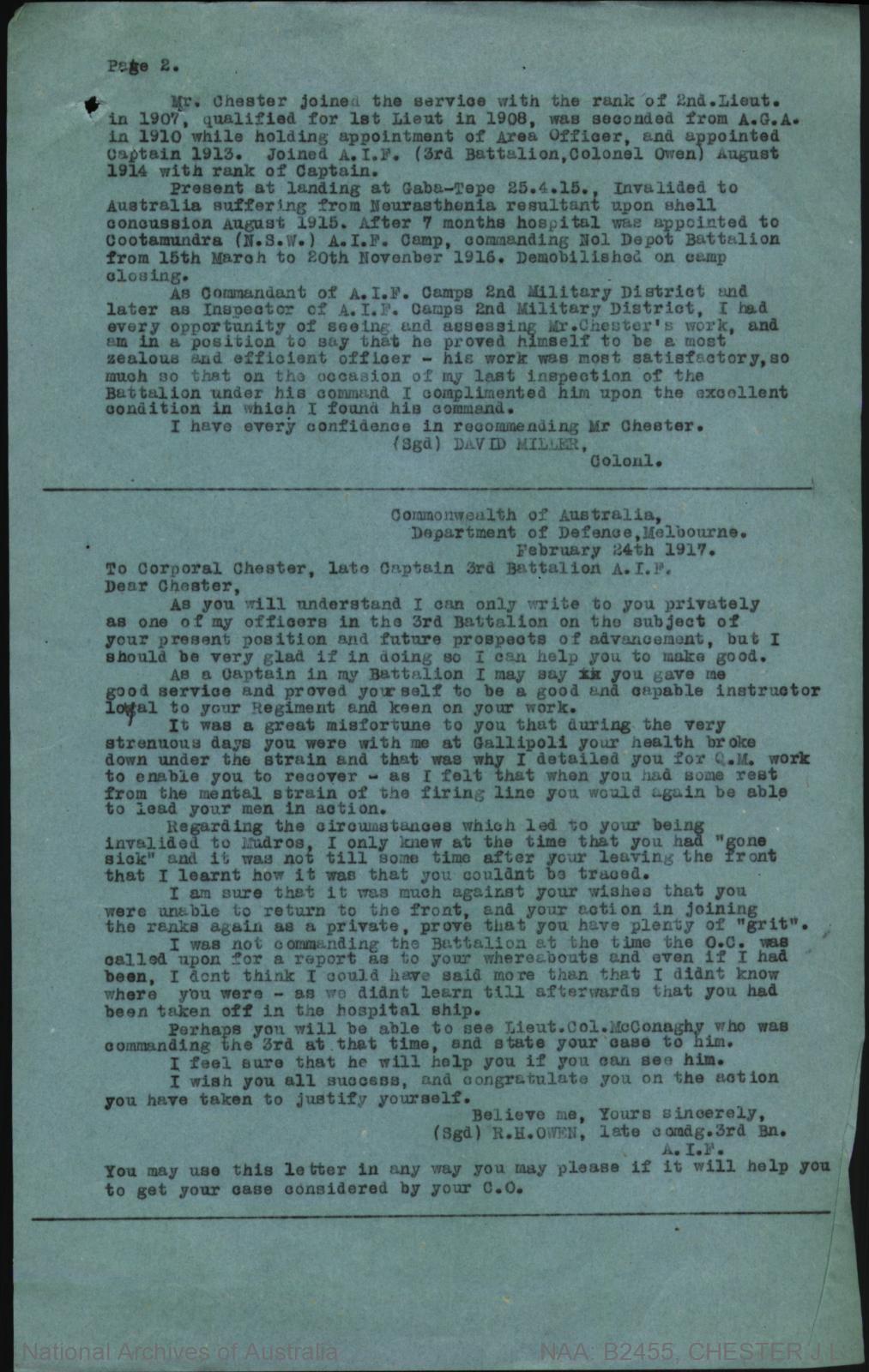
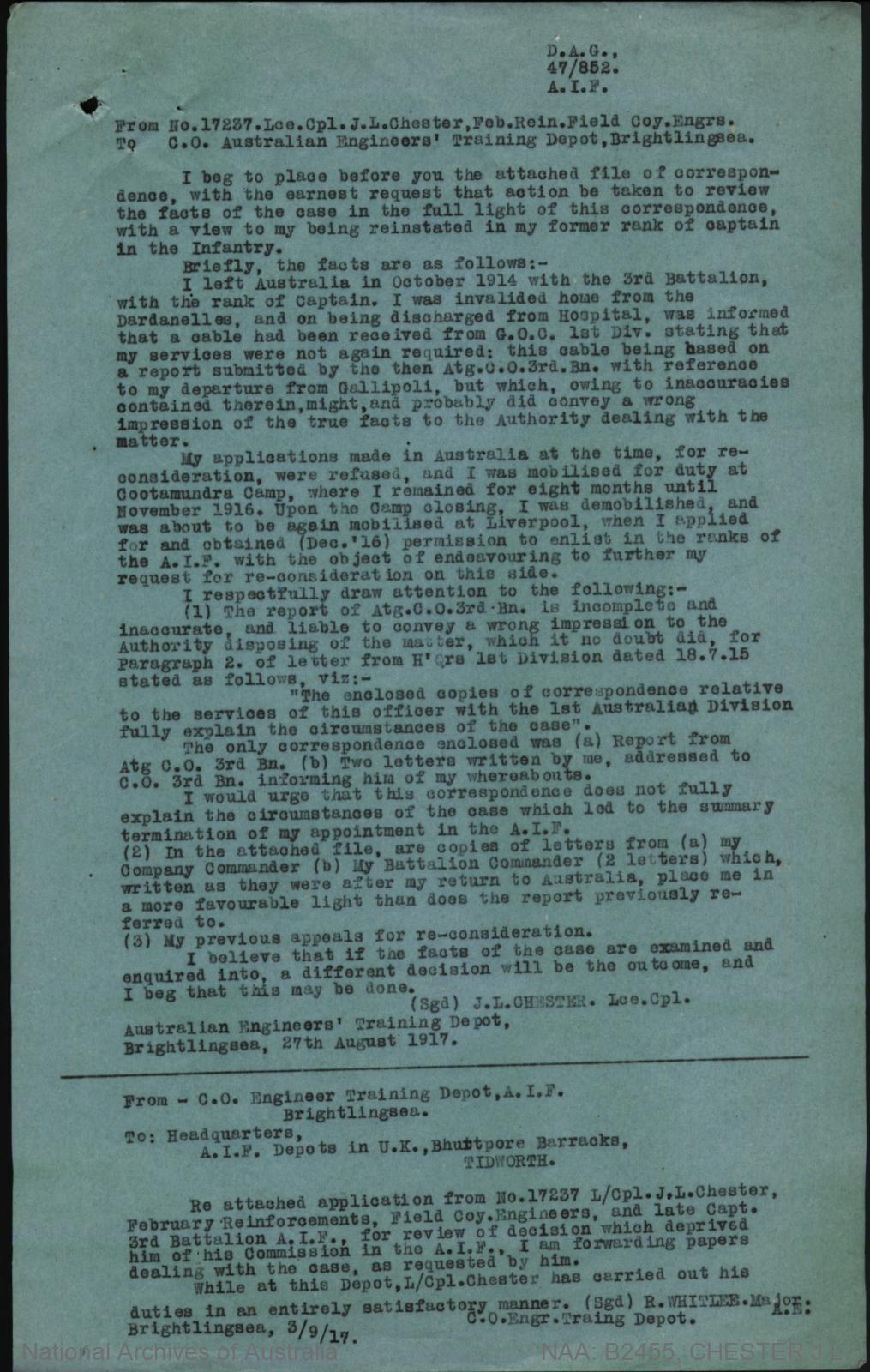
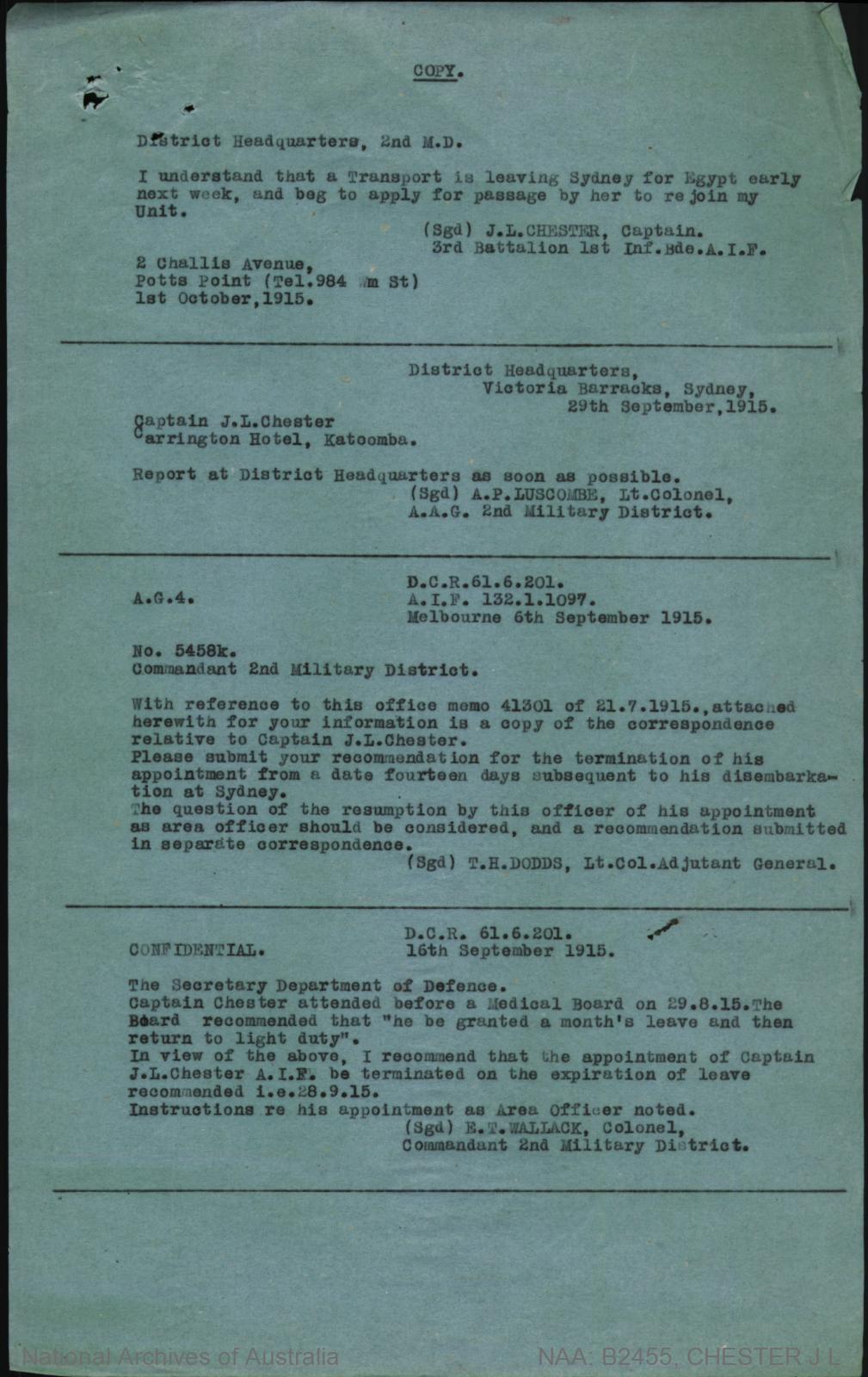
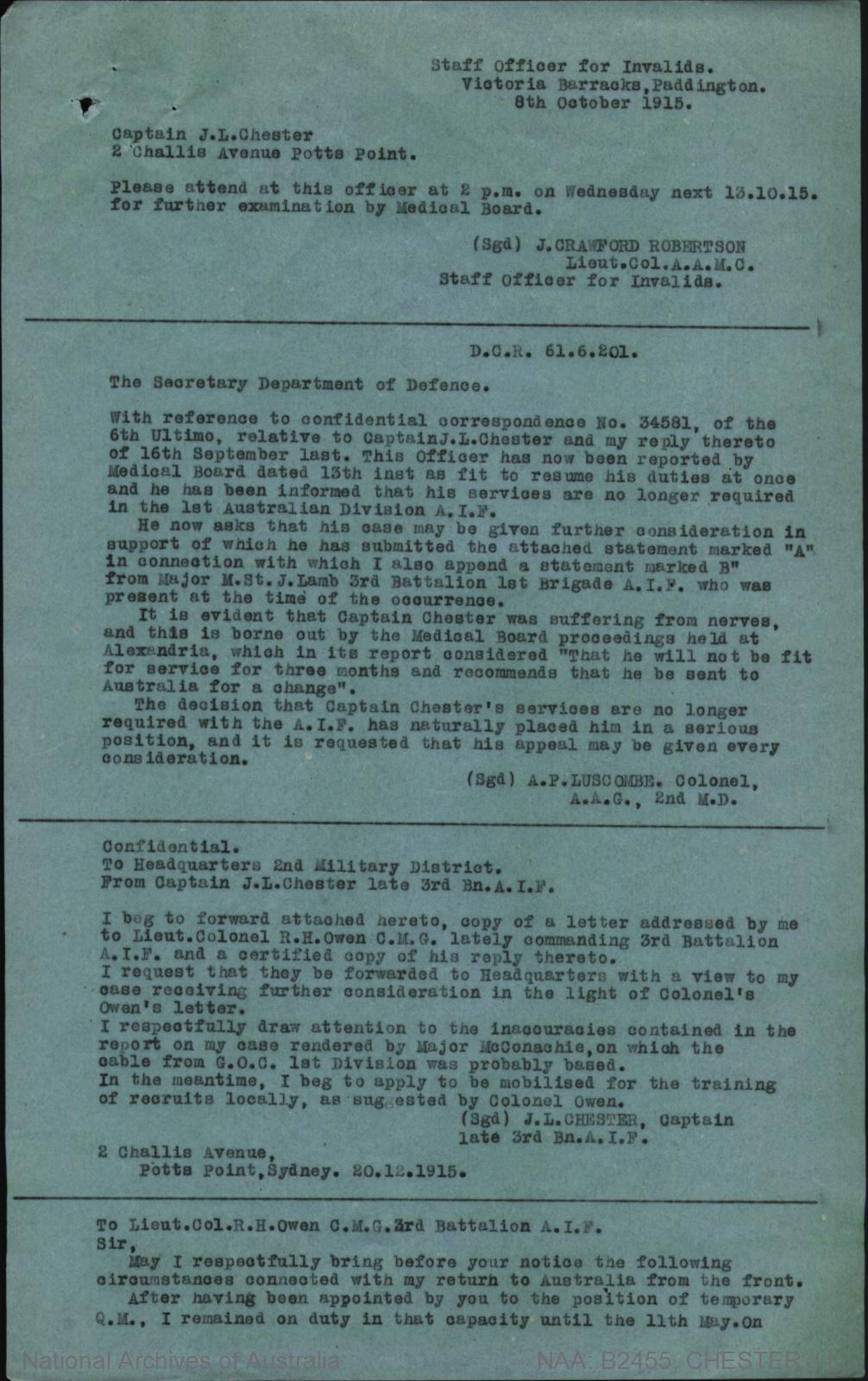
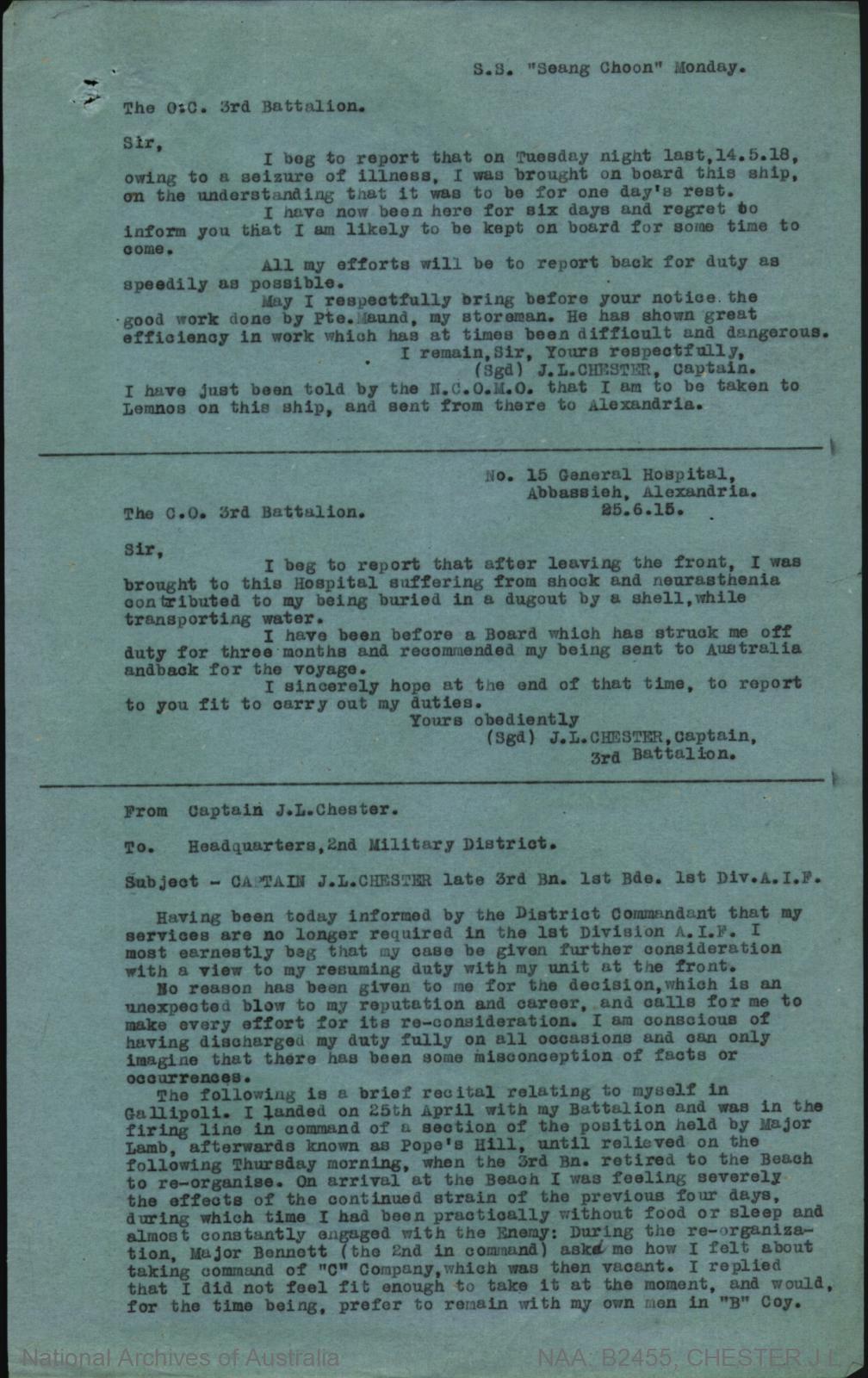
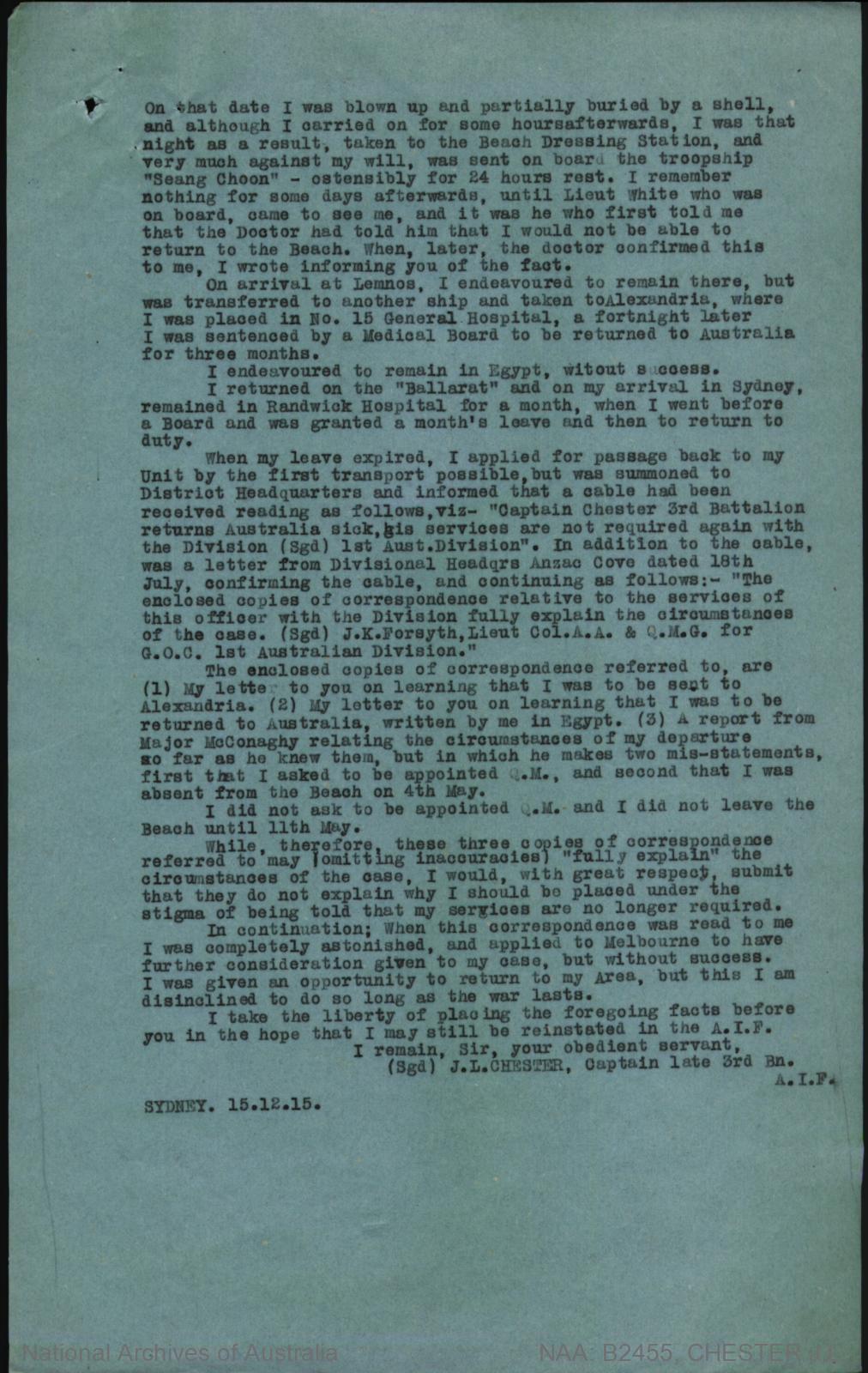
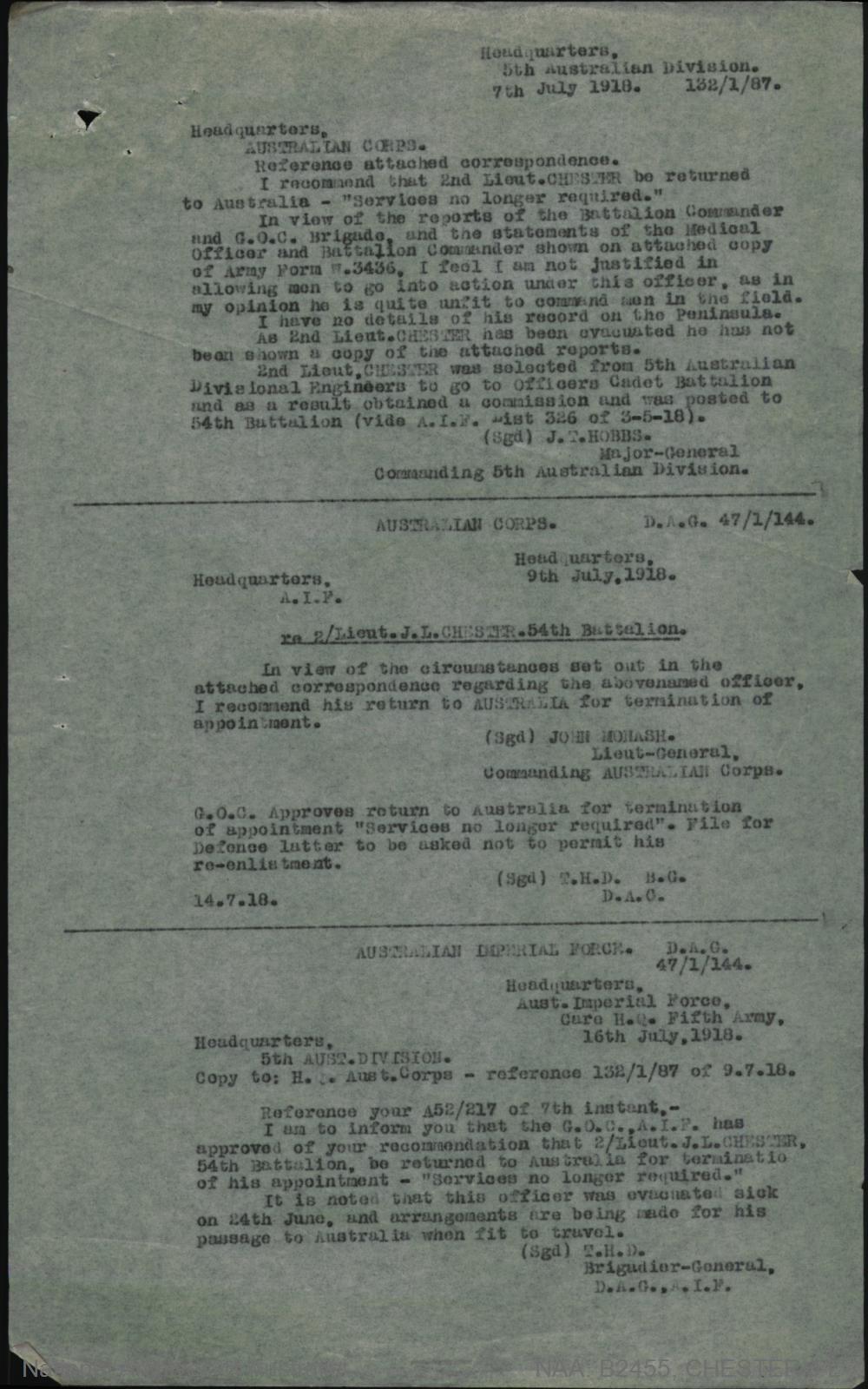
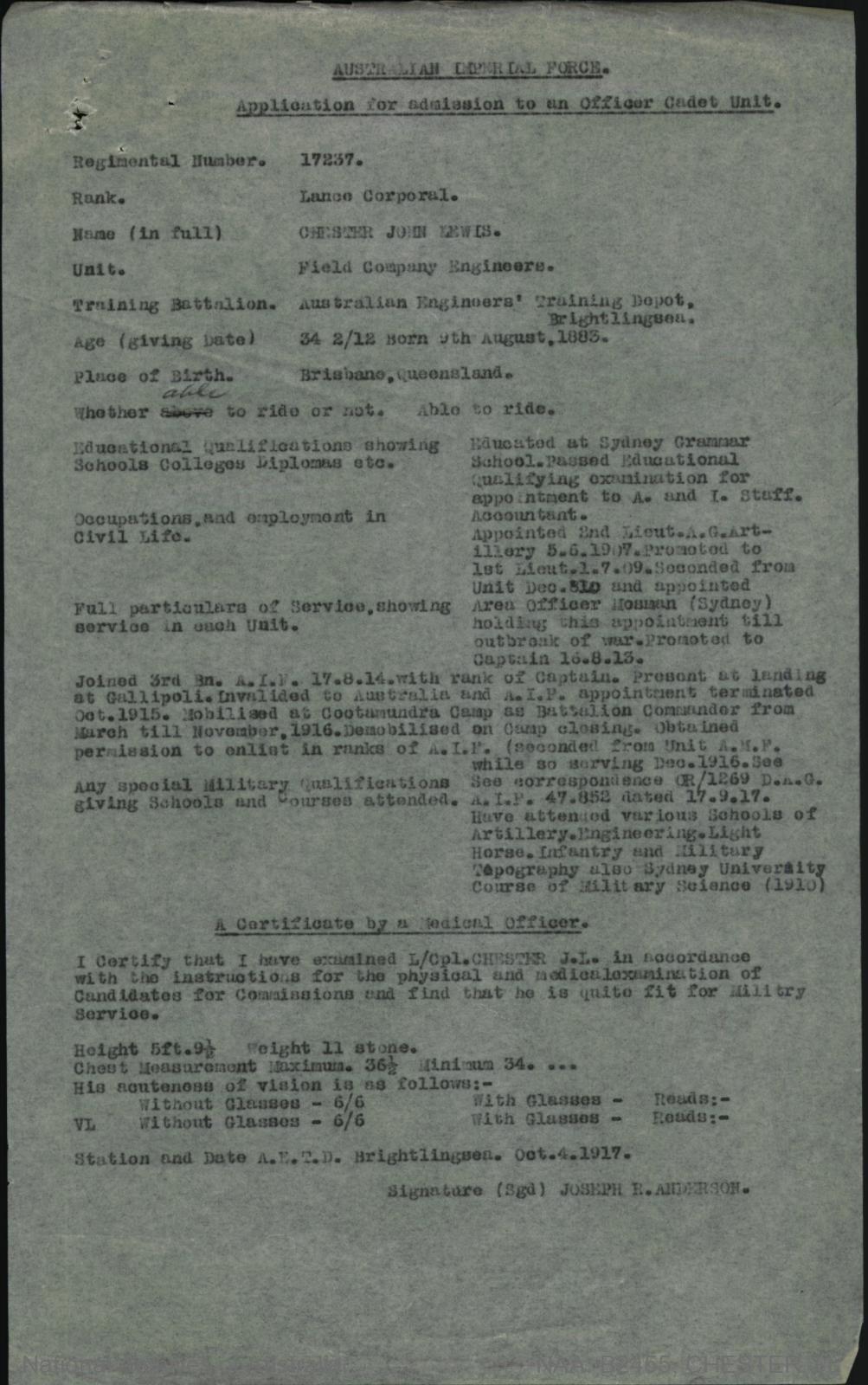
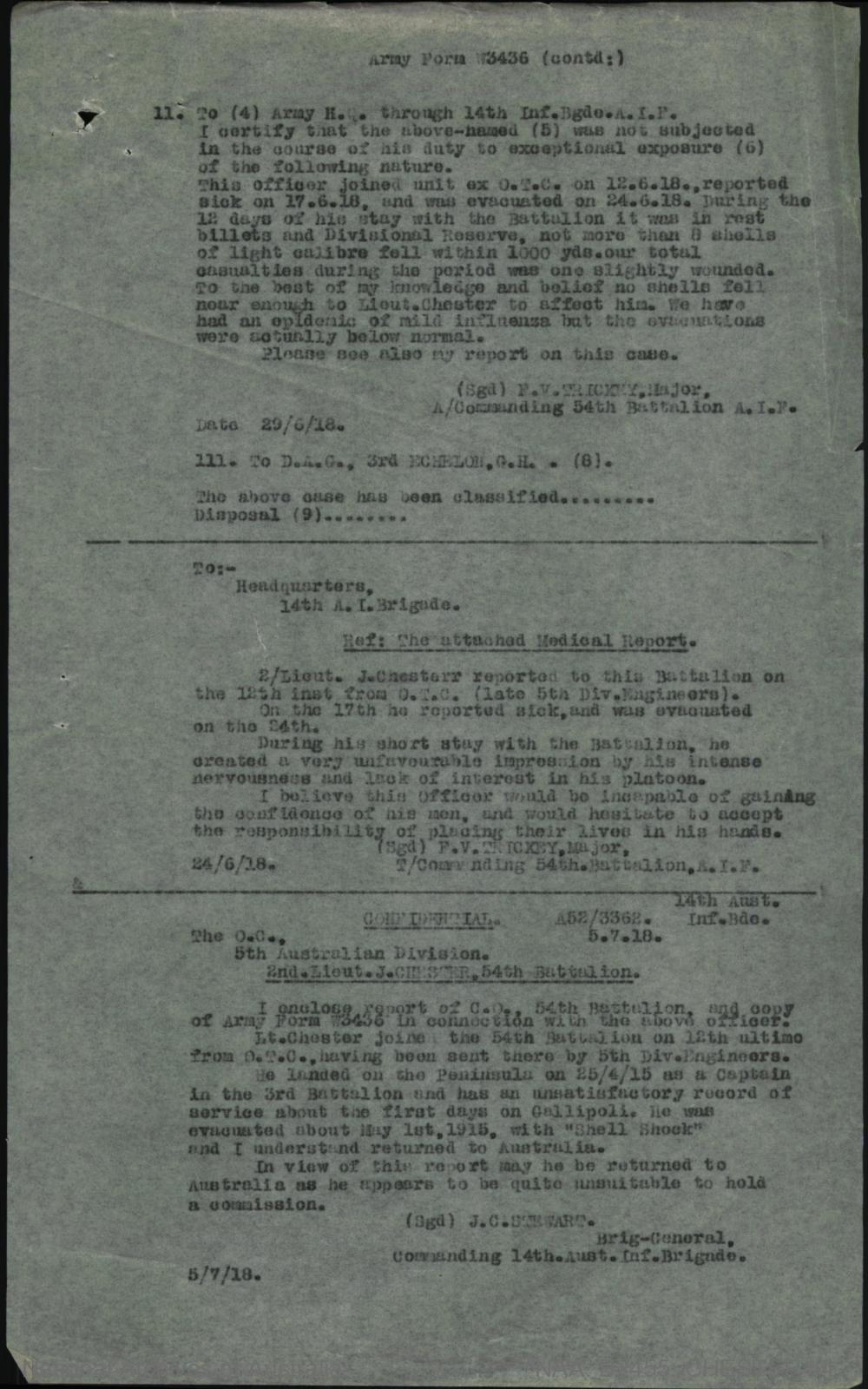
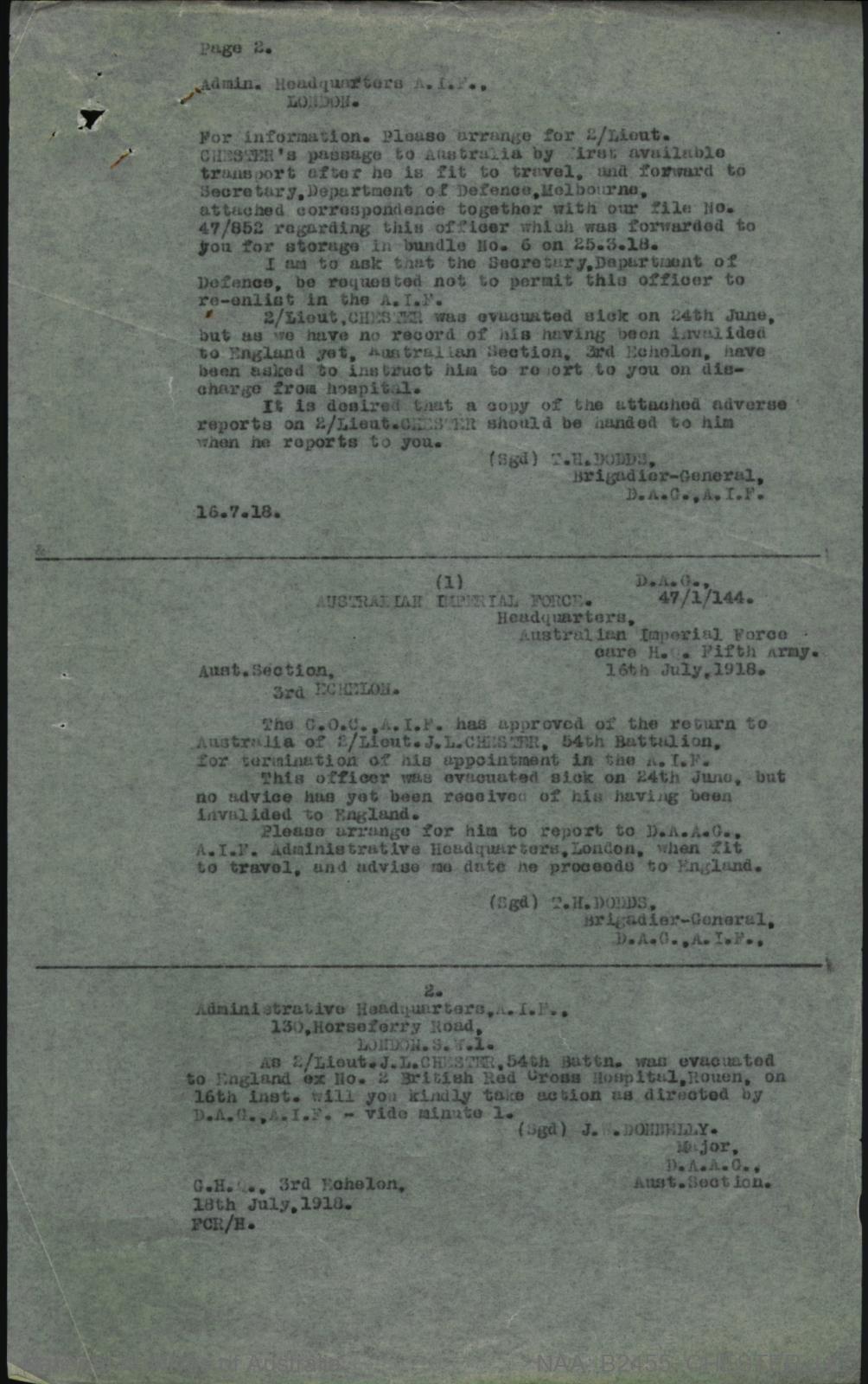
Some items from local papers around the time of his heading to the ill-fated Gallipoli campaign:
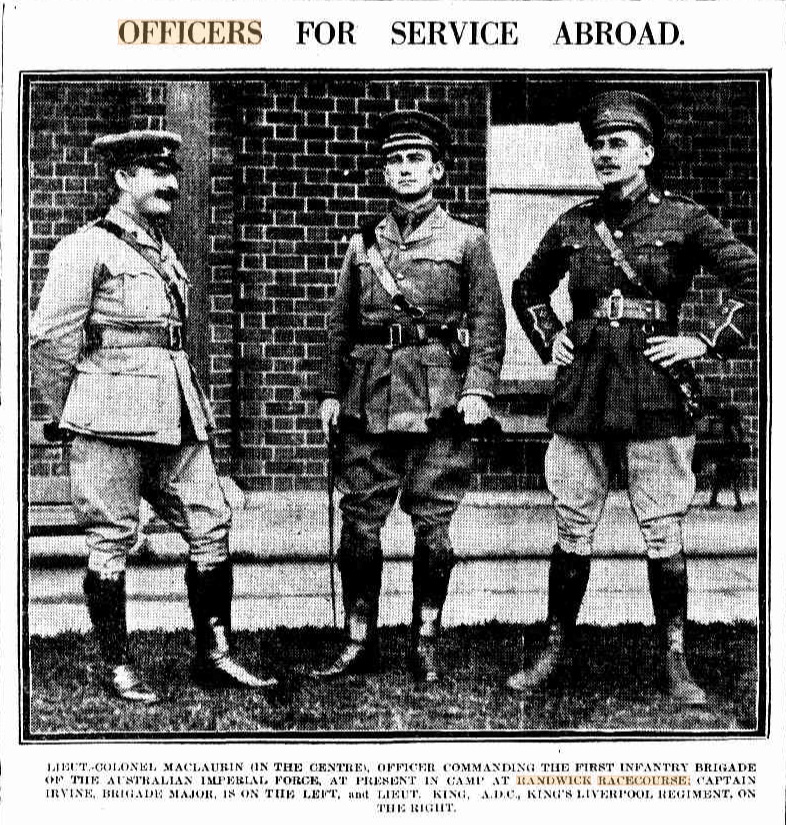
OFFICERS FOR SERVICE ABROAD. (1914, August 28). The Daily Telegraph (Sydney, NSW : 1883 - 1930), p. 7. Retrieved from http://nla.gov.au/nla.news-article239080022
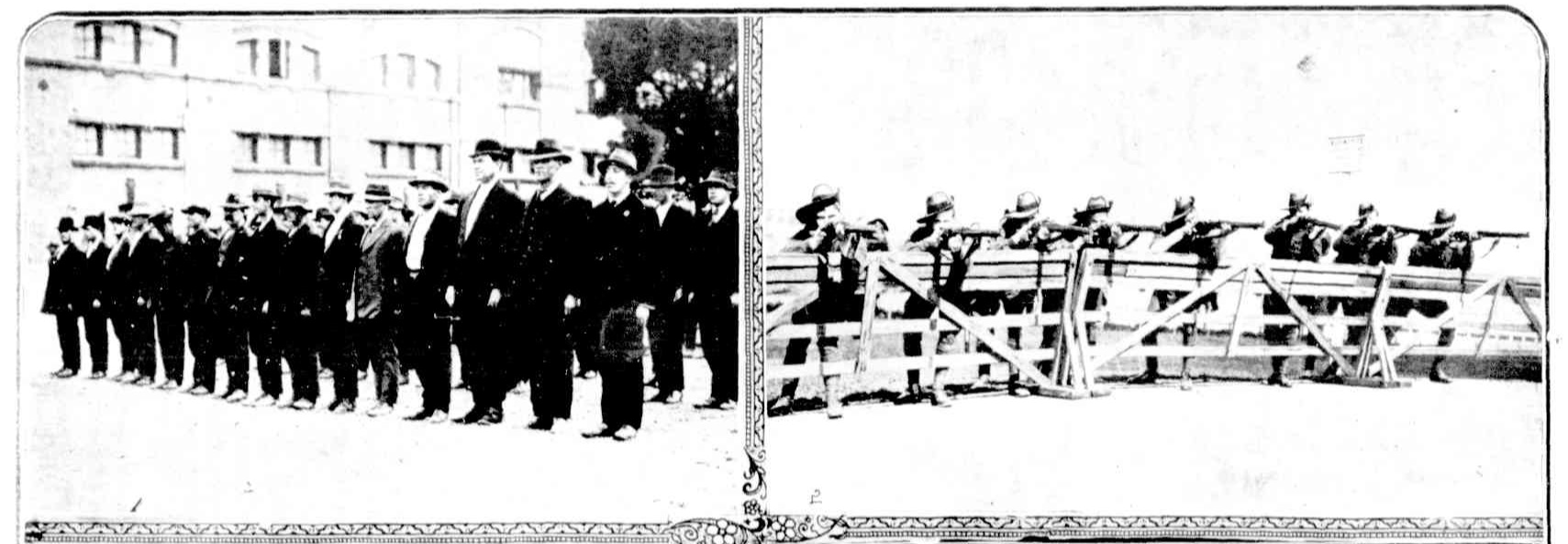
.png?timestamp=1607303248839) HE NEW SOUTH WALES EXPEDITIONARY FORCE AT RANDWICK RACECOURSE. (1914, September 5). The Australasian (Melbourne, Vic. : 1864 - 1946), p. 55. Retrieved from http://nla.gov.au/nla.news-article143286914
HE NEW SOUTH WALES EXPEDITIONARY FORCE AT RANDWICK RACECOURSE. (1914, September 5). The Australasian (Melbourne, Vic. : 1864 - 1946), p. 55. Retrieved from http://nla.gov.au/nla.news-article143286914
EXPEDITIONARY FORCE. RUSH TO VOLUNTEER. OFFICERS APPOINTED.
Victoria Barracks presented a scene of great activity yesterday, when about 1200 volunteers who had passed the medical examination paraded on the recreation green, and were marched off to the camp at the Randwick Racecourse.
Nearly all the men have had some military training, and the staff officers were very pleased with the contingent. A further batch of men who have been passed will be sent into camp to-day.
There was another rush to enrol at Lieut. Colonel Antill's office, and nearly a thousand names were added to the list of volunteers.
OFFICERS APPOINTED.
The State Commandant has approved of the following appointments of officers to the Australian Imperial Expeditionary Force, in anticipation of gazettal:
Brigade Staff.-Colonel W. Holmes, D.S.O., V.D., Brigadier; Major F. B. Heritage, Brigade Major; Captain R. J. A. Travers, Staff-Captain; Lieut. Basil Holmes, A.D.C.
Infantry Battalion.-Lieut-Colonel - W. W. R. Watson, V.D., to command; Lieut.-Colonel John Paton, V.D., second in command; Captain C. H. D. Dodson, Adjutant; Captain S. P. Goodsell, Quartermaster; Lieut. R. M. Sadler, Signalling Officer; Lieut. K. Heritage, Transport Officer; Captain J. L. Harcus and Lieut. T. R. Marsden, Machine Gun Officers. Company Officers: Major R. H. Beardsmore, Major E. F. Martin, Captains A. W. Ralston, E. C. Norrie, Ed. Twynam, T. R. Mcpherson, R. S. Grant-Thorald, H. L. Morrison, Lieuts. R. Part-ridge, J. E. Westgarth, E. E. Manning, A. D. Fisher, L. B. Ravenscroft, B. H. M'Lachlan, J. M. Maughan, V. H. B. Sampson. Second Lieutenants.: W. A. L. Fry, R. H. Norman, B. W. Kirke, J. A. M'Dowell, A. L. K. Cooper, P. K. B. Quinn, J. B. Sherbon, G. O. Manning,
Army Medical Corps.-Lieut.-Colonel N. R. Howes, V.C., Captaiu J. E. Donaldson, Captain F. A. Maguire, Captain B. C. A. Pockley.
Applications have been received from many senior officers, but the number of senior commands is very limited, and it has not been found possible to appoint them all to the force. They are, however, rendering valuable service in connection with the organisation and administration of the force in New South Wales. Among the officers who have volunteered but are thus unable to get away are Colonel Carrington, Colonel Ryrie, Colonel Kenneth Mackay, Colonel Cox, Colonel Kirk-land, and Colonel Campbell.
FIELD ARTILLERY.
Those wishing to join the Field Artillery Brigade with the expeditionary force, and have passed the medical examination, are required to report for enrolment at the headquarters, A.F.A., Victoria Barracks, at 9 o'clock to morrow morning. They will not be required to go into camp until Munday next, so need not bring baggage to-morrow. Those who have not sent in applications should apply to Lieut. Colonel Antill at the Barracks this morning.
THE 26TH INFANTRY.
All trainees of the 26th Infantry Regiment, 1896 quota, and others, not yet mobilised, are required to proceed at once to Middle Head with all equipment and two cooked rations.
All the officers of the District Headquarters Staff have been working at full pressure lately, making arrangements for the expeditionary force. Lieut. Stilling, A.D.C. to the State Commandant, has been granted leave of absence by the Lands Department, in order to give the whole of his time to his military duties.
Approved Light Horse volunteers coming to camp for the expeditionary force should bring their own horses, if possible. The Commonwealth Government will purchase these at a valuation not exceeding £16 a head. Officers or staff instructors will be responsible that only suitable horses are sent. Horses must be weight-carriers and hacks, height from 14.3 to 16 hands, age 4 to 12 years. Greys, pie balds, and washy chestnuts to be rejected.
Several horses have been received by the military authorities, and further gift horses would be appreciated. They should be con-signed to the remount depot at Liverpool, to which they will be forwarded by the rail-ways free of cost if the consignment note is marked "expeditionary force." Any communications regarding the supply of horses suit-able for remounts should be forwarded to the Assistant Director of Remounts, Victoria Barracks. EXPEDITIONARY FORCE. (1914, August 18). The Sydney Morning Herald (NSW : 1842 - 1954), p. 7. Retrieved from http://nla.gov.au/nla.news-article15530394
Owner of Bilgola Cottage, Australian airman Oswald Watt was there too:
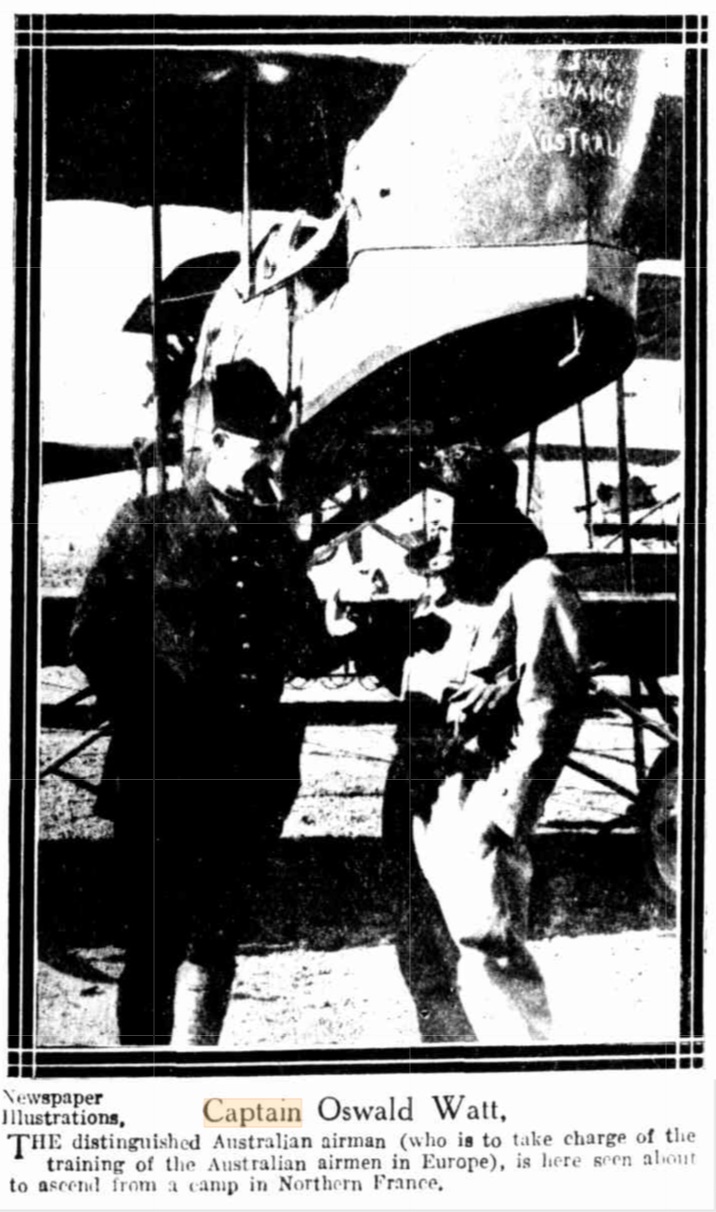
Captain Watt WAR CHEST IN EGYPT—AND OTHER TOPICS. (1916, June 7). Sydney Mail (NSW : 1912 - 1938), p. 21. Retrieved from http://nla.gov.au/nla.news-article166257325
Incited to further action and enlistments by newspaper reports with photos such as this - particluarly distressing, even from this time distance, is the expression on the faces of the Belgium soldiers as one of their fallen is carried away before them, as run on the second page of images from this report (No. 5):
PRIVILEGES OF A CONQUERING ARMY.
When a conquering army triumphantly marches into a captured town it cannot (do just what it likes with. the city and its inhabitants. The commander of the invading army is bound by war laws respected. by the Powers to recognise the rights, of citizens in certain directions. For instance, he cannot compel the inhabitants to take up arms against a local State or its ally.: The power of the commander in this direction stops at obtaining an oath of neutrality from 'the conquered citizens, which represents a promiise not to take part in hostilities against his forces whilst the war lasts. The commander of a conquered city, however, has it in his power to make things very unpleasant for the citizens of the town. They may force them to aid in the building of roads, bridges; railways, telegraphs, or other works, necessary for his military operations, on the ground that these are of general utility to the inhabitants., An invader cannot levy heavy, war fines, on a town indiscriminately... His demands must be in keeping, with the resources of.. the city. Such fines are not supposed to. be utilised as a. means of crippling 'an. enemy financially, or *for adding to the war chest of the conquerors.. '
The Germans seem. to consider that anything they care to confiscate is legally theirs when they capture a city. This policy of wholesale looting, however, is against the laws recognised by most of the Great Powers.
An invading, army should only demand articles actually needed by the troops, such as provisions, forage, clothing, or transport waggons. Articles of luxury, such as cigars, wines and valuable house decorations cannot legitimately be confiscated, as they do not represent actual needs of an army. ' Formal requisitions can be made for such requirements, but they must be paid for in cash, and the transactions must be specified only by the commander of the army in the locality.'
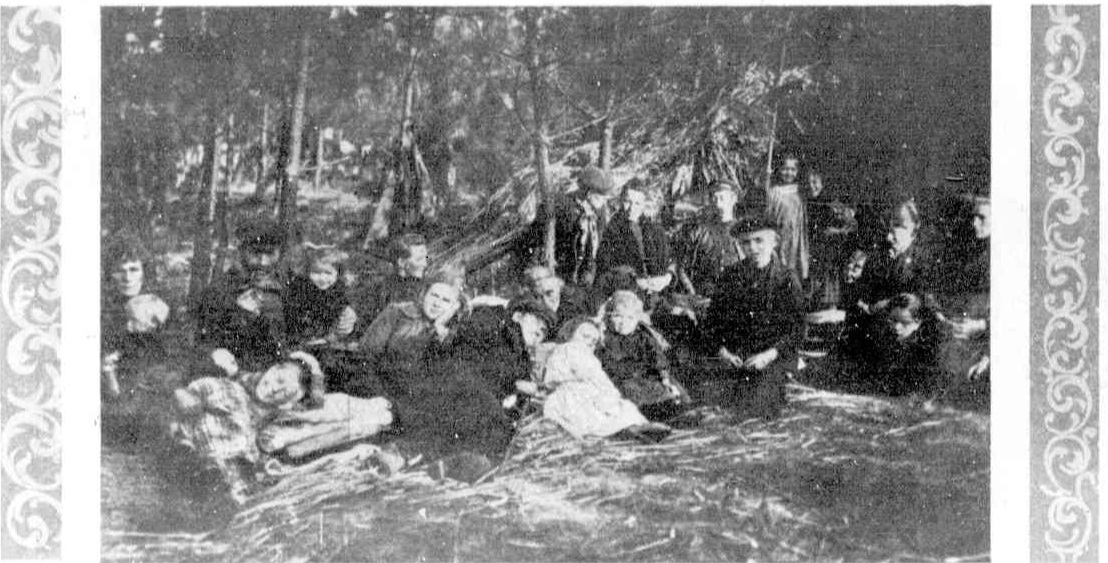
.jpg?timestamp=1607303839014)
.jpg?timestamp=1607303882430)
.jpg?timestamp=1607303937868)
.jpg?timestamp=1607303984436)
.jpg?timestamp=1607304055084)
.jpg?timestamp=1607304095609)
.jpg?timestamp=1607303453591)
1 Belgian refugees on Their Way to Holland, Encamped in a Forest near Antwerp, Before the Germans Arrived. 2. A Powder Magazine at Maubeuge, Blown up by the French. 3. A Cupola in One of the Forts at Alaubeuge Showing damage Caused by a 43 c. Projectile. 4. An Abandoned English Gun and Ammunition in One of the Trenches Before Maubeuge. 5. Effect of Shell Fire, After Bombardment by the Germans. 6. A House in One of the Principal Streets at Malines, Wrecked by German Shells. 7. A House in Antwerp Destroyed by German Shell. 8. The First British Officer Captured by the Germans. -(Central News, photo.) SCENES OF THE WAR.PRIVILEGES OF A CONQUERING ARMY. (1914, December 12). Leader (Melbourne, Vic. : 1862 - 1918, 1935), p. 30 (WEEKLY). Retrieved from http://nla.gov.au/nla.news-article92039823
J L Chester - served with the 3rd Battalion
The landing at Anzac Cove on Sunday, 25 April 1915, also known as the landing at Gaba Tepe, and to the Turks as the Arıburnu Battle, was part of the amphibious invasion of the Gallipoli Peninsula by the forces of the British Empire, which began the land phase of the Gallipoli Campaign of the First World War.
The 3rd Battalion was among the first infantry units raised for the AIF during the First World War. Like the 1st, 2nd and 4th Battalions it was recruited from New South Wales and, together with these battalions, formed the 1st Brigade.
The battalion was raised within a fortnight of the declaration of war in August 1914 and embarked just two months later, in October. After a brief stop in Albany, Western Australia, the battalion proceeded to Egypt, arriving on 2 December. The battalion took part in the ANZAC landing on 25 April 1915 as part of the second and third waves and served there until the evacuation in December. In August, the battalion took part in the attack on Lone Pine. For his valorous action in defending Sasse's Sap at Lone Pine on 9 August, Private John Hamilton was awarded the Victoria Cross.
After the withdrawal from Gallipoli, the battalion returned to Egypt. In March 1916, it sailed for France and the Western Front. From then until 1918 the battalion took part in operations against the German Army, principally in the Somme Valley in France and around Ypres in Belgium. The battalion's first major action in France was at Pozieres in the Somme valley in July 1916. Later the battalion fought at Ypres, in Flanders, before returning to the Somme for winter.
The battalion participated in a short period of mobile operations following the German withdrawal to the Hindenburg Line in early 1917, but spent much of that year fighting in increasingly difficult conditions around Ypres. 3rd Battalion returned briefly to the Somme (Amiens) in April 1918, but returned north to Strazeele which was also under threat of being captured by the Germans. The 3rd Bn remained in this sector and took part in several operations in the area during June and July 1918. The battalion was then sent back to the Somme on 6 August and two days later took part in the Battle of Amiens, which German General Erich Ludendorff described as "the black day of the German Army in this war".
The battalion continued operations to late September 1918. At 11 am on 11 November 1918, the guns fell silent. The November armistice was followed by the peace treaty of Versailles signed on 28 June 1919.
Between November 1918 and May 1919 the men of the 3rd Battalion returned to Australia for demobilisation and discharge.
Died: CHESTER JOHN LEWIS 5075/1961 Parents: CHARLES BAGOT EMILY EGLANTINE MANLY
Wife of Charles Henage Bagot Chester — married 22 Jan 1880 in Brisbane. John Lewis Chester - Birth date:09/08/1884. Mother's name: Emily Eglantine Bernays. Father/parent's name: Charles Henage Bagot Chester. Registration details:1884/B/32990
Emily Eglantine Chester formerly Bernays Born 2 May 1853 in New South Wales. Daughter of Lewis Adolphus Bernays CMG and Mary Anne Eliza (Borton) Bernays. Sister of Leopold Frederick Bernays, Christiana Mary (Bernays) Gore, Lewis Adolphus Bernays, Charles Arrowsmith Bernays, Arthur Stuart Bernays, Maurice Borton Bernays, Henry Abbott Bernays, Fitzgibbon Bernays and Jessie Eleanor Bernays
Wife of Charles Henage Bagot Chester — married 22 Jan 1880 in Brisbane, Queensland. Mother of John Lewis Chester and Charles Henry Chester.
Charles Henage Bagot Chester Born 5 Jun 1856 in England – parents; unknown.
DEATH NOTICE: CHESTER.—February 1, 1916, at a private hospital, Darlinghurst, Charles Henage Bagot Chester, in his 60th year. The Sydney Morning Herald (NSW: 1852 - 1954). Wed 02 Feb 1916, page 12- Family Notices. https://trove.nla.gov.au/newspaper/article/15652018
Mother Born: Emily Eglantine BERNAYS, on 02 May 1853, in the District of Balmain, New South Wales, father Lewis Adolphus BERNAYS, mother Mary Anne Eliza BORTON. (1) Early life: her early childhood was in Sydney, then moved with her parents to Brisbane in 1860. Married: on 22 January 1880 in Queensland, to Charles CHESTER.
Children: 1. Mary Matilda CHESTER, born 1881, Wollongong. 2. John Lewis CHESTER, born 09 August 1884 in Queensland, married Ianthe Pauline DALLEY on 23 November 1907; Married: 1.Ianthe Pauline DALLEY on 23 November 1907; divorced September 1914. married 2. Jean COXON in 1917.
HE WOULDN'T RETURN.
Ianthe Pauline Chester, formerly Dalley, petitioned in the Sydney Divorce Court for a dissolution of her marriage with John Lewis Chester, on the ground that the respondent had deserted the petitioner by reason of his not having complied with a decree for restitution of conjugal rights. The parties were married at Gore Hill, North Sydney, on November 23, 1907. The petitioner in her evidence said she had seen the respondent about 10 days ago, and he told her he had no intention of returning to her. A decree nisi was granted, and made returnable in six months. HE WOULDN'T RETURN. (1914, September 25). Evening News (Sydney, NSW : 1869 - 1931), p. 3. Retrieved from http://nla.gov.au/nla.news-article115806485
MUST RETURN TO HIS WIFE.
A young woman, Ianthe Pauline Chester (formerly Dalley), petitioned Mr. Justice Gordon in the Divorce Court this afternoon for a decree for restitution of conjugal rights with John Lewis Chester, an area officer. He was a Queensland native, but had resided here for several years. His Honor directed respondent, to return to the petitioner within 21 days after the service of the decree. MUST RETURN TO HIS WIFE. (1914, June 19). The Sun (Sydney, NSW : 1910 - 1954), p. 9 (FINAL EXTRA). Retrieved from http://nla.gov.au/nla.news-article224656802
CHESTER— DALLEY.— November 23, at Gore Hill, by the Rev. J. H. Best, John Lewis Chester to Ianthe Pauline Dalley. Family Notices (1907, December 25). The Sydney Mail and New South Wales Advertiser (NSW : 1871 - 1912), p. 1681. Retrieved from http://nla.gov.au/nla.news-article163663144
CHESTER—DALLEY.—November 23, at Gore Hill, by the Rev. J. H. Best, John Lewis Chester, eldest son of Charles Henage Bagot Chester, to Ianthe Pauline Dalley, eldest daughter of the late Eugene Lammonerie dit Fattorini. Family Notices (1907, December 21). The Sydney Morning Herald (NSW : 1842 - 1954), p. 12. Retrieved from http://nla.gov.au/nla.news-article14877984
Eugene Lammoneri Dit Fattorini (1839 - 1891) Birth: November 11, 1839. Birthplace: Port Maquarie, Colony of New South Wales. Death: October 16, 1891 (51) Lydiard st, Ballarat, Colony of Victoria (Dropped dead in street). Immediate Family: Son of Dr. 'Charles' Jean Baptise Charles Lammonerie Dit Fattorini and Clemence Caroline Fattorini. Husband of Amy formerly Fattorini, Rees. Ex-husband of Pauline Henrietta Fattorini - Newton. Father of Walter Eugene Lammonerie Fattorini; Private; Lucien Beaufils Lammoniere Fattorini and Private. Brother of Charles Lamonneri Dit Fattorini and Julia Clemence Lamonneire Lamb
There were 2 daughters were born in the 1873 marriage with Pauline. The eldest variously called Lanthe, Ianthe, Danthe also called Pauline “baby”and second child Henryetta who is also called Genevieve and Eugine!. His in-laws, the Coopers were well connected, Pauline H. Cooper’s brother Chief Justice in QLD, the parents substantial selectors of lands. A NSW Judge supervised Eugene’s access visits with his 2 daughters. Eugene appears to acknowledge at least one other exnuptual child in court cases before and during his marriage to Pauline He had at least one other family in Victoria, referred to in court cases over non payment of medical fees for confinements, his divorce from Pauline, etc. Eugene and Pauline divorce in Melbourne in 1885*(they need to reside in the same jurisdiction, Eugene by now is identified as a akin to a vexatious litigant, he sued for both personal and business reasons. Eugene was heavily involved in mining in Victoria in the Ballarat area and is an active litigant, one notable case involved a mine death where he argues it is the mine managers job to ensure safety etc. (not Directors/ owners) When Eugene died the Melbourne " Leader" described him as "in the prime of life, had a chequered career. He was a well cultured man, and a few years ago he was possessed of considerable wealth, owning nearly the whole of the Young Band Extended mine. Fortune, how ever, did not favour him latterly, and his love of litigation caused him great worry. Like Mr. Merry, he conducted his own cases in court. It is supposed that death was caused by apoplexy."
3. Frances E, CHESTER, born 1887, Richmond, New South Wales. 4. Charles Henry CHESTER, born 04 May 1890 in Moruya, New South Wales; married Grace BONIFACE; died 03 April 1945, North Sydney, New South Wales. Residence: Moruya, New South Wales. Died: 23 December 1940 at the age of 87 years, in the District of Mosman, New South Wales, Australia.
Jean Coxon's family members also moved to Manly:
COXON. - July 15 1932 at a private hospital Manly. Edward Christopher John Fieldin, dearly loved husband of Elizabeth Coxon of 70 Marshall street Manly, and father of Weller, Edith, Wallace, Jean, Thomas and Minion, aged 78 years. Family Notices (1932, July 16). The Sydney Morning Herald (NSW : 1842 - 1954), p. 12. Retrieved from http://nla.gov.au/nla.news-article16903364
OBITUARY
MR. E. C. J. F. COXON
After an illness extending over twelve months, the death occurred at his daughter's private hospital, Manly, on Friday last, in his 78th year, of a well known resident of Caniaba, Lismore—Mr. Edward Christopher John Fielden Coxon. Deceased was born on the voyage from England of the vessel "John Fielden." This vessel brought to Sydney the carriage, at present in the Sydney Museum, used on New South Wales's first railway, Sydney to Parramatta, deceased's father having charge of its construction and assembling on arrival. His parents went to the Araluen gold fields, and afterwards resided at Moruya for many years, where they both died.
Deceased formerly had saddling businesses at Bodalla, Braidwood, and Cobargo, but owing to ill-health he took up farming. In 1897 he came to the Richmond River, and in 1914 purchased the Caniaba property, "Moruga" where he resided until 12 months ago. During the war his home was an "open house" for patriotic gatherings, and was also the scene of many successful Anglican Church functions. Deceased was a very keen enthusiast in sport, particularly cricket, he himself being a player of merit in his young days. His wife, who survives him, was the eldest daughter of the late Mr. and Mrs. George Murphy, of Moruya. In addition to his widow, he is survived by three sons and three daughters-— Weller (Manly), Wallace (Woollahra), Thomas (Manly), Edith (Mrs. C. A. Mann, Pymble), Jean (Mrs. J. L. Chester, Manly), and Minion (Mrs. V. S. J. Maunsell (Manly).
At St. Matthew's C. of E., Manly, on Saturday afternoon, the Rev. A. R. Ebbs, formerly of Lismore, conducted an impressive memorial service, at which, he referred to the sterling qualities of deceased. Mr. Arthur Massey presided at the organ and played the "Dead March in Saul." Mr. Ebbs also conducted the service at the cemetery. OBITUARY (1932, July 21). Northern Star (Lismore, NSW : 1876 - 1954), p. 11. Retrieved from http://nla.gov.au/nla.news-article94293246
PAGE-COXON.
At St. Matthews Church, Manly, the marriage of Miss Aileen Coxon, second daughter of Mr. and Mrs. E. Weller Coxon, of Manly, to Mr. P. C. Page, eldest son of Mr. and Mrs. J G Page of Manly was celebrated on December 24 The ceremony was performed by the Rev A R Ebbs. The bride wore a classically cut gown of magnolia satin and her veil of cut tulle which was fastened to her head with a plaited bandeau of satin and posies of orange blossoms formed a train and was adorned with 'Pries of orange blossoms A bouquet of frangipanni and pale pink bebe roses with tails of stephanotis completed her ensemble There were four bridesmaids-the Misses Phyllis Coxon, Nancye Coxon, Ruth Coxon and Jean Page (twin sister of the bridegroom) Their frocks were of lettuce green organdie with bodices and short puffed sleeves studded with opalescent sequins and they wore turbans in plaited organdie with short tulle veils in the same shade They carried sheaves of orange coloured gladioli. Mr. F Bull was best man and Messrs Frank Coxon, Reg Symons and M Nicholson were the groomsmen. PAGE-COXON. (1933, January 3). The Sydney Morning Herald (NSW : 1842 - 1954), p. 3. Retrieved from http://nla.gov.au/nla.news-article16942607
________________________________________________________________________________________________________________________________
History of Life Saving in Casino.
The following history of the life saving movement in Casino was read on Monday night at the presentation of certificates to the successful candidates at the recent examinations. A report of the proceedings appears on another page of this issue : — In January, 1909, Messrs. A. Ford and J. C. Wearne made arrangements with the Royal Life Saving Society to form a branch in Casino, and Mr. Ford undertook the duties of drill instructor, while Mr. Wearne was deputed to take control of the class in the water. Word was received in the end of March that the examiner would visit the Northern Rivers in the beginning of April, and would examine the Casino class then. Unfortunately Mr. Ford had to sever his connection with the Class, and a meeting of the swimming club was held on 25th March to decide whether a class would be presented for examination, as there were only eight days to the date of the examiner's arrival. On Mr. Wearne's guarantee that the class would be ready, it was decided that they should go up for examination. Then came a time of strenuous practice, and during the eight days the members practised the releases and rescues each morning shortly after daybreak, and each evening after business hours, and at night they went through the land drill in the lecture hall of the School of Arts, kindly placed at their disposal by the committee.
The result of the examination on 2nd April, 1909, passed their most sanguine expectations, for the whole class, numbering 14, passed the proficiency test most creditably. The names of these pioneers of life saving in Casino were Messrs. J. C. Wearne, senr., Y. J. Jordan, James Leece, Ken. Pope, Les. Leece, J. C. Wearne, junr.,: F. Kingsbury, R. Hack, W. J. Kearns, Foster Latchford. C. Willey, Leo Page, P. Frost, and Barty Leece (elementary). -Since then Messrs. K. Pope, Kingsbery,: R. Hack and F. Latchford left the district, £b at so enthusiastic were some of the members that within the year and seven months, Mr.; J. C. Wearne, senr., holds the highest award possible to obtain, Messrs.- J.C. Wearne, James Leece and Leo Page, are being presented to-night with the second highest— the award of merit,- or silver medal— and - Messrs. . J. C. -Wearne, senr.. Y. J. Jordan, J. C. Wearne, jun., and C. Willey hold certificates as Honorary Instructors, and they, with other new members, have brought honour to Casino in life saving matters and have assisted in forming classes in several centres on the North Coast. Under the old conditions it was not permitted to pass more than one examination in one year, and the class had to wait 12 months for their next examination.
In 1909 the following were members of the Casino Cuckoo Patrol, Boy Scouts— Messrs . James Leece; J. C. Wearne, junr., Les. Leece, -Ken. Pope, P. B. Frost, and they were the first patrol of Boy Scouts in the King's dominions to qualify as certificated -life savers in water.
The next examination was held on 7th April, 1910, when Mr. V. Jordan coached a class, and Mr. J. C. Weame, senr., instructed the rest. The Boy Scouts disbanded, and the Senior Cadets formed a life saving class — this being, also the first of its kind in the British Empire. The School Cadets also presented themselves as a life v saving class, and the Casino Branch of the National Defence League, to encourage the cadets, offered gold medals to those who passed the Bronze Medallion test, which was most difficult, as the candidates had to perform the exercises fully dressed in the water. Cadets J.; Leece, J. C. Wearne, C. Willey and L. Page won these gold medals.
The awards given then were as follow : — Hon, Instructors— -Messrs. J. C.-Wearne, senr., V. J. Jordan and J. C. Wearne, junr. ; Bronze Medallions- Messrs J. O. . Wearne,. senr., V. J. Jordan, J. C. Weane,. junr., C. A. Willey, J. A. Leece, and Leo Page ; Proficiency— Messrs 0. A. Dening, E. Smith, E. J. Pollock," G. Lancaster, Ewin Stavert, Allan Kunkier, W. . S. Harvison, Arthur Gorton, A. . E. McPhail, .Gordon Cumming, Eric C. Bondfield, Victor Robinson ; Intermediate — Albert C. Elliott, ArthuV H. Anthony, Clair Maher, L. D Barnsley, G. Harris, E. L. Reddicliff, C- R. McKerihan, Lynn Robinson and John Stavert j Elementary — John C. Askew, Albert A. McKerihan, Walter - G. Stavert, Frank" Kirkpatrick and Percy Lee.
During that season also Mr. Wearne instructed a class of 15 at Greenridge, all of whom passed the proficiency test, and a class of 5 at Evans Head, who were awarded the proficiency certificate. In consideration of the activity and enthusiasm displayed by Mr. J. C. Wearne, the Royal Life Saving Society appointed him District Representative and Honorary Examiner for the Northern Rivers districts. This was a wise step, as he has been able to assist in forming classes at Coraki, Lismore and Amarina, and Has conducted local examinations at times suitable to the classes during the summer months. Recently he passed a class at Evans' Head for the" Bronze Medallion, and latter a class of 15 for the proficiency at Lismore, two of whom have since passed the bronze medallion tests. .
Greenridge and Amarina classes will be examined in the 'course of a week or so,- and he has been asked to examine a class of life savers at Mullumbimby on the 14th inst. When it was known that the celebrated founder of Life Saving ju the British Empire, Mr. William Henry, was going to examine candidates at Bris--bane, the worthy president of the Casino Defence League, Mr. E. M. Geikie, at/his own expense, arranged for Mr. Henry to visit Casino and examine candidates for the "higher awards in life saving. As Mr. Henry had made his arrangements regarding His four, he was unable to arrive in Casino before Saturday, October 29, and had to leave again at 7 a.m. on Monday, he was compelled to hold the examination on Sunday, when Messrs J. C.- Wearne, senr. and junr., -went up.for the award of merit and passed successfully, and laterln the day Mr. Wearne, senr., secured the coveted diploma, having the honor of being the first- candidate in Australia to win the highest award. Mr. Henry was persuaded to examine some .other candidates at daylight next morning, and the result was most satisfactory, as Messrs James A. - Leece, O. A. D'enirig, and Leo "Page passed the award of merit test, and Messrs Ross Braine, Walter Humphries, W. S. Harvison and Victor Robinson were awarded the Bronze Medallion. The last mentioned is not yet 15 years old, and until his birthday arrives he is not entitled to the medal, but.his success slows what fine swim- j mers we have amongst our boys in Casino, once Mr. Henry's visit, Mr. Wearne has held local examinations with the following result : — Proficiency —Messrs. Roy McKerihan, John Stavert-, David Evans, Ernest Reddacliff, C. 'Maher, A. Elliott, Bert McKerihan. Elementary — Cyril- S. Boyd, Eric Wearne, Lawrence Crawford, George McKerihan and Walter Don. As a result of "a conference with Mr. William Henry, the N.S. Wale3 Executive have decided to adhere to the English regulations, and the Bronze Medallion test is to be. done in future in swimming costume only, thus making it much easier. The proficiency test now entails rescues of 10 yards instead of 20 yards ; and boys of any age can enter for it, whereas previously/they could, not be examined for the proficiency award until they were 14 years old. Once more the Casino Defence League members are identifying themselves with the noble work of the life-savers, and the president will present the awards not yet distributed.
Casino holds absolute pre eminence in this useful accomplishment. The life-saving club awards held by members still in Casino include — one diploma, four silver medals, and 10 bronze medallions, besides the host of proficiency and elementary certificates, which will be raised a grade higher before the end of this summer. The efforts of the Committee of the Defence League are worthy of the greatest commendation, and the senior and junior cadet life-saving classes fully appreciate the recognition and practical support accorded to them by this representative Committee,- which will encourage them to carry on the good work individually and collectively until the Federal Parliament includes swimming and life-saving in compulsory military training, and the New South Wales Department of Education rises to a sense, of its obligation, to humanity and includes swimming and life-saving in the school education of each girl and boy in the State.
It is gratifying to be able , to close this report with the statement that the newly formed Casino Ladies' Life-saving Class is progressing most satisfactorily, and when the Municipal Council is in a position to construct a suitable and safe bathing place for it, the number and proficiency of its members will rival that of their more fortunate brothers. History of Life Saving in Casino. (1911, February 8). Casino and Kyogle Courier and North Coast Advertiser (NSW : 1904 - 1932), p. 6. Retrieved from http://nla.gov.au/nla.news-article234002824
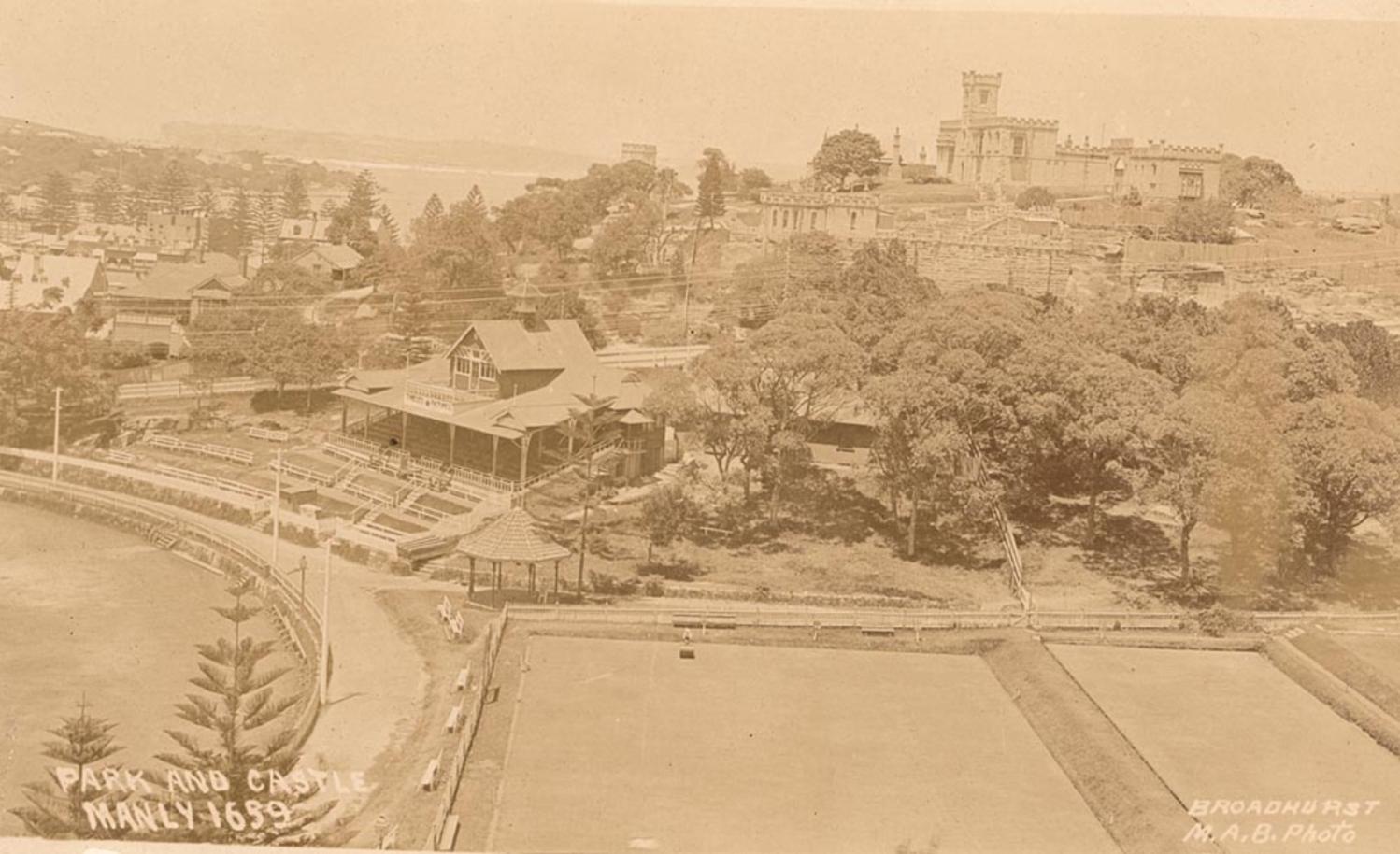
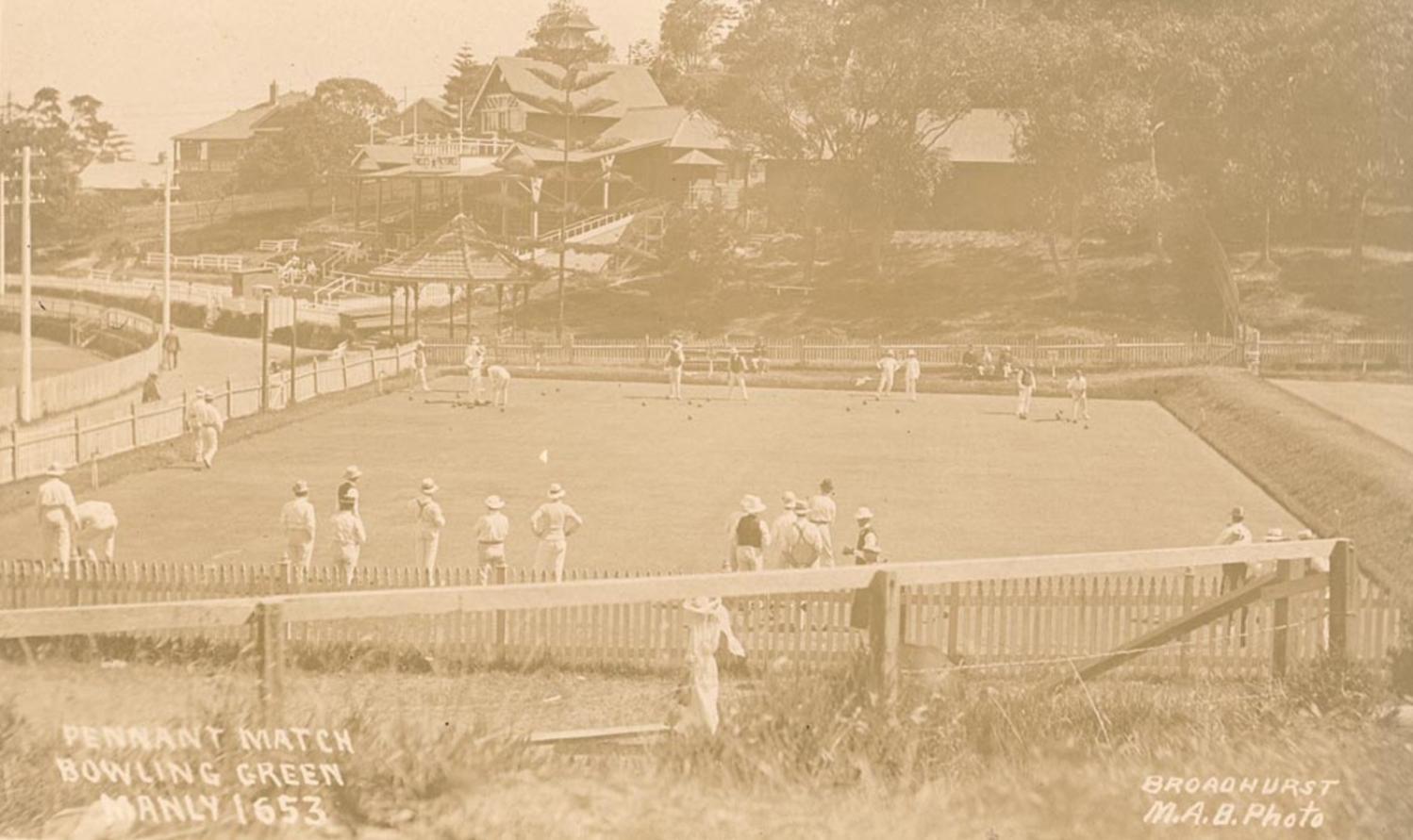
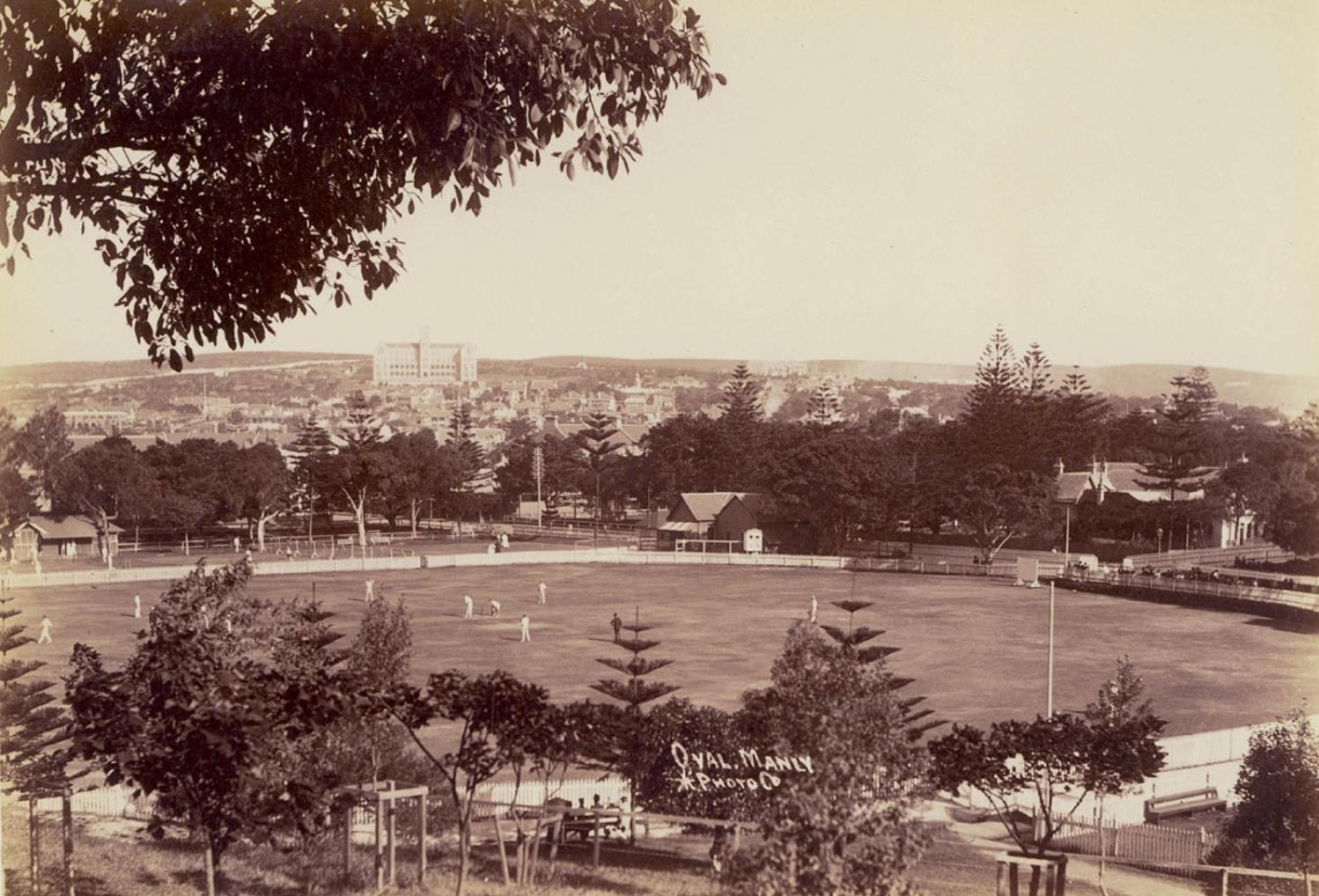
Previous History Pages:
Marie Byles Lucy Gullett Kookoomgiligai Frank Hurley Archpriest JJ Therry Sir Patrick Gordon Taylor Bowen Bungaree W. Bradley 1788 Journal Midholme Loggan Rock Cabin La Corniche La Corniche II Lion Island Bungan Beach Botham Beach Scarred Trees Castles in the Sand Dame Nellie Melba lunches at Bilgola Spring, 1914 First to Fly in Australia at North Narrabeen Mona Vale Golf Club's Annual Balls Governor Phillip camps on Resolute Beach Ruth Bedford Jean Curlewis Mollie Horseman Charlotte Boutin May Moore Neville W Cayley Leon Houreux Frederick Wymark Sir Adrian Curlewis Bilgola Heron Cove Mullet Creek Shark Point Woodley's Cottage A Tent at The Basin Collin's Retreat-Bay View House-Scott's Hotel Bilgola Cottage and House The First Pittwater Regatta Women Cricketers Picnic Filmed In Pittwater Governor Phillip's Barrenjoey Cairn Waradiel Season The Church at Church Point Governor Phillip's Exploration of Broken Bay, 2 - 9 March 1788 Petroglyths: Aboriginal Rock Art on the Northern Beaches Avalon Headland Landmarks Steamers Part I Pittwater Aquatic Club Part I Woody Point Yacht Club Royal Motor Yacht Club Part I Dorothea Mackellar Elaine Haxton Neva Carr Glynn Margaret Mulvey Jean Mary Daly Walter Oswald Watt Wilfrid Kingsford Smith John William Cherry George Scotty Allan McCarrs Creek Narrabeen Creek Careel Creek Currawong Beach Creek Bushrangers at Pittwater Smuggling at Broken Bay An Illicit Still at McCarr's Creek The Murder of David Foley Mona Vale Outrages Avalon Camping Ground Bayview Koala Sanctuary Ingleside Powder Works Palm Beach Golf Course Avalon Sailing Club Mona Vale Surf Life Saving Club Palm Beach SLSC Part I - The Sheds Warriewood SLSC Whale Beach SLSC Flagstaff Hill Mount Loftus Pill Hill Sheep Station Hill S.S. Florrie S.S. Phoenix and General Gordon Paddlewheeler MV Reliance The Elvina Florida House Careel House Ocean House and Billabong Melrose-The Green Frog The Small Yacht Cruising Club of Pittwater Canoe and I Go With The Mosquito Fleet - 1896 Pittwater Regattas Part I - Dates and Flagships to 1950 Shark Incidents In Pittwater The Kalori Church Point Wharf Bayview Wharf Newport Wharf Palm Beach Jetty - Gow's Wharf Max Watt Sir Francis Anderson Mark Foy John Roche Albert Verrills Broken Bay Customs Station At Barrenjoey Broken Bay Water Police Broken Bay Marine Rescue - Volunteer Coastal Patrol Pittwater Fire-Boats Prospector Powder Hulk at Towler's Bay Naval Visits to Pittwater 1788-1952 Pittwater's Torpedo Wharf and Range Naval Sea Cadets in Pittwater S.S. Charlotte Fenwick S.S. Erringhi P.S. Namoi S.Y. Ena I, II and III Barrenjoey Headland - The Lessees Barrenjoey Lighthouse - The Construction Barrenjoey Broken Bay Shipwrecks Up To 1900 Barrenjoey Light Keepers Douglas Adrian Ross Newport SLSC 1909 - 1938 Part I Overview North Narrabeen SLSC - The Formative Years First Naval Exercises by New South Wales Colonial Ships –The Wolverene at Broken Bay Bilgola SLSC - the First 10 years North Palm Beach SLSC A History of Pittwater Parts 1 and 4 Pittwater Regattas - 1907 and 1908 Pittwater Regattas - 1921 - The Year that Opened and Closed with a Regatta on Pittwater Pittwater Regatta Banishes Depression - 1933 The 1937 Pittwater Regatta - A Fashionable Affair Careel Bay Jetty-Wharf-Boatshed Gow-Gonsalves Boatshed -Snapperman Beach Camping at Narrabeen - A Trickle then a Flood Pittwater's Parallel Estuary - The Cowan 'Creek' RMYC Broken Bay Boathouse and Boatshed Barrenjoey Boat House The Bona - Classic Wooden Racing Yacht Mona Vale Hospital Golden Jubilee - A Few Insights on 50 Years as a Community Hospital Far West Children's Health Scheme - the Formation Years The First Scotland Island Cup, Trophy and Race and the Gentleman who loved Elvina Bay Royal Motor Yacht Club Broken Bay NSW - Cruiser Division History - A History of the oldest division in the Royal Motor Yacht Club Royal Motor Yacht Club Broken Bay Early Motor Boats and Yachts, their Builders and Ocean Races to Broken Bay, the Hawkesbury and Pittwater The Royal Easter Show Began As the Royal Agricultural Society of New South Wales The Mail Route to Pittwater and Beyond The Wild Coachmen of Pittwater - A Long and Sometimes Bumpy Ride on Tracks Instead of Roads The Fearless Men of Palm Beach SLSC's Surf Boats First Crews - A Tale of Viking Ships, Butcher Boats and Robert Gow's Tom Thumb 'Canoe' Furlough House Narrabeen - Restful Sea Breezes For Children and Their Mothers From Telegraphs to Telephones - For All Ships at Sea and Those On Land Mona Vale Training Grounds - From Lancers on Horses to Lasses on Transport Courses Fred Verrills; Builder of Bridges and Roads within Australia during WWII, Builder of Palm Beach Afterwards Communications with Pittwater Ferries To Pittwater A History of Pittwater - Part 4: West Head Fortress Pittwater's Lone Rangers - 120 Years of Ku-Ring-Gai Chase and the Men of Flowers Inspired by Eccleston Du Faur Early Pittwater Launches and Ferries Runs Avalon Beach SLSC - The First Clubhouse Avalon Beach SLSC The Second and Third Clubhouses From Beneath the Floorboards at Hyde Park Barracks Bungaree Was Flamboyant Andrew Thompson - 'Long Harry' Albert Thomas Black John Collins of Avalon Narrabeen Prawning Times - A Seasonal Tide of Returnings Oystering in the Pittwater Estuary - Oyster Kings and Pearl Kings and When Not to Harvest Oysters Yabbying In Warriewood Creeks Eeling in Warriewood's Creeks (Includes A Short History of community involvement in environmental issues/ campaigns in and around Narrabeen Lagoon - 1974 to present by David James OAM) Eunice Minnie Stelzer - Pittwater Matriarchs Maria Louisa Therry - Pittwater Matriarchs Manly's Stone Kangaroo, Camera Obscura, First Maze and 'Chute' - Fun Days in Sea Hazes from 1857 On A Salty Tale of the Kathleen Gillett – A Small Reminder and Celebration of Our 70th Sydney to Hobart Katherine Mary Roche - Pittwater Matriarch Sarah A. Biddy Lewis and Martha Catherine Benns Pittwater Matriarchs A Glimpse of the Hawkesbury.(1883) By Francis Myers. Illustrated by J C Hoyte Pittwater's New Cycle Track of 1901 Manly to Newport The Rock Lily Hotel Barrenjoey House The Pasadena Jonah's St Michael's Arch The First Royal Visitor to Australia: the Incident at Clontarf March 12th, 1868 Pittwater: Lovely Arm of the Hawkesbury By NOEL GRIFFITHS - includes RMYC Wharf and Clareville Wharf of 1938 + An Insight into Public Relations in Australia George Mulhall First Champion of Australia in Rowing - First Light-Keeper at Barranjuey Headland Captain Francis Hixson - Superintendent of Pilots, Lights, and Harbours and Father of the Naval Brigade The First Boat Builders of Pittwater I: the Short Life and Long Voyages of Scotland Island Schooner the Geordy The Marquise of Scotland Island Boat Builders of Pittwater II: from cargo schooners and coasters to sailing skiffs and motorised launches 130th Anniversary of Australia’s Sudan Contingent - Local Connections of the first Australians to Serve The Riddles of The Spit and Bayview/Church Point: sailors, boat makers, road pavers and winning rowers The Currawong: Classic Yacht VP Day Commemorative Service 2015 – at Avalon Beach RSL Cenotaph: 70th Anniversary Captain T. Watson and his Captain Cook Statues: A Tribute to Kindness Pittwater Reserves: The Green Ways; Hordern or Wiltshire Parks to McKay Reserve – From Beach to Estuary Pittwater Reserves, The Green Ways: Clareville Wharf and Taylor's Point Jetty Pittwater Reserves: The Green Ways Bilgola Beach - The Cabbage Tree Gardens and Camping Grounds - Includes Bilgola - The Story Of A Politician, A Pilot and An Epicure by Tony Dawson and Anne Spencer Pittwater Reserves - The Green Ways: Mona Vale's Village Greens a Map of the Historic Crown Lands Ethos Realised in The Village, Kitchener and Beeby Parks Pittwater Regatta Air Race Trophies: from 1934 and 1935 and The Pilot Who Saved William Hughes Pittwater Reserves: The Green Ways; Bungan Beach and Bungan Head Reserves: A Headland Garden Early Pittwater Paddlers, Oarsmen, Rowers and Scullers: The Green Family Elanora - Some Early Notes and Pictures The Stewart Towers On Barrenjoey Headland Early Pittwater Paddlers, Oarsmen, Rowers and Scullers: The Williams Family Early Cricket in Pittwater: A small Insight Into the Noble Game from 1880's On The Pacific Club's 2016 Carnival in Rio Fundraiser for Palm Beach SLSC Marks the 79th Year of Support Bert Payne Park, Newport: Named for A Man with Community Spirit Early Pittwater Paddlers, Oarsmen, Rowers and Scullers: The Fox Family Surf Carnivals in February 1909, 1919, 1925, a Fancy Dress Rise of Venus and Saving Lives with Surfboards Early Pittwater Paddlers, Oarsmen, Rowers and Scullers: The Paddon Family of Clareville Mermaid Basin, Mona Vale Beach: Inspired 1906 Poem by Viva Brock Early Pittwater Schools: The Barrenjoey School 1872 to 1894 The Royal Easter Show and 125th Celebration of the Hawkesbury Agricultural College: Farmers Feed Us! The Newport School 1888 to 2016 Pittwater's Ocean Beach Rock Pools: Southern Corners of Bliss - A History The Royal Botanical Garden Sydney Celebrates 200 Years in 2016 The Porter Family of Newport: Five Brother Soldiers Serve in WWI Church Point and Bayview: A Pittwater Public School Set on the Estuary The Basin, Pittwater: A Reprise: Historical Records and Pictures Lighthouse Cottages You Can Rent in NSW - Designed or Inspired by Colonial Architect James Barnet: Includes Historic 'Lit' Days records Bayview Days Ships Biscuits - the At Sea Necessity that Floated William Arnott’s Success Mona Vale Public School 1906 to 2012 St Johns Camden: 176th And 167th Anniversaries In June 2016 - Places To Visit Narrabeen Lagoon And Collaroy Beachfront: Storms And Flood Tides Of The Past Avalon Beach Public School - A History Muriel Knox Doherty Sir Herbert Henry Schlink Shopping And Shops In Manly: Sales Times From 1856 To 1950 For A Fishing Village Sir Edward John Lees Hallstrom Royal Prince Alfred Yacht Club's 150th Sailing Season Opening: A Few Notes Of Old A Few Glimpses Into Narrabeen's Past Beauties Dr. Isobel Ida Bennett AO Taronga Zoo 100th Birthday Parade: 1000 Reasons To Celebrate War Memorials: Manly, October 14, 1916 Avalon Beach Golf Links: Pittwater Fields of Dreams II War Memorials - Mona Vale, November 14, 1926 Annie Wyatt Reserve Palm Beach: Pittwater Fields of Dreams II Tumbledown Dick Hill Waratah Farm and Narrabeen Plums: Pittwater Fields of Dreams II Mark Twain, J.F. Archibald And Henry Lawson - Did They Go Fishing At Narrabeen In The Spring Of 1895?: Probably! Bayview Baths Centenary Celebration in November 2016 hosted by Bayview-Church Point Residents Association Dr. Jenny Rosen's Historical Timeline Palm Beach RSL - Club Palm Beach Celebrating 60 Years Early Years At Narrabeen: The Plane Sailing Day Of 1944 The Five Ways- Six ways Junction; Kamikaze Corner - Avalon Bilgola RPAYC Season on Pittwater and coming of Jubilees in Summer of 1938 Local Explorers’ Modern Day Discovery - Governor Phillip’s First Landing site, Campsite and contact with Local Aborigines in Pittwater: The Case for West Head Beach Rendezvous Tea Rooms Palm Beach: links with 1817 and 1917: Palm Beach Stores and Fishermen St Cloud's Jersey Stud: Elanora Heights: Pittwater Fields of Dreams Roderic Quinn's Poems And Prose For Manly, Beacon Hill, Dee Why And Narrabeen A Historic Catalogue And Record Of Pittwater Art I – Of Places, Peoples And The Development Of Australian Art And Artists: The Estuary Celebrating World Radio Day: The Bilgola Connection With The Beginnings Of Radio In Australia Emile Theodore Argles - champion of all Australians without a Voice - a very funny Satirist, Manly Poet and Pittwater Prose Writer and Litterateur Sydney Harbour Bridge Celebrates 85th Birthday: A Few Pittwater Connections Victor James Daley: A Manly Bard And Poet who also came to Pittwater and the Hawkesbury Let's Go Fly A Kite !: Palm Beach Whistling Kites Inspire sharing How to Make Standard, Box and Whistling Boy Kites - school holidays fun with a bit of Australian and Narrabeen history Clifton Gardens Mosman: An Eternal Green and Saltwater Space, and Of Many Captains Historic Catalogue And Record Of Pittwater Art I: Coastal Landscapes and Seascapes The Bayview Tea Gardens 1920 to 1923 When Run By Thomas Edward And Annie Newey (Nee Costello) An Australian and RPAYC Commodore Aboard an America's Cup Challenger of 1908 and 1914 Henry Lawson - A Manly Bard and Poet: on his 150th Birthday Historic Catalogue and Record of Pittwater Art I: Artists and Artists Colonies Opportunity To Visit Submarine War Grave Renews Memories Of 75 Years Ago Early Bayview - insights courtesy Don Taylor and Margaret Tink Retracing Governor Phillip's Footsteps Around Pittwater: The Mystery Of The Cove On The East Side Early Pittwater Surfers – Palm Beach I: John (Jack) Ralston and Nora McAuliffe Patrick Edward Quinn: A Manly Prose writer who gave us A Run To Pittwater (1889) and Songs for the Federation of Australia Avalon Beach North Headland Indian Face 'Falls': An Everchanging Coastline Nautical Treasure In Suburbia Pittwater: Where the Wild Flowers Are 1917 to 2017 Narani, Captain Cook Celebrations At MVPS And Elvina Bay Memories - 1970s Early Pittwater Surfers – Palm Beach I: Alrema Becke Queen of Palm Beach The Beachcombers Surfboard Riding Club: Palm Beach, NSW - 1959 to 1961 Year Dated Beer Bottles Found at Taylors Point Early Pittwater Surfers: Avalon Beach I - 1956: The Carnival That Introduced The Malibu Surfboard and Being Able To SurfAcross A Wave Face - Reg Wood Anecdotes Mona Vale SLSC To Be Completely Renewed + A Few Insights from the Pages of the Past The Firecracker That Closed Narrabeen Hotel By Ken Lloyd (Savalloyd) + Narrabeen Hotel Licence Transfer Trail Traces Of WWII Coast Watchers Found On Bangalley Headland - 1942 Early Warriewood SLSC insights per Norman Godden + Extras The Macphersons of Wharriewood and Narrabeen: the photo albums of William Joseph Macpherson Angophora Reserve Avalon 1938 Dedication Avalon Preservation Association History by Geoff Searl Pittwater Summer Houses: a 1916 Palm Beach Cottage and Palm Beach House Pittwater YHA: Some History WWI Historian Presents New Film On The Beersheba Charge At Avalon Beach Historical Society Meeting Newport's Bushlink 'From The Crown To The Sea' Paths: Celebrating Over 20 Years Of Community Volunteer Bushcare Results Pittwater Fishermen: The Sly Family Narrabeen Exploits and Manly Community Contributors: The First Surfboat at Manly Beach Women In The Surf Life Saving Movement As Life Savers: From At Least 1910 Locally - Awarded Medals For Saving Lives From 1880 In NSW Windsor Bridge: Planned Destruction Of Historic Link With A Pittwater Connection The Rise Of The Cruising Season: A Look At Some Early Australian sailers and Local Visitor Beauties Pittwater Fishermen: Barranjoey Days Polo By The Sea 2018: Over A Hundred Years Of Loving This Game In Pittwater Australia Day Regatta Began As Anniversary Day Regatta Black Bakelite Telephone: Early Pittwater Phone Numbers Hy-Brasil, Avalon Beach - Pittwater Summer Houses Ferry Names for Emerald Class: The Gibbs-Turner Original Magic Button Pittwater Summer Houses: A Tent At Palm Beach's Governor Phillip Park 'Neath Barrenjoey Pittwater Summer Houses: The Cabin, Palm Beach - The Pink House Of The Craig Family Manly's Early Sand Sculptors: How Pennies Can Become Pounds and Found A New Art Retracing Governor Phillip's Footsteps Around Pittwater: The Mystery Of The Cove On The East Side by Geoff Searl and Roger Sayers 230th Anniversary Edit March 2018 Black-Necked Stork, Mycteria Australis, Once Visited Pittwater: Pair Shot in 1855 Butter Churns: Pittwater Dairies The Drainage System In Thompson Square, Windsor Sydney Royal Easter Show 2018 Show Stopper Beer Brewed By Modus Operandi Mona Vale Extends Locals Input Into RAS Annual Celebration Of Local Products Sydney's Royal Easter Show Showbag Began As An Australian Sample Bag Pittwater Fishermen: Great Mackerel, Little Mackerel (Wilson's Beach - Currawong) and The Basin Motor Car Tours To And In Pittwater Show Us The Way This Place Once Was Some Bayview Memories: The Lloyd Family Tarramatta Park, Mona Vale 1904 The Collaroy Paddle Steamer: New Ephemera Added To Public Accessible Records - Her Connections To Pittwater The Roads And Tracks Of Yesterday: How The Avalon Beach Subdivisions Changed The Green Valley Tracks Australian Sailing's Barranjoey Pin Program; some insights into this Pittwater Yacht and owner, Sir W Northam who won Australia’s first Olympic sailing gold medal at the 1964 Tokyo Olympic Games Avalon Beach Historical Society’s 9th Great Historic Photographic Exhibition: Thousands Of Stories Made Accessible The Hawkesbury River Railway Bridge: Timely Winter Anniversaries and Commemorations For A Septuagenarian and her Predecessor Photographers Of Pittwater Capture Historic Insights: A. J. (Arthur James) Vogan, 1859-1948 Roads To Pittwater: The Wakehurst Parkway Along Old Oxford Falls Track Roads To Pittwater: The Pittwater Road My Holiday by Charles de Boos – 1861 Shark-proof pools at Manly on the Harbourside Dad's Fishing Shack At Long Reef Historic Photographers Of Pittwater: Harold 'Caz' Cazneaux 1878 - 1953 Roads To Pittwater: The Mona Vale Road My Singing Story Barrenjoey High School's 50th Year: History Notes + The Original Barrenjoey School A Bunch Of Wildflowers: Historical Spring September Songs Camden-Campbelltown Hospitals & Carrington Convalescent Hospital: A Mona Vale-Frenchs' Forest Hospitals Comparison With Pittwater History Links The Newport School: 1888 to 2018 A Visit to Bungan Castle by ABHS Roads In Pittwater: The Barrenjoey Road Remembrance Day 2018 - Pittwater Veterans WWI 100 Years From Armistice Day 1918 Filmed in Pittwater: A Sentimental Reprise + Narrabeen Roads In Pittwater: The Bay View Road The NSW Women's Legal Status Bill 1918: How The 'Petticoat Interference In Government' Came Of Age - A 100 Years Celebration Of Women Alike Our Own Maybanke Selfe-Wolstenholme-Anderson Scott Brewster Dillon: A Tribute - He Did It His Way Pittwater Summer Houses: Rocky Point and Elvina Bay - A Place Of Holiday Songs and Operas In Ventnor, Fairhaven, Trincomalee and Maritana Remains Of Captain Matthew Flinders Discovered: Links with Bungaree of Broken Bay Isabella Jessie Wye MBE OAM (Isa) Off To School In 2019 Quicker Than 104 Years Ago Photographers Of Early Pittwater: Charles Bayliss Harold Nossiter's Classic Yachts Pittwater Roads II: Where the Streets Have Your name - Scotland Island Art Deco Inspirations In Palm Beach: The Palladium Dance-Hall, Cafe And Shop - The Surf Pavilion - The Beacon Store Pittwater Roads II: Where the Streets Have Your Name - Newport Beach Professor Christopher John Brennan: A Poet Of Newport Beach M.V. Reliance Turns 100 Avalon Beach Historical Society March 2019 Meeting: Focus On Trappers Way Pittwater Roads II: Where the Streets Have Your name - Clareville Photographers of Early Pittwater: Henry King Photographers Of Early Pittwater: David 'Rex' Hazlewood Richard Hayes Harnett - First Commodore Of The Royal Prince Alfred Yacht Club and Designer Of The Yacht 'Australian' - Based On The Lines Of A Mackerel Pittwater Summer Houses: Waiwera and Hopton Lodge, Bayview The Sirius Circumnavigation (1935-1937): Nossiter Trio Make Australian Sailing History Pittwater Roads II: Where the Streets Have Your name - Avalon Beach Were Manly's Statues, Smashed For Road Ballast, Sculpted By Achille Simonetti? Pittwater Roads II: Where the Streets Have Your name - Warriewood Avalon Beach Historical Society June 2019 Meeting Flint and Steel Guesthouse Pittwater Roads II: Where The Streets Have Your Name - 'Green Hills', Elanora Heights, and Ingleside Ethel Turner's Seven Little Australians Added To UNESCO Memory Of The World Register - The Missing Pages Restored RPAYC To Host 100th Year Of The Scandinavian Gold Cup and 5.5m Worlds In January 2020 - some Etchells Worlds and Gold Cup on Pittwater History Pittwater Roads II - Where the Streets Have Your Name: Mona Vale Pittwater Roads II - Where the Streets Have Your Name - Bungan Shark Meshing 2018/19 Performance Report + Historical Pittwater Shark Notes Anthony Thomas Ruskin Rowe, Spitfire Pilot (1919 To 1943) - Who Defended Darwin And His Mate: An Avalon Beach And Pittwater Hero Newport Surf Club Celebrates 110 Years On October 19, 2019 - A Few Club Firsts Pittwater Roads II - Where the Streets Have Your Name - Bilgola Tram Memorabilia - Historic Daylight Run For Sydney Light Rail Begins 80 Years After Last Tram To Narrabeen Closed Historic Insights From The Australian National Maritime Museums 1890 Pitt Water 'Era' Yacht Collection: The Basin Regattas Pittwater Roads II - Where the Streets Have Your Name - Coaster's Retreat and The Basin Samuel Wood Postcards of Pittwater and Manly Bilgola SLSC Celebrates 70 Years: Anecdotes from Early Members Pittwater Roads II - Where the Streets Have Your Name - Great Mackerel Beach G . E. Archer Russell (1881-1960) and His Passion For Avifauna From Narrabeen To Newport A History Of The Campaign For Preservation Of The Warriewood Escarpment by Angus Gordon and David Palmer Mark Foy of Bayview 2019 Inductee into Australian Sailing Hall of Fame The Victa Lawnmowers Story With A Careel Bay Link Plaque Unveiled To Mark Phenomenal Surfing Revolution Commencement: the 1956 Carnival at Avalon Beach That Introduced The Malibu Surfboard The Other Angels From Avalon: 50th Anniversary Of The IRB Marks The Saving Of Over 100 Thousand Lives The Eos: Classic Pittwater Yachts Pittwater Roads II: Where The Streets Have Your Name - Whale Beach Palm Beach Pavilion To Be Renamed The Lieutenant Colonel Douglas Marks DSO, MC Pavilion - some historical insights Daniel Gordon Soutar's Influence On Local Golf Courses: Some History Notes Pittwater Fire Boats History: January 2020 Tribute Palm Beach Pavilion Renaming Dedication Honours Lieutenant Colonel Douglas Marks DSO, MC Ella McFadyen's Love Of Pittwater: An Environment, Wildlife and Children's Champion Ella McFadyen's Love Of Pittwater: A Children's Champion - shorter version for Children Sydney Bus Museum Volunteers Helps Mona Vale Bus Depot Celebrate 50th Anniversary Of Opening Dorothy Hawkins - a new film by John Illingsworth Dorothy Hawkins' family, father Joseph Homer, ran a dairy near Winnererremy Bay at Mona Vale from 1936 Narrabeen Fire Brigade Celebrates 100th Anniversary + A Few Extra Insights Into Local Fires And Brigade Formations Pittwater, Narrabeen Lagoon & The Collaroy Beachfront: Some Storms and Flood Tides Of The Past - With Pictures The Wolverene At Broken Bay In 1885 Jack 'Bluey' Mercer (January 2nd, 1923 - February 17th, 2020) - West Head Battery in WWII Manly Children's Festival Federation Of A Commonwealth Medals Of 1901 Maybanke Selfe-Wolstenholme-Anderson: 2020 International Womens Day + Pittwater Online 10 Years Celebrations The Bona - Classic Wooden Yacht 2020 Answers North Head Quarantine Station, Manly: Some History - Governor Ralph Darling Saved Australians, Saved Australia Winnererremy Bay: Angus Gordon, the Sequel to Dorothy Hawkins by John Illingsworth Roderic Quinns Poems and Prose For Manly, Beacon Hill, Dee Why And Narrabeen - 10 Year Celebrations and all Manly-Pittwater Poets Series in One Place Stargazing In Pittwater: Historic and Contemporary The Naval Pioneers of Australia by Louis Becke and Walter Jeffrey 1899 Harold Tristram Squire: October 28, 1868 - May 16,1938; Artist of Mona Vale All Is Quiet On The Western Front by Roger Sayers Pittwater Roads II: Where The Streets Have Your Name - Palm Beach Large Sunfish Caught at Barranjuee in 1875 Grace Brook, 1921-2017 by Paul McGrath and Robin Bayes The Pittwater Floating Hotels That Almost Were: Old Paddle Steamers, Fairmiles + A Current 'Lilypad' Pittwater's Ocean Beach Rock Pools: Southern Corners Of Bliss - A History: Updated 2020 Long Reef Aquatic Reserve Celebrates 40th Anniversary Pittwater Roads II: Where The Streets Have Your Name - Careel Bay Careel Bay Reserves and Playing Fields in Careel Bay Playing Fields Reserve - Including Hitchcock Park: Birds, Boots & Beauty North Narrabeen Rock Pool: Some History Narrabeen Lakes Amateur Swimming Club by Maureen Rutlidge, Life Member Avalon Beach North Headland: An Ever-Changing Coastline - Storm Swell Of July 2020 Anthony Thomas Ruskin Rowe, Spitfire Pilot (1919 To 1943) - 75th VP Day Tributes 2020 Walter ('Wal') Williams - VP Day 75th Tributes 2020 Gwenyth Sneesby (nee Forster) 75th VP Day Tributes 2020 Pittwater's Midget Submarine M24 War Grave Renews Memories Of 75 Years Ago Avalon Beach and Surrounds in 1968 and 1970 - Photos Taken By Gary Clist Muriel Knox Doherty of Avalon Beach VP Day 2020 75th Anniversary Tributes Dundundra Falls Reserve: August 2020 photos by Selena Griffith - Listed in 1935 Binishells In Pittwater Schools Bairne Walking Track, Ku-Ring-Gai Chase National Park (Trig Stations) photos by Kevin Murray Pittwater Roads II: Where the Streets Have Your Name - Bayview Perons' Tree Frog At Careel Bay - who is 'Peron'? Pittwater Roads II: Where The Streets Have Your Name - Church Point Stapleton Park Reserve In Spring 2020: An Urban Ark Of Plants Found Nowhere Else Sydney's ACA Building Revitalisation Project Complete: Grand Old Building Has Links To Architects Of St. Patrick's College Manly - Some History Notes Harry Wolstenholme (June 21, 1868 - October 14, 1930) Ornithologist Of Palm Beach, Bird Man Of Wahroonga
